






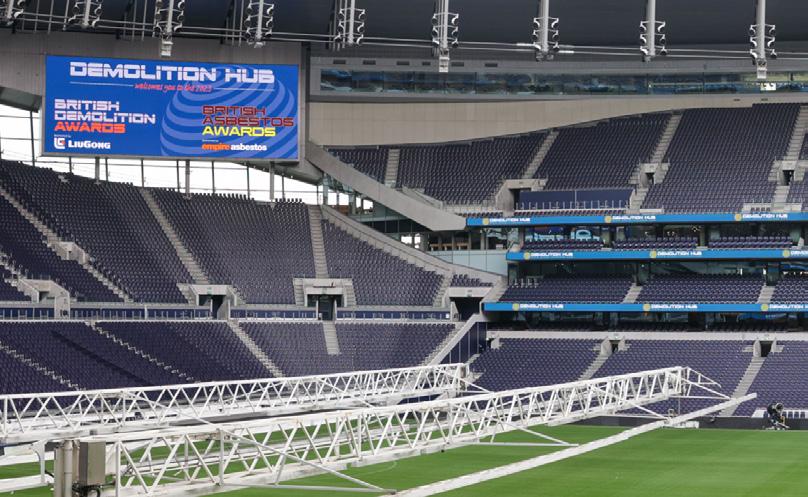

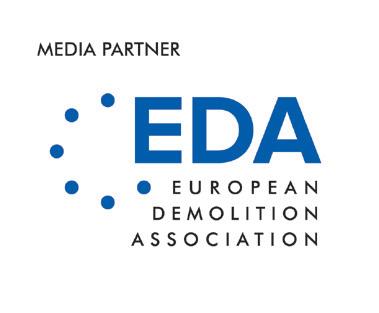
October/November 2023 | Issue #19 DeMOLITION HUB #championingdemolition Official magazine suporting the demolition mental health charity fundraiser DEMOLISTEN UK, European & worldwide demolition matters LONDON,6-9-2024 #DEMOAWARDS6 CAT® COMMAND Revolutionising equipment operation, we went to check it out BRITISH DEMOLITION AWARDS The night the industry came together in London SUPPLIER TALK With Simon Saunders, Komatsu British Demolition Awards 2023 Special Edition


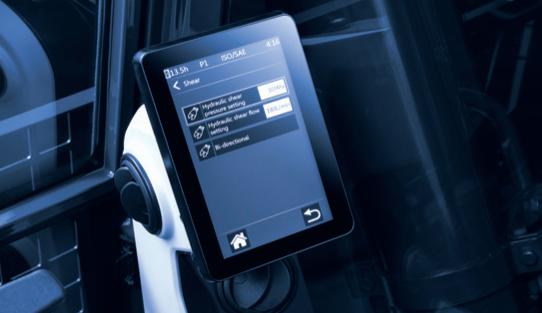
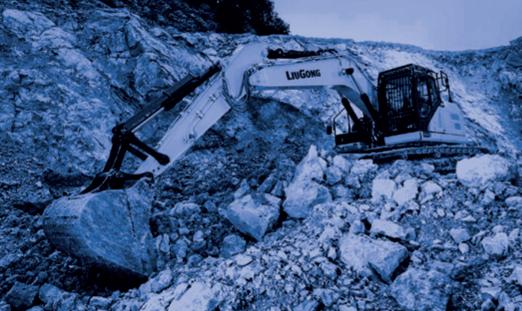



info@liugong.co.uk 02392123392 www.liugong.co.uk FROM1.8TO95TONNESTHEALLNEWF-SERIESBREAKSTHEMOULD. SCANTHE QRCODETO DISCOVERTHE DIFFERENCE GROUND BREAKING DESIGN TOUGHNESS CONTRÔL INTELLIGENCE
Demolition Hub is now celebrating reaching its fourth year, having changed the way the industry is represented and reported on as we continue to promote demolition as far and wide as possible. You have our commitment that we are fully invested in demolition.

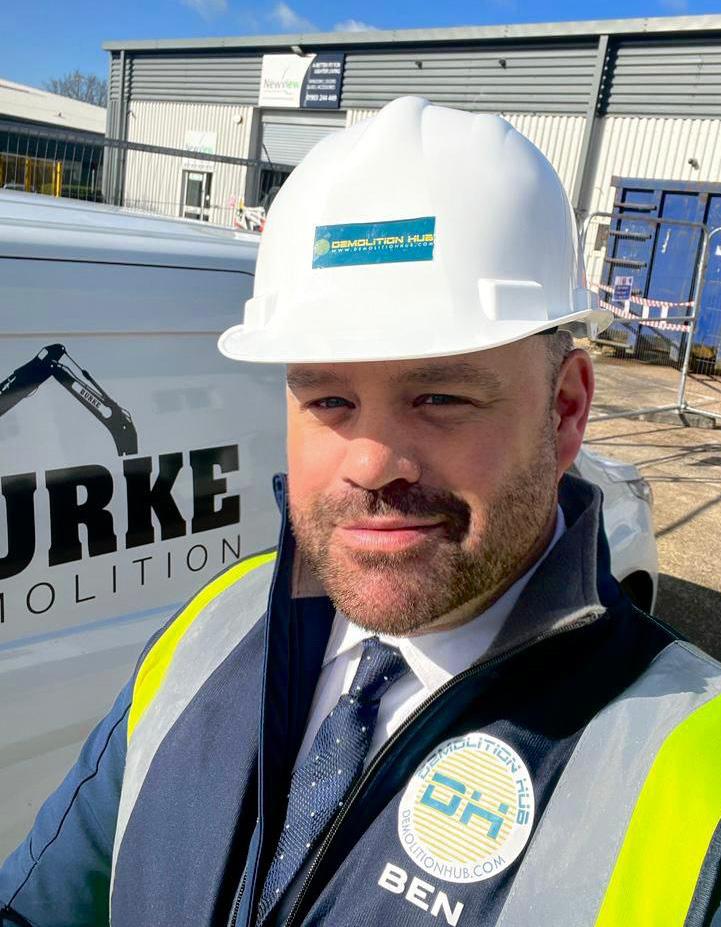
This issue comes straight off the back of the British Demolition Awards, the September event in which 400 industry professionals came together and celebrated British demolition.
You can read about the fantastic fifth annual extravaganza on page 66. Breaking news is that LiuGong has now signed up to be the principal sponsor for 2024’s event, the third time they have taken this spot, for which we are very grateful. They benefit from the coverage and so we offer other sponsorship opportunities for anyone else wanting to get the best possible exposure as we start to promote the event next year.
Congratulations to all deserved winners, in fact congratulations for all who invested in the awards, took part and attended on that brilliant night. We are back at the world’s most technologically advanced stadium next year, having rebooked the Tottenham Hotspur Stadium for the sixth British Demolition Awards.
In this autumnal issue you can read about my experience checking out Caterpillar’s CAT Command, the best video game I have experienced. But video game it is not; it is a game changer for operator safety, equipment availability and site productivity using remote control, in my experience, 1,500 miles away.
After a very enjoyable meeting with Total Controlled Demolition Services at the awards last month we are featuring their Managing Director Lee Brash as the subject of our regular DEMOLITION DISCUSSION.
We are delighted to feature Japanese excavator specialists Komatsu, whose Marketing Manager Simon Saunders is the subject of SUPPLIER TALK. We look forward to working more with Komatsu.

So, what next. As you read this, I will have met with MB Crusher to discuss their focus for next year, then I hope to join many of you in London aiming to learn from the HSE and NFDC, who have joined forces to deliver a comprehensive demolition planning masterclass for clients tendering demolition works. I am then attending ARCA’s AGM followed by an invite to tour JCB’s World HQ in Uttoxeter, it is all go and we will bring you all in the last issue of the year in a couple of months.
I hope you enjoy this issue, please do stay or get in touch: ben@globalnews.media.
PUBLISHER
Ben Chambers ben@globalnews.media
01903 952 648
EDITOR
Toby Wilsdon toby@globalnews.media
01903 952 645
DEMOLITION EDITOR
Paul Argent paul@globalnews.media 07813 064 590
COLUMNISTS
Richard Dolman Jaqueline O’Donovan Terry Lloyd
SALES
Luke Chaplin luke@globalnews.media 01903 952 643
DESIGN


Nicki Chambers nic@globalnews.media
Joe Bers joe@globalnews.media
Alex Jarrett
PRODUCED & PUBLISHED BY Global News Media Ltd Suites 5 & 6, Chapel House, 1-6 Chapel Road, Worthing, West Sussex BN11 1EX demolition@globalnews.media 01903 952 640
Demolition Hub is a proud supporter of the National Demolition Association Demolition Hub is the media partner for the European Demolition Association and the Indian Demolition Association


Demolition Hub is published six times a year. The subscription rate is £60 per year. Subscription records are maintained at Global News Media Ltd, Suites 5 & 6, Chapel House, 1-6 Chapel Road, Worthing, West Sussex BN11 1EX
Ben Chambers Publisher, Demolition Hub ben@globalnews.media
+44 (0)7803 844 806
Articles and information contained in this publication are the copyright of Global News Media Ltd and may not be reproduced in any form without the written permission of the publishers. The publishers cannot accept responsibility for loss of, or damage to, uncommissioned photographs or manuscripts.

DemolitionHUB Magazine | 3
DemolitionHub.com
6 NEWS
NFDC: The Crooked House was not demolished Industry reacts to Sunak’s net zero plans
Cawarden and J Freeley selected for £8bn National Procure Partnership Framework
LiuGong to be the principal sponsor for the third year running.
12
EUROPEAN DEMOLITION ASSOCIATION NEWS
Preparations for the new EDA guide have begun EDA welcomes Hitachi
Don’t miss out the EDI Decontamination Forum
EDA reunites the National Associations once again
16
NATIONAL DEMOLITION ASSOCIATION NEWS
Turning the old into the new Preserving history through precision
OSHA’s Severe Violator Enforcement Program is worse than ever before
24 DEMOLITION DISCUSSION
With Lee Brash of Total Controlled Demolition Services
32 SITE VISIT
Caterpillar in command
34
ATTACHMENT FEATURE
BPH Attachments – versatile selector grabs

Armed with Epiroc hydraulic hammers, German demolition company makes fast work of motorway junction
Inmalo expands for the future
Steelwrist
Lekatech Electric Hammer revolutionises impact hammer technology with linear electric motor Rotar RCC45 Concrete Cutter with Ramplifier 2.0 and fully integrated OilQuick OQ 90
Indeco: the Italian hi-tech quality applied to demolition
49 CASE STUDY
Abercrombie House and former Harold Hill Library
54 SUPPLIER TALK
With Simon Saunders of Komatsu
64 INTERVIEW
Demolition Hub speaks to Jonathan Cox of Rye Demolition about the UK demolition industry skills crisis and his upcoming role at the World Demolition Summit in Toronto
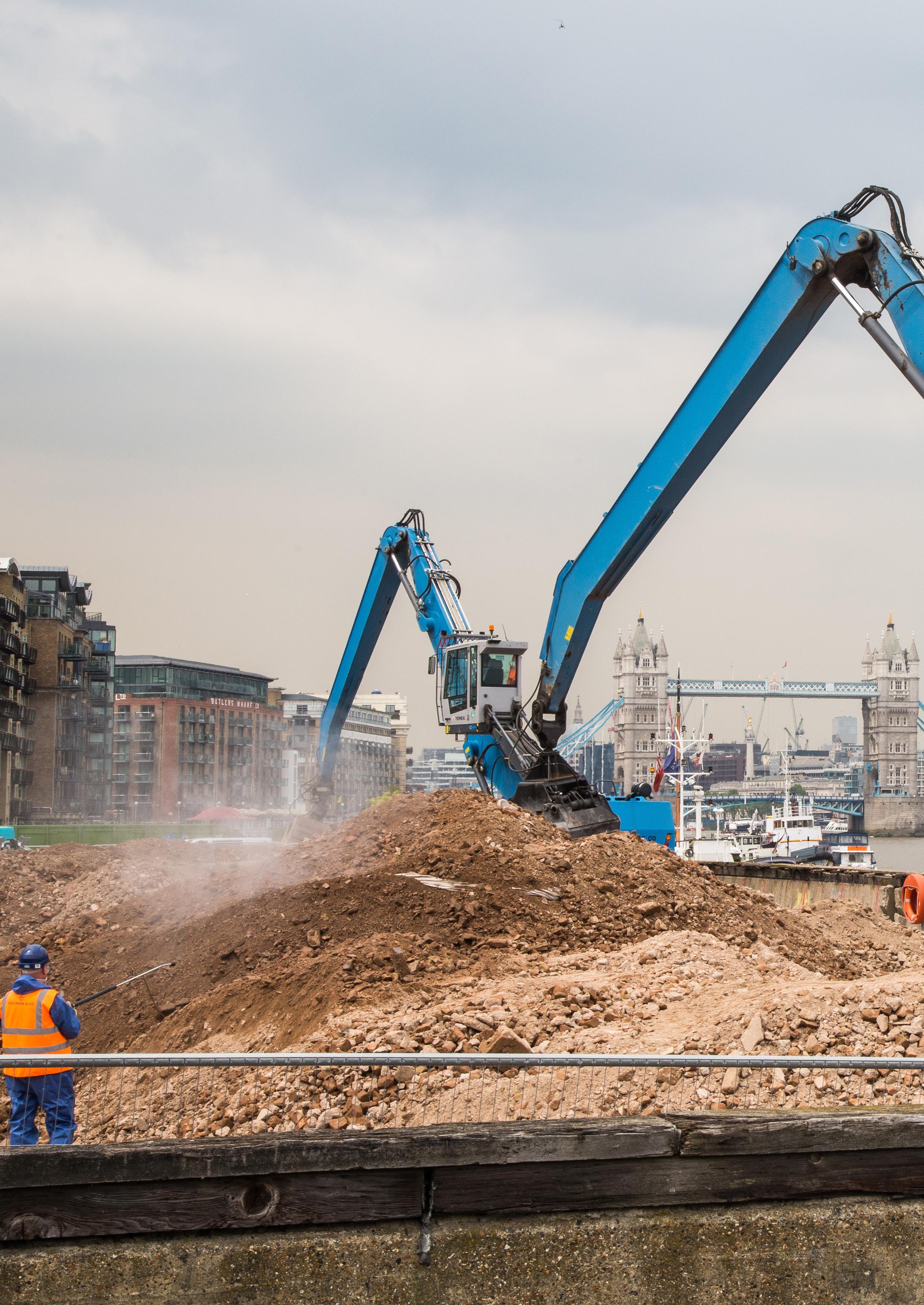
66 THE BRITISH DEMOLITION AWARDS 2023
77 CASE STUDY
Anglian undertakes major groundworks and remediation project to rejuvenate one of Norwich’s oldest estates
demolitionhub.com
DemolitionHub.com
34 CONTENTS
80 INTERVIEW
Ben Chambers speaks to Nathan Pidgley of Total Metal Recycling Ltd
89 CASE STUDY
Preserving history in Tampa, Florida
92 EXCAVATOR FEATURE Develon SANY

Sennebogen 870 E Demolition Hyundai JCB Komatsu Kobelco
104
DEMOLITION HUB ON SITE

Getting on site with the best of Britain’s contractors
112 HR
Revolutionising labour supply: The Labour Desk’s game-changing operating system HR best practice will be key to hiring and retaining the next generation of demolitionists
117 CASE STUDY
Forward Innovation Centers East and West redevelopment
122 PROFILE
GBM welcomes first female board member
124 INDUSTRY
Effective dust control at Normans AB with HPWDUST
126 OPINION


Richard Dolman: Building lifespan
Richard Clement: The red diesel ban in the demolition industry




Tim Turney: Protecting employees from silica dust exposure
manufacture
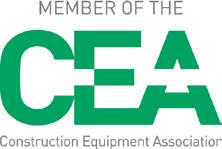
demolitionhub.com DemolitionHub.com Industry leaders in
and
of bespoke
equipment and modifications Kocurek Excavators Ltd. 24 Arkwright Road Hadleigh Road Ind Est, Ipswich, Suffolk IP2 0UB t: +44 (0) 1473 217477 e: sales@kocurek.co.uk www.kocurek.com ALWAYS IN REACH
design
excavator
The Crooked House was not demolished

Statement from the NFDC as of 16 August


To classify what happened at The Crooked House pub in the immediate aftermath of the fire in August as demolition does a disservice to an entire industry of skilled professionals.
Without even beginning to consider the moral implications of the wider story, no respectable demolition contractor would carry out works in the manner seen in the pictures circulating in the media at that time. The burned remnants of the treasured building were simply levelled, with no regard for the safety of local people or those employed to bring it down.
It seemed to be an unplanned,
poorly executed process with blatant disregard for regulation and public sentiment, resulting in the wilful destruction of an iconic structure that may have stood the test of reconstruction. Neither did there appear to be any consideration for the environment as no effort appeared to have been made to salvage and reuse the materials that were left of the building.
We and our members are proud of our heritage and take our role in its preservation and, where necessary, its respectful clearance and repurposing incredibly seriously. [Further, professional demolition work has taken place since the time of writing]
What we would expect to see from an NFDC member or other reputable demolition contractor:
• Local Authority permission –Section 81 as a minimum,
• A survey for asbestos containing materials,
• A structural survey for possible retention of structure,
• Exclusion zones inclusive of site boundaries,
• PPE + RPE worn by operatives,
• Welfare facilities for operatives,
• Appropriate signage to warn the public of works being carried out,
• Demolition-adapted machines with FOPS (Falling Object Protective System) over the cab,
• Appropriate machinemounted attachment, such as a selector grab,
• Environmental and health protection systems, such as a water/dust suppression system,
• Temporary works to support unsafe sections if necessary.
news
6 | DemolitionHUB Magazine DemolitionHub.com
NEWS
Industry reacts to Sunak’s net zero plans
Following Rishi Sunak’s speech readdressing the UK’s net zero plans, JCB and the CPA reacted to the policy U-turn
JCB welcomes Rishi Sunak’s plan “to have a better, more honest debate” about how we reach net zero by 2050. This debate needs to include how we plan for practical and affordable alternatives to fossil fuels.

Alongside battery-electric technology, hydrogen technology needs to be part of the government’s plans to decarbonise.
JCB’s own plans to decarbonise its equipment are already well advanced. Smaller JCB machines are already powered by battery-electric technology. Larger JCB machines will be powered by hydrogen, a zero CO2 fuel [at point of use], in purpose-designed internal combustion engines. Prototype JCB machines powered by hydrogen combustion engines have already undergone over 20,000 of hours of testing and have recently passed 10,000 miles on the road.
JCB Chairman and Conservative peer Lord Bamford said: “Hydrogen combustion technology is both practical and affordable, and if it were adopted more rapidly as a pragmatic alternative to fossil fuels, it would accelerate the decarbonisation of the construction industry and agriculture, allowing us to reach net zero targets more quickly.
“Hydrogen also has the potential to accelerate the decarbonisation of other industry sectors, such as automotive, steelmaking, ceramics and shipping. It’s a technology that is not inflationary and it should feature more strongly in our country’s net zero plans.”

Chris Cassley, Policy Manager of the CPA said: “The announcement by the Prime Minister adds confusion to the construction equipment sector on its efforts to remove diesel from sites and move towards alternative fuels.
“Like all business sectors, the construction plant-hire sector has a key role to play in decarbonisation. CPA members
want clarity and consistency in government policy when it comes to long established policies that impact on investment decisions, and the development of new diesel free technologies in construction plant.
”The Prime Minister’s speech does nothing to help this process and further throws into doubt future investment decisions and efforts to decarbonise the construction plant fleets of the future.”
news
JCB
Construction Plant-hire Association
DemolitionHUB Magazine | 7 DemolitionHub.com
Cawarden and J Freeley selected for £8bn National Procure Partnerships Framework
Procure Partnerships Framework has appointed 87 contractors to its second-generation National Framework, the biggest framework ever awarded across the UK.


The body has been operating and delivering a successful national contractor framework across England for the past four years, supporting the delivery of over 150 projects year on year.
Thirty-five contractors were reappointed on the next iteration of the framework, which is set to be the biggest framework ever awarded across the UK, structured across nine sub-regional lots covering five value bands starting at £50,000 and going up to £50m.
Two thirds of contractors within the lots up to £15m are small to medium enterprises.
The successful bidders will now cover four disciplines: construction, decarbonisation and retrofit, demolition and site preparation, and infrastructure.
Partnerships Framework said: “It was of paramount importance to Procure Partnerships Framework that the new framework addresses the growing needs of the industry, while ensuring clients have access to specialist contractors for their projects. As a result, we are delighted to have some new faces on the framework which will bring invaluable expertise to our clients and their projects.
“The new iteration of the framework is set to transform public and private sector procurement… we look forward to seeing what Cawarden achieves over the next four years [and] we’re delighted to welcome J Freeley to our second iteration of the Procure Partnership Framework. Their knowledge and expertise will be an invaluable asset to the framework, and we look forward to working with them over the next four years.”
and builds on our dedicated team’s success as a specialist contractor across other framework partnerships. We look forward to working as a trusted partner with our public sector clients on the demolition and site preparation projects under this framework.”
Oliver Crooks, Commercial Director at Cawarden said: “We are excited to have earned a spot on the Procure Partnerships Framework. Our goal is to work together to secure new opportunities and provide our demolition and site preparation expertise to deliver quality projects.”

The framework is built to be flexible, giving public sector clients in areas such as healthcare, local authority and education single and two-stage procurement options and different forms of call off contract.
Procure Partnerships
Framework will start to support the procurement of projects from 1 November, and successful bidders will lend to its success for the next four years until 2027.
Faye
Dolan, Head of National Frameworks at Procure
Michael Freeley, Director at J Freeley Ltd, said: “This appointment is a testament to our continued commitment to excellence

The full list of contractors under the Demolition and Site Preparation sector is as follows: A Buckler (Haulage), AR Demolition, Cawarden, Cheetham Hill Construction, City Demolition Contractors (Birmingham), DSM Demolition, J Freeley, O’Connell Contracting, P.P. O’Connor Group, Tom Prichard Contracting, Rhodar Industrial Services, V.H.E. Construction.
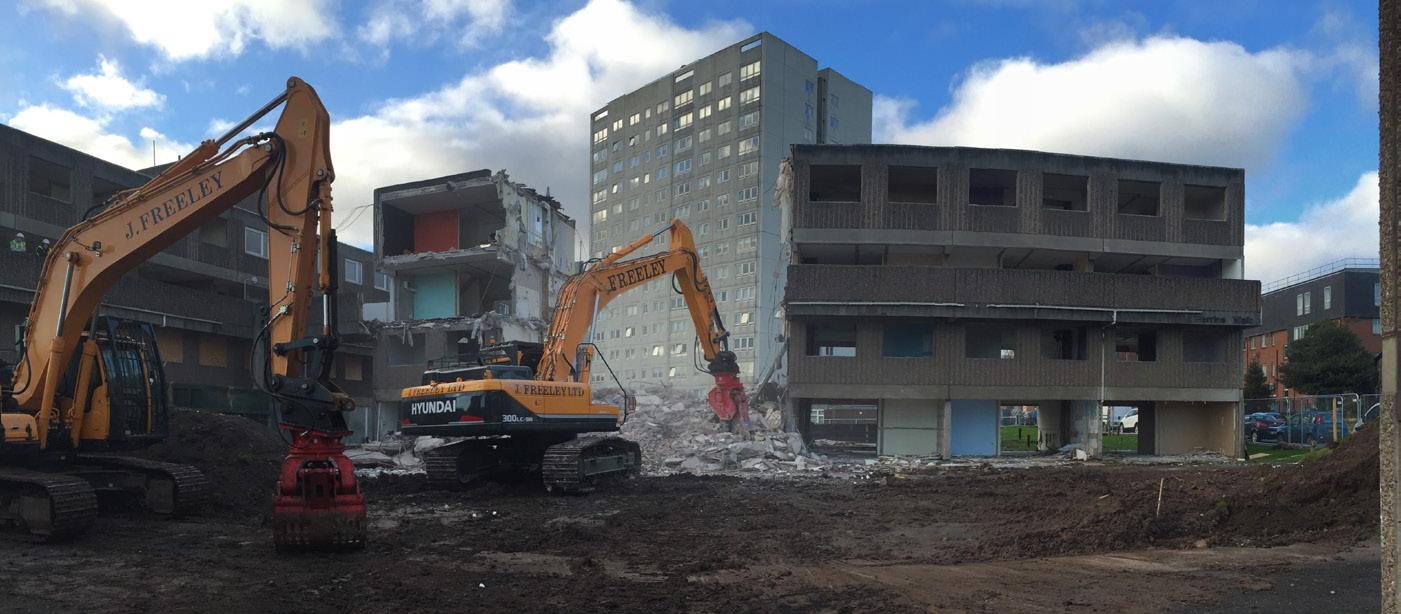
news 8 | DemolitionHUB Magazine DemolitionHub.com
“IT’S A FANTASTIC
EQUIPMENT TO HAVE”


The UK based demolition contractor Urban Regen has used OilQuick’s automatic quick coupler system for a couple of years now and couldn’t be more pleased with the solution.
– I think the name says it all. OilQuick is such a quick accessory to have. The biggest advantage is the continuation of the work. Earlier it could take half an hour to get out of the cab, knock pins out, take the pipes off and then connect everything again. With OilQuick there is no such stops when swapping attachments, says Paul Styles who is project manager for Urban Regen.
He finds the system particularly beneficial on wet and dirty sites.
– At the site where we are now there is about 12 inches sludge. This means that it can be both difficult and risky to step out of the machine to swap attachments. With OilQuick you don’t have to do that. You simply press the relevant buttons, and it all happens in the safety of the cab. It is just a fantastic equipment to have, he says.

FULLY AUTOMATIC QUICK COUPLERS FOR EXCAVATORS FROM 1 TO 120 TONNES
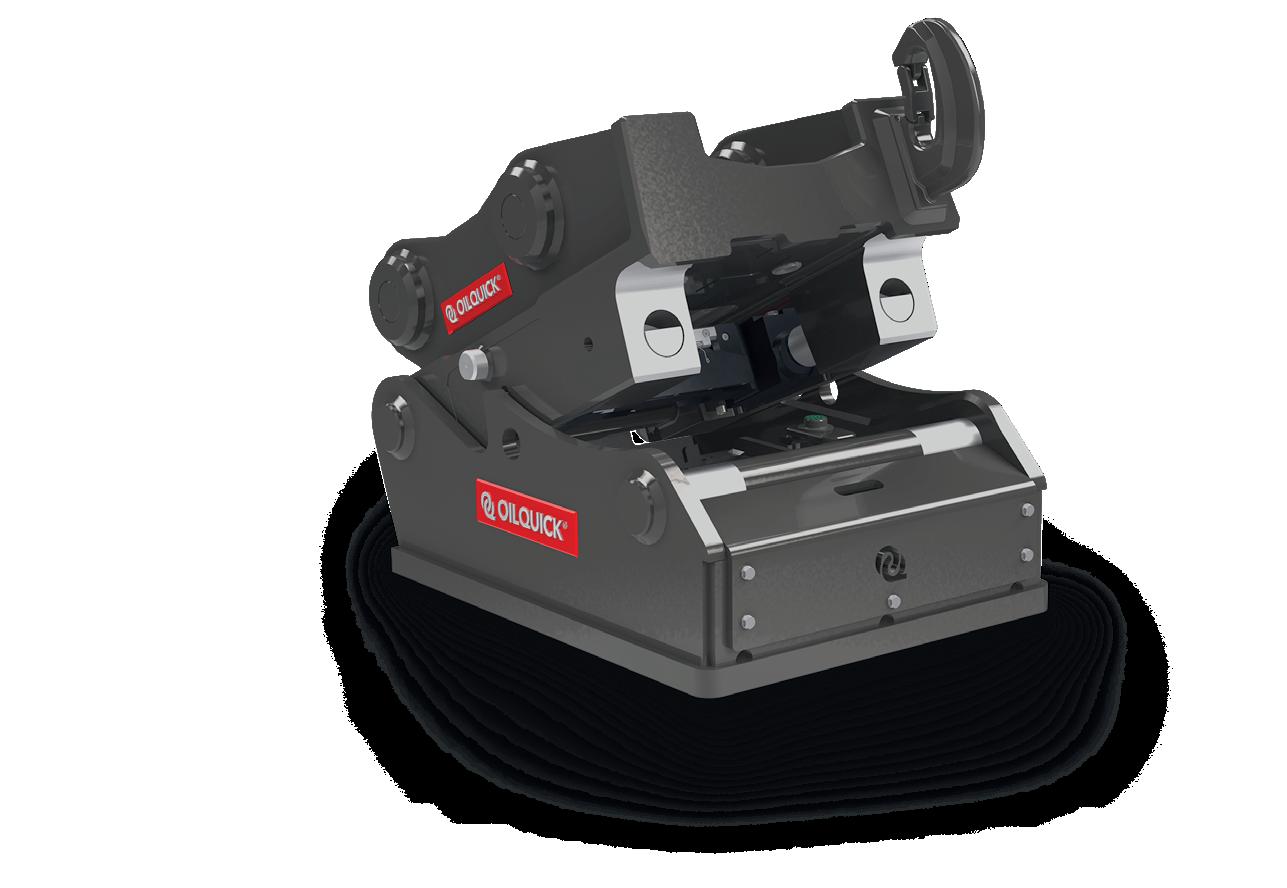
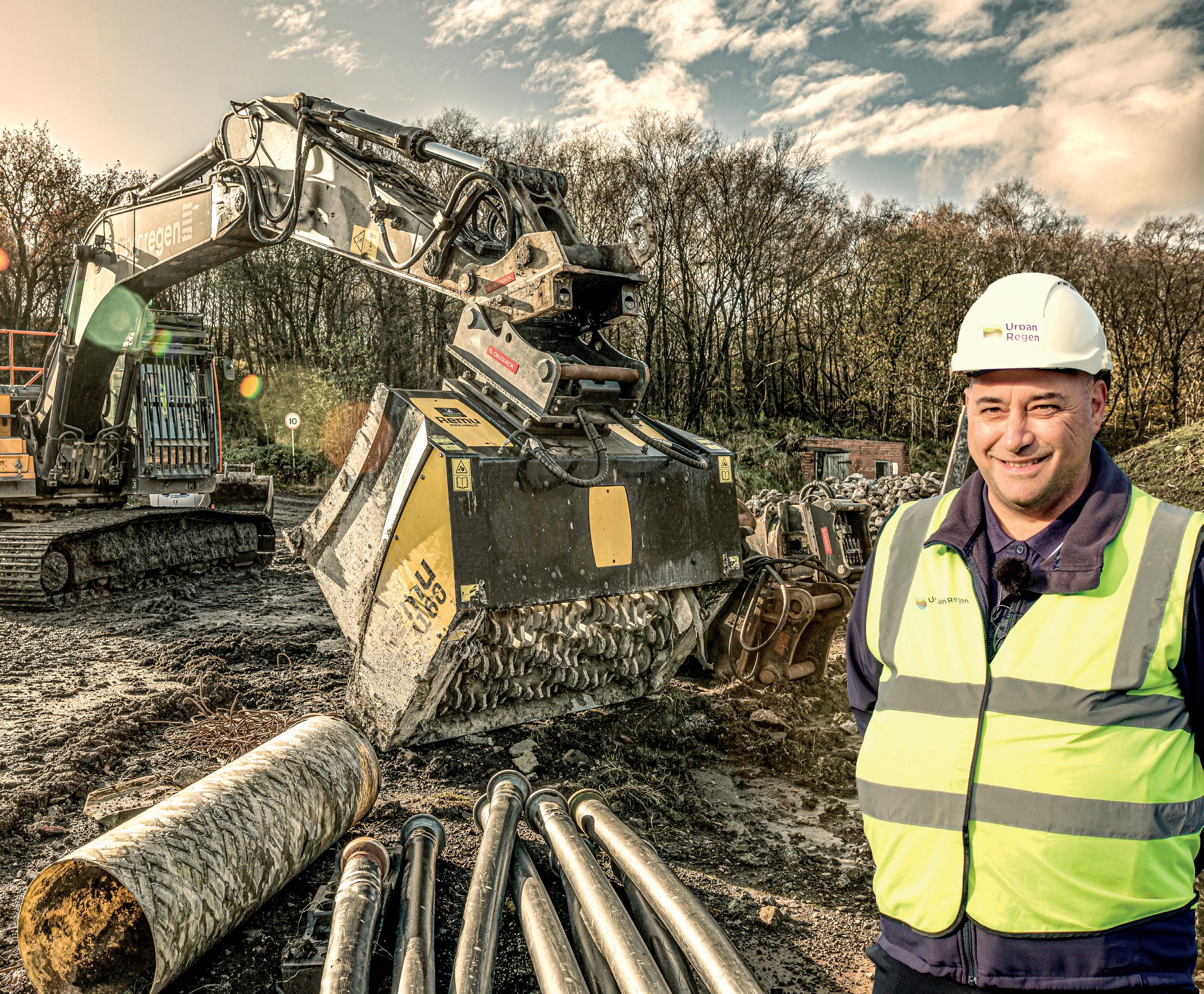
OILQUICK – SNABBT, ENKELT, EFFEKTIVT OCH SÄKERT oilquick.com Follow us Steve Parker: +44 (0)7375 644359 OQ
SCAN TO SEE THE VIDEO
LiuGong steps forward again for British Demolition Awards
After the most well attended British Demolition Awards yet, held at the Tottenham Hotspur Stadium in London on 1 September, we can confirm that LiuGong has put together the most comprehensive sponsorship package so far, to be the principal sponsor for the third year running.


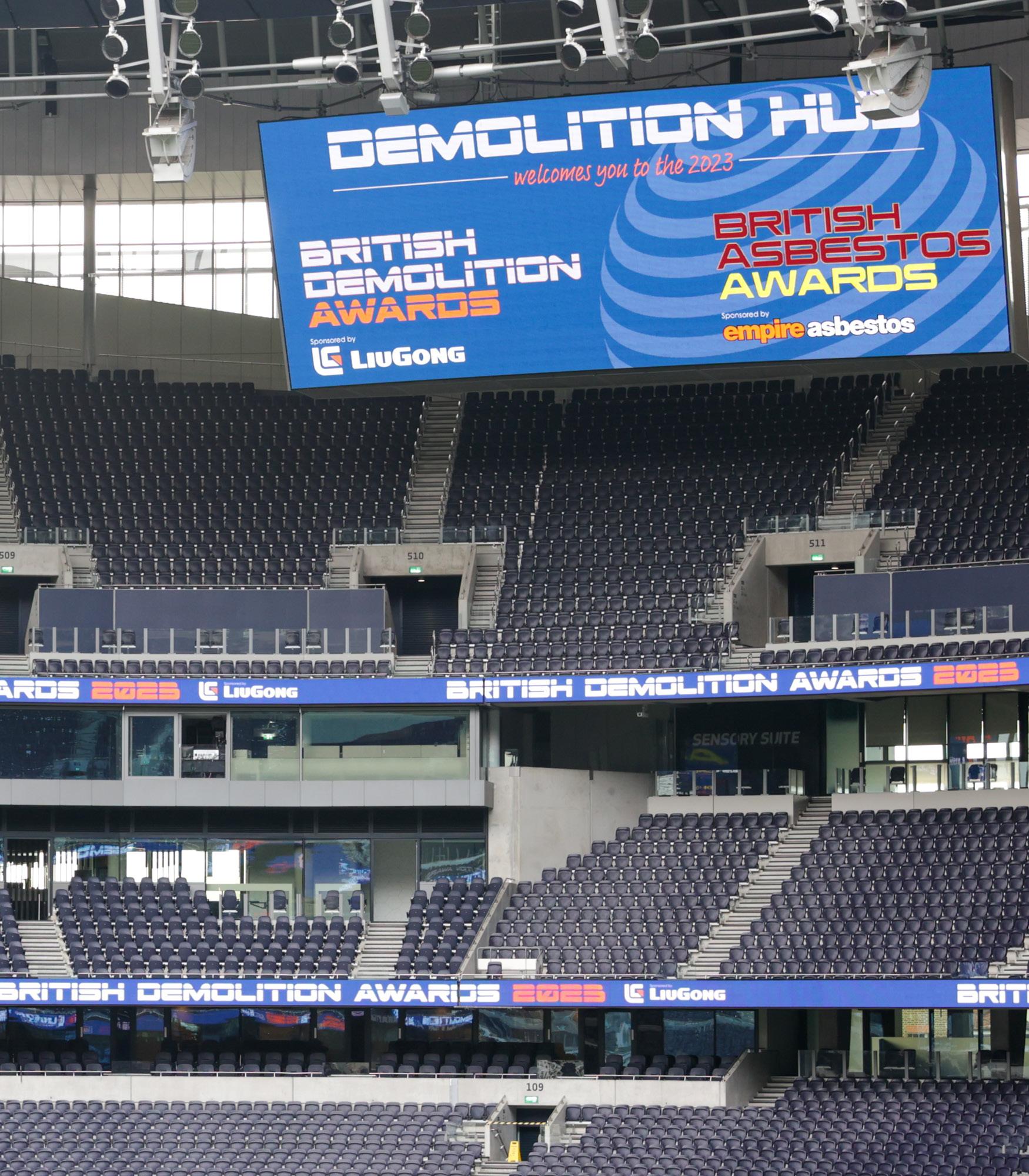
The news comes as the fifth British Demolition Awards amassed 20 demolition contractors, 22 suppliers as well as our colleagues
from the asbestos removal industry, allowing over 400 industry professionals to come together and celebrate this industry.
Global News Media and Demolition Hub founder Ben Chambers said: “The number of site visits I go on and see LiuGong excavators in all their glory is telling of LiuGong’s demolition impact. We have been supported by LiuGong since the returning awards event post Covid-19 in Brighton and to
have them as the principal sponsor once again is an honour.
“Steve Ford and his team have allowed the brand to flourish in the UK and we are right behind them as they are with us. I could not be happier that they are the principal sponsor as we return to London on 6 September 2024.”
To read more about and to see images of this year’s awards please go to page 66.

news 10 | DemolitionHUB Magazine DemolitionHub.com

0 3 3 0 2 0 2 1 3 1 8 i n f o @ s a n y u k . c o m s a n y u k . c o m
Preparations for the new EDA guide have begun
On Tuesday 5 September, the EDA officially started its most recent initiative: the Working Group about Recycled Products.

The creation of this subgroup was motivated by the increasing concern about circular economy and recycling. Since almost a third of the waste in Europe is generated by the construction sector. The upside of this is that almost all of it can be easily recycled.
Therefore, demolition and recycling professionals have come together to create a comprehensive document explaining the issue and the possible solutions: The guide about recycled products.
The subgroup, encompassed within the EDA Working Group on circular economy, is coordinated by Martin Car, from the Austrian demolition association, BRV. The publication resulting from this working group is set to be released in early 2024. You can learn more
EDA welcomes HITACHI
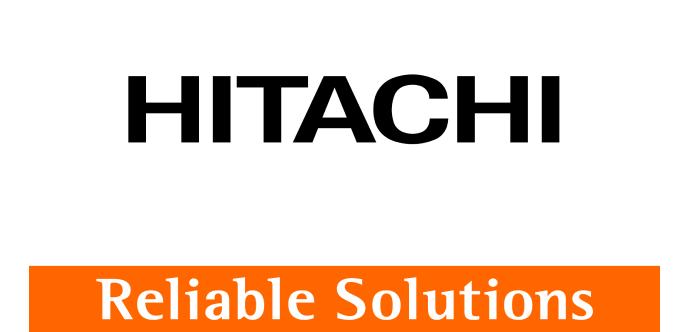
Hitachi Construction Machinery (Europe) NV (HCME) is a subsidiary of Hitachi Construction Machinery Co., Ltd. (HCM) and was established in 1972 in Oosterhout, The Netherlands. It is responsible for the manufacture, sales and marketing of Hitachi construction equipment throughout Europe, parts of Africa, and Israel.
Since its humble beginnings five decades ago, HCME has evolved into a successful multinational operation by focusing on engineering excellence and listening to the needs of its customers. The demand for Hitachi construction equipment across all territories has
grown steadily, and HCME has gradually extended its network of dealers to meet this demand.
To support the growing number of Hitachi machines working in its territory, HCME has a dedicated parts facility located in Oosterhout. The 53,000m2 European Parts Depot supplies dealers and customers, and can stock up to 90,000 parts items.
The company values that guide its strategy include acting with honesty and sincerity, having respect for the environment, being socially conscious and showing respect for others. Today,
about EDA working groups here: www.europeandemolition.org/ groups/presentatio


the company employs over 500 people, based at its headquarters in Amsterdam, and locations in Germany, Italy, France and the UK. Together with its people and partners, HCME’s mission is to deliver reliable customer-centric solutions, with Hitachi machinery as the foundation, enabling customers to create comfortable living spaces.
The vision of the company is to become the first-choice solutions provider helping to build a better future.
Demolition Hub is the media partner for the European
Demolition Association
12 | DemolitionHUB Magazine DemolitionHub.com
Don’t miss out the EDI Decontamination Forum
As we enter the second half of 2023, the European Demolition Association, EDA, is taking part in another event. The EDI Decontamination Forum is back, for the first time since 2016!



Organized by the European Decontamination Institute, EDI this forum will take place in Brussels on October 4th. The chosen venue is the SQUARE Convention Center, located in the heart of the Belgian capital.

The event will consist of two round tables. The first will be centred around Persistent Organic Pollutants, POPs. It will gather specialized public and private entities to debate several questions, such as where POPs can be found and how can they be identified.
After a coffee break and networking, the second round table will take place. This one’s main topic will be asbestos. Several
professionals will discuss the most recent legislation and other questions of interest.
Registration for the event is free of charge for public administration, contractors, national associations and engineering and consulting companies. On the other hand, suppliers have an affordable
sponsorship option. Don’t let it get away: be a part of the EDI Forum 2023!
Register for the EDI Decontamination Forum 2023 here: www.decontaminationinstitute. org/activities/events/ediforum-2023
DemolitionHUB Magazine | 13 DemolitionHub.com
EDA reunites the National Associations once again
September brought a very special occasion for European demolition – the Working Group of National Associations meeting.
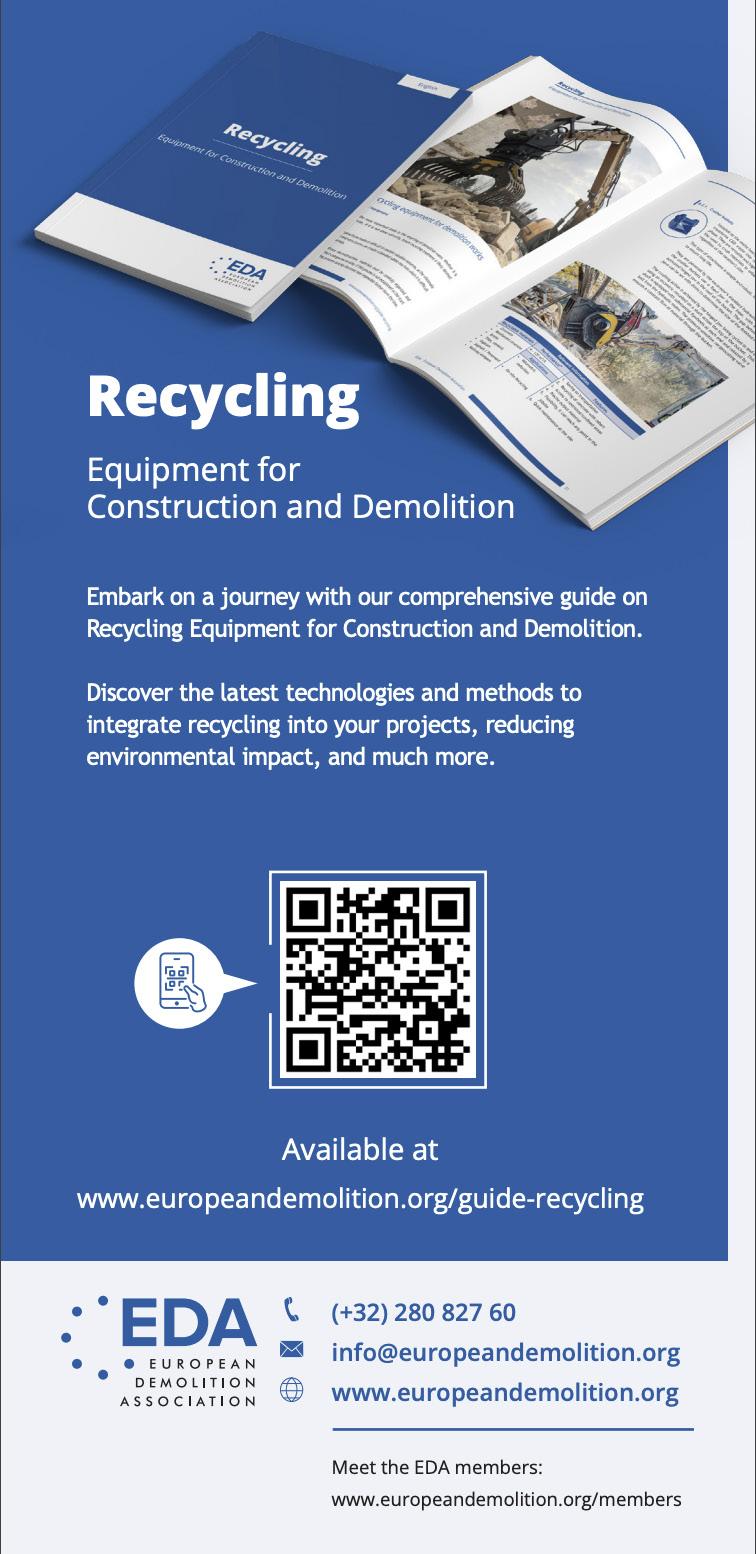

The annual reunion was held in Madrid on 14 and 15 September with The Spanish Demolition Association, AEDED, hosting the event. It was celebrated in a hybrid format, with both online and in-person Secretaries present.

The General Secretaries discussed several topics, beginning with a brief report about the general situation of the national industries. The number of members, estimated turnover and workers for the industry were talked about as well as the main issues in the demolition sector as of now.
Afterwards, the topic shifted to the next projects. In particular, the focus was put onto the EDA Circular Economy in Construction Awards, as well as the EDI Hazardous substances working group.
Finally, members were invited to bring new materials, topics or ideas related to the industries in each country.
From the EDA, we are thankful to all the Secretaries and National Associations that attended the event. These types of working groups and meetings are key to maintaining a united, collaborative demolition industry throughout Europe.
 Demolition Hub is the media partner for the European Demolition Association
Demolition Hub is the media partner for the European Demolition Association
14 | DemolitionHUB Magazine DemolitionHub.com
THE RISE OF THE WHEEL
NEW E-SERIES WHEELED EXCAVATORS
CASE excavators are back on wheels: built around proven and cutting-edge technologies, the all-new E-Series Wheeled Excavators put the operator’s comfort first. Enjoy the next level operating experience.
Contact your CASE dealer

NOW
Turning the old into the new
by Ellen C Ganime, Marketing Director for Empire Group
There was a time in the Lehigh Valley when all the cities were thriving with great industry like Bethlehem Steel, Western Electric and Mack Trucks, but those days are now long gone. At times, it can be disheartening to demolish these venerable structures. Yet, knowing that by removing the unusable and unsafe portions of a property so that the remaining, integral portions can be repurposed into new life makes the work rewarding. This is especially true when the work brings back manufacturing and employment to an area where it has been hard to come by in recent years.
This situation is not unique to Allentown, Pennsylvania. While many manufacturing sites have been demolished, there are sites all over that have benefited from adaptive reuse. One of Empire Services’ most recent projects, the repurposing of a Mack Trucks turned Allentown Metal Works plant, is an example of this trend. The property, which was closed for good in 2011, is unique in that the products manufactured there date back to the early 20th century, designating it a historical manufacturing site.
The first owner and occupant of the property was Traylor
Engineering Manufacturing Company. In 1902, Samuel Traylor founded Traylor Engineering to manufacture heavy-duty steel components used in the mining, construction and concrete industries. These products, and even Mack Trucks, however, could not keep this piece of Americana alive.
Allentown Metal Works will not be another footnote in Allentown’s history, however. It’s getting a second chance at life through Marcon Properties LLC. The Allentown contractor is repurposing two buildings totaling 160,000 square feet (14,900 m2), on the property, creating a modern production facility for affiliated Eastern Exterior Wall Systems. Together with project partner Alvin H. Butz Inc., Empire Services has given the Allentown Metal Works site a new purpose for future generations.
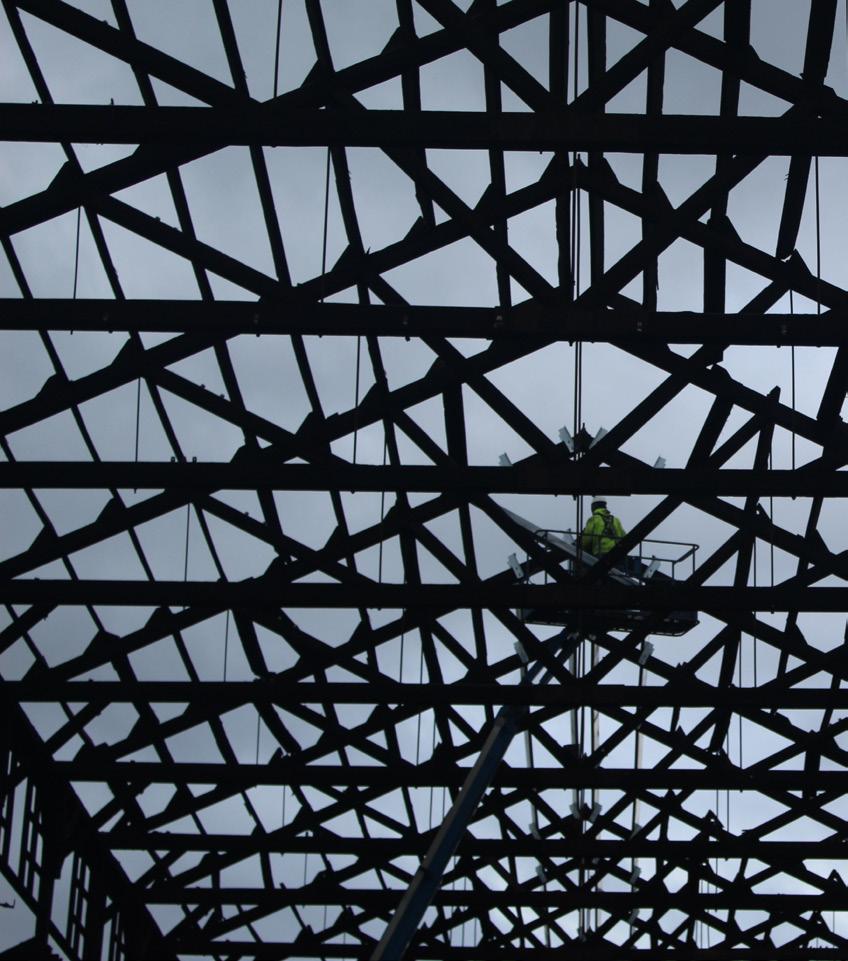

A familiar site

Serving as contractors first to the Allentown Economic Development Corporation, Empire Services demolished building A’s top floor

16 | DemolitionHUB Magazine DemolitionHub.com
after a partial roof collapse. That work enabled Empire Services to gain first-hand knowledge of the site, so when they were contracted by Alvin H. Butz Inc. to assist with repurposing the facility, they were ready to perform select demolition and excavation work. Additionally, Empire Services was able to help budget, plan and value-engineer the project with Alvin H. Butz Inc.
Taking it down to its shell
Since the existing two buildings were stable, it made sense to repurpose them and reuse the materials. The project on the smaller building began in October 2022 with the bulk of the work having been completed in mid-January 2023.
Taking the 50,000-square-foot (4,600 m2) building down to its shell for renovations was necessary and included the removal of all windows, window infills, roofing, roof decking, metal panel walls, mechanicals, utilities, doors and partitions. Numerous roof purlins also required removal due to wood deterioration since the building’s closure over
a decade ago, and mechanical equipment pits in the floor required equipment and material removal prior to backfilling with crushed concrete and clean stone to provide a level surface for the new concrete slab installation.
When it came to devising the demolition strategy, it all came down to sequencing.
“The strategy for this project was straightforward,” says Matt Bard, Empire Services’ Chief Estimator. “We had to develop a sequenced approach that would allow us to maximize our productivity while ensuring we still had a safe work site with minimal hazards.”
Empire Services needed to perform the select demolition as quickly and efficiently as possible, coordinating multiple crews working simultaneously and releasing completed sections of the building for other contractors. As a result, renovation and rehabilitation work on the building began earlier than expected, exceeding deadlines to have the new manufacturing site operational.
Top to bottom, east to west
Once the strategy was in place, Empire Services began demolishing the interior of the building. The crew removed partitions and other finishes by removing mechanical features from the roof level down to the slab, moving east to west through the building. The work was done by hand using high-reach lifts ranging from 60 feet (18 m) tall to 135 feet (41 m) tall, along with torches and demolition saws.
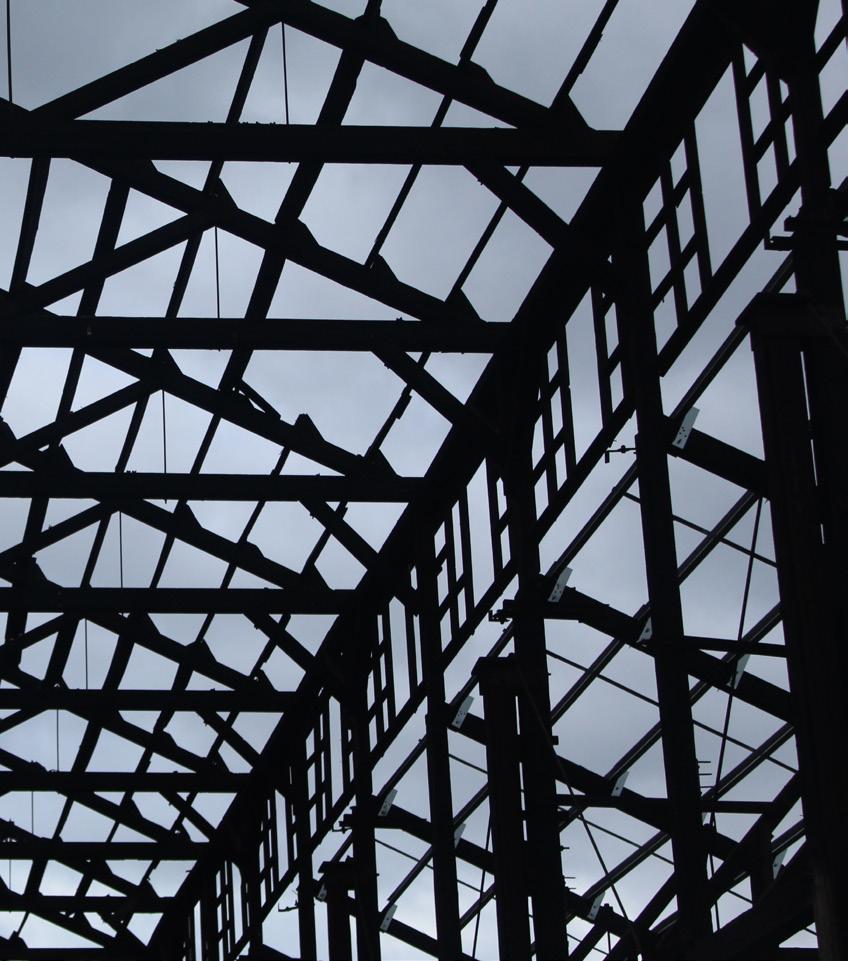
Once the interior demolition was approximately 50% complete, additional crews demolished the roofing and wall sections. Windows and window infills were then removed following the same eastto-west approach, allowing multiple crews to work simultaneously and providing a safe drop zone for demolished roofing materials. Multiple articulating boom lifts ranging in height from 60 feet (18 m) to 135 feet (41 m) were used to access the different levels of roofing material, windows and mechanical features during this stage.
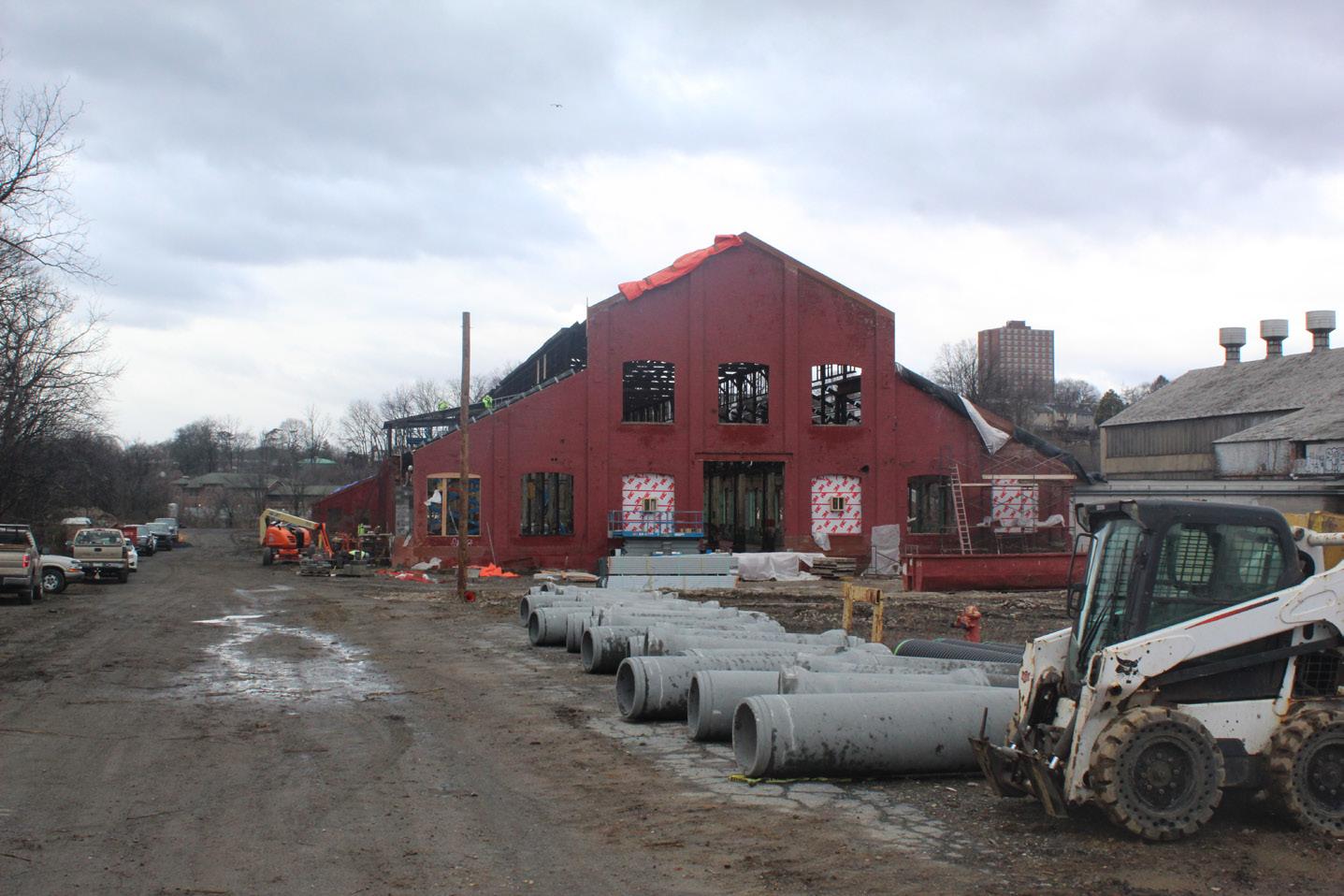
While completing the work, a

DemolitionHUB Magazine | 17 DemolitionHub.com
Demolition Hub is a proud supporter of the National Demolition Association
Bobcat T190 compact track loader with a grapple bucket and a CAT 345 excavator loaded out and managed materials to keep the job site as clean and safe as possible. Upon completion of roof and wall demolition, Empire Services moved on to demolish select sections of concrete slab where required for future slab-on-grade improvements, again working from east to west. The CAT 345 excavator with a hydraulic hammer was used to fracture and remove sections of raised and thickened slabs to provide the appropriate grade for the new concrete slab installation. Demolition of the slabs and completion of wall openings occurred in February 2023.
Project challenges

The biggest challenge for Empire Services was working at great heights with a crew varying in size (six to ten members). Working to surgically remove roofing panels
and mechanical features from the basket of a personal lift safely and efficiently is never an easy task. Performing torch cutting (or other demolition work) while wearing a harness and being tied off the equipment’s anchor point to ensure proper fall protection is always a challenging and time-consuming process. As work progressed and additional trades began to work on-site, coordination of deliveries, work areas and safety became critically important.
By developing a sequenced approach, Empire Services successfully completed the project

in February 2023 – ahead of time and on budget. Approximately 20 tonnes of metal was recycled and 200 cubic yards (153 m3) of crushed concrete was able to be reused as part of the pit infill. With the demolition complete, the new manufacturing is set to soon bring back the excitement of Allentown’s manufacturing history and provide an economic boost to the city.

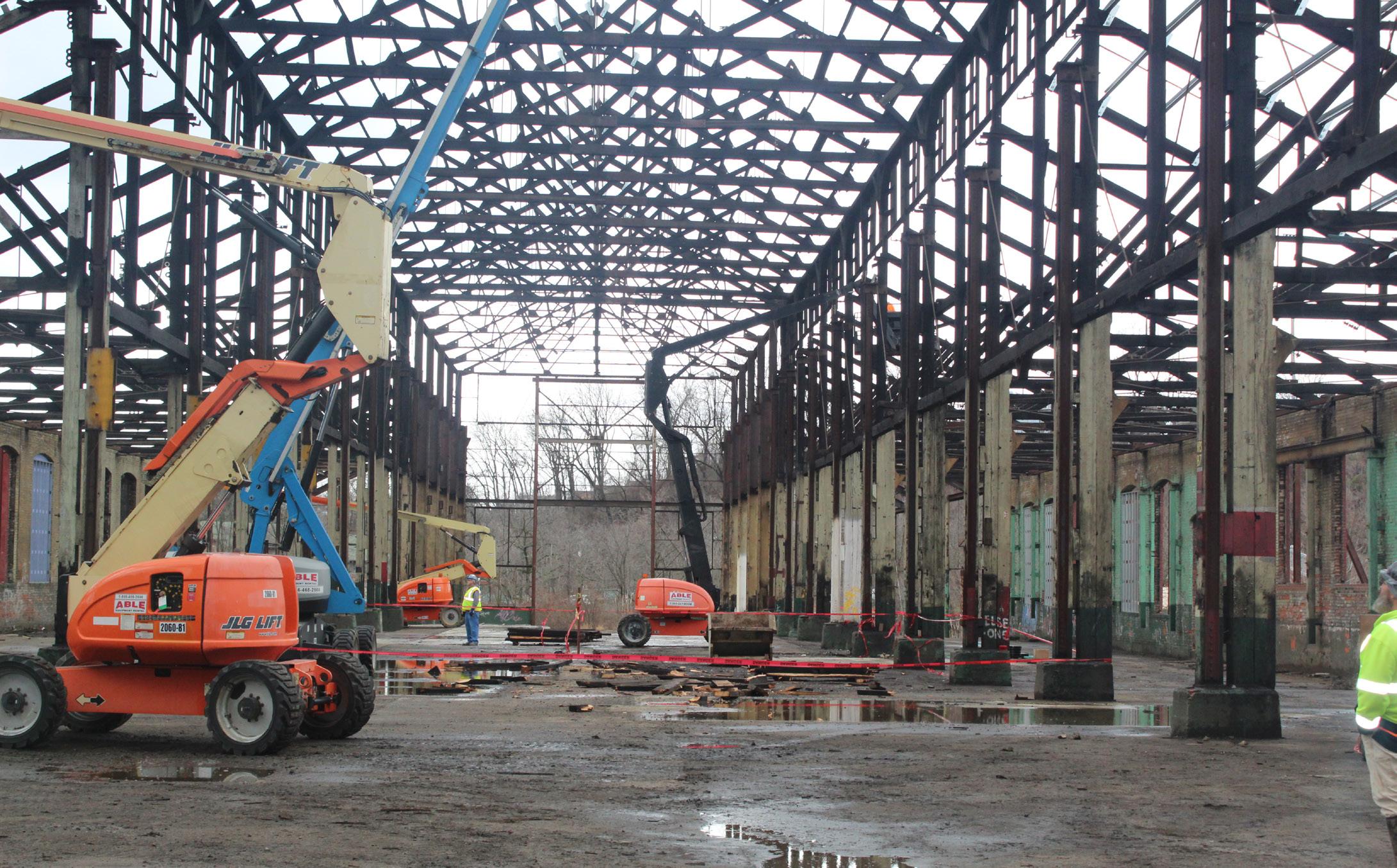
18 | DemolitionHUB Magazine DemolitionHub.com





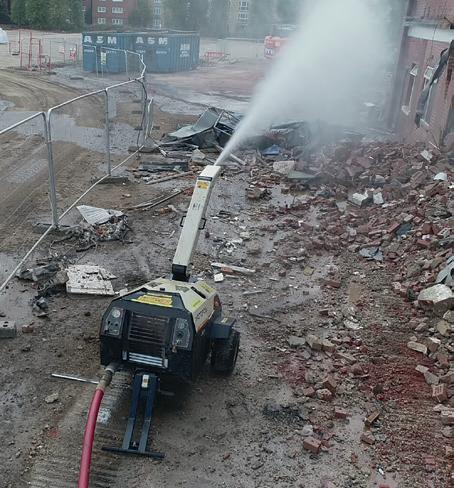



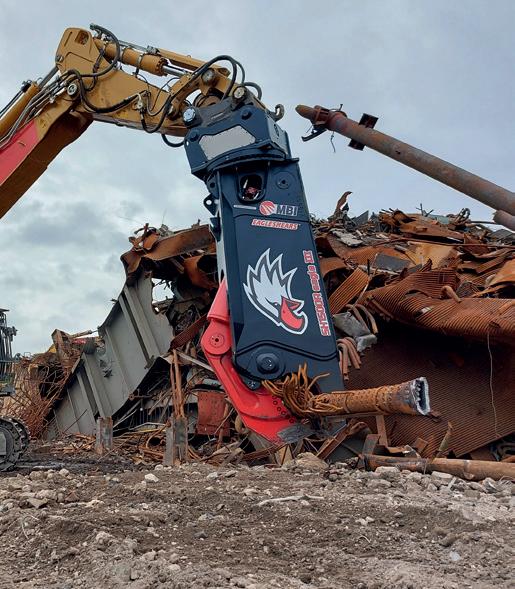








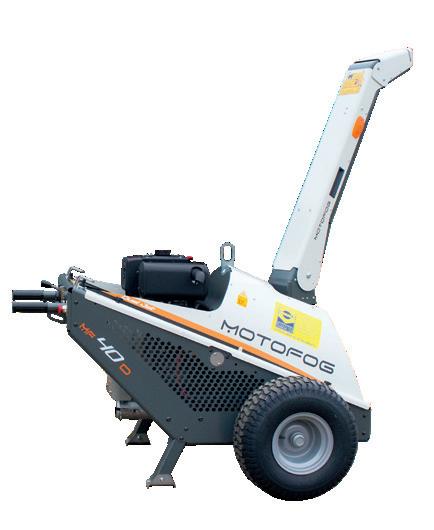


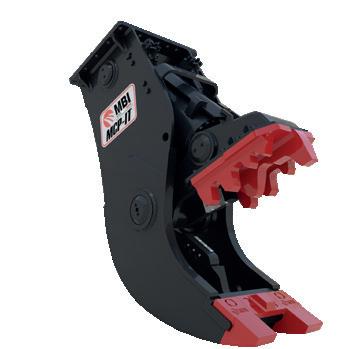
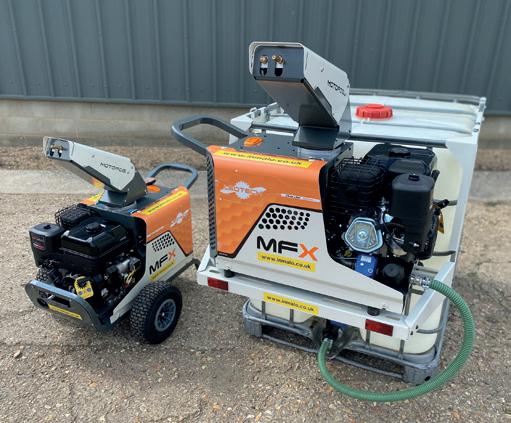



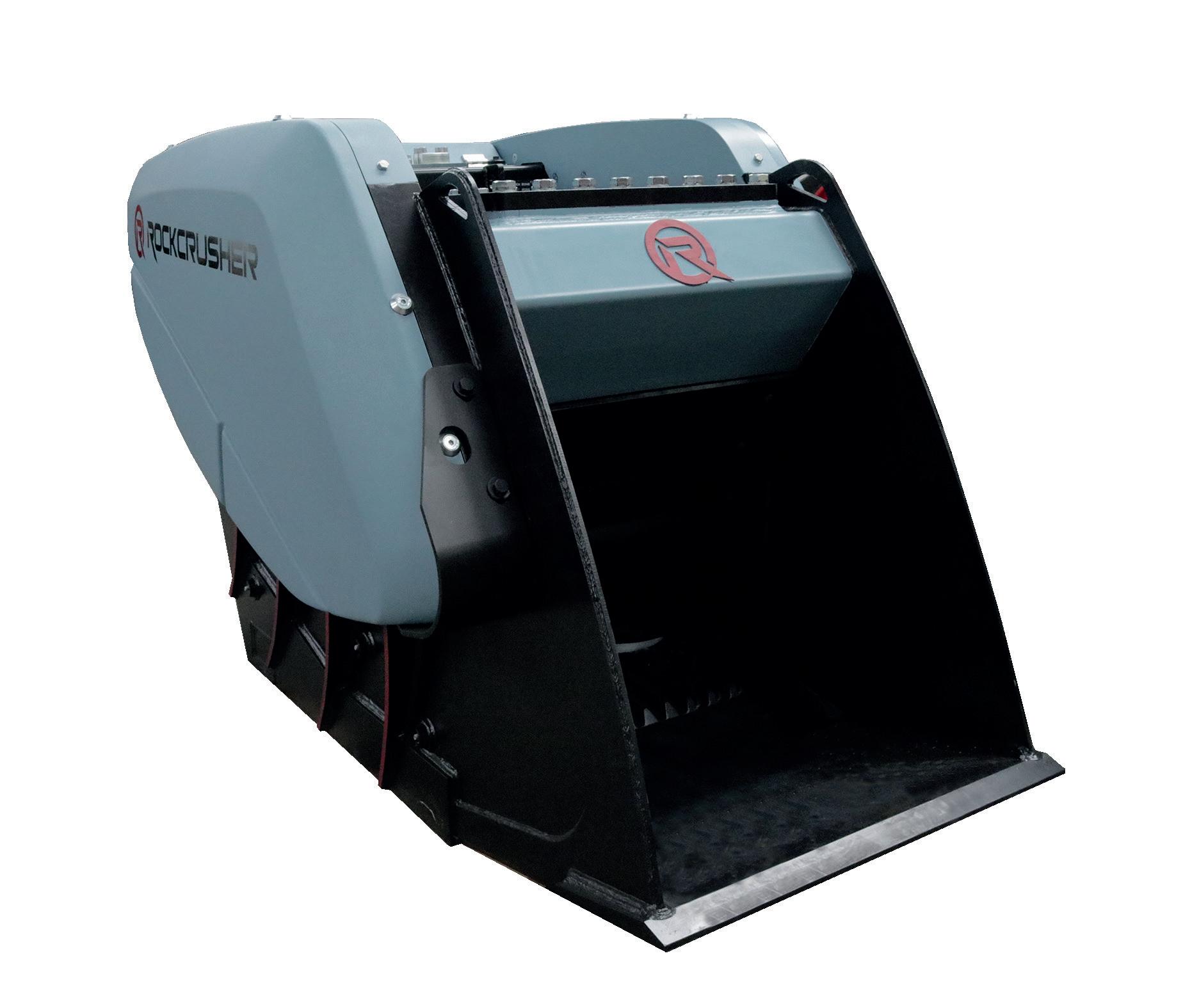
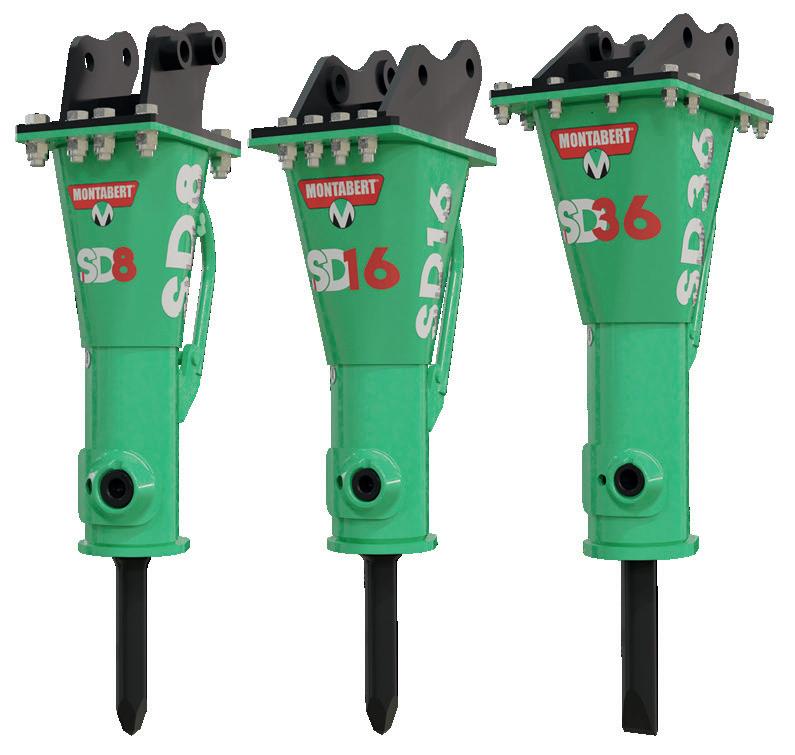

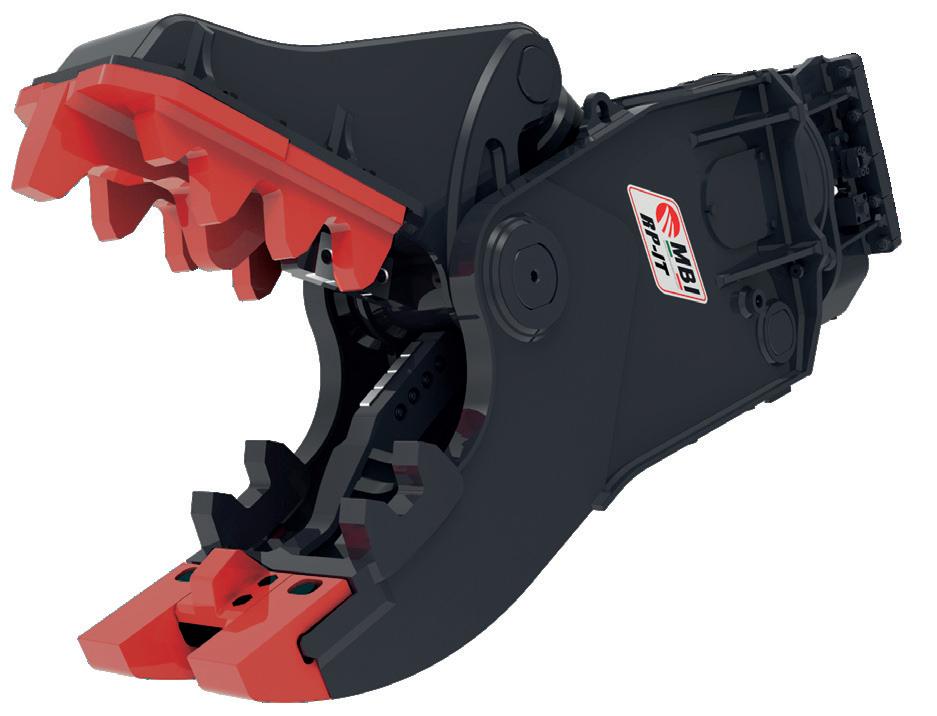
Preserving history through precision
In the heart of Boston’s historic Back Bay, a unique project recently unfolded that required both precision engineering and a deep understanding of historical preservation. The task at hand was the partial demolition of a condemned church, dating back to 1896, nestled at the intersection of Stuart and Arlington streets. The project was undertaken by NDA member JDC Demolition, a company with a proven track record in handling similar ventures.
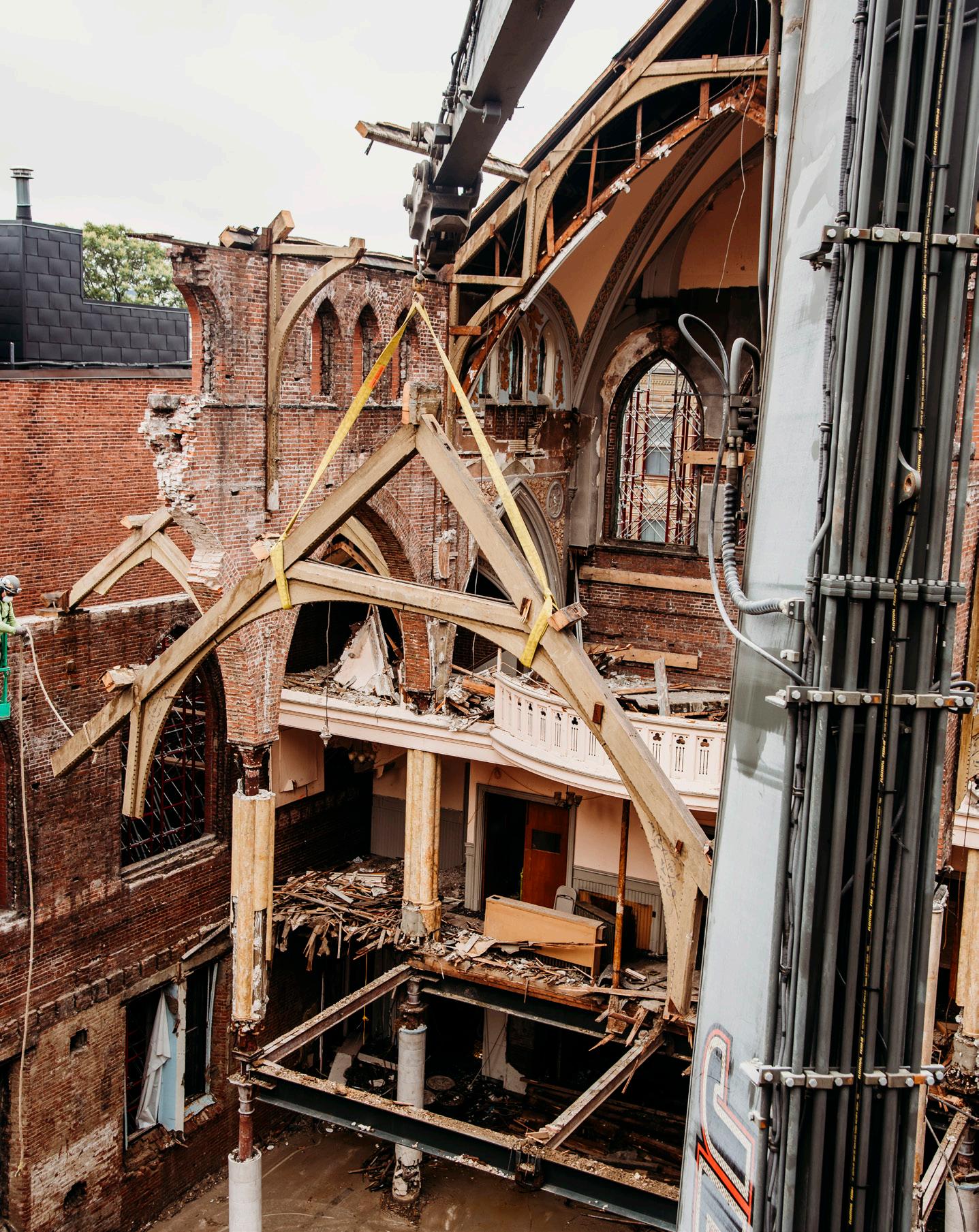
Selection and rationale
JDC Demolition was chosen for this endeavour due to its prior experience with projects of this nature and a history of successful outcomes. The developer, Kems Corp, recognised the importance of expertise in the delicate process of partial demolition. The church’s location within Boston’s Back Bay, known for its architectural significance, demanded an approach that balanced the need for structural change with the preservation of historical elements.
Project timeline and equipment
The project kicked off in mid-May 2023 and concluded toward the end of July, showcasing the efficiency of the selected team. The equipment used included a Volvo 480 HR and 135 / 150-foot (41/46 m) boom lifts. These tools were crucial in executing the multifaceted strategy devised for the project.
Demolition strategy and uniqueness

JDC Demolition’s scope encompassed a series of intricate steps, demonstrating the complexity of the task at hand. The strategy involved engineering a partial
 JDC Demolition
JDC Demolition
20 | DemolitionHUB Magazine DemolitionHub.com
structural dismantling plan, focusing on preserving the exterior perimeter walls that were to remain after demolition. The coordination with a bracing design was instrumental in ensuring the stability of these walls.
The unique challenge arose from the requirement to retain the outer four walls of the church. These walls, exposed to years of weather and environmental elements, necessitated a $1.5m (£1.23m) shoring system for support. JDC Demolition meticulously planned each phase, including the removal of the upper roof structure, demising arched masonry wall, and lower roof and support structures. This intricate sequence allowed the team to safeguard the historical significance of the structure while carrying out essential demolition.
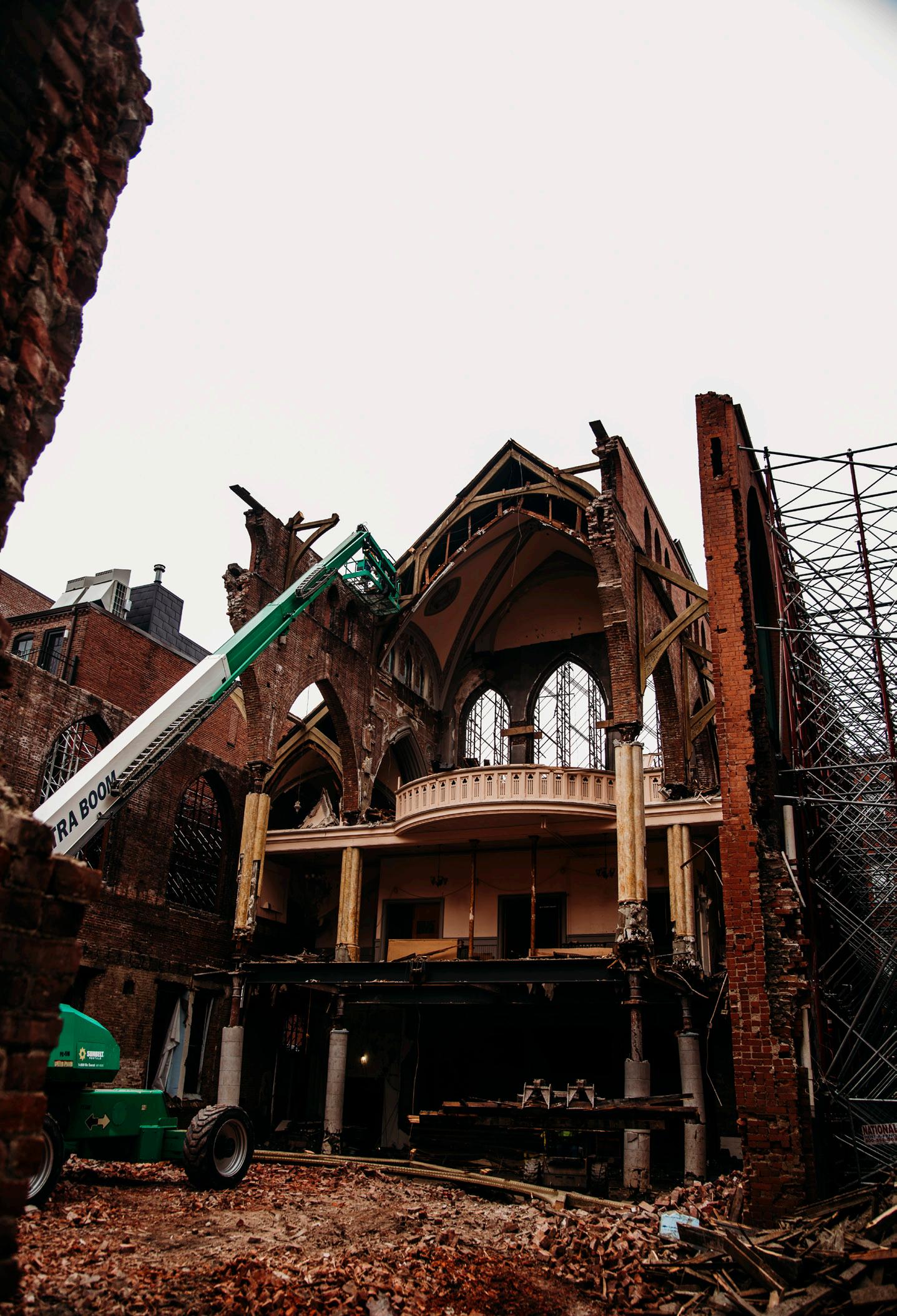
Execution and challenges
The project was not without its challenges. One of the key hurdles was coordinating with neighbouring properties, instilling confidence that the process was structurally sound and ensuring the safety of crew members. Tight site logistics and working at heights exceeding 60 feet (18 m) added further complexity. Effective communication between personnel working at different levels was paramount to maintaining a safe and efficient work environment.
Environmental responsibility and salvage

While the focus was on dismantling, the project also exhibited a commitment to environmental responsibility. Approximately 50 tonnes of steel, cast iron and southern yellow pine from the roof and floor framing were carefully salvaged and recycled, minimising waste and maximising sustainability.
A successful endeavour
In the eyes of JDC Demolition, success was achieved through meticulous planning, strategic execution and effective communication. The project was a testament to the company’s ability to blend expertise in demolition with a profound respect
for historical preservation. The team’s dedication to understanding the intricacies of the church’s structure and crafting a unique demolition strategy ensured that the project achieved its objectives without compromising the historical value of the remaining exterior walls.
DemolitionHUB Magazine | 21 DemolitionHub.com
Demolition Hub is a proud supporter of the National Demolition Association
OSHA’s Severe Violator Enforcement Program is worse than ever before
by Adam R Young, Mark A Lies II, and Daniel R Birnbaum
Many American employers are unaware of an Occupational Safety and Health Organization (OSHA) enforcement programme known as the Severe Violator Enforcement Program (SVEP). Those who are unaware of SVEP should become aware of it quickly, as it is essentially a blacklist that can have a significant, negative impact on one’s business.
For the first time in over a decade, OSHA has updated its compliance directive related to SVEP. With this update, it’s important employers know how they can be added and removed from the programme, how to navigate through the programme if one finds themselves in it and what these changes mean for OSHA enforcement policies.
Why is OSHA’s SVEP problematic for employers?
As part of SVEP, federal OSHA maintains a nationwide list of severe violator employers. This list, updated quarterly, is easily accessible on OSHA’s national website and visible to the following:
• Potential and existing clients
• Competitors
• Labour organisations
• Workers’ compensation attorneys
• Public interest groups
• Personal injury attorneys
Given OSHA’s limited resources for enforcing its regulations, SVEP seeks to concentrate OSHA and the Department of Labor’s legal resources against employers on
the SVEP list, on a nationwide basis (including federal OSHA and OSHA State Plan states).
An employer’s inclusion in SVEP immediately creates a host of labour, operational, legal and publicity issues. In many cases, the employer is unaware that it is even on the publicly available SVEP list until it receives inquiries from third parties, including the media. Additionally, employers on the list may be subject to negative publicity, lose out on work from potential clients, be subject to aggressive negative campaigns by both competitors or labour organisations, and could potentially be targeted by aggressive personal injury attorneys.
It is clear that OSHA cannot simply open an enforcement inspection against an employer unless it has some basis to indicate that the employer may not be compliant with OSHA and is creating a hazard to employee safety and health. Thus, OSHA must have probable cause for the specific inspection, including a neutral basis to choose that employer. OSHA takes the position that SVEP creates such probable cause and a neutral basis to allow it to do “referral” inspections that otherwise would be impermissible at many work sites around the country. While OSHA referral inspections are supposed to be limited to “related workplaces” with “similar hazards,” these terms are undefined and nebulous. OSHA broadly interprets these terms to justify inspections
on an employer’s other work sites that have “substantially similar” hazards. In such instances, OSHA could potentially issue Willful or Repeat citations with penalties up to $145,027 (£118,600) per violation. Moreover, under OSHA’s procedures, after an inspection results in an employer’s designation on the SVEP list, OSHA could do a follow-up inspection at the cited work site or a similar work site at any workplace around the country.
Criteria for inclusion (and removal) from OSHA’s SVEP
When OSHA issues a citation, an employer’s inclusion in SVEP is programmatic and based on the alleged violation, assigned gravity of the violation and classification of the citation. OSHA does not do any independent qualitative analysis and will add an employer to the list based on the following types of citations:

• A fatality/catastrophe inspection where OSHA finds:
• At least one wilful or repeat violation,

• A Failure-to-Abate notice based on a serious violation directly related either to an employee death or an incident causing three or more employee hospitalisations.
• In cases where OSHA’s citation is not based on a fatality, an employer will be placed in SVEP where they have at least two Willful or Repeat violations, or Failure-to-Abate notices (or any
22 | DemolitionHUB Magazine DemolitionHub.com
combination of these violations/ notices), based on the presence of high gravity serious violations of low or moderate gravity do not qualify.
• Employers cited for WillfulEgregious citations (e.g., violation-by-violation penalties) also will be included in SVEP.
OSHA identifies a SVEP case and refers the employer into the programme at the time the citations are issued, meaning when the violations are alleged. An OSHA citation is merely an allegation that an employer can contest/appeal. The contest/appeal of OSHA citations does not stay the inclusion in SVEP or remove the employer for the duration of the appeal. The inability of an employer to prevent being included on the SVEP list and avoid the significant liabilities discussed in this article is one of the factors that poses a significant threat to the employer’s reputation and economic viability. OSHA is well aware of the dire consequences of being placed on the SVEP list since, at the time of its initial creation, the agency touted it as a regulatory tool specifically intended to shame employers into compliance.
OSHA includes employers in SVEP for a minimum of three years, beginning on the date OSHA receives abatement certification of the alleged violation (not the date of the accident or date that citations are issued). OSHA can choose to remove employers from the programme, generally after three years, when they have paid the penalties, abated all hazards, received no serious citations related to the same hazard and have received at least one follow-up or referral SVEP inspection.
Recent changes in enforcement
On 15 September 2022, OSHA updated its enforcement procedures related to SVEP for the first time since 2010. OSHA has expanded its reach under SVEP by no longer requiring exposure to specific highemphasis hazards or hazards related to process safety management when considering non-fatality cases for
inclusion in SVEP.

Additionally, SVEP removal eligibility has been expanded to begin three years after the date an employer completes abatement, as opposed to the three years from the final order date of a citation. OSHA has also updated SVEP enforcement by adding a minimum two-year duration in SVEP that includes specified criteria for removal based on a safety and health management system.
In order to reach an informal resolution of the citations that lead to the employer’s inclusion in SVEP, OSHA typically demands a draconian list of “enhancements” in order to agree to a settlement. Many of the enhancements involve substantial monetary investments by employers in engaging outside consultants, conducting audits, changes to work practices and periodic reporting of these actions, which frequently go well beyond the compliance requirements in the regulations themselves. In many cases, these enhancements can run into thousands of dollars of additional expenditures.
Another critical impact on employers who are included in SVEP is the negative impact on employer’s rights under workers’ compensation laws. The inclusion in the programme could impact the employer’s ability to rely upon the limitations of liability under state workers’ compensation laws and result in employees being able to avoid workers’ compensation limitations and bring civil personal injury claims or seek enhanced workers’ compensation benefits as a result of the nature of the OSHA violations.
Recommend practices for employers
Because of the many technicalities involved in inclusion and removal from SVEP, it is critical that employers engage legal counsel who are very familiar with OSHA practice. For example, where inclusion in SVEP is based on new citations under contest, the fastest way to get the employer out of SVEP is to settle the citation for a



lesser classification or, for fatality citations, a citation unrelated to the fatality. While reducing a Willful violation to a Repeat classification would not remove the company from SVEP, reducing a Willful to a Serious classification would remove an employer from the programme. Also, as removal from the programme is now based on abatement completion, it benefits an employer to abate as quickly as possible rather than waiting for the citation to become a final order. Employers must closely evaluate their defences to any Willful, Repeat or high-gravity citations and work with outside legal counsel to settle in a manner that will ensure that the employer is removed from SVEP.
Conclusion
It is apparent that SVEP is a lurking liability issue for American employers, particularly in those industries that are classified as highhazard industries. In order to avoid SVEP liability, an employer should 1) conduct a comprehensive hazard assessment at its work site to identify all hazards, 2) develop compliance safety programmes that address each such hazard, 3) conduct meaningful training of employees in such safety programmes, 4) enforce compliance by employees with safety programmes through the use of discipline, and 5) document all efforts taken to address items 1 through 4. If an employer takes these steps, it is very unlikely that an they will be targeted for inclusion in SVEP.
Clockwise from top left: Adam R Young, Mark A Lies II and Daniel R Birnbaum work on the Workplace Safety and Environmental Group at Seyfarth Shaw LLP
DemolitionHUB Magazine | 23 DemolitionHub.com
DEMOLITION DISCUSSION
Interviewee: Lee Brash
Role: Managing Director
Company: Total Controlled Demolition Services

QHow did you start out in the industry, what attracted you to it?
I started out in the demolition industry as a labourer undertaking basic internal soft strip of buildings, hand demolition of small structures and salvage of bricks, slate etc. I enjoyed working in this industry specifically trying to identify solutions to challenges faced with deconstructing a building. I realised early in my career demolition was an industry I wanted to progress in as it was exciting, each day there was something different happening, no two days were the same. I was especially inspired by the vast variety of plant and equipment I had the opportunity to work with in the demolition industry, specifically the high reach.
QHow has your career developed to where you are now?
I progressed from a labourer to becoming a heavy plant operator undertaking the demolition of small structures, segregation of materials, loading wagons etc. Over the years I have progressed to a frontline demolition plant operative, undertaking the demolition of medium to larger structures. Following on from this I showed interest in operating the demolition
interview DemolitionHub.com 24 | DemolitionHUB Magazine
high reach excavators of reaches to 30 m, I successfully became the first frontline high reach operator at the company I worked for. As I gained more knowledge of demolishing structures and leading teams into deconstruction of structures, I was promoted to site supervisor which involved managing teams of demolition operatives on small projects around the UK.
Over time I was promoted to site manager, still keeping my hand in operating a high reach excavator and managing larger scale projects with teams of operatives over 50.
Over the years I have worked for many demolition companies, which has helped me gain the knowledge and experience I have today. I have worked on a variety of different demolition projects for different industries including – petrochemical, large industrial, nuclear, rail and bridge demolition.
Over the past eight years I have progressed from site manager to contracts manager, to contracts/ projects director to my current position of Managing Director. I am fortunate to have always known I wanted to work in demolition, I cannot imagine any other industry or role I would rather be doing.
QHow did Total Controlled Demolition Services start? How has it evolved in size, scope and range of services?
Bill Quinn founded his demolition company in 1992 he had a passion for tearing down old buildings and creating new spaces. He started with nothing but £200, a sledgehammer and a lot of determination. He took on small projects in his local area, such as demolishing garages, sheds and small dwellings. He quickly built a reputation for being reliable, efficient and affordable. He worked tirelessly and by 1994 became the largest reclaimed brick supplier in the north of England.
As the demand for his services grew, he decided to invest in more
machinery and equipment to expand his capabilities. In 1994 he was the first company to bring a highreach to England. In addition, he bought a Bobcat and a hydraulic breaker along with some other machinery. He also hired a small team of workers to help him with the larger and more complex projects. He began to take on bigger, more complex challenges, such as factories, and warehouses. As the company grew, he also expanded his services to include asbestos removal, site clearance and remediation. In 2000 he was the first demolition company to bring a super high reach into the north of England. It was in 2017 that he decided to rebrand and bring in a new, highly skilled, senior management team to help support the growth and progression of the business.
Over the past six years, Total Controlled Demolition has grown from a five-man operation to a team of forty-nine professionals with one of the largest fleets of machines and equipment making the company very self-sufficient.
We now operate across the whole country, offering demolition services for residential, commercial, industrial and public sectors. We can handle any type of project, from smallscale to large-scale, from simple to complicated. Over the years we have completed 152 projects, which included traditional and complex projects from all industries.
We have worked alongside a wide range of developers, house builders, tier 1 construction companies, cost consultants across the UK and a vast range of sectors including rail, healthcare, education, commercial, hotels, residential, industrial, retail and leisure, urban, transport, utilities, petrochemical and nuclear.
Total Controlled Demolition is proud of its history and achievements. We have come a long way from our humble beginnings, but we have never lost sight of our core values: quality, safety, customer
satisfaction and environmental responsibility. We are always looking for new ways to improve our skills, techniques, and technologies. We are always ready to take on new challenges and opportunities. We are not just a demolition company, we are a solution provider bringing life to old buildings and creating spaces for new opportunities.
QTell us about your team and working culture. Is there a fundamental company philosophy or ethic? What are your corporate values? What do you bring to this?
Our team has grown over the past six years and now includes a variety of staff some who have been with us for 25 years, some are family members and others are new, younger people just starting out in the industry. We treat our team as a family who we invest in, support and trust to complete projects to the highest of standards.
We are an organisation that recognises the importance of teamwork and wants everyone within the team to succeed. Our working culture is based on trust, respect and collaboration.
Our mission is to be the leading demolition company in UK, delivering Innovative methods that are both safer and cost effective for our clients. We aim to exceed client expectations, develop long-term partnerships and be recognised as the trusted industry leader in demolition services.
Our values are safety, efficiency, innovation and respect.
QWhat kind of projects do you work on most frequently, and/or how broad is the range? We take on a vast number of projects ranging from small soft strip to the demolition of a highrise tower block, or large industrial factories. Regardless of size, every project and every client are given 100% dedication ensuring the
DemolitionHub.com DemolitionHUB Magazine | 25 interview
project is completed on time and within budget. We have many areas of expertise due to the experience our team bring from previous years working in the industry including deconstruction of bridges, soft strip of hospitals, nuclear factories, and schools. The company started with a focus on soft-strip and deconstruction and this is still an area we excel in today, however over the years we have grown to offer more complex projects and services.
QWhat are the standout projects from Total’s history?
Currently we are working on a project for which four other demolition contractors were unable to successfully identify a safe method to complete the required works on this Grade 2 listed Liverpool building. The site is in the centre of a busy city centre. Other contractors were unable to offer the client the security or confidence in their ability to complete this job. However, we provided 3D imagery, detailed methodology and drone imagery on how we would complete each element of the work providing the contractor with the confidence and trust we could safely complete the required work.


The building had deteriorated over
the years due to weather leading to roofs collapsing, floors collapsing, basement flooding. The client informed us there was asbestos in building, however due to the poor condition of the building, the client is unable to complete a thorough survey to identify the true location. However, as a knowledgeable and experienced team we are trained to identify hazards such as asbestos on the job, therefore we are treating all assumed asbestos materials on this site as hazardous waste.
QWhat makes Total different?
The skills and experience our team offer. Our team have been carefully selected based on their knowledge and experience of the industry. We ensure our team feel valued and appreciated through additional support schemes such as an EAP, free social events for the team encouraging team bonding, high level training and reward schemes. We ask for feedback from our team regarding where the company is doing well and areas for improvement as we are always seeking to be better.
QHow does Total gain business and spread the word about its services?
Market research: We conduct market research to identify potential clients, competitors and upcoming demolition projects in our target areas. This research helps us understand the demand for our services.
Networking and relationship building: Our Business Development Manager, Leanne, attends networking events and Meet the Buyer events to build relationships with key partners in construction and similar industries such as architects,
DemolitionHub.com 26 | DemolitionHUB Magazine interview
















Neil Fryer 07551 613 747 nfryer@ward.com 07990 007 538
engineers, developers and general contractors, identifying potential leads and increasing awareness of the company.
Online presence: We have created a professional website, which is essential for showcasing our past projects, certifications, safety records and expertise. This online presence serves as a digital portfolio for our business and a means for potential clients to find information about the company.
Social media: Our team are focused on a continued online presence on all mainstream social media platforms to share updates, project photos and informative content related to our services and projects across the north-west.
Participation in tenders: Our team actively search portals such as The Chest for tender
opportunities issued by government agencies, private companies and organisations. Our dedicated bid team prepare and submit competitive bids that detail our proposed method, cost estimates and qualifications.
Feedback: Positive references and feedback from previous clients can be powerful marketing tools. With our outstanding track record for delivering traditional and complex schemes across the UK, we have always received excellent feedback from our clients and cherish the references we receive.
Word of mouth: Our strong reputation for delivering quality services on time and within budget can lead to referrals and repeat business, therefore a good percentage of our work is repeat business through existing clients.
QTell us about any memberships or accreditations the company has
Over the past six years we have achieved multiple accreditations, including:
• CHAS Premium Gold
• Constructionline Gold
• SAFEContractor
• SMAS Worksafe Contractor and Principle Contractor
• RISQS
• RESET
• Achilles Building Confidence –Gold Standard
• National Demolition Training Group

• FORS – Bronze
• ROSPA
• CIRAS
• Acclaim
• ISO 9001 / ISO 14001 / ISO 45001
• Builders Profile
QTell us about any apprenticeships/ trainee schemes
Due to the high volume of work, we are always seeking labour whether this be experienced members or young people just starting out in the industry. The key traits we look for in a new employee are determination, eagerness to learn, teamwork and drive to work hard towards our goals. Where possible we do our best to recruit locally, especially when starting new projects. We are dedicated to training the right people who are willing and want to succeed and invest in our current team to help increase their skills and capabilities.
We are currently recruiting three new apprentices, one in mechanics and two in labouring, with a focus on supporting individuals with additional challenges in securing employment such as additional learning needs, people with convictions or care leavers. We understand the challenges people from these areas can go through and we are willing to provide the
DemolitionHub.com 28 | DemolitionHUB Magazine interview
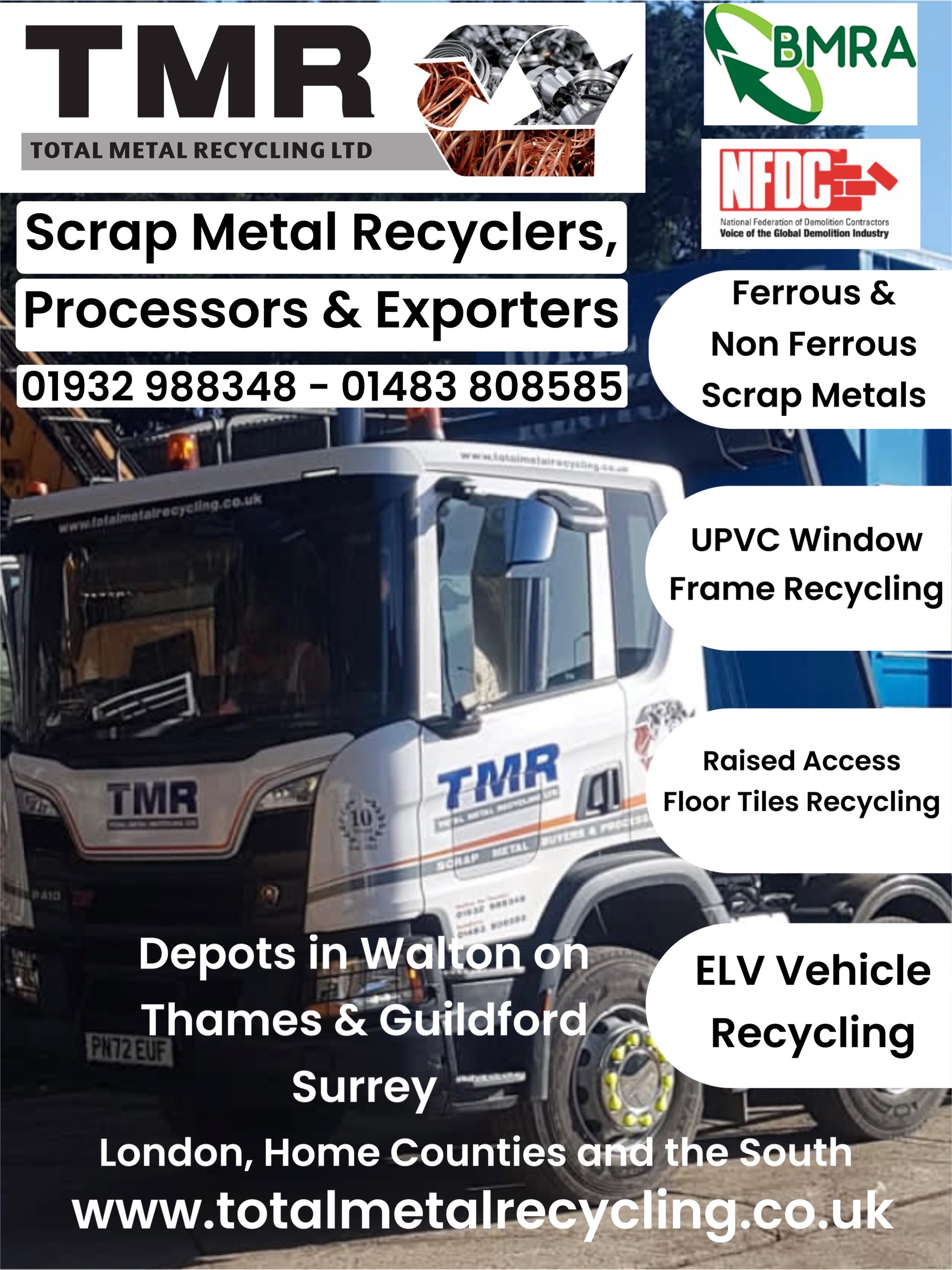
additional support and motivation required to enable someone to have a positive outcome.
These apprenticeships will help upskill and provide the experience young people need to develop and progress in this sector.
QHow do you engage with and support your workforce?
We value the hard work, commitment and strong work ethic our team provide and do our very best to ensure they feel appreciated.
In a recent staff survey, 98% of those who responded said they felt valued and appreciated at Total Controlled Demolition Services. Staff within the construction industry have a higher prevalence of poor mental health due to stress, anxiety and depression therefore we offer our team access to an Employee Assistance Programme (EAP) providing around the clock mental health support for themselves and their immediate family along with other wellbeing benefits such as financial support, fitness, sleep and healthy eating plans. Having a healthy, happy workforce creates spaces in which people want to come to work and want to achieve their best leading to a more productive team.
We provide opportunities for staff growth through training, workshops and coaching sessions. Our coaching sessions enable us to identify individual professional goals
and support their growth journey. We complete annual appraisals during which we offer feedback on an individual’s performance over the last year. We identify their professional goals and create an action plan on their development and how they will achieve their goals.
We provide a full training package to all our staff to ensure they are highly skilled enhancing their abilities to complete work to the highest standards.
QTell us about any engagement your company has in the community
We sponsor a local rugby team and every year sponsor a local charity, Destination Florida, that provides once in a lifetime trips to Disney World for children who are terminally ill or have life threatening conditions. This year our founder, Bill, donated £32,000 to the charity. We recently removed a redundant children’s play area for the Countess of Chester Hospital. The existing play area was unsafe and the hospital would like to replace it. We have offered to complete this project free of charge to support the hospital.
QWhat do you think responsible companies need to be doing in regard to their communities and society in general?
In the current climate all companies
need to have a focus on reducing their environmental impact and promoting sustainability. At Total Controlled Demolition we recycle 95% – 98% of all waste removed from projects we are working on.

We are moving to eradicating our paper use by moving everything to electronic files including iPads. We have also changed to biofuel to run our machines, assisting in reducing emissions and we are updating our plant equipment.
Companies should also be supporting their local communities in whatever way they can. At Total Controlled Demolition, apart from the support we currently offer to local charities we also offer members of our team the opportunity to volunteer for three days a year for their chosen charity. Last year some of our guys supported Apex Charitable Trust by volunteering to repaint their premises.
QWhat measures is Total taking in regard to the climate crisis and sustainability?
Over the past two years Total Controlled Demolition has been dedicated to updating all our plant and equipment to the latest versions on the market. We have updated all our transport vehicles and the use of biofuels and oils. We have limited the number of wagon moves by the use of wagon and drag, using large bulkers instead of skips. We have invested in electric plant for working
interview 30 | DemolitionHUB Magazine
indoors (BROKK), using carbon filters to reduce emissions. We have offered those staff able to the option of hybrid working to reduce the number of car journeys to and from the workplace.
QHow do you see the demolition industry developing over the next few years?
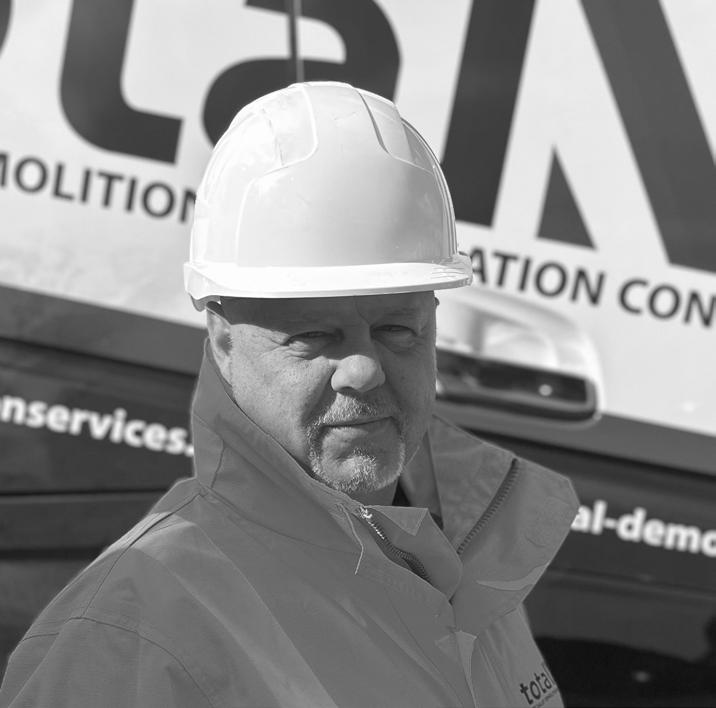
We can see the industry changing, some of which changes are welcome. At Total Controlled Demolition we welcome changes, especially those that benefit the demolition industry as a whole. The industry has become more safety conscious introducing modern, technological advancements such as BROKKs to reduce risk to workers. I feel this will continue to develop with more robotic, unmanned machinery and equipment being introduced that will continue to reduce risk and improve safety for demolition workers. At Total Controlled Demolition we already have two BROKKs and have trained some of our workers in how to use them correctly.
Post-Covid we have identified there is more pressure on our industry to complete projects within tighter deadlines, which increases stress on our teams. We always do our best to complete projects in realistic timeframes and in the safest possible method. Throughout projects we remain transparent communicating all aspects of how the project is progressing with the client. I feel this helps to build respectful and trusting relationships giving our clients confidence in us and securing us repeat work.
QWhat are the biggest technological developments you have seen in the industry and what do you envisage will be the future game changers? Some of the best developments have been the introduction of fully automated quick hitches and advances in demolition attachments.
We have laser guided zones around the machines to warn workers in the vicinity to prevent them from getting too close to the machines and improving safety.
Advanced equipment has started and will continue to be introduced to help with safely planning the methodology of projects. We currently use 3D and 4D imagery to help explain our methods of completing a project to our clients giving them clearer understanding. I think this will continue to improve with the possibility of VR headsets being introduced, giving clients a demonstration of how the project will be completed from start to finish.
I think hydro cutting tools will be introduced to improve safety and sustainability. More unmanned machinery that has the ability to be operated remotely will continue to be introduced, further reducing risk and improving safety within the demolition industry.
QDo you have any notable projects in progress or in planning?
Each project presents its own unique challenges, which we tackle in a proactive, confident manner. Currently we have a number of complex demolition schemes in progress including:
• Stretford Mall, Manchester
• Heaps Mill, Liverpool
• Bennett Street, Manchester
• The Christie TIF Wards
• Shire Hill Hospital, Glossop
QHow do you envisage Total in five to ten years?
Our plan is to continue to grow the company to be the biggest demolition provider in the northwest. We would like to expand our
offer to include more challenging projects including working with explosives, working on nuclear plants and the railway industry. We would like to double the size of our team, creating more job opportunities for local people and encourage more young people into the industry.
We would like to work more closely with schools and colleges offering site visits and attending career days to inspire and encourage more young people, especially women to work in this sector.
We would like to offer more training opportunities for people starting in the industry including apprenticeships.
And finally
Who is your favourite artist?
PINK – strong, confident woman who stays true to herself when producing her music. She also writes great songs. I’ve seen her live three times, she really entertains, is exceptional being able to sing and perform to a high level.
Who do you most admire?
Mum, as she taught me the values and morals by which I lead my life today including treat everyone with kindness as it costs nothing and can have the greatest impact. Keep striving to do better, you’re only as good as your team.
What do you do for fun?
Travel. I’ve visited many places and appreciate the time to disconnect from the busy schedules life sometimes offers. My favourite place I have visited was Greece as it has genuinely kind people, outstanding culture and a relaxed environment.
interview DemolitionHub.com DemolitionHUB Magazine | 31
Caterpillar in command
Caterpillar’s Cat® Command station for construction removes operators from potentially hazardous jobsite conditions by controlling the machine remotely from a customised virtual cab or “station”. Remote operation removes potential site safety risks such as machine roll-over or slippage, on-site hazardous environmental factors as well as falls and trips from climbing on and off machines.
The Cat Command station allows for non-line-of-sight remote control from the comfort of an airconditioned office on the job site or many miles away.
There is no limit to how many machines the Cat Command station can switch between, allowing customers to increase output of the overall fleet by balancing machine load across a single operator.

During his week, an operator in Los Angeles could be doing jobs in both London and Lagos, and operators in Birmingham and Berlin could take turns on a job in Belfast.
Machine controls and displays are similar to those in the machine’s operator cab and screens provide an easy view, both of the machine and the environment in which the machine is operating.
A Cat Command user controls all the machine functions like digging, lifting and tracking. Caterpillar machine technologies such as Cat Grade with 3D for excavators, Grade with Assist for boom and bucket, Swing Assist and E-Fence can be set, activated and used remotely.
The Command station offers an improved working environment and can reduce fatigue associated with machine vibration and noise.
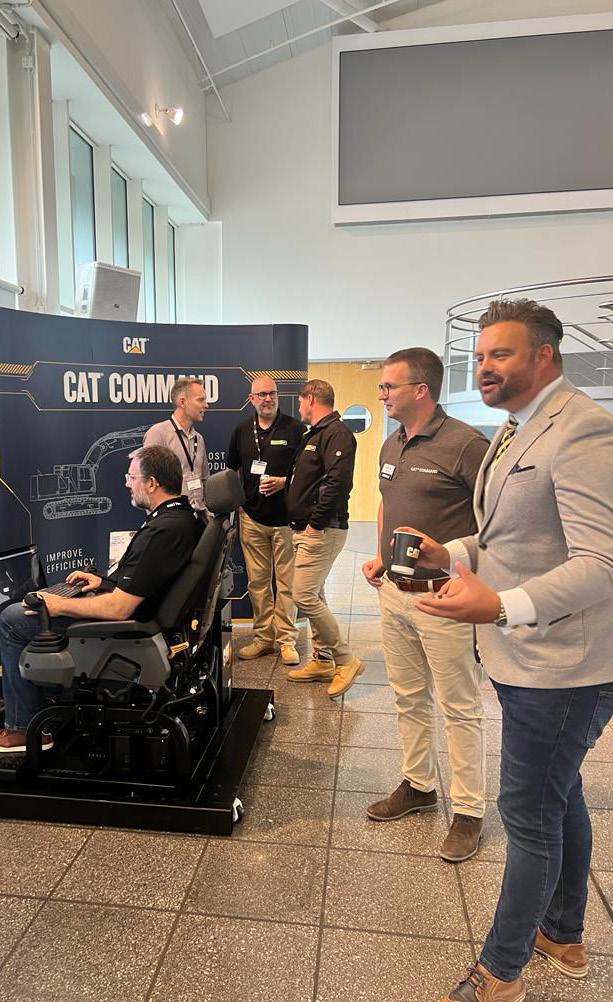
site visit 32 | DemolitionHUB Magazine DemolitionHub.com
Ben Chambers visited Caterpillar to see Cat® Command in action, speaking to sales representative, Christian Berling
Users can switch between machines within 10 seconds and one station can control up to five different machines, one at a time, at the same or at different locations, reducing downtime for shift changes or the need to travel to jobsites.
By removing the operator from the cab, Cat Command offers a solution to workforce shortages and it provides training advantages for newer operators. It also opens opportunities to those with physical limitations that prevent them from climbing into machines, and it can attract a new generation of workers while increasing the longevity of experienced operators.
Cat Command for Excavating is currently available from the Cat 315 model to the Cat 395. Cat Command for Dozing is available on the Cat D6, D6 XE and D7 models.
Mirroring the machine
The technology in the machine is mirrored on the station. The joysticks are universal. The machine displays and the settings from the cab are integrated on the station and users can adjust to their preferences. What has changed is that you are now working in a 2D environment instead of 3D.
Consultancy and support
The process always begins with the initial discussion with the customer. They may have seen the system at an exhibition or read about it. They have an idea where they want to use it. The Cat dealer seeks to understand the applications, the conditions, the operating zone and any combination involving manually operated machines. In addition, other important considerations such as safety, connectivity, operator skill, etc. are taken into account so the appropriate solution can be recommended.
Network Caterpillar has validated different wireless solutions to best support the individual requirements such as the applications, the site conditions, the speed of the machine and the operating range. All data transfer is secured and encrypted.
The Cat Command ecosystem
You could envision a site with multiple machines connected with Cat Command and operated from a station dedicated to that jobsite or

from multiple stations in different locations. Of course, customers want to use their equipment more efficiently. That is where the Cat Command ecosystem provides significant benefits.
Pulling in the punters
The system can attract both younger and older operators as well as disabled operators who might find it difficult to climb on the machine. Retired people who may want to work for a few hours a day but don’t want to go to the job site anymore could continue to operate from the comfort of an office.
Performance
The technology can improve productivity on projects with unstable or unpredictable conditions, such as demolition sites, allowing production to restart immediately following disruptive processes.
Cat Command was primarily designed for safety but after a few years of experience on construction machines and longer on mining machines, it is clear there are also efficiency benefits.

To measure productivity, VisionLink® Productivity is an easyto-use cloud-based platform that gathers and summarises machine telematics and jobsite data of an equipment fleet, as well as the efficiency of operations at a single jobsite.
More Cat Command-ready machines will be available in the near future.
DemolitionHUB Magazine | 33 DemolitionHub.com
site visit
ATTACHMENT FEATURE


ATTACHMENT FEATURE
34 | DemolitionHUB Magazine DemolitionHub.com
BPH Attachments – versatile selector grabs
BPH Attachments, the Excavator Attachment Specialists, exclusively imports PRODEM Attachments to the UK. It has long been a force to be reckoned with in the hydraulic attachments market. Since 2003, PRODEM Attachments has become synonymous with durability, reliability and cost effectiveness – the trilogy of key desirable characteristics in excavator attachments.
This is precisely why PRODEM is the go-to brand for construction, civil engineering, demolition contractors and those in waste and recycling wanting hydraulic attachments that deliver.

These make up one of the largest fleets in the UK, with an extensive range of high-quality attachments. From hydraulic hammers, multi processors and crusher buckets, to rotating pulverisers, compactor plates and selector grabs.
Featuring the best grab on the market, the PRODEM Heavy Duty Selector Grab is specifically designed for waste handling and selective demolition. It has reversible and bolt-on wear blades, 360° rotation and end damping cylinders to prevent hose wear as standard.

Called Heavy Duty for good reason, it boasts onepiece perforated shell skins manufactured from HARDOX steel making it stronger, lighter and much more durable. These grabs are available in a full range of sizes to suit excavators from 0.7 to 200 t, covering any job requirement.
PRODEM attachments are known for their quality, durability, and reliability as well as for being competitively priced, and their customers are in the plant hire, construction, civil engineering, demolition and recycling/waste
sectors.
BPH is a family-run business with nearly 50 years’ experience in the construction industry. It has the knowledge and experience to advise and support you. As a leading supplier of excavator attachments for sale, hire or repairs, it covers the whole of the UK and offers next day delivery for in-stock products. If you’re looking for a hydraulic excavator attachment, it’s likely BPH has it.
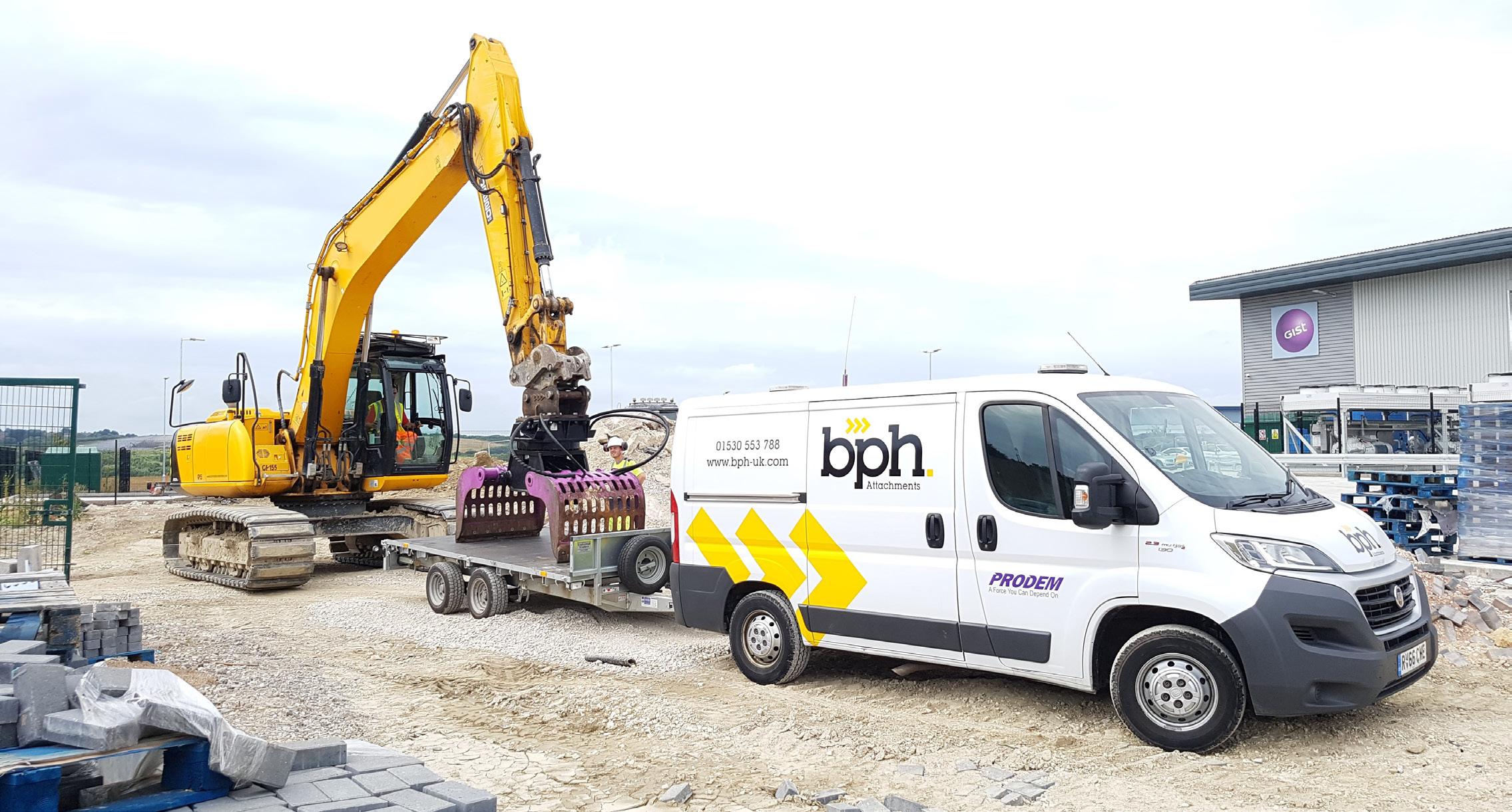
ATTACHMENT FEATURE
DemolitionHUB Magazine | 35 DemolitionHub.com
ATTACHMENT FEATURE
Armed with Epiroc hydraulic hammers, German demolition company makes fast work of motorway junction
Using 10 Volvo crawler excavators each fitted with an Epiroc hydraulic breaker, demolition company Mexner GmbH dismantled the Mainz South motorway interchange overnight in July. Critical to completing the demolition in the shortest possible time was the power of the Epiroc hydraulic attachments.
The volume of traffic using the interchange every day –approximately 180,000 vehicles –limited the contractor to overnight working and challenged it to
complete the demolition of the motorway as quickly as possible and without damaging other carriageways.

Thanks to the right equipment, the job was completed within a very short time.
Mexner had demolished the south bridge of the Mainz South interchange in 2017. As a result, they knew that the north bridge would also contain an extremely large amount of prestressed steel and therefore require a large number of machines.
After the demolition company had filled a drop bed to protect the roadways under the bridge, ten track excavators equipped with hydraulic hammers set to work on the Friday evening and successfully completed the demolition of the bridge within the tightly scheduled time window.

For the demolition of the north bridge, the demolition company relied exclusively on Epiroc hydraulic breakers. From the HB 3100 to the HB 5800, all hammer sizes were in use.
Managing Director Thomas Mexner said: “We have deconstructed many highway bridges in the past. When faced with such high concrete grades with strong reinforcement, the hydraulic breakers from Epiroc are ideally suited. For us, they are the most powerful breakers in the industry.”
36 | DemolitionHUB Magazine DemolitionHub.com
The power and reliability of Epiroc hydraulic breakers make them the ideal choice when faced with high concrete grades with strong reinforcement to be removed in such tight timescales.
Doosan Construction Equipment is now

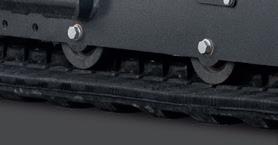

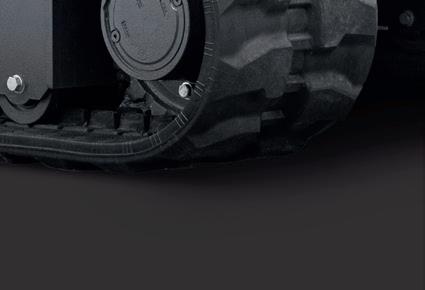
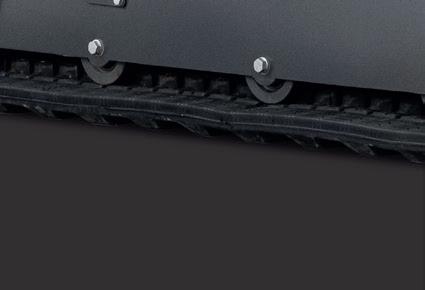
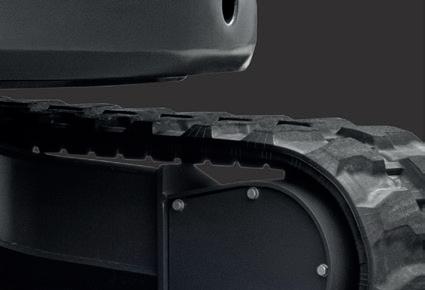

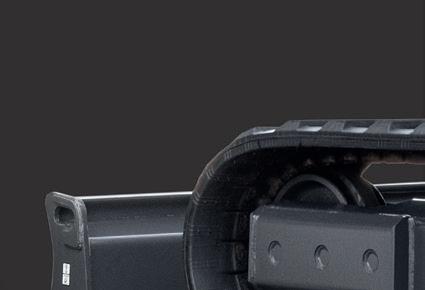
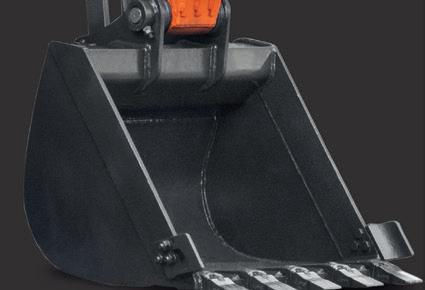


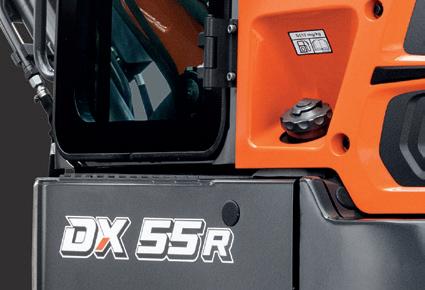



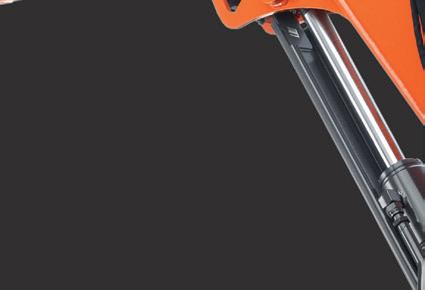

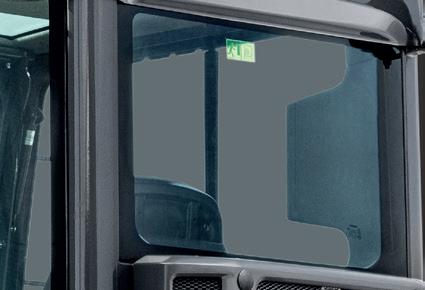
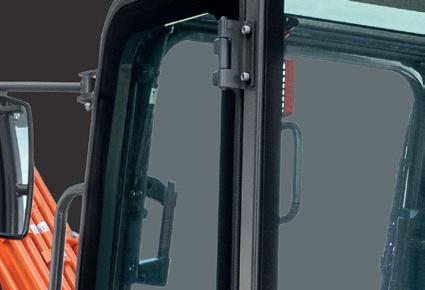

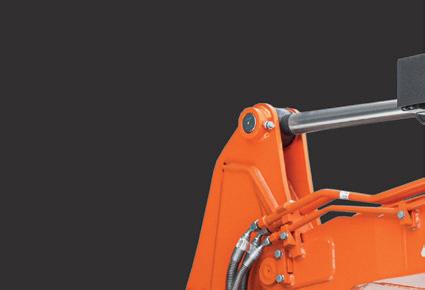
Same quality products maximum productivity outstanding value continuous innovation
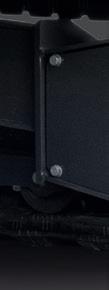







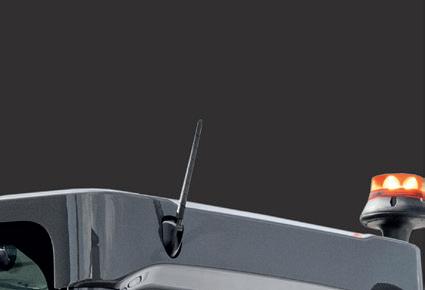

Find out more: eu.develon-ce.com
















Inmalo expands for the future
Inmalo is one of the UK’s leading demolition attachment and dust suppression specialists. The recent acquisition of the adjacent 20 m3 of warehousing has provided additional space for stock holding, parts and the in-house engineering team.


Inmalo is the main UK dealer for MBI Mantovanibenne and is celebrating a 23-year partnership. In maintaining competitive advantage, two major upgrades have been made to the Eagle Demolition Shears and Grapples to increase power and strength.

MBI has introduced the MSGR range of demolition and sorting grapples with improvements made across the range to offer market leading reliability. The MBI Grapple range is already well known for its power, precise handling and picking capabilities and the latest updates including new hydraulic systems continues to improve equipment and make them stronger than ever.
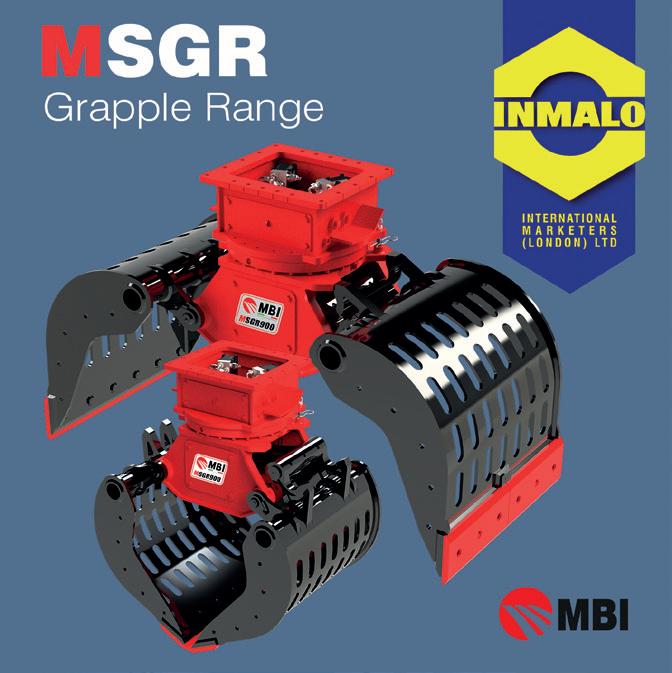
Improvements include new
stronger hydraulic components for a longer life and reduced downtime, relief valve on the rotation motors to reduce peak pressure on seals and an updated check valve on the distributor for improved safety and flow range.
Running alongside the existing and well proven Eagle II Shear range is the new Eagle III range of shears with new, larger cylinders offering 25-30% more power than existing shears, as well as redesigned cylinders that can work at 380 bar instead of the industry standard of 350 bar – these shears are designed to be industry leaders.
On the reliability aspect they have an improved piercing tip that is stronger and covers the end of the jaw to reduce time consuming rebuilding works. Replaceable armoured plates have also been fitted to the jaw, again to reduce downtime for rebuilding the shear.
To improve material quality the jaws are built from single sections of steel, which reduces welding and improves strength.
Other dealerships include Montabert hammers, GIDA hydraulic magnets and Steelwrist SQ fully automatic couplers. On the dust suppression side, the acclaimed Motofog range has both upgrades and new products to this highly manoeuvrable jet spray misting system and the largest range of dust cannon configurations are available from MB DustControl.
ATTACHMENT FEATURE
38 | DemolitionHUB Magazine DemolitionHub.com
A software platform developed specifically for Asbestos Abatement, Demolition & Subcontractors



FieldFlō is a comprehensive asbestos abatement, demolition and subcontractor platform helping companies run their business from a single interface. With our list of automated features you are able to track your projects and assets in real time.


www.FieldFlo.com


ATTACHMENT FEATURE
Steelwrist
Name: Karl Serneberg
Job title: VP OEM sales and marketing
Role: Overall responsible for developing oud relationships and sales with major excavator OEMs. Overall responsible for the marketing function within Steelwrist.
Time spent at your company: Close to one year at Steelwrist but extensive experience working within the construction equipment industry.
Previous experience: Close to 20 years at Volvo Construction Equipment. Two last roles as Marketing Director for Volvo Construction Equipment EMEA Sales Region and before that as Director for Volvo Construction Equipment’s Global Attachment business. I have also worked for the forklift manufacturer Linde Material Handling as the Country Manager for the Swedish sales and service organisation.
Steelwrist is a global manufacturer of tiltrotators, quick couplers and work tools for excavators with headquarters in Sweden. Since the foundation in 2005, Steelwrist has been one of the fastest growing industrial companies in the industry.
Steelwrist’s goal is to be the “best in the world to develop, manufacture and sell equipment that increases efficiency of excavators” with a determined focus on robust and modern products, combined with fast service are appreciated by an increasing number of customers worldwide.
A job needs a work tool, and a work tool needs an excavator – not the other way around. That’s the starting point when we think about how to increase your excavator efficiency.

In recent years we have seen that the requirement to be able to change hydraulic powered work tools without leaving the cab is increasing. This is why the demand for fully automatic quick couplers is increasing fast.
In the demanding world of demolition, where precision and efficiency are paramount, innovation plays a crucial role in reshaping the industry. One standout innovation that’s making waves in the demolition sector is the Steelwrist SQ – fully automatic quick coupler solution. With every new demolition job comes new challenges, whether it may be location, space, structure, transport, time, resources or other. With Steelwrist SQ technology, your excavator turns into a true tool carrier and provide you with the flexibility and versatility to face these challenges, day in and day out.

40 | DemolitionHUB Magazine DemolitionHub.com
Steelwrist SQ technology allows you change between hydraulic powered work tools as well as mechanical work tools in only seconds – all without leaving the cab. Steelwrist SQ was first introduced in 2017 with the introduction of our patented Qplus™ technology, which radically changes the “inside” of the hydraulic couplings. With the introduction of SQ50, the Qplus technology has been updated to allow for even higher flows, adding another 20% to flow capacity, which allows users to run also the high flow requiring work tools on midsized excavators.
Growing quick coupler standard
All Steelwrist quick couplers are based on the S-Type (symmetrical) standard, which is by far the fastest growing standard with increasing penetration across the world. There are many reasons for this, but the compact design, light weight and robustness of the S-type couplers are some. Add the fact that it is based on an open standard.
With the Open-S alliance we strive to give machine operators and contractors around the world the freedom to combine quick couplers, tiltrotators and work tools from different manufacturers that are following the standard. With a common standard it is easier for industry manufacturers to continue competing with performance and functionality and still offer customers compatibility. The standard also means that dealers can provide clearer information about which products fit together.
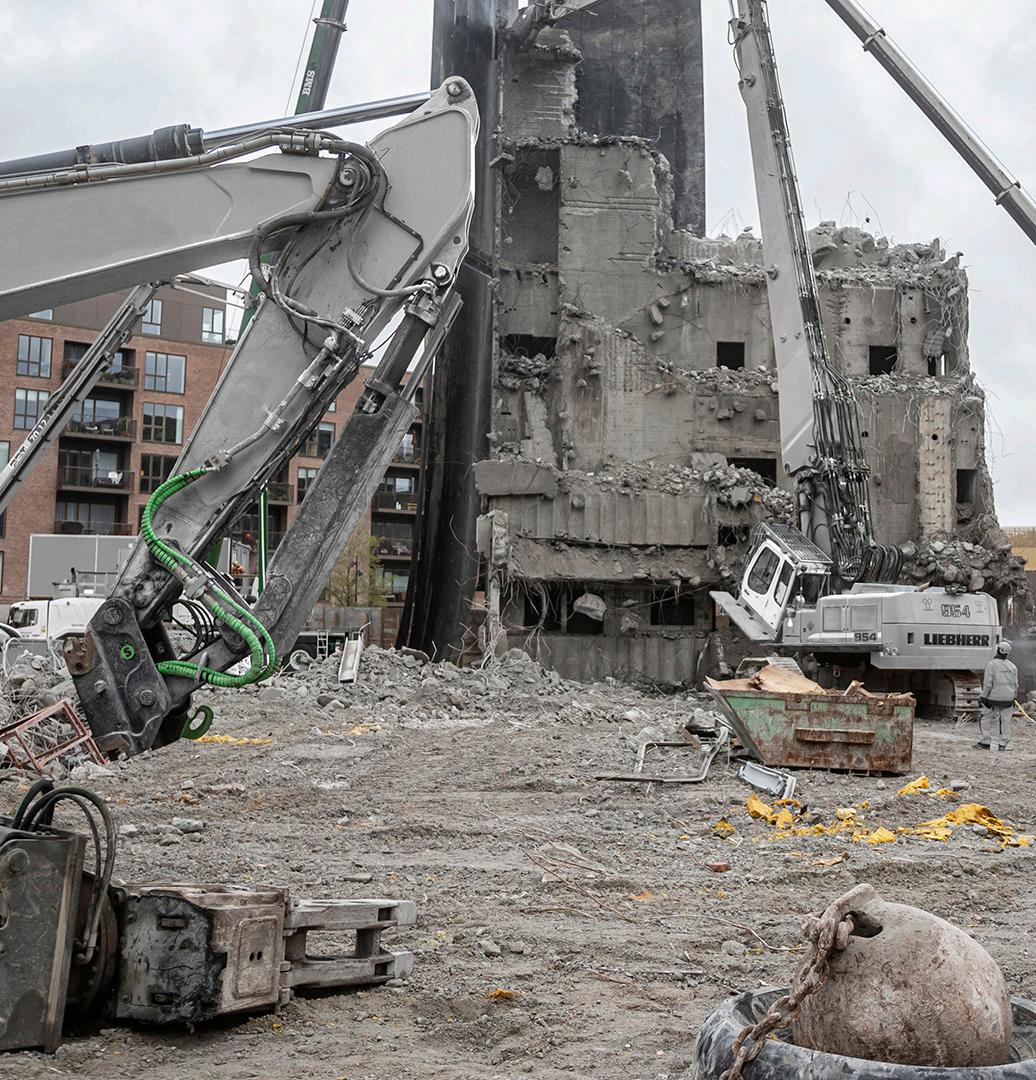

Steelwrist SQ system is designed to be able to connect with other brands using the same type of oil connection systems, the Open-S standard.

ATTACHMENT FEATURE
DemolitionHUB Magazine | 41 DemolitionHub.com
ATTACHMENT FEATURE
Lekatech Electric Hammer revolutionises impact hammer technology with linear electric motor
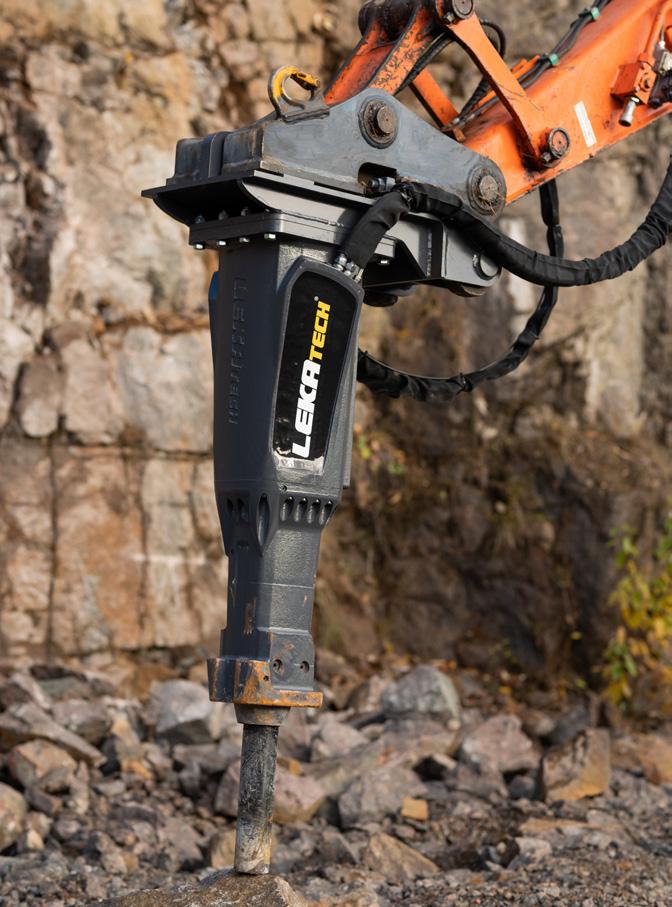
Lekatech Oy, a Finnish technology company, is introducing a groundbreaking electric hammer based on its patented linear electric motor technology, reshaping the market for impact hammers. The electric impact hammer technology is unparalleled worldwide.
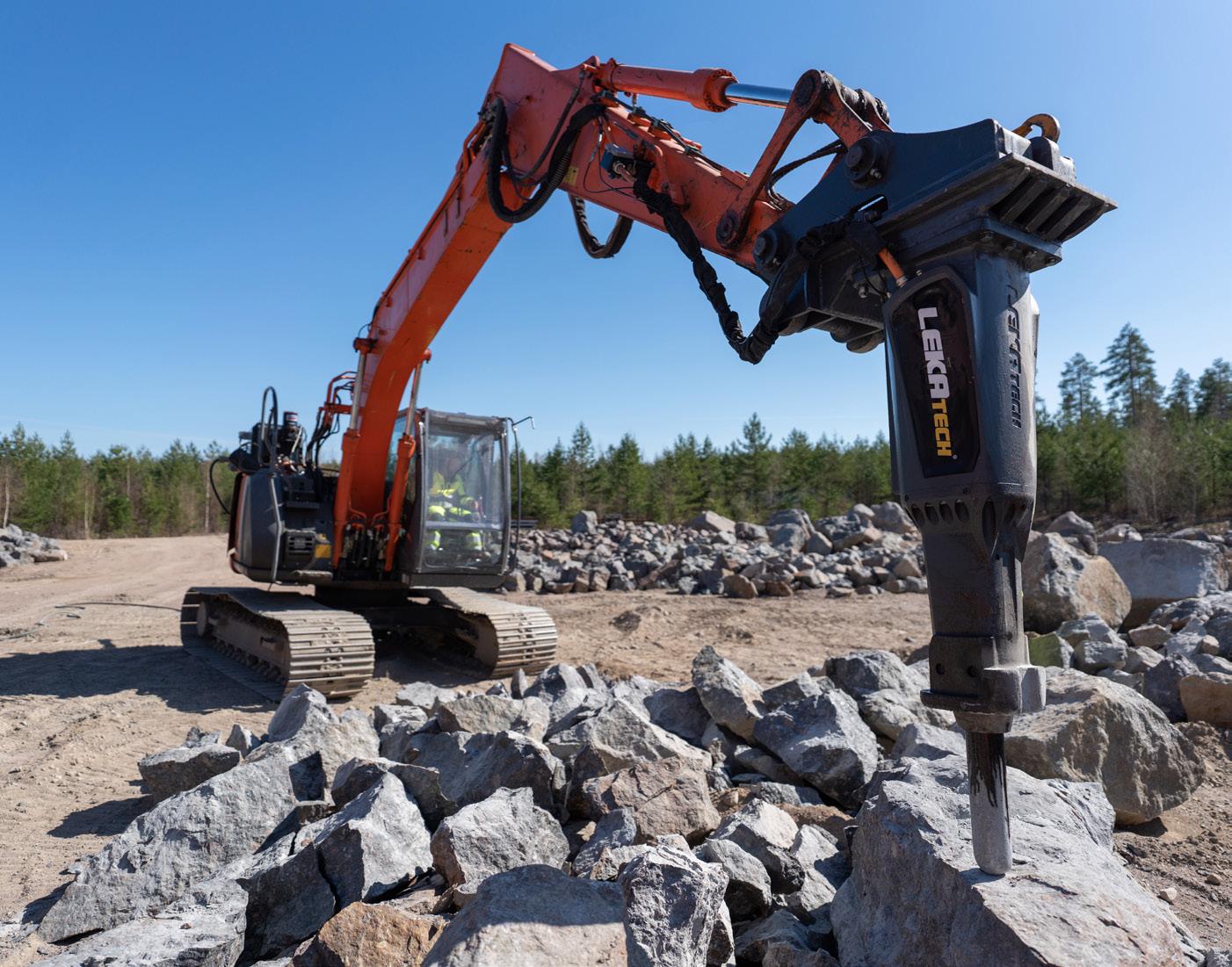
Lekatech Electric Hammer is powered by novel and patented linear electric motor technology, developed through years of dedicated research and innovation. Antti Anttila, CEO of Lekatech said: “Our technological breakthrough not only enables more energyefficient earthmoving and mining operations, but also strengthens the realisation of a green transition in these fields. We are proud of the strides we have taken over the past five years in developing linear motor technology.”
Lekatech’s electric hammer disrupts the traditional hydraulic impact hammer market, catering to both urban and mining environments, especially with the integration of electric carrier machines. The electric hammer increases energy efficiency by 70% compared to its hydraulic counterparts. In addition to energy efficiency, the Lekatech Electric Hammer significantly outperforms comparable traditional technology, providing twice the blow impact energy of a hydraulic hammer of the same size.
Environmental friendliness and performance go hand in hand with the Lekatech Electric Hammer. Its
programmable features provide flexibility and enable continuous digital development.
The Lekatech Electric Hammer enables the use of electric carrier machines in a new magnitude, and allows for seamless integration with electrically powered machinery, resulting in up to 70% energy savings when factoring in overall energy consumption of the equipment. Furthermore, this innovative hammer eliminates the need for oil and the oilassociated environmental impact of hammering. Oil consumption is reduced by 98% compared to hydraulic hammers.
Key features of Lekatech Electric Hammer:
• 70% more energy efficient than hydraulic hammers,
• Twice the blow impact energy compared to traditional hydraulic hammers,
• 98% reduction in oil consumption compared to hydraulic hammers.

42 | DemolitionHUB Magazine DemolitionHub.com

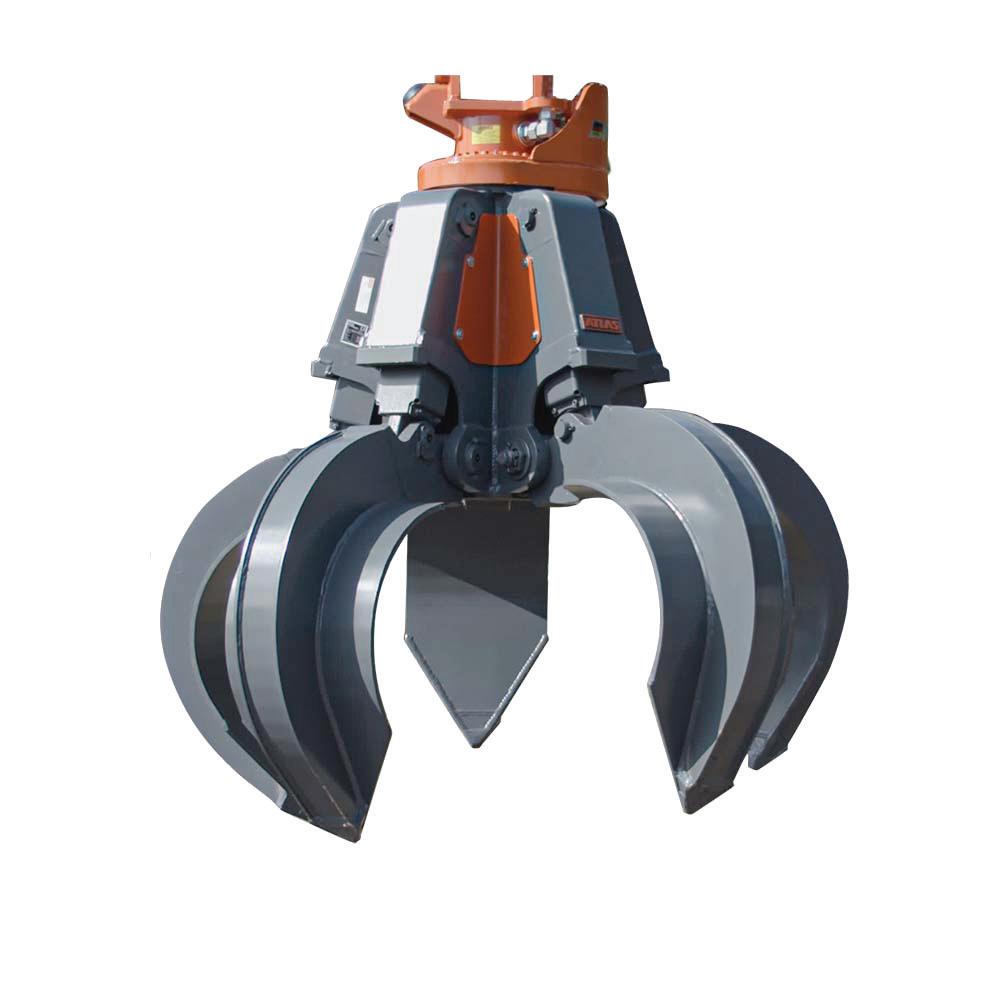

ATTACHMENT FEATURE
Rotar RCC45 Concrete Cutter with Ramplifier
2.0 and fully integrated
OilQuick OQ 90
Rotar is pleased to announce its latest innovation – the Rotar RCC45 Concrete Cutter with built in RAMPLIFIER 2.0 with a fully integrated OilQuick OQ90.
The RCC45 Concrete Cutter is ideal for your primary demolition needs when you need to cut concrete. Built for heavy industrial demolition, it will be used by larger demolition companies for jobs involving thick concrete with reinforcements inside such as bridges, parking garages etc. The RCC has a huge opening with massive force. It is ideal for when a client just wants to cut concrete down before it is moved onto other stages of demolition, for example, to be pulverised or taken away to be crushed elsewhere.
The RCC comes with RAMPLIFIER 2.0. Using new market leading technology this gives double the power and sits at the top of the market.
RAMPLIFIER 2.0 is installed on the RCC offering a higher force of cutting power – in a split second
it doubles the input pressure to a maximum of 700 bar.
Rotar’s Engineering team has launched a Fully Integrated Quickcoupler Adapter OQ90 with the RCC45. OQ90 is suitable for 40 to 70-t excavators. This innovation is OEM manufactured using the original components in close collaboration between the engineers of both parties – in this case, OilQuick Germany.
Key features:
• Tremendous power, speed and with lower noise level than traditional techniques in the world of demolition,

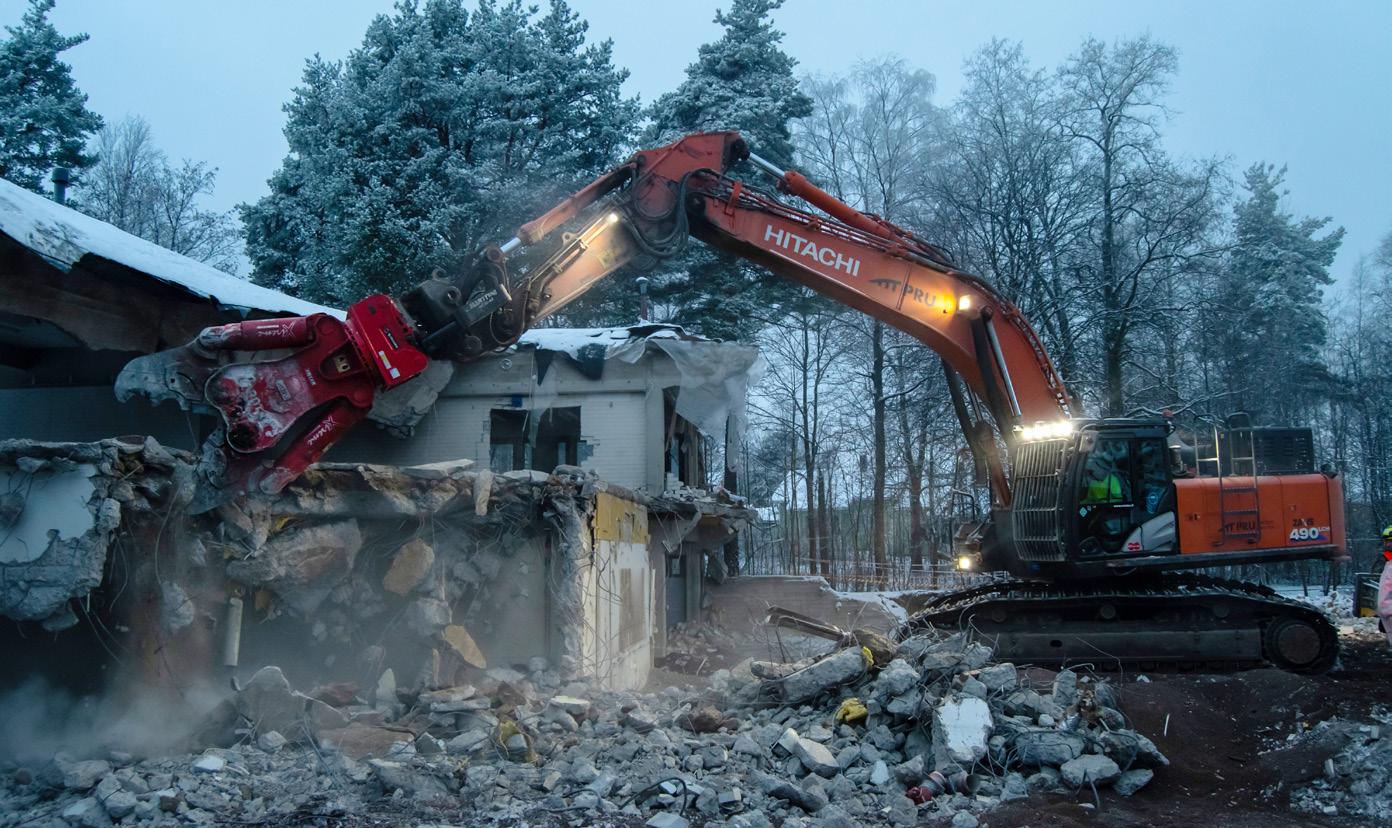

• Balanced and dedicated design, developed with the knowledge and experience of experts in the demolition and
recycling industries,
• High system efficiency with a minimised waste of energy which saves fuel and results in lower operational costs,
• Fully Integrated Quick Coupler. The best and most compact solution on the market –
ready to become the future standard,
• RAMPLIFIER 2.0 – Evolved booster technology developed by the best engineers in the hydraulic industry to achieve outstanding performance.
44 | DemolitionHUB Magazine DemolitionHub.com
Labour Solutions
The Labour Desk provides the demolition industry with labour solutions, from a labourer for a day to a whole project team, we can get it covered.

For the past 6 years The Labour Desk have been supplying demolition clients with:


• CSCS Labourers


• CCDO Labourers
• CAT B asbestos operatives
• Machine Operatives
• CCDO Gold carded Supervisors
• CCDO Black carded Managers
We have an extensive network of qualified operatives nationwide please call if you have any requirements big or small we will be happy to assist.

us on:
us
Follow
Call
on: 02071646095 Email us: info@thelabourdesk.com Visit our website: www.thelabourdesk.com
Indeco: the Italian hi-tech quality applied to demolition
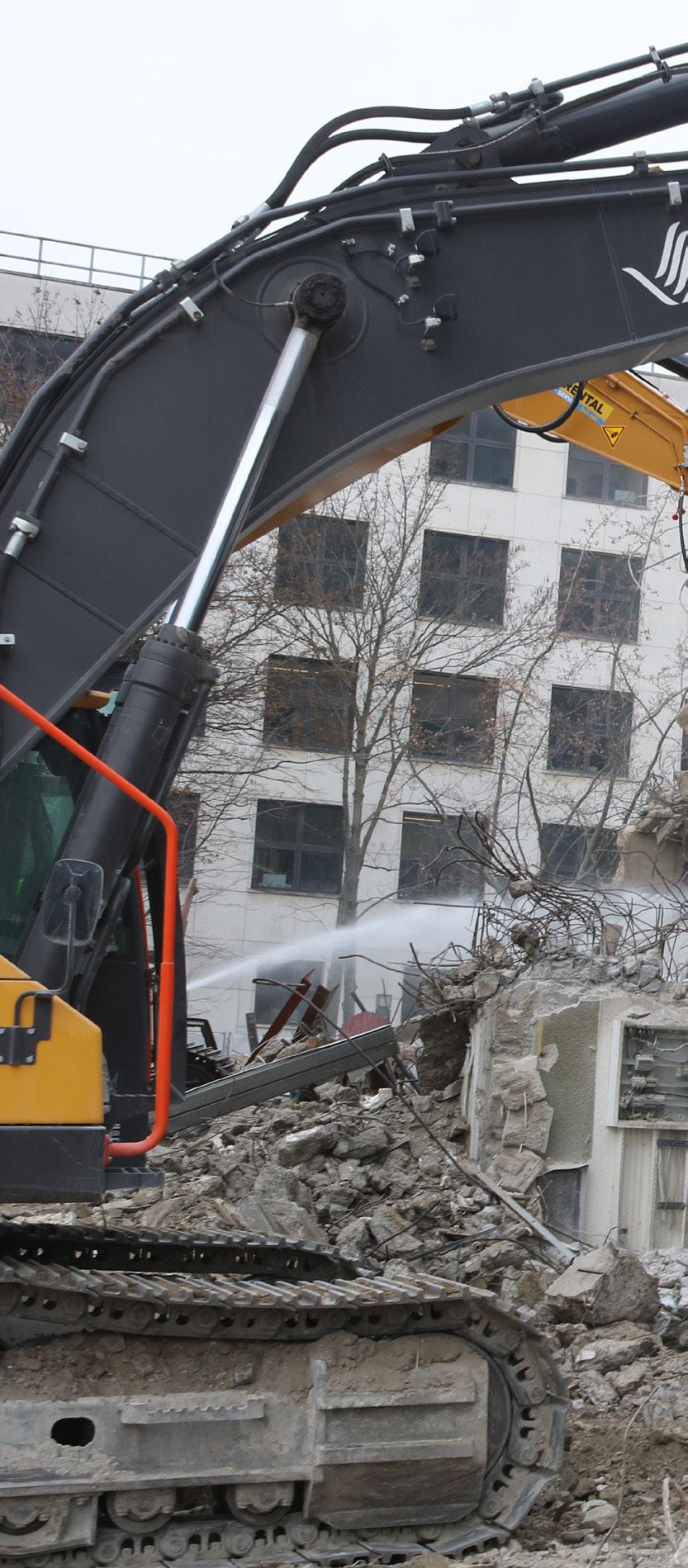

Indeco attachments are an outstanding expression of Italian high-tech and construction quality applied to demolition. In-depth research into hydraulic systems, materials, heat treatment and accessories have enabled Indeco to establish a reputation on markets throughout the world for product excellence.
HP hydraulic hammers
With its many different models, divided into large, medium and small and available in various versions, Indeco has the widest range of hammers available anywhere in the world. This provides end-users with a huge choice, ensuring that they can find the ideal hammer/excavator match.
Small hammers
Despite their compact size, Indeco’s range of small hammers are exceptionally reliable, quiet and efficient, and best suited for such jobs as excavations work, highway maintenance, demolitions and recycling in city areas and building refurbishment. Their versatility makes them extremely efficient in specialist jobs such as maintenance in iron foundries.
Medium hammers
Their excellent weight/power ratio and their slimline structure make the mid-range Indeco hammers the ideal choice for classical applications, such as demolishing buildings, earthworks in inhabited areas and secondary demolitions in quarries, as well as for more specific tasks. In fact, mid-range hammers are used for underwater work (using a special kit) as well as
for digging narrow deep trenches and removing casting slag from blast furnaces.
Large hammers
Combining maximum power with the effectiveness of intelligent technology, Indeco’s larger hammers are unbeatable when it comes to completing the toughest jobs in the shortest possible timeframe – whether it’s the biggest demolition jobs, primary breaking in quarries, digging foundations, or excavating huge rail and road tunnels.
All Indeco HP hydraulic hammers have a special intelligent hydraulic system, enabling them to automatically vary the energy and frequency of the blows according to the hardness of the material being demolished. This optimises the hydraulic pressure delivered by the machine, thus improving productivity and enhancing the overall performance. With a now even more efficient hydraulic system, the HP series has now also become FS (Fuel Saving). Compared to other manufacturers’ models of equivalent weight and performance, Indeco hammers require less oil per minute and lower operating pressure. And as using lower hydraulic power means reducing the number of revolutions per minute on the carrier, they lead to fuel savings of up to 20%, while ensuring optimum performance and maximum productivity.
IFP and IRP Pulverisers
Exploiting the best in Indeco’s advanced technological knowhow, the Indeco IFP fixed and IRP rotating pulverisers were designed
and created following the top quality guidelines already used in manufacturing our famous hydraulic breakers. By using the latest technologically advanced materials, such as special extrastrength HARDOX® alloy steel, Indeco pulverisers are specifically designed to withstand high levels
ATTACHMENT
FEATURE
46 | DemolitionHUB Magazine DemolitionHub.com
of pressure, wear and abrasion, and prolonged use regardless of jobsite conditions. IRP rotating pulverisers are perfect not only for the primary demolition of buildings, vertical structures, flooring, slabs and external walls. The IFP fixed versions are perfect for the secondary demolition of reinforced


concrete materials and structures and for recycling after separating the concrete from the steel rods.
IMP Multiprocessor
Designed to ensure maximum versatility, the Indeco IMP multiprocessor is the perfect solution for specialist or non-
ATTACHMENT FEATURE
specialist firms who need a tool that can handle a variety of different jobsite situations in the demolition and recycling field. Different jawsets enable it to be used in the various crusher, pulveriser, shear and Combi Cutter configurations on the same carrier. Made with the latest technologically advanced materials, such as special extrastrength HARDOX® alloy steel, which eliminates any flexing of the body, the Indeco IMP multiprocessor is designed to withstand high levels of pressure, wear and abrasion, and prolonged use regardless of jobsite conditions.
ISS Steel Shears
Indeco ISS Steel Shears stand out for their cutting-edge design, for their extreme robustness and for their technical innovations which substantially increase their efficiency. Rapid, efficient and surprisingly powerful, Indeco ISS shears are the ideal choice for demolishing any type of metal structure. Indeco’s tried and tested continuous rotation hydraulic system, found on all of our other rotating products, enables the shear to work in the best possible position, while its large jaw opening and fast cycle times and its incredible cutting power, make all demolition operations fast and effective. Special extra-strength HARDOX® alloy steel make ISS shears outstandingly resistant and reliable. Each of the main knives and guide-blades was designed with four cutting surfaces and so can be rotated three times before replacement; promising more consistency, uptime, and production in your operation.
DemolitionHUB Magazine | 47 DemolitionHub.com


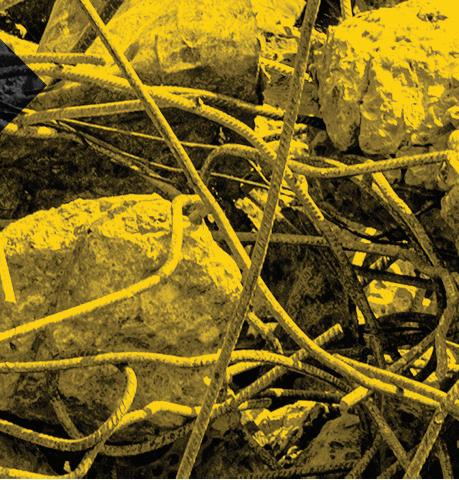






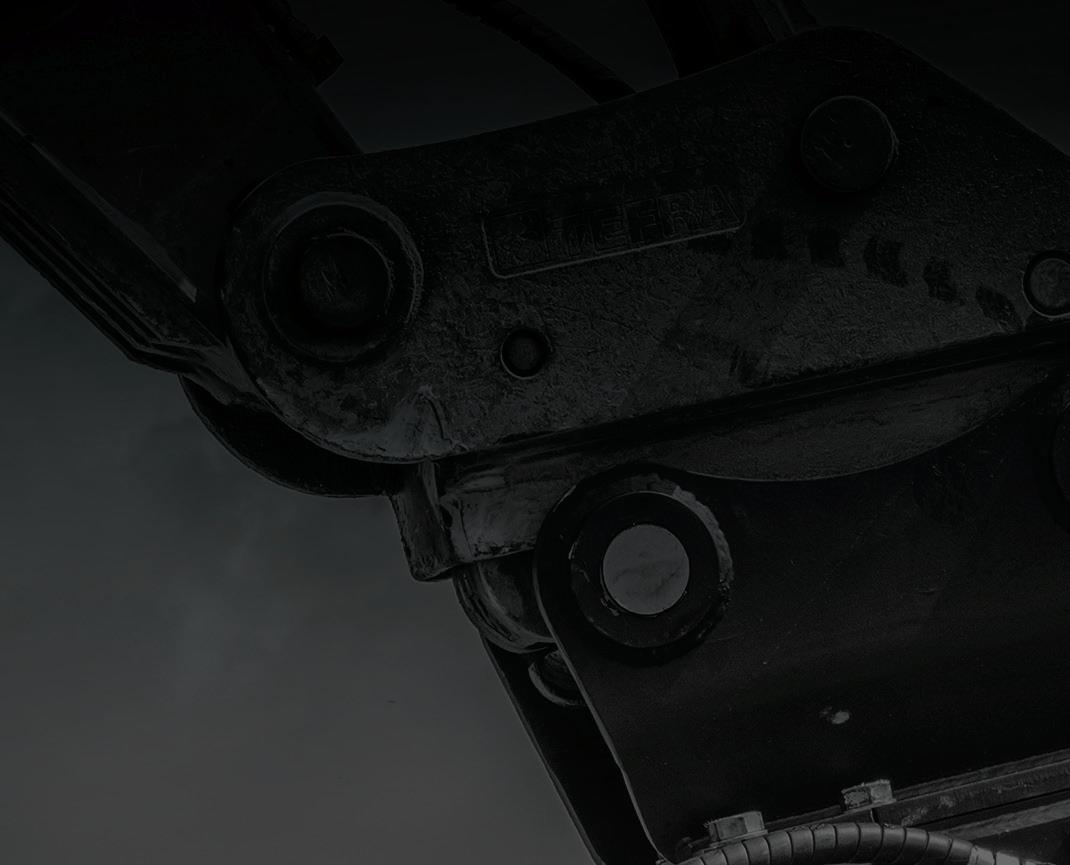




BPH is a nationwide supplier and attachments specialist Founded in 1972, we have extensive demolition and recycling experience, and offer knowledgeable help and advice to ensure your project is at maximum productivity and profitability. Hire Sales Parts Repairs sales@bph-uk.com bphattachments.com Head Office/South-East 0845 017 6972 Midlands 01530 553788 London 0203 988 2255 South-West 01761 239213 For all your excavator attachments Call 0845 017 6972
Case study
Title: Abercrombie House and former Harold Hill Library, Romford
Structure: Brick-built library 1959, gym and former hostel refurbished in 2013
Contractor: M&M Demolition Co Limited



Client: London Borough of Havering
Start date: May 2023
Completion date: August 2023
Techniques: Service disconnections, soft strip, asbestos removal, mechanical demolition



Future use: Site being redeveloped for Family Welcome Centre

DemolitionHUB Magazine | 49 DemolitionHub.com
Abercrombie House and former Harold Hill Library
The London Borough of Havering appointed M&M Demolition as principal contractor to complete the demolition and enabling works to make way for the construction of the new Family Welcome Centre in this busy residential and commercial area of Romford.
The works consisted of the full demolition of Abercrombie House, a former hostel for the homeless, the Harold Hill Library and a former boxing gym.
Our scope of works included the disconnection of all incoming services, erection of a full height timber hoarding to the perimeter, internal asbestos removal, internal soft strip and demolition of the structures incorporating the removal of all slabs and foundations.
All suitable materials were removed from site and recycled
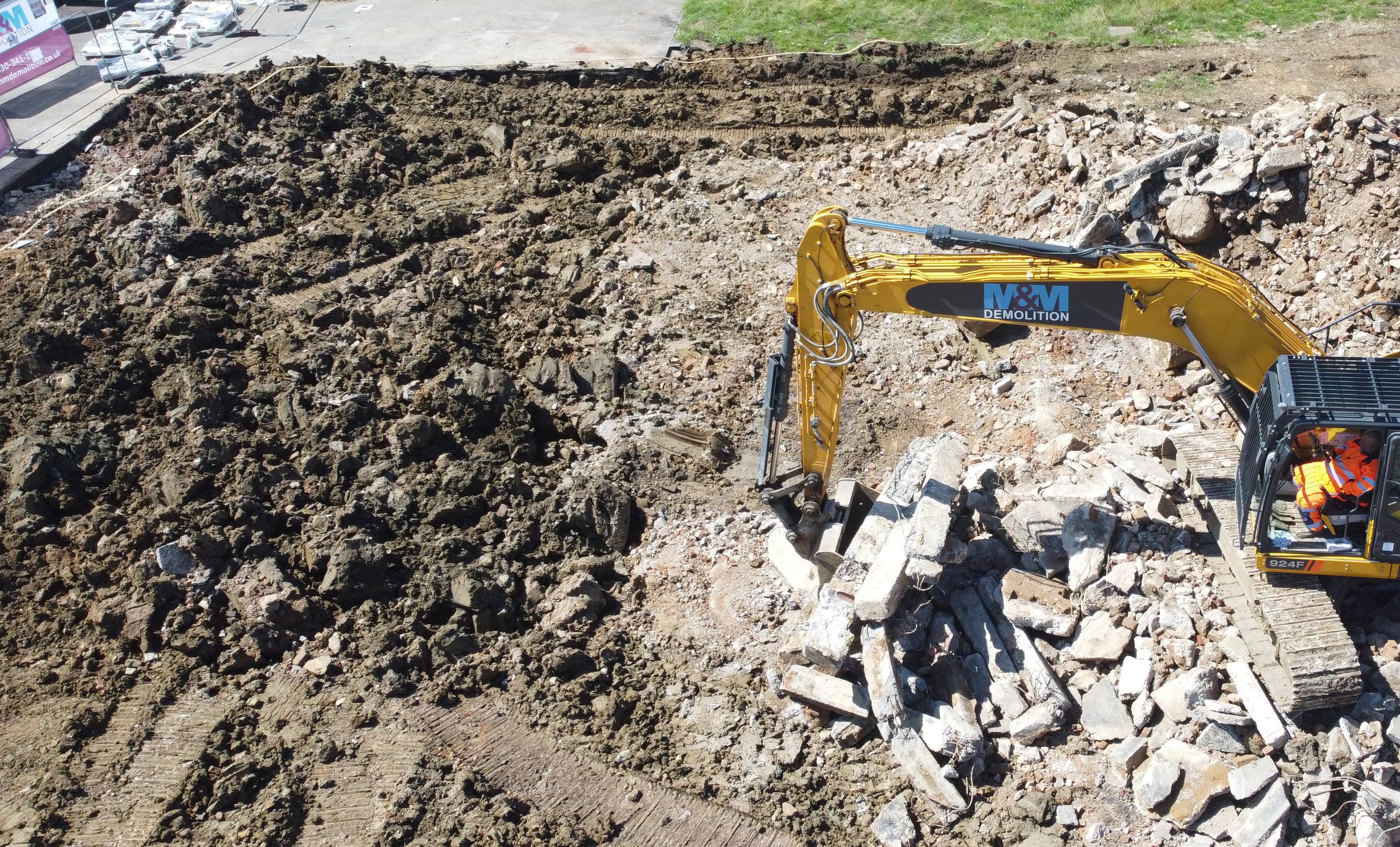

at the local recycling facilities and the site was registered with the Considerate Constructors Scheme. The site was located within a busy residential and commercial area and it was essential to establish a good relationship with the local community. Before works began, we distributed an information leaflet outlining the approach and the measures we would employ to reduce any disruption to the local environment. This included a robust traffic management plan and noise abatement strategy. Throughout the works we undertook 24/7 noise, dust and vibration monitoring to ensure that all works were undertaken within the agreed trigger limits. There had been some resentment from the local community when the local authority announced their plans to demolish
the hostel and associated buildings, therefore our site team needed to be sympathetic in our approach. Throughout the demolition process, our neighbourhood liaison officer was on hand to reassure the local community and answer any queries during the delivery of the project. The local community often complimented our site team in the way they managed and delivered the project to completion.
Several schools and a busy shopping parade were situated close to the site, generating a busy footfall around the site’s exterior. Viewing panels were installed in the hoarding to allow residents and schoolchildren to see how we undertook the demolition works.
Our Social Value Manager contacted several local schools to participate in our interactive game,
50 | DemolitionHUB Magazine DemolitionHub.com
case study
The Demolition Challenge, devised to educate young people on the role of recycling and reuse in the demolition industry.

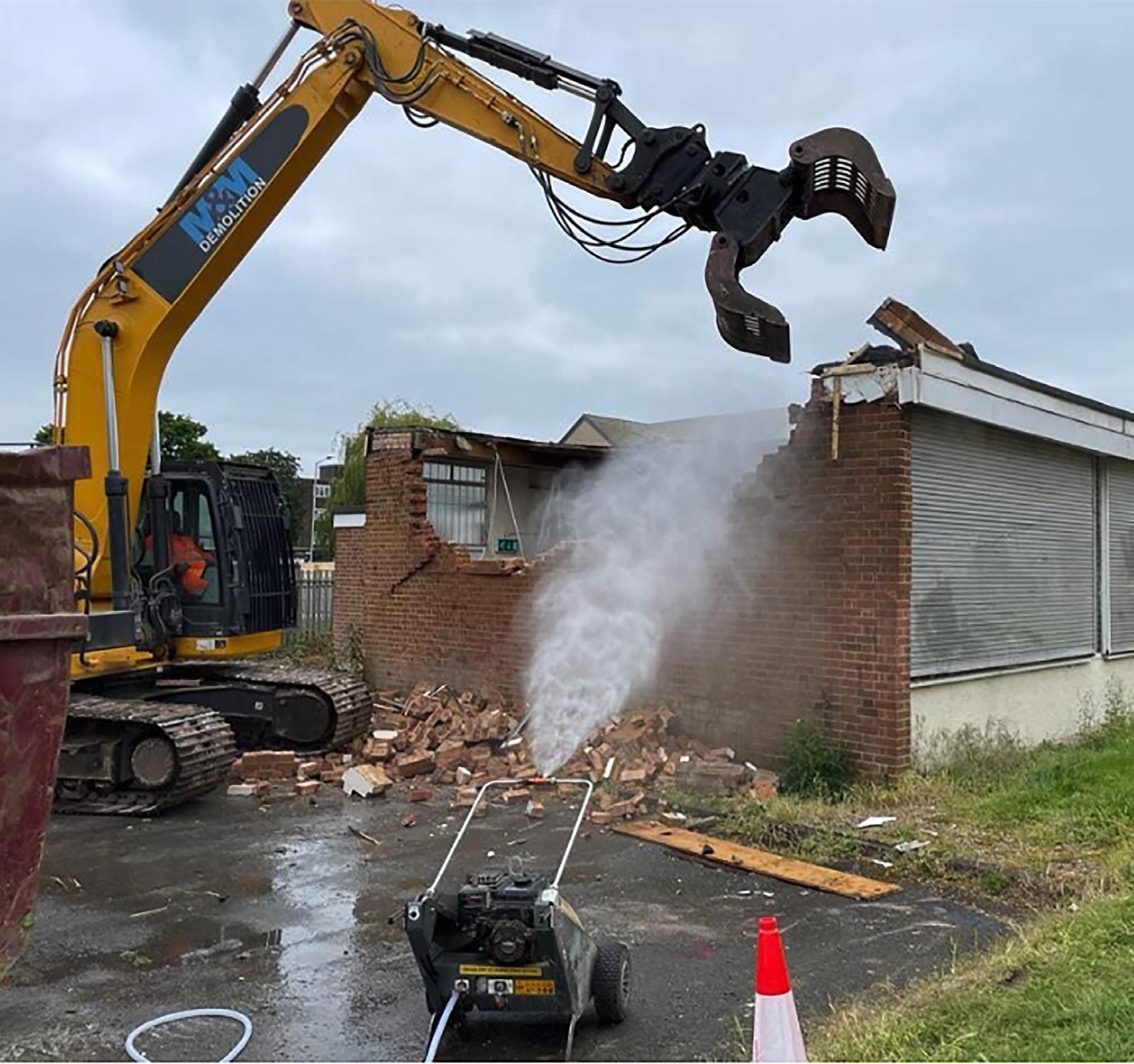

M&M donated food to the Harold Hill Foodbank and we offered to work in the centre as volunteers.

In 2003 a mural created by urban street artists Mark Wydler, Karen Wydler and Carrie Reichardt was installed to the front of the library building. This was aptly called The Art of Recycling and was created using enamelled tiles bonded to slate panels.
It was vitally important to the council and local community that the mural was preserved, and M&M demolition devised a methodology
case study

DemolitionHUB Magazine | 51 DemolitionHub.com
case study

to dismantle the mural into reusable sections. These were diligently catalogued and palletised then transported to an agreed designated storage facility. The mural will be incorporated into some of the new structure during the redevelopment works.
As the demolition works progressed, we were delighted to welcome local councillors and members of Havering London Borough Council’s project team to inspect the works. They were very complimentary to our management team and impressed with our approach to the safe delivery of the works.

The works
The works were managed by our experienced contracts manager, Tim Meaney, supported by our experienced demolition team and where required, local labour recruited through our prequalified supply chain partners.
Our management team liaised with the utilities companies to arrange the disconnections required before any demolition works could commence. Hoarding was erected to allow the asbestos removal, strip out and demolition works to commence.
There were three buildings on the site and the strip out and asbestos
works started in the former boxing gym, progressing to the library and then finally Abercrombie House.
During the demolition works to the library slab, asbestos was discovered within ducts beneath, which meant a delay in the programme for testing and subsequent removal. M&M Demolition resequenced the ongoing works to allow the safe removal of the additional asbestos discovered while works commenced elsewhere on the site. This ensured that we were able to complete the project within the original contract programme.
The front wall of the library was kept in situ to enable us to carry out preservation works to the mural.
Matthew Saunders (far left), local Havering Councillors and members of the Havering Project Team
52 | DemolitionHUB Magazine DemolitionHub.com
case study

Throughout the project the clerk of works for Havering paid weekly site visits to undertake safety audits and this was bolstered by our own health and safety department auditing the site. The site audits were all exemplary and demonstrated our commitment to health and safety and the environment.
Considerate Constructors Audit
We received an excellent performance level for our Considerate Constructors Audit, which further demonstrates our site management team commitment and professional approach.


If you have a case study you would like to submit for publication in Demolition Hub, please email: toby@chambers.media.
 Dismantling the mural, The Art of Recycling, for reuse elsewhere
The Art of Recycling mural installed on the library in 2003 by street artists Mark Wydler, Karen Wydler and Carrie Reichardt
Dismantling the mural, The Art of Recycling, for reuse elsewhere
The Art of Recycling mural installed on the library in 2003 by street artists Mark Wydler, Karen Wydler and Carrie Reichardt
DemolitionHUB Magazine | 53 DemolitionHub.com
SUPPLIER TALK
QGive us some background on Komatsu
Komatsu Ltd was formed in 1921 to provide repairs to mining equipment. In 1931, the first crawler tractor was manufactured and listing on the Tokyo Stock Exchange followed in 1934. Komatsu Europe was established in 1967 to ensure that the company could be close to European customers and develop product to suit their needs. This remains a core philosophy to this day – there is a Komatsu manufacturing presence in all the main global markets and more than 80% of the products we sell in Europe are made in Europe.
The Komatsu UK factory opened in 1987 and now supplies hydraulic excavators from 17 t to 70 t to the European market as well as Africa.
Interviewee: Simon Saunders
Role: Product Marketing Manager
Company: Komatsu
Komatsu has a long involvement with the demolition industry, introducing demolition products to the European market in the mid1990s. The design team at Komatsu UK now has full autonomy to design demolition machines specifically to suit European customers. Safety is our top priority of course, and we are committed to creating the best combination of reach, capacity, durability and ease of transport.
QHow did you start out in the heavy plant industry, and how has your career developed to where you are now at Komatsu?

interview
DemolitionHub.com 54 | DemolitionHUB Magazine
Before working with Komatsu, I was involved with large engineered centrifugal pumps in the oil and gas industry. I’ve always been interested in understanding how engineered equipment works and when I saw the sophistication of the Komatsu products I couldn’t wait to get involved. After working for Komatsu for more than 20 years, I think I’m most impressed by the determination of the company to do the right thing.
Most of my career has been involved with Komatsu UK’s demolition machines and I still find the demolition industry fascinating. I am particularly proud to have contributed to Komatsu’s technical innovations, which are driven by the ever increasing environmental pressures and the need to work effectively on some very challenging work sites.
QTell us about the range of products Komatsu provides to the demolition sector and how your relationship with clients works
We provide a range of factoryoriginal equipment for the demolition market. The range includes the high reach machines PC490HRD-11 and PC390HRD-11, with a range of demolition excavators from 21 t to 50 t. The high reach machines have exceptional versatility built in and are each able to work in six different configurations with a wide range of attachment sizes. The demolition excavator products superficially look like conventional excavators, but pack lots of protective guards and safety systems as standard, along with other features like the roof window wash/wipe system and integrated attachment control. They’re available with a variety of
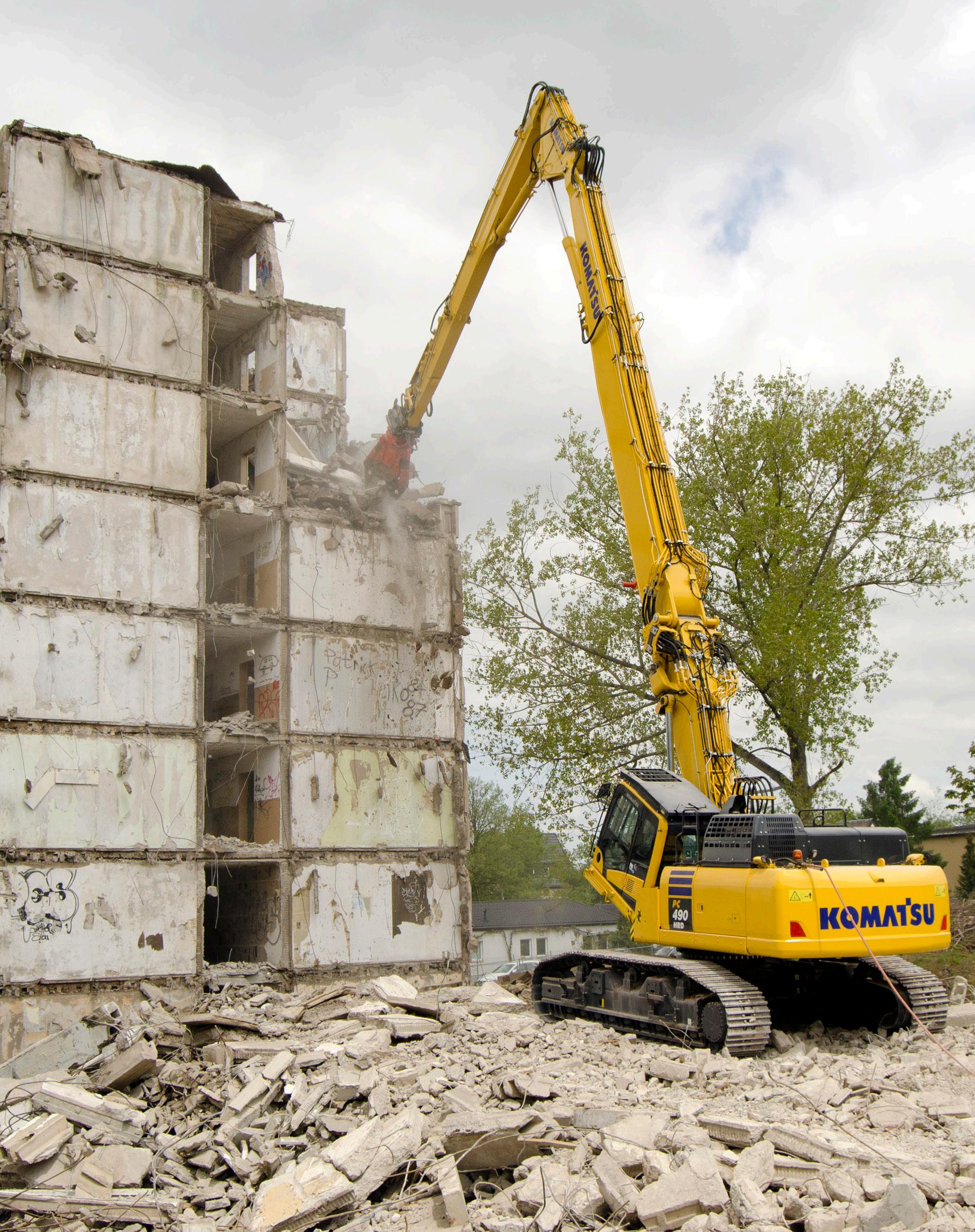
front-end equipment including two-piece boom, straight boom and one-piece monoboom, all Komatsu factory original.
We want the contractor to have peace of mind; to simply know the machine is a demolition machine straight out of the box.
From our other European factories in Italy and Germany we offer a range of mini and midi excavators, wheeled loaders and wheeled excavators. We also offer the BR380JG-3 mobile crusher as well as articulated dump trucks and many other products, including a range of attachments.
There is a distributor network operating across Europe, selling the machines to our customers and providing on the ground technical support, backed up by a Europewide team of factory based experts.
QWhat makes Komatsu different?
I believe one of the things that makes Komatsu different is our commitment to have a strong presence local to our customers –there are 85 Komatsu manufacturing plants around the world. Another important point is Komatsu’s focus on the customer – the products are tools that must enhance our customers’ businesses.
We have several worldwide employee programmes, such as “The Komatsu Way,” which ensure the customer’s needs remain front and centre of what we do. To that end, we develop and manufacture all of our key technology in house; we believe this ensures the final machine is as efficient and effective as possible.
A great example of this is the
interview
DemolitionHub.com DemolitionHUB Magazine | 55
hybrid technology we offer in the HB365 hydraulic excavator. We challenged ourselves back in 1999 to find a way to minimise the impact of our operations on the environment. After much study and development, this became the hybrid excavator. Because the whole hybrid system is developed in house, the machine delivers greater performance than a conventional excavator yet consumes around 20% less fuel. With more than 1,500 hybrids now working in Europe, these machines have saved more than 25 million litres of fuel and more than 65,000 tonnes of CO2 emissions.
Another example of the extensive use of in-house technology is the new K100 boom change system, which we introduced for PC490HRD-11 a couple of years ago. The system allows the operator to change the machine configuration with no need for any manual interaction with the work equipment.
QTell us about your team and working culture at Komatsu
The Komatsu Way programme applies to every organisation within the Komatsu group and encourages every Komatsu employee to think about how their work can improve the customer’s business.
Another one of the many employee development programmes is the Komatsu Techno Olympics competition. This is a worldwide
competition covering factory skills including painting, assembly, fabrication and others. As well as Komatsu’s own workforce, the competition is open to Komatsu suppliers, with the winners in each region going on to compete in the global competition in Japan.
QWhat are the standout product developments from Komatsu’s history?
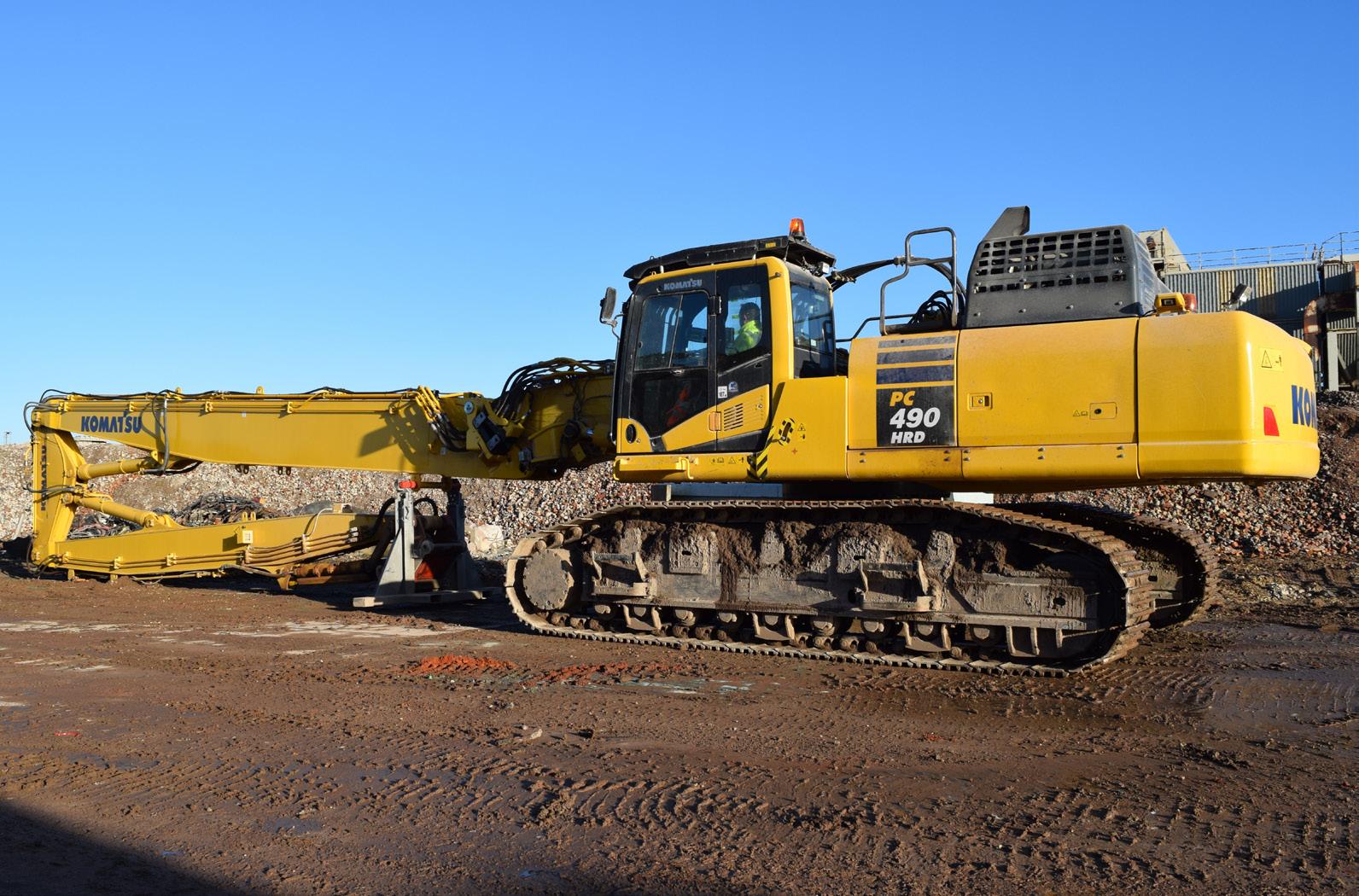
Komatsu has introduced a huge number of innovations over the years. For example, we brought the Komtrax fleet management system to the market right back in 2006 and today, fleet management telematics is widespread.

Other innovations include the first factory integrated intelligent Machine Control (iMC) technology for the 21-t class hydraulic excavator. This has evolved to be ever more capable, with automatic control of tilting bucket in its latest generation, for example. The iMC system allows right-first-time excavation and profiling work, avoiding burning fuel and losing time in reworking jobsites.
There have also been a number of demolition-focused innovations. Back in 2003, Komatsu was the first of the major original equipment manufacturers to fit high reach machines with a factory integrated tilting operator cabin and hydraulically powered inboard boom connection pin as standard. Other demolition innovations have included our current Working Range Indication system, also fitted as standard to the high reach machines, which gives the operator a clear view of the capabilities of the machine allowing the machine to be used to its maximum effect. The system even incorporates the feed from the camera at the end from the high reach arm, avoiding the need for additional screens in the operator’s line of sight.
The latest demolition related innovation is the K100 boom change system. The system takes the proven structure of the previous boom change system and adds Komatsu group technology to allow the operator to change the machine configuration from entirely within the cab. At bauma in 2022, we demonstrated the K100 boom change system five times each day, showing our visitors that the machine can change from digging configuration to extended high reach configuration in less than 100 seconds.
QHow has the scope of Komatsu’s business developed over time?
Komatsu’s business has certainly evolved over the time I’ve been with the company. There have been numerous expansions, for
interview
DemolitionHub.com 56 | DemolitionHUB Magazine


NATIONWIDE DEMOLITION CONTRACTOR WITH OVER 25 YEARS’ EXPERIENCE • Residential & Industrial Demolition • Collaborative Project Management • Committed to Demolition Excellence Nationwide coverage HEAD OFFICE Total Reclaims Demolition Ltd Melvyn Robert House Baker Brook Industrial Estate Wigwam Lane Hucknall Nottingham NG15 7SZ Phone: 0115 963 2009 Email: info@totalreclaims.co.uk Website: www.totalreclaims.com Follow us on DEMOLITION | REFURBISHMENT | SPECIALIST CUTTING | ASBESTOS REMOVAL | AGGREGATES SUPPLY | REMEDIATION
example into forestry and large scale mining equipment, as well as industrial equipment like lasers and semiconductor electronics.
Looking to the future, Komatsu is committed to reduce our environmental impact with a 50% reduction in CO2 emissions from product use by 2030 (compared to 2010), as well as a 50% reduction in CO2 emissions from our production activities within the same timescale. Our ultimate goal is to achieve carbon neutrality with net zero CO2 emissions by 2050.
Komatsu believes that this demands not only the advancement of construction machinery itself, but also changing the way construction projects are done.
An example of this approach is the introduction of Smart Construction technology towards improving site operations, while the
electric 21-t excavator shown at the bauma exhibition in 2022 gives an indication of Komatsu’s product innovation.
Komatsu believes that offering many power source options for construction equipment should be the direction of development. For example, these could include machines powered by batteries, fuel cells, diesel electrics, biofuel and e-fuel diesel, and hydrogen.

QHow does Komatsu gain business and spread the word about its products?
Any opportunity to interact with customers is a priority for Komatsu. Together with our distributors, we are involved in large events such as bauma as well as regional activities such as the NFDC in the UK and regional exhibitions around Europe. Through these activities we can
learn from our customers as well as show our latest developments. We also like to show our latest news through our webpages and social media channels. Each factory has a customer experience centre where we are pleased to let our customers see and try the latest innovations.
QTell us about any apprenticeships or trainee schemes Komatsu has We believe in investing in individuals early in their careers, so they have opportunities to develop their career within the company. Our apprenticeships and trainee schemes are carefully designed to give practical experience, mentorship, and formal education, ensuring that participants gain the skills and knowledge needed to excel in the construction and mining equipment industry.
We take a proactive approach to counter challenges in the labour market, such as collaboration and partnership with technical schools, colleges and universities to develop specialised programmes that cater to our industry’s specific needs, ensuring a consistent supply of skilled workers.
Komatsu is committed to investing in training; we have established training programmes that provide hands-on training with real experience to attract, motivate and nurture new recruits. We actively promote diversity and inclusion, encouraging individuals from diverse backgrounds to join our workforce, thereby expanding our pool of potential new recruits.
QDoes Komatsu provide ongoing training or Continuous Professional Development?
Continuous learning and development are essential aspects of our commitment to maintaining a skilled and adaptable workforce. There is a wide variety of programmes and initiatives.
interview
DemolitionHub.com 58 | DemolitionHUB Magazine





the industry’s No.1 authority, we’ve stayed true to our mission to support the needs of concrete and masonry professionals. Today, we’re working just as hard to deliver opportunities and strategic connections as we did on day one. Join us to see, touch and test state-of-the-art solutions that drive informed decisions and put your business on solid ground for the year ahead.
LEGENDS
REGISTER NOW at worldofconcrete.com LEARN MORE ABOUT WOC VIEW INTERNATIONAL EVENTS BUILD A LEGACY OF SUCCESS.
JANUARY 23-25, 2024
JANUARY 22-25
CONVENTION CENTER
As
WHERE
ARE MADE
EXHIBITS:
EDUCATION:
LAS VEGAS
For example, there are programmes covering, Safety Training; Technical Training; Leadership and Management Training among others. We don’t just look at our own activities in house, we also consider how our team represents the company while on customer sites.
Regular performance reviews and feedback sessions are used to identify areas where employees can improve and grow. These discussions often lead to development plans.
QHow do you see the outlook for the demolition plant sector generally?
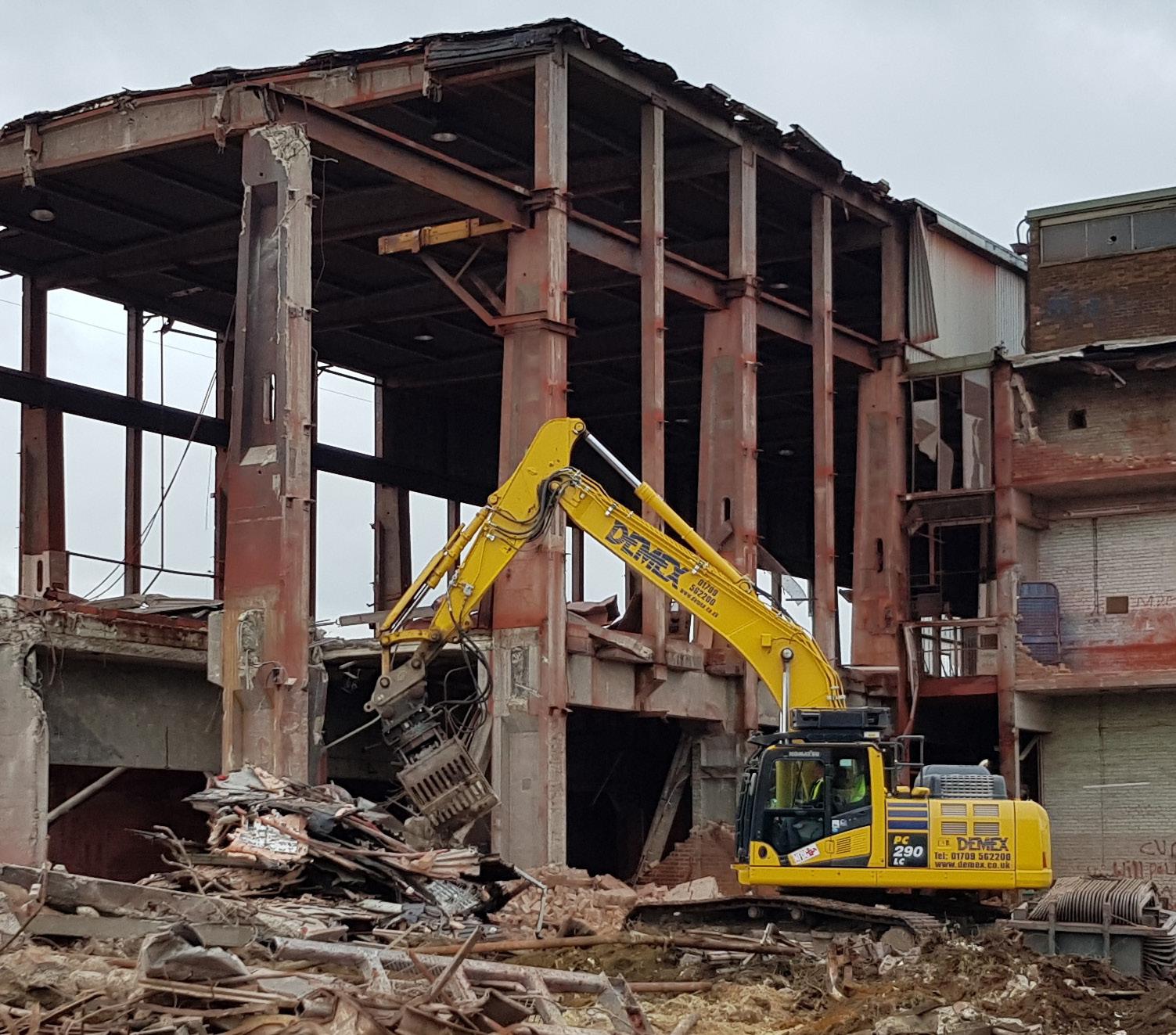
Demolition plant evolution will continue to be strongly influenced by protection of the environment and further safety improvements. High reach machines in particular are very different from the machines I saw 20 years ago. Today’s machines have a much bigger working envelope, higher productivity, greater precision, more versatility and more operator support, all with lower fuel consumption. I feel greater project efficiency will drive equipment development.
QTell us about any engagement Komatsu has in the community Komatsu has a strong commitment to social responsibility and community engagement, wherever we operate. We strongly support local communities by getting involved in activities like volunteering, charitable donations, and educational programmes. We strive to be a positive force in the regions where we operate.
Komatsu also invests in educational programmes to enhance the skills of individuals working in the construction and mining sectors. These programmes include training for operators, technicians and engineers to improve their proficiency and safety.
One of our core values is to collaborate closely with our suppliers, ensuring they adhere to high standards of ethics, human rights, sustainability and social responsibility. This commitment extends throughout our supply chain, promoting responsible practices. We believe this also encourages teamwork and commitment from our suppliers.
PRODUCTS
QTell us about one of your key demolition-relevant products
The key products we offer to the demolition industry in Europe are the high reach demolition machines and the demolition excavator product range. The PC490HRD-11 with the K100 boom change system is our flagship demolition machine. The K100 system also offers valuable health and safety benefits because technicians do not need to carry out physical work to disconnect the boom and do not need to work at height.
The K100 boom change system was developed by Komatsu UK taking into account more than 20 years’ knowhow and on-site experience. The system brings together technology from around the Komatsu group to cater for a wide range of potential issues when changing the boom of a high reach machine. For example, misalignment / misconnection, removal of residual hydraulic pressure in the detached equipment and confirmation of

interview
DemolitionHub.com 60 | DemolitionHUB Magazine
the connection status are all covered by the built-in technology.
Take alignment for example. The control system has to be able to guide the operator from the large scale movements as they approach the target boom, through to very small movements as the equipment is positioned for the powered pins to engage with the bores.
The K100 operator interface is packaged into the same unit as the working range indication system for the conventional high reach machine. This avoids any view restriction through the cab windows. During the boom change process, the K100 control system monitors all the critical parts of the equipment and offers advice to the operator.
In summary, the K100 boom change system is a comprehensive system that guides the operator through the connection and disconnection process allowing the machine to be reconfigured by the operator alone, from within the cab, without external help.
QOutline the key functions of the product
Some of the most important aspects of the Komatsu machines are the
standard fit safety systems, such as the neutral detection system. This avoids unexpected movement if the hydraulic system is engaged with one of the control levers beyond the neutral position.
Another important safety feature is the KomVision surround view system, which is also fitted as standard. This uses a network of cameras around the machine to present the operator with a bird’seye view of the machine and its immediate surroundings, helping to avoid collision with objects around the machine.
Other important safety features are the standard fit LED lamps, which provide clear illumination around the machines and the high impact protective EN356 class P5A glass (complying with the European regulation EN474 Annex G). The glass is able to resist repeated impact from a 4.11-kg steel sphere dropped from a height of nine metres. The Falling Object Protection System (FOPS) is compliant with the standard ISO10262 Level 2. One of the lesser known details of the Komatsu FOPS guards is that the shape of the grids is complex, being both curved and fanned, so
that the grid presents the minimum obstruction from the operator’s eyeline.
Taking the PC490HRD-11 machine itself; one major characteristic is that it is able to work in six different configurations. The K100 system makes it even simpler to switch between configurations, fully releasing that versatility. Even in site conditions, the reconfiguration of the machine should take only a few minutes, without getting out of the cab.
The machine itself is widely appreciated for its smooth controls and stability. Many customers explain that they purchase a Komatsu high reach after experiencing a machine on a project.
We want the operator to be happy in the high reach machine. All of the high reach machines we manufacture have a tiltable operator cab (up to 30°), operated by joystick switch. There are also joystick switches to control the front and roof window wash wipe system as well as the attachment open/close and rotate function. A standard fit integrated attachment control system allows programming of up to 15 different attachments to give maximum performance from the attachment. We also provide internal and external emergency cab down switches to allow the cab to be lowered from working position even if the engine power is off.
The underside of the upperstructure is fully enclosed by heavy duty covers, with wraparound side guards to protect the sides of the upper structure from damage. The hydraulic undercarriage is also fitted with full length track roller guards as standard.
QHow does it differ from competitor products?
We believe that the Komatsu high reach machines give the best maximum height in their class, based on operating weight. For example, the PC490HRD-11 will reach up to 32

interview
DemolitionHub.com DemolitionHUB Magazine | 61
metres in extended high reach mode, with an operating weight of less than 80,000 kg. The PC390HRD-11 can reach up to 26 m, with an operating weight around 62,000 kg. Our high reach machines are designed and manufactured from the bare steel as high reach machines – there’s no modification after manufacture. Our design philosophy of using high strength steels and
minimising the welds throughout the structure means that the weight of the work equipment can be minimised without compromising durability. This means that we can achieve great stability and attachment capacity combined with excellent forward reach, all without having excess weight in the base machine. This minimises ground pressure and helps with transportation.
Because all the important control and power systems in the machine are designed and manufactured by Komatsu, the machine offers exceptionally smooth combined operation, which greatly aids precise operation and productivity when working at high reach.
There is a Working Range Indication (WRI) system fitted in the operator cab of all the high reach machines. The system automatically detects which work equipment is fitted and presents a real time view of the available working envelope, including the industry recommended 2:1 working line. The system takes into account the levelness of the surface the machine is sitting on as well as the weight of the installed attachment and allows the operator to get the maximum performance from the machine.

The K100 boom change system is unique in that it incorporates all connections between each boom section, including the minor electrical connections and any auxiliary services like autogrease and water spray dust suppression. The process of disconnecting a boom and connecting to a new boom can
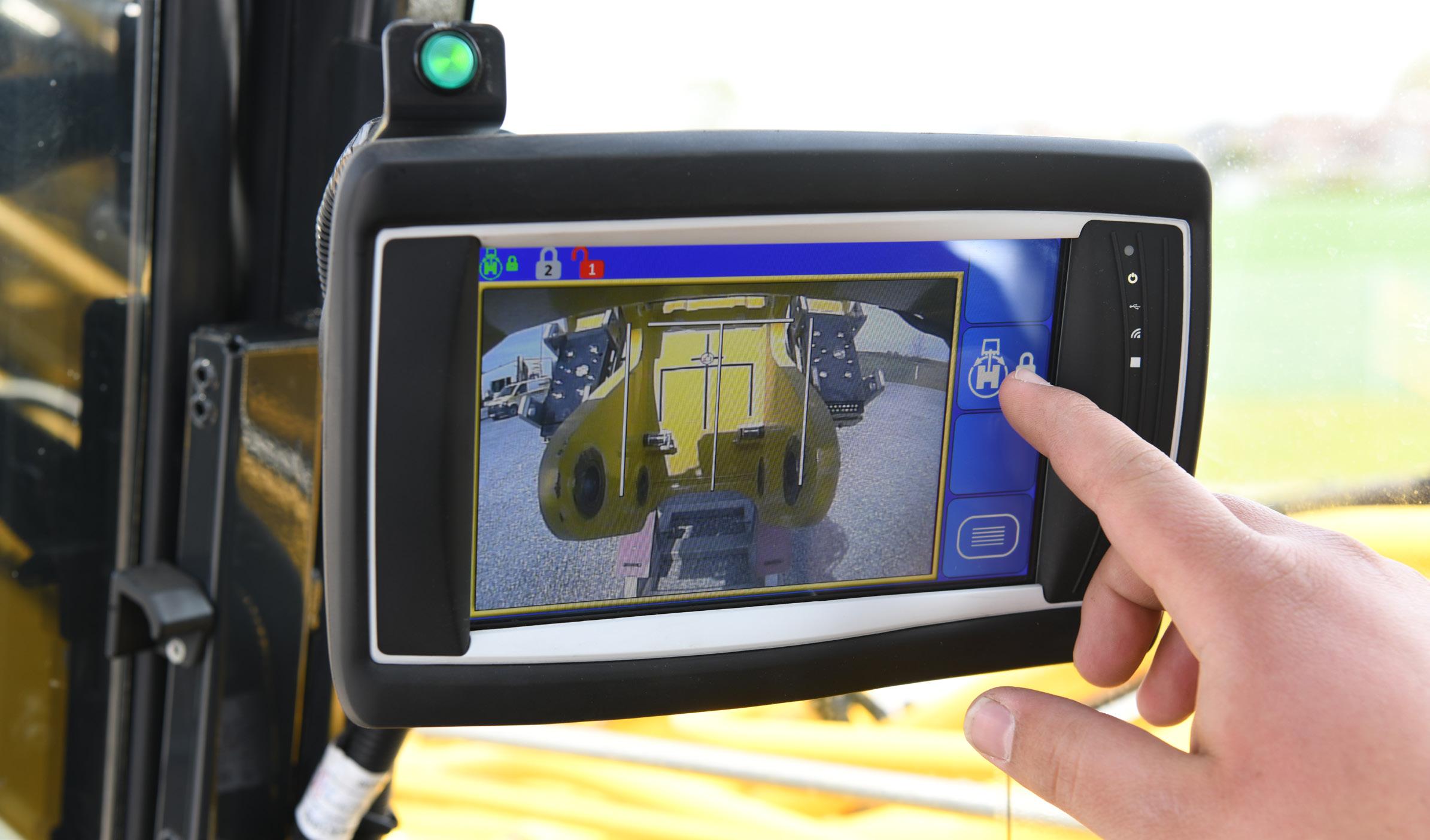
interview
62 | DemolitionHUB Magazine DemolitionHub.com
be carried out by the operator alone, without external help.
A range of factory-backed warranty programmes are available, as well as the usual Komatsu aftersales support, our demolition machines are intended to continue working productively in the long term, just like any other Komatsu product.
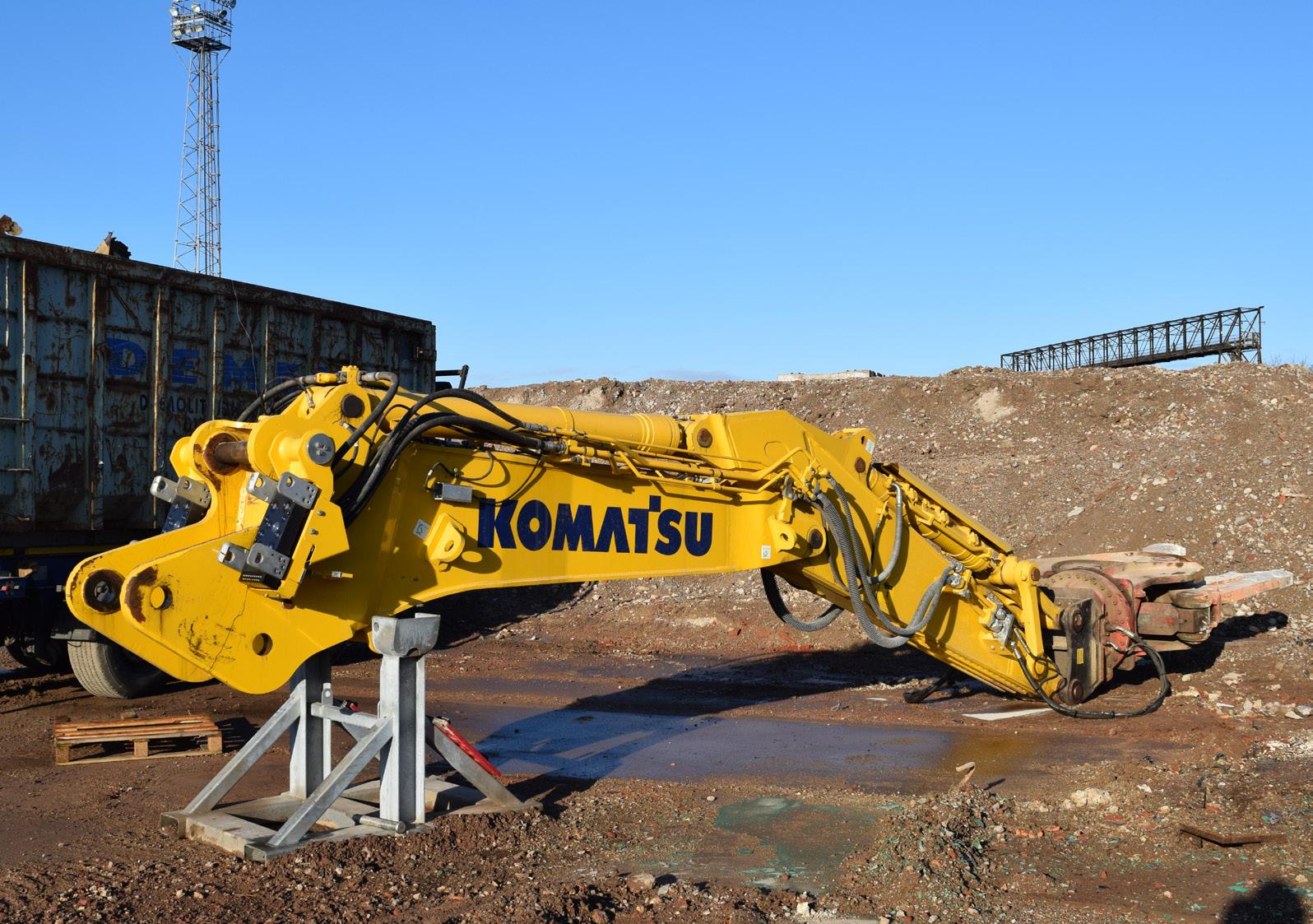
QWhy should demolition contractors buy the K100 system?
Because the K100 system makes the configuration change so much easier, allowing the operator to correctly configure the machine for whatever task is at hand. If the operator is faced with a heavy section of a structure, the K100 allows the operator to reconfigure the machine into an arrangement that will allow the full hydraulic power of the machine to be applied. The operator does not need to risk damage to the machine by using work equipment incorrectly and does not need to lose time carrying out the configuration change.
The K100 system also makes it simple for the machine to be configured into smaller parts to make transportation easier.
Making full use of the K100 system and the machine’s natural versatility could even allow the customer to use one machine on site where several machines would be required to support a high reach with a conventional boom change system.
QTell us about the development of the K100
We spent more than four years developing the K100 boom change system. The system was inspired by our customer-focused philosophy; we felt that we would be able to harness Komatsu group technology to make a step change in the usefulness of the high reach machine. We want our customers to be able to make the most of the
machine’s performance whatever the project. Being able to change the configuration of the machine during one single project could potentially save having another machine on site. Furthermore, some sites do not allow working at height, which precludes changing the configuration of a machine with a conventional boom change system. In these circumstances, a machine may need to be transported to an off-site location for the reconfiguration to be carried out. The K100 system avoids this and can therefore save thousands in transport costs.
QHow do you push the K100 system out to demolition contractors?
We carried out the first digital product launch in Komatsu’s history back in June 2021 with a live Question and Answer facility. Since then, the machine has featured in several press articles. We have produced new product brochures, distributor training and aftersales service activity, including building up the necessary spare parts support.
One of the advantages of having a factory local to the European market is that we can welcome customers to the factory, show where the demolition machines are designed, tested and manufactured, right down to the bare fabrications and machining centres. We find that visiting the factory is always an enjoyable and interesting experience for customers.
QHave you had any feedback?
Customers who own the PC490HRD-11 machine with the K100 system are very happy with the way the system works. The K100 system won a silver innovation award from the French Demolition Association SEDDre at the national conference last year, with SEDDre noting the improvements in safety and the environmental benefits that could be achieved by using the K100 boom change system.
Our dealers say the K100 system is very flexible and fast to use, building on the long established reputation of the PC450 and PC490 demolition machines. Journalist feedback indicates that the system has the potential to change the way contractors approach demolition projects.
QHow do you see its development?
We will continue to listen to customer feedback and evolve the system – its key characteristics are that it must be easy to carry out the connection in real site conditions, but that the integrity and stability of the connection must be correct to ensure operator confidence and machine performance.
We can update the controller software if necessary to ensure that the system remains simple to use. We will also look for other opportunities to apply the K100 system to increase machine versatility.
interview
DemolitionHub.com DemolitionHUB Magazine | 63
QYou have been invited to discuss the UK demolition industry’s skills crisis at the World Demolition Summit this year. Are you able to give us an early insight into the purpose of your talk?
The issue of talent, skills and recruitment is a serious one for the industry and it is something we at Rye have spoken about for quite some time in a variety of ways. Our Managing Director, Simon Barlow, is the Second Vice Chair of the NFDC and Chairman of the NDTG and so has a particular interest in this area.

During the seminar at the World Demolition Summit I will be sharing insight around the challenges facing the industry based on research. We are currently surveying the demolition and construction industries to get their take on the matter. I am also meeting with schoolchildren to understand their
perceptions of the industry and their appetite to join it.
Not only will I share details of the challenges we face, but also some of the solutions that we should all consider if we’re going to keep the industry fed with fresh, hungry talent into the future.
If anyone would like to add their opinion to the mix then they can complete the survey here: www.surveymonkey.co.uk/ r/28BV2ZW.
We will be sharing the output of the report with the industry once it is completed in hope that we can all take something positive from it.
QWhy did Rye Demolition feel it was important to survey the demolition and construction industry regarding its hiring difficulties?



It is an issue that faces us all and we
want to lead the conversation to drive change across the industry. To do this we felt it important to not just rely on our own perspective but to gather insight from across the industry.
We believe that we all have a responsibility to address key challenges in the industry. We have done a huge amount around
Demolition Hub speaks to Jonathan Cox of Rye Demolition about the UK demolition industry skills crisis and his upcoming role at the World Demolition Summit in Toronto
DemolitionHub.com 64 | DemolitionHUB Magazine interview
“It’s important that we come together to share thought leadership and grow together as an industry. Challenges cannot be addressed by one party alone”
environmental matters and are keen to address this major issue too, along with the NFDC, NDTG, other federations, media organisations and demolition companies across the world.
Only through a collective effort can the shift be made.
QHow has Rye overcome these challenges itself?
We haven’t overcome the challenges, but we have deployed a variety of initiatives to help us on our way. We have always employed apprentices and trainees. In fact, we are taking on a new group of apprentices in the autumn, under the NDTG’s Trailblazer scheme.
Part of the secret is ensuring our team members feel they have a positive future with the company and the industry, so we invest heavily in their training and development.
Many other industries offer brilliant development paths and we must do the same if we are to retain the most hungry and dedicated professionals.
In addition, we have sought to acquire talent from other walks of life – people with different experiences and transferable skills. For instance, we have several ex-forces personnel working for Rye. They bring great discipline, an awareness of hazardous environments and a great deal of resilience and creativity.
We have also recruited exoffenders. They are a part of society that is often forgotten about, yet have much to offer. They are generally eager to learn and create themselves another shot at success.
In essence, we look to broaden our horizons beyond the existing talent pool and look for new ideas, different experiences and passion from all walks of life.
QYou’ve attended the WDS previously. How did that come about and what did you learn from the experience?
We attended the WDS in 2022 having been invited to talk about our Carbon Audit journey – Rye Group is the only UK demolition organisation to be verified carbon neutral, unless someone else is keeping it very quiet.
The WDS was keen for us to share our experience with the industry to help us all green ourselves as much as possible.
It is only by sharing our collective experiences that we can all improve. It was on the back of this that we were also invited to the EDA conference in Amsterdam to further share our experience in this crucial area of work.
We learned a lot at the event, but most crucially it was that so much more can be achieved if the industry pulls together. We had many follow-up conversations with other contractors, suppliers and federations on the back of our attendance and it has hopefully helped others make their own shift in practice.
QWhy are events like WDS and the British Demolition Awards so important for demolition industry professionals?

We are keen advocates of sharing best practice and hearing the experiences of others. That is why we happily attend such events. It’s important that we come together to share thought leadership and grow together as an industry. Challenges cannot be addressed by one party alone.
Again, this is why we’re trying to pull together the collective wisdom of the industry around talent and skills.
QYou have worked at Rye for three and a half years. What are your thoughts on this industry and how does it differ to other marketing sectors you have been involved in?
It is fair to say that the demolition industry is like no other I have worked in. I have worked across retail, automotive, learning and development and technology and all have unique challenges.
The greatest positive aspect of the demolition industry is the passion and the tight-knit community. There are few other industries where such a large proportion of the workforce is quite so embedded from beginning to end of career. This means there is a great deal of knowledge and expertise, which means there is constant rivalry and desire to be the best, but also a surprising amount of willingness to share best practice.
Through the NFDC you see just how keen the many accredited demolition contractors are to raise standards and deliver ever safer, higher quality services. Simon Barlow is a shining example of this and is frequently sharing Rye Demolition’s experiences and lessons to allow others to learn and develop too.
Our mindset is that a rising tide lifts all boats, so let’s raise that tide together.
DemolitionHub.com DemolitionHUB Magazine | 65 interview
Global News Media and Demolition Hub have been producing the independent British Demolition Awards since 2018. As a result of the enforced break due to Covid-19 in 2020, we looked at the event in depth and realised what it needed.
Post-Covid, 2021 ushered in a new British Demolition Awards including more contractors, a bigger networking arena and a



switch to stadiums. Add to that the introduction of the asbestos industry last year and the fact that Tottenham was the best attended awards-do yet, putting together the greatest number of demolition professionals at any event.
I would like to thank the sponsors, the attendees, those who entered and all those who were any part of London 2023.
Over the next few pages we have images from the night and feedback from some of the winners.
Finally, it is with great pleasure that I can announce we are doing the very same thing on 6 September next year at the Tottenham Hotspur stadium. Join us.
Ben Chambers
66 | DemolitionHUB Magazine DemolitionHub.com
Contractor of the Year: Cawarden



Cawarden always works hard to do all the right things and grow by recognising and addressing the significant challenges the company has overcome. With social value at the core of its business they always showcase the many ways they give back to their employees, the environment and the local community.
Under Managing

Director William Crooks’ leadership, supported by sons and fellow directors, ambitious plans are afoot with further sustainable growth. Cawarden regularly promotes careers in this exciting industry to younger generations and to those who are longterm unemployed, while providing work experience opportunities for school pupils, students and graduates.

DemolitionHUB Magazine | 67 DemolitionHub.com
Cawarden Demolition Contractor of the Year
We are thrilled to have been awarded the Demolition Contractor of the Year title at both the 2021 and 2023 British Demolition and Asbestos Awards. Winning this award twice in just three years is a testament to the unwavering dedication and hard work of our entire team.

Despite facing challenges in our industry and the wider economic climate, we have had a record-breaking year and surpassed our growth targets one year ahead of schedule. Our team has safely and successfully delivered an impressive range of projects across the UK and we’re grateful to our valued clients for trusting us with their enabling and demolition needs.

However, we believe that true
success is not just about achieving growth targets – it’s about creating a positive and long-lasting impact on our communities, promoting the transition to a sustainable, low-carbon economy and taking care of the Cawarden family.
We’re tremendously grateful for all the messages of congratulations we’ve received since the awards ceremony in Tottenham. Thank you for your support.
William Crooks, Managing Director of Cawarden, said: “It is incredible to watch the growth of the business over the last few years. The way Cawarden’s longstanding employees have adapted to the changes in demolition, how our new recruits have integrated into the company
and expanded our skill base and the way our younger recruits have eagerly embraced the industry and become part of the team is fantastic.
“Cawarden is changing. We are no longer a Demolition Contractor the way we were 25 years ago. We offer clients a comprehensive package, including testing, consultancy, demolition, remediation and building up to slab level. This not only expands our business in a new direction but it enables Cawarden to continue to undertake our traditional core business –demolition.
“For Cawarden to win this award with a panel of judges who are three of the most respected people in the demolition world
68 | DemolitionHUB Magazine DemolitionHub.com
is incredible and makes me very proud of what we have all achieved.”

The judges said: “Cawarden always works hard to do all the right things and grow by recognising and addressing the significant challenges the company has overcome. With social value at the core of its business they always showcase the many ways they give back to their employees, the environment and the local community.”

Demolition Hub Founder Ben Chambers said: “Under William Crooks’ leadership, supported by sons and fellow directors, ambitious plans are afoot with further sustainable growth. Cawarden regularly promotes careers in this exciting industry to younger generations and to those who are long-term unemployed, while providing work experience opportunities for school pupils, students and graduates.

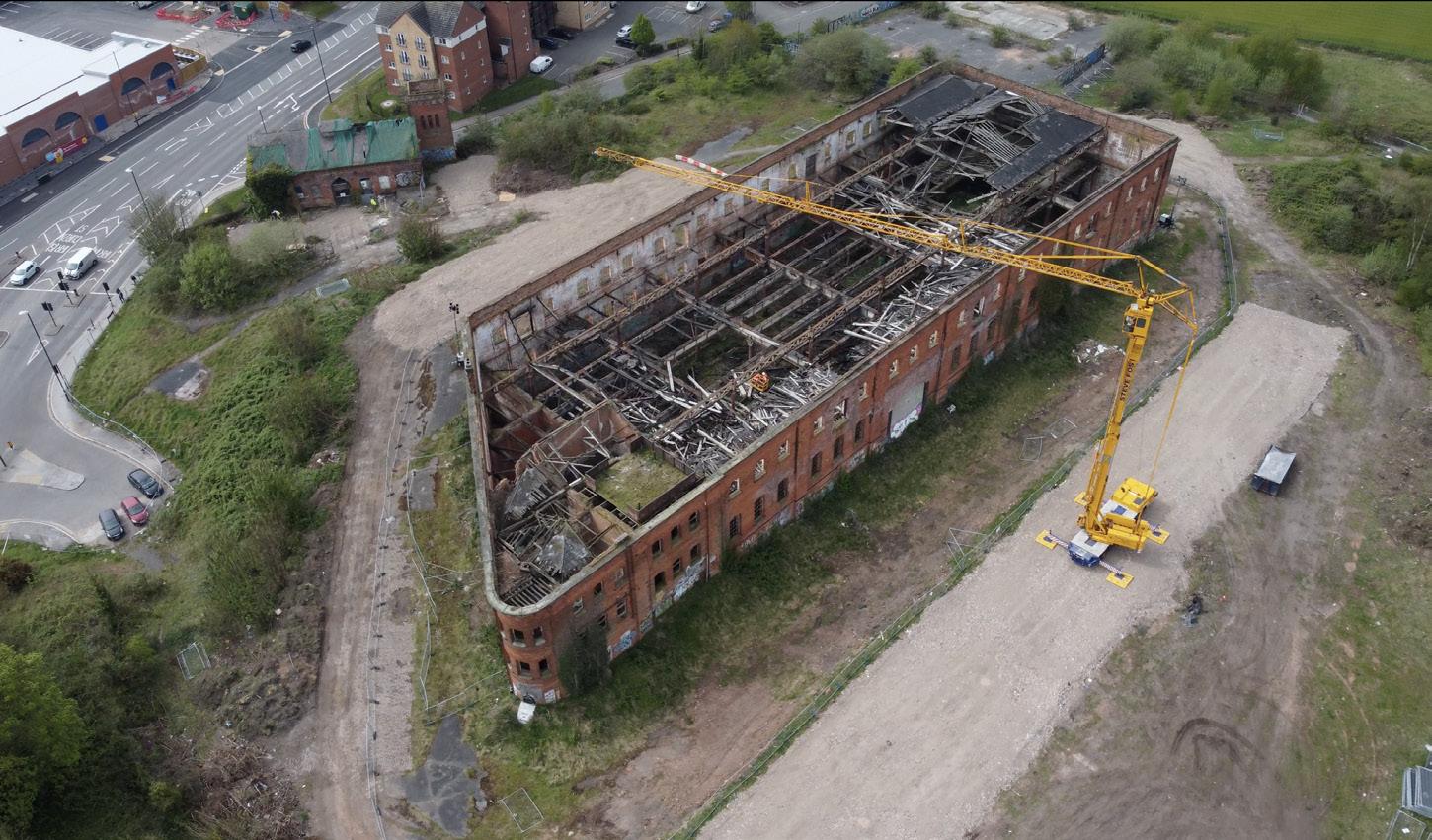
“Having no say in who wins what at each British Demolition Awards is a blessing and a curse. However, when the judge’s opinion aligns with my own, I cannot help but be that extra bit delighted. This happened once again when I received confirmation of Cawarden once again winning Demolition Contractor of the Year at the 2023 British Demolition Awards. Congratulations.”
Kudos to Demolition Hub for organising this industry showcase event. It’s a fabulous celebration that honours the outstanding accomplishments of companies and individuals in the industry and one that we always look forward to attending.
DemolitionHUB Magazine | 69 DemolitionHub.com
Environmental Innovation of the Year: Colemans
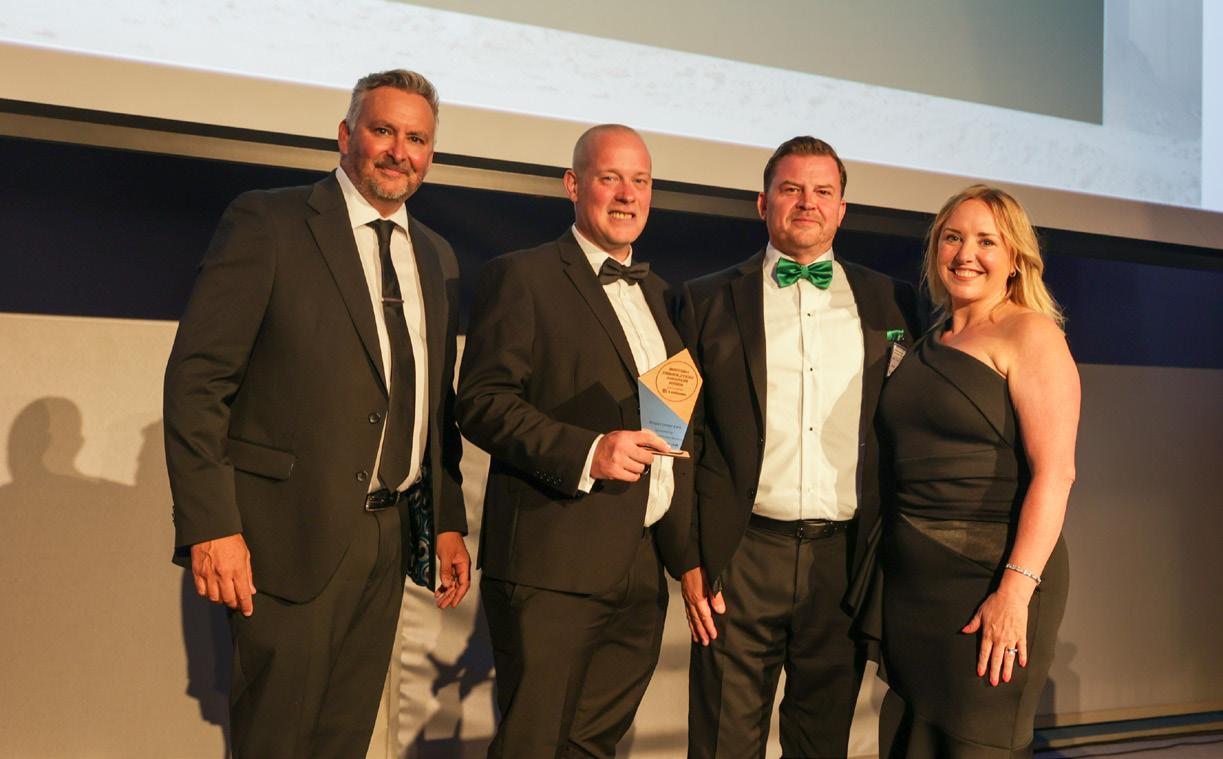


Colemans made a commitment to change the way it operated to demonstrate to the wider industry that steps can be taken to reduce carbon impact. Already committed to net zero by 2050 through the SME Climate Hub, Colemans now strives for accreditation to PAS 2060 carbon neutrality in 2023.
From a pre-demolition audit, Colemans identified 29 different project waste streams, of which 98% could be recycled or reused. Colemans was able to upcycle and donate several items to the local community.
Colemans set up a Carbon Committee that proactively meets to discuss how the business can continue to improve its sustainability strategy, working towards its goal of carbon neutrality by 2025.
Project of the Year Under £1m: Colemans


Colemans’ project was the demolition of the failed River Tame Flood Defence Wall in Birmingham. Being an out of the ordinary project this required good planning and engineering skills and the work alongside the waterway was both innovative and well executed.
With the difficult nature and environment in which the works took place, Colemans completed the job on time, within budget and with zero incidents. This was a complex demolition project for a key client with the health and safety of the operatives and the environment being the main priority.
70 | DemolitionHUB Magazine DemolitionHub.com
Project of the Year Over £1m: Brown and Mason
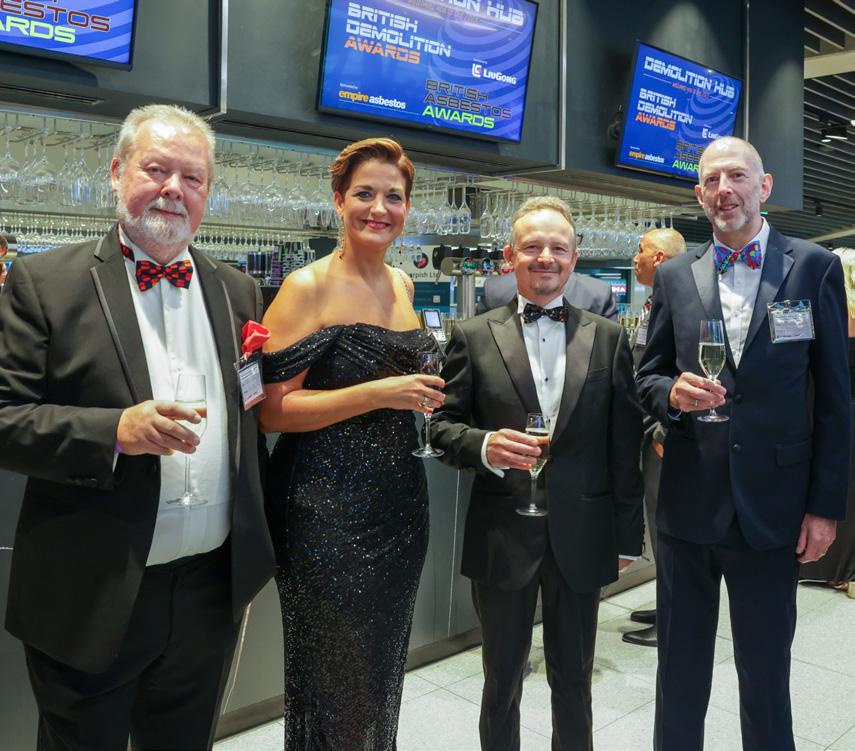
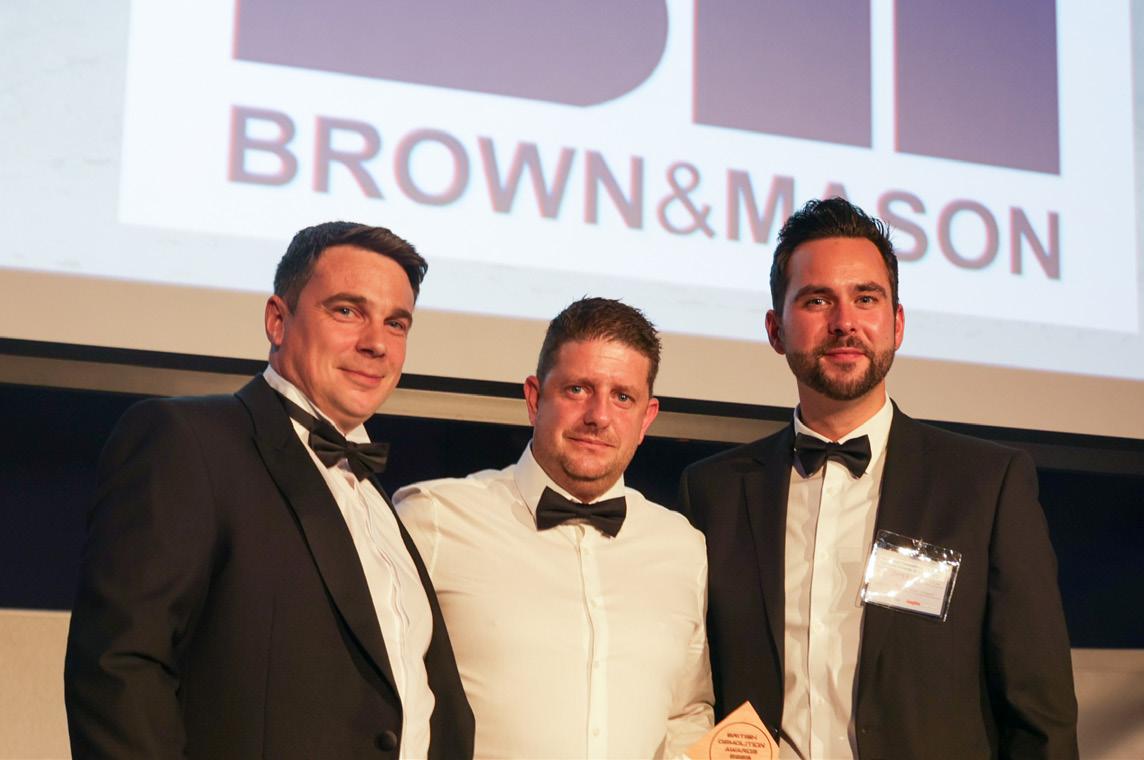
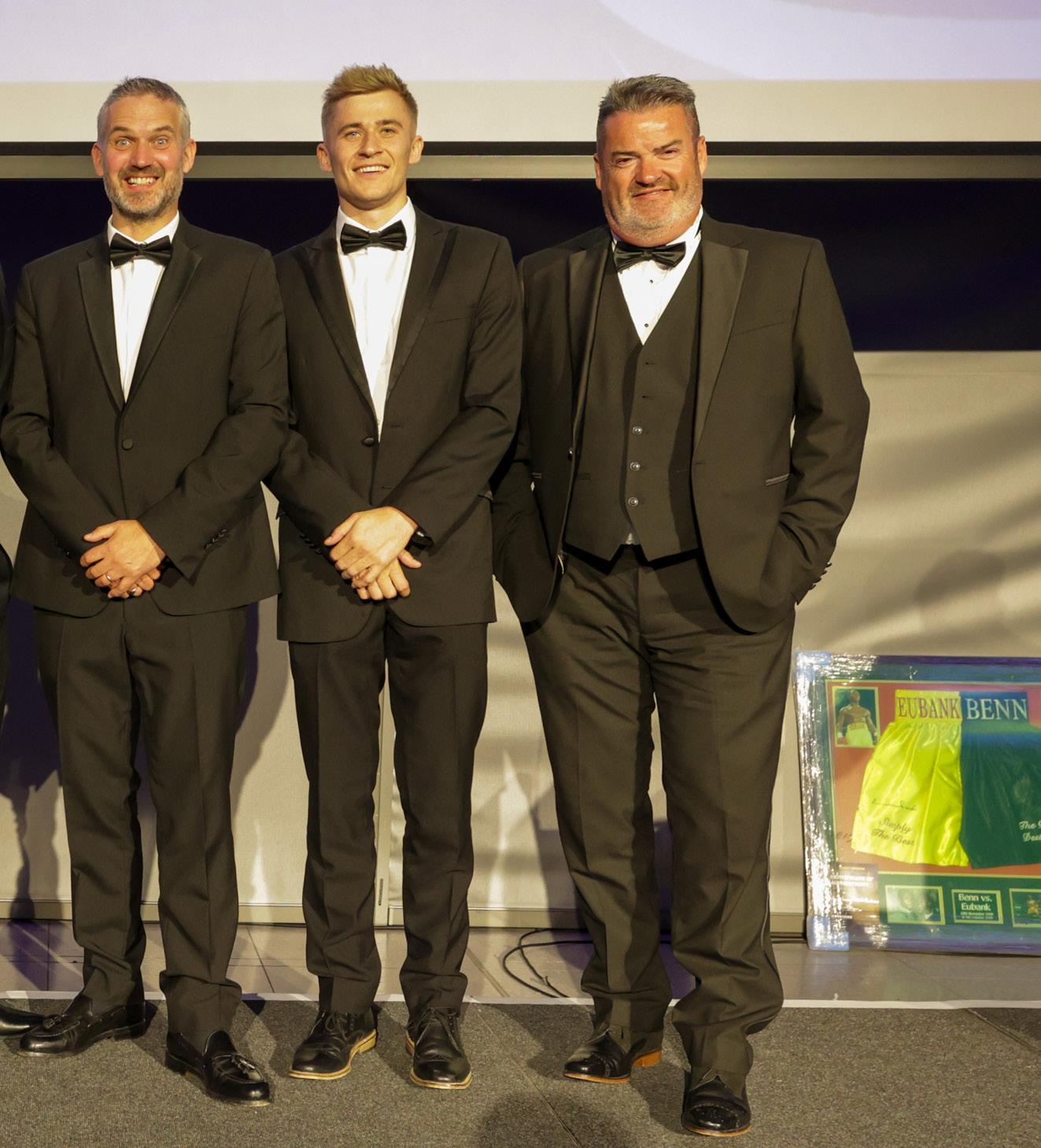
Brown and Mason Group (BMG) was contracted by the multinational energy company Engie to undertake the decontamination, dismantling and demolition of its Gelderland power plant in The Netherlands.
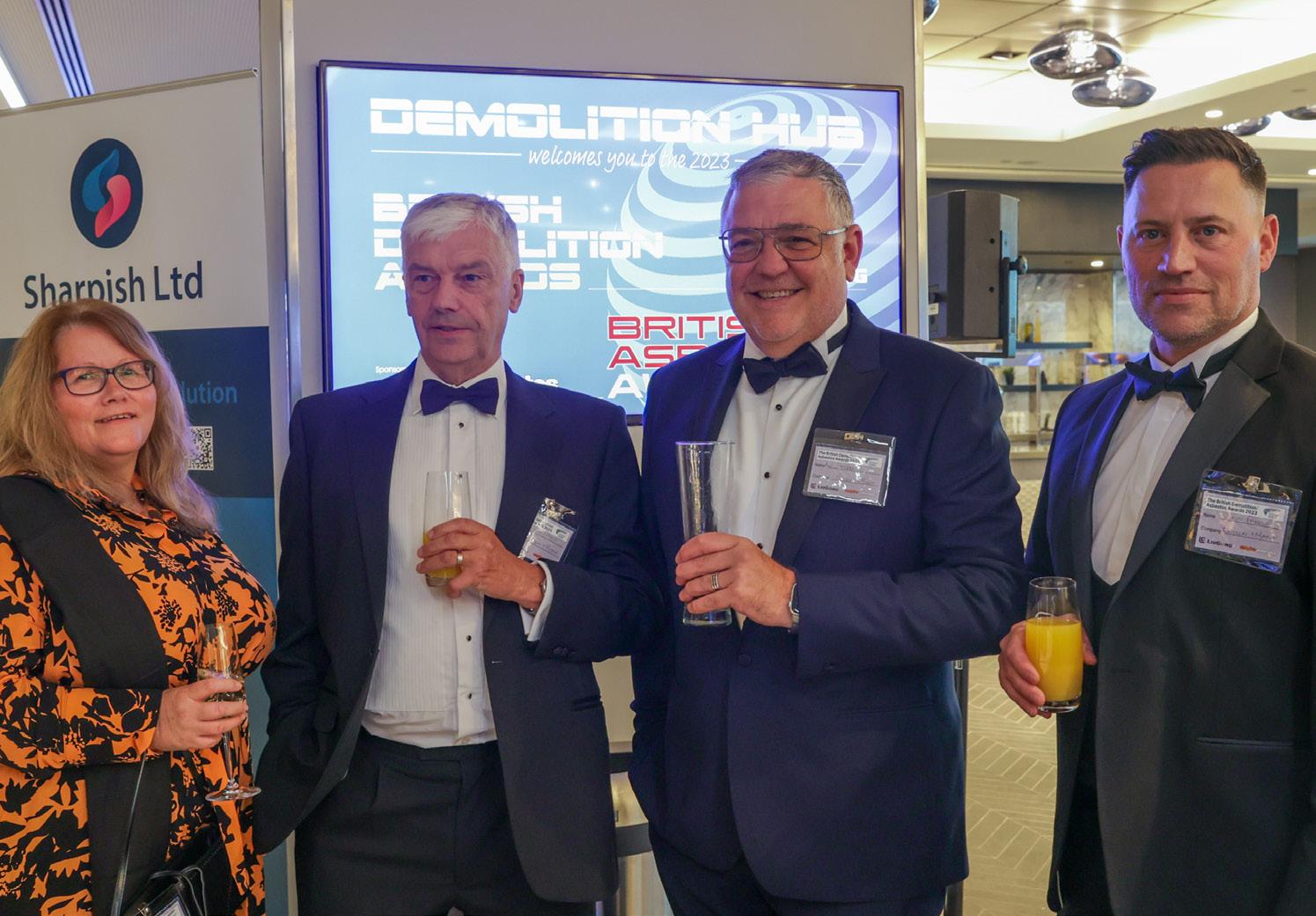
This challenging project was an impressive and well executed blowdown with extremely strict and complex permitting rules. The use of explosives for demolition in The Netherlands, especially on structures of this size is unusual.
The contract was awarded on Brown and Mason’s unparalleled experience and involved substantial asbestos removal and extensive use of explosives, all within the context of Brexit, Covid and the war in Ukraine.
Safety Innovation of the Year: Alert Technology


Alert Technology has developed the world’s first real-time asbestos detection technology. The ALERT PRO range not only provides real-time alarms when asbestos is detected but additionally a brand-new dataset that has not previously been available.
The technology has multiple applications. The judges were impressed with Alert’s development and look forward to receiving further information in relation to concentrations.
DemolitionHUB Magazine | 71 DemolitionHub.com
Brown and Mason Demolition Project of the Year Over £1m Demolition Trainee/Apprentice of the Year (Jack Brown)


Attending the prestigious British Demolition Awards was a remarkable experience that offered a unique opportunity for professionals in the demolition industry to come together. This event is not merely a celebration; it’s a platform for collaboration and knowledge exchange. Attendees, including demolition experts, industry leaders and innovators, gathered to share insights, discuss emerging trends and forge valuable connections. It was a chance to recognise the incredible work done in the field, from handling complex projects to implementing cutting-edge technologies that redefine the industry’s standards.
Winning the Demolition Project of the Year Over £1m is a testament to a demolition team’s relentless dedication and unwavering commitment. This prestigious accolade signifies that the project in question not only met but exceeded the highest standards of excellence. It demonstrates innovation, safety and the ability to overcome unique challenges, setting a new benchmark for the industry. Such recognition at the British Demolition Awards is a true honour, showcasing the best of what the demolition sector has to offer.

In the spotlight, Jack’s victory in the Demolition Trainee/
Apprentice of the Year award category is a momentous achievement that resonates with the industry’s commitment to nurturing future talent. It highlights Jack’s exceptional dedication to his craft, eagerness to learn and grow and remarkable contributions as an apprentice. This recognition is a personal triumph and a symbol of the industry’s investment in cultivating the next generation of skilled professionals. Jack’s success serves as an inspiration to aspiring apprentices, illustrating the incredible opportunities and recognition that await those who embark on a career in demolition.
72 | DemolitionHUB Magazine DemolitionHub.com
Alert Technology
Safety Innovation Award for Real-Time Airborne Asbestos Monitor
Alert Technology was absolutely delighted to win the Safety Innovation of the Year award for the ALERT PRO Connected, the world’s first real-time airborne asbestos monitor and alarm at our team’s very first British Demolition and Asbestos Awards, which was expertly organised by Global News Media. The organisation, communication and evening’s hospitality were as impressive as the amazing Tottenham Hotspurs Stadium venue itself.
As a highly regulated sector, the asbestos industry has seen little in the way of technological advancement or change over the last few decades, so introducing a brand-new method for monitoring and assessing airborne asbestos like ALERT takes time to gain trust and acceptance.
The award, judged independently by experts in the demolition sector, has already helped generate positive interest in ALERT. Receipt of industry recognition in the form of awards like this really helps raise awareness of our disruptive new technology and where it sits within the market.

Never intended as a replacement for traditional air monitoring, the ALERT PRO offers a rapid method of detecting and alarming for airborne asbestos, most vitally it also provides professionals with a brand new real-time, time stamped data set to be used in support of the regulatory method.
For the first time ever, a real-
time warning is now possible. All other forms of asbestos air monitoring provide a singular result at the end of a sampling period, an average concentration for the entirety of the period with no detail about specific increases or decreases. Traditional monitoring provides notification of risk post event once analysis has been completed hours possibly days later.
ALERT offers immediate notification of risk during the event. Its data is not only realtime but also time stamped providing users the ability to see exactly when fibre levels spike and asbestos is disturbed. This data enables the user to pinpoint the specific activities, no matter how short term or sporadic, that led to the release

of fibres. With the availability of real-time, intelligent data comes ability to understand exactly what is increasing asbestos risk and therefore what the most efficient and effective way is to mitigate for it.
Attending the awards on the night from Alert Technology were its founder, Alan Archer, his daughter and Managing Director, Loretta King along with Head of Ops, Mark Nichols and Head of Engineering, Tony Bolton. It’s safe to say the whole team had fun celebrating our success on the night and hope to use the recognition of the Safety Innovation Award and connections made with the demolition industry to help drive innovation and improve asbestos safety for all.
DemolitionHUB Magazine | 73 DemolitionHub.com
LiuGong UK celebrates its 10-year anniversary with strong growth from starting with only twenty five customers to now having over four hundred.


Managing Director Steven Ford sees change as the constant force behind the business and the key to its success. Setting out to approach business with a can-do attitude, change becomes your constant companion.

Being up against big players, LiuGong impressed the judges with its efforts to supply the UK demolition market with a varied range of equipment in such a short space of time.
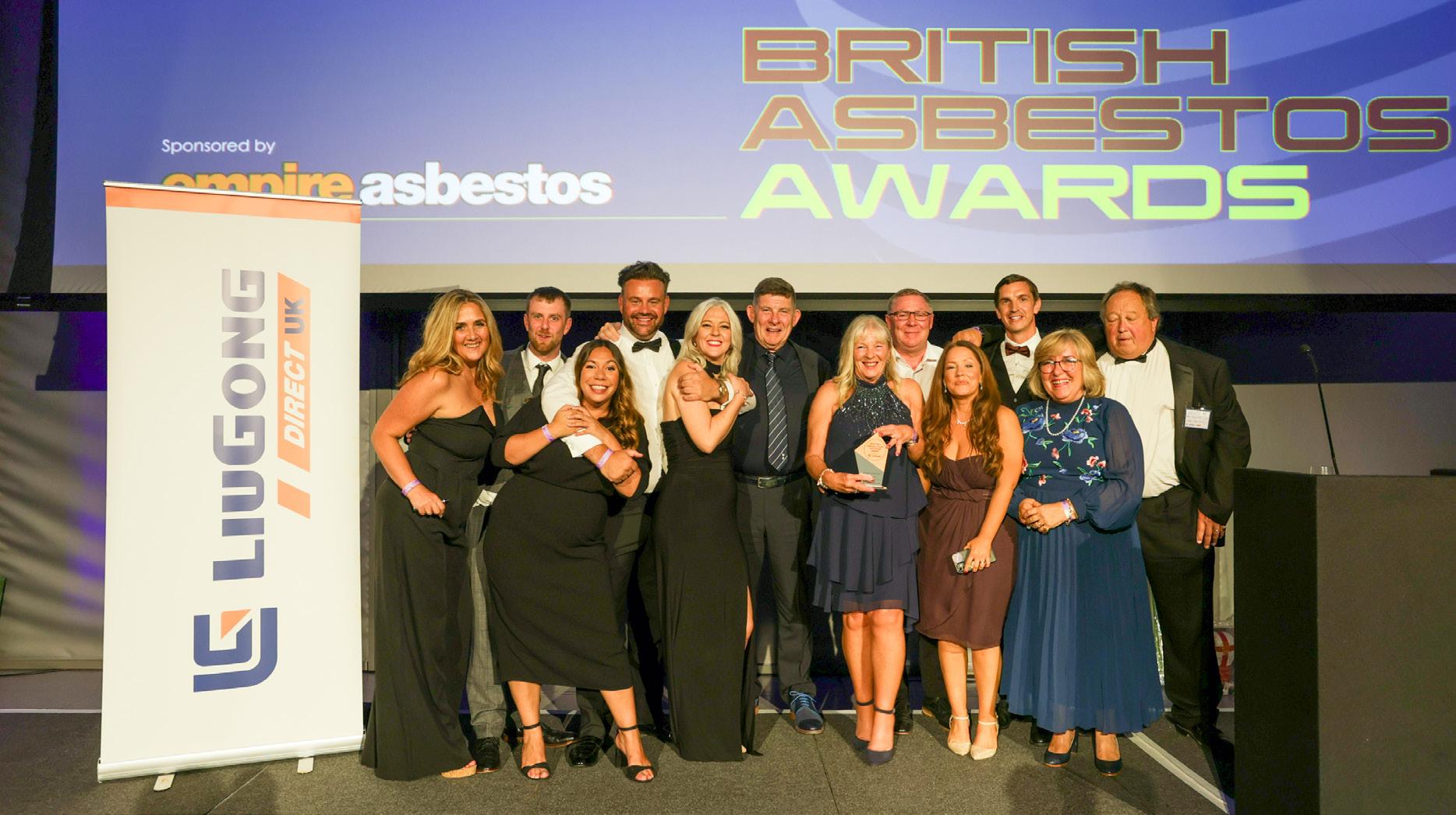
Jack joined Brown and Mason Group as a technician in 2017, he quickly became fascinated with the complexities of controlled demolitions and the responsible use of explosives in construction projects. Jack’s dedication to his role did not go unnoticed and it was soon evident that his potential extended far beyond the role of a technician.
During his apprenticeship, Jack played a pivotal role in the demolition of the Gelderland Power plant in the Netherlands, showing commitment and enthusiasm with a proactive approach to problem-solving. Coupled with his remarkable communication skills, this makes him an invaluable asset to his team.
 Supplier of the Year: LiuGong
Supplier of the Year: LiuGong
74 | DemolitionHUB Magazine DemolitionHub.com
Trainee/Apprentice of the Year: Jack Brown from Brown and Mason
DeMOLITION

HALL OF FAME
est.

2022
Windsor Waste provides a 24-hour transfer station and innovative portal system for consignment notes and carbon reporting and with its carbon reporting software, it prioritises innovation.
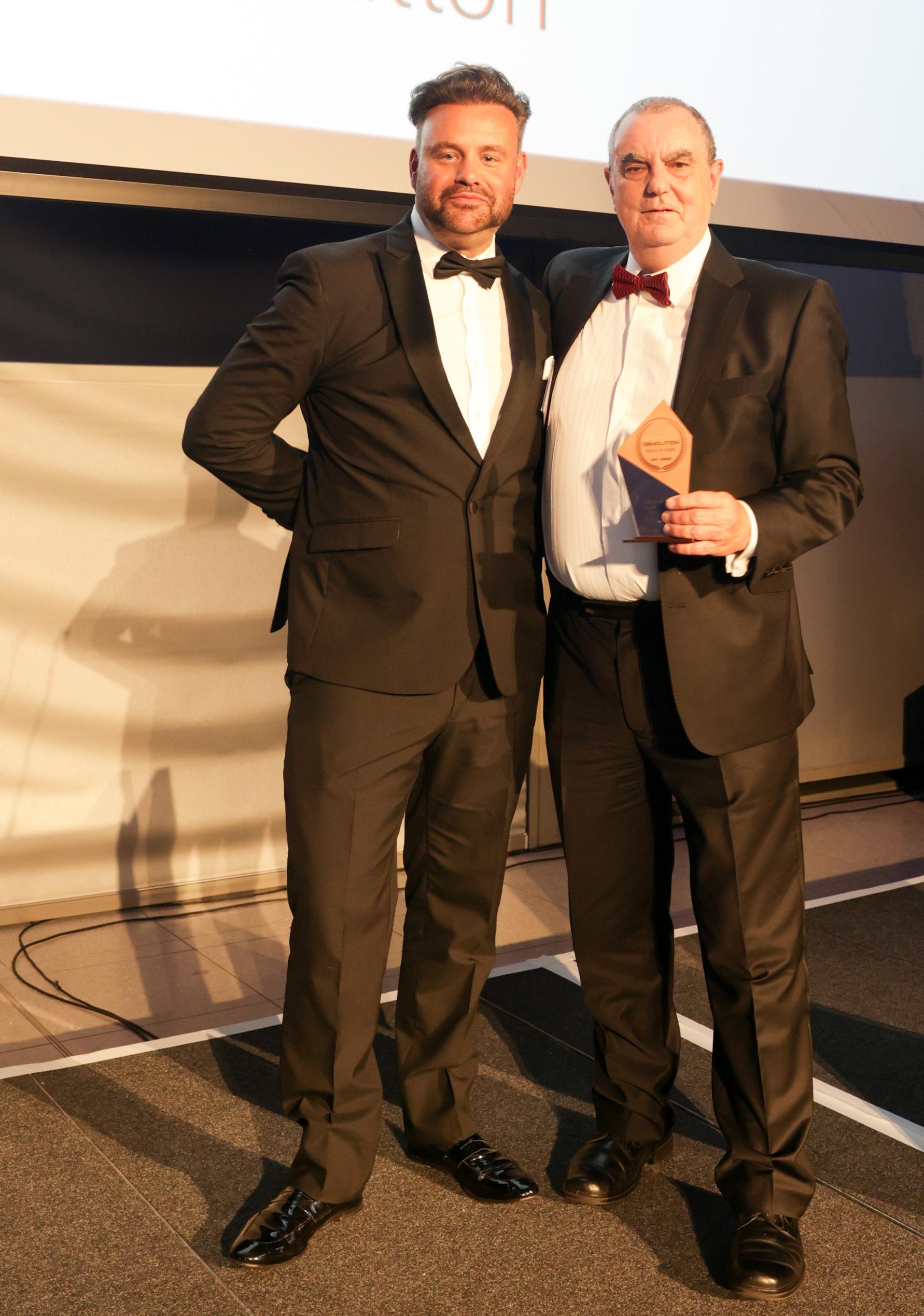

The company is committed to raising professional standards and adding value wherever possible throughout the waste management cycle, on a broader level, to the environment and wider society.

Windsor Waste strives for continuous improvement in disposal services to asbestos and demolition related industries.

DemolitionHUB Magazine | 75 DemolitionHub.com
Waste Provider of the Year: Windsor Waste
Brokk Connect is your entryway to more profitable business and increased Uptime! The online platform enables you to locate and manage the entire robot fleet with precise information, hour by hour. Whether your goal is to grow your business or optimize your fleet, Brokk Connect is the tool for you to take control.

Brokk UK | www.brokk.com/uk

Case study
Title: Mile Cross

Structure: Earthworks and remediation
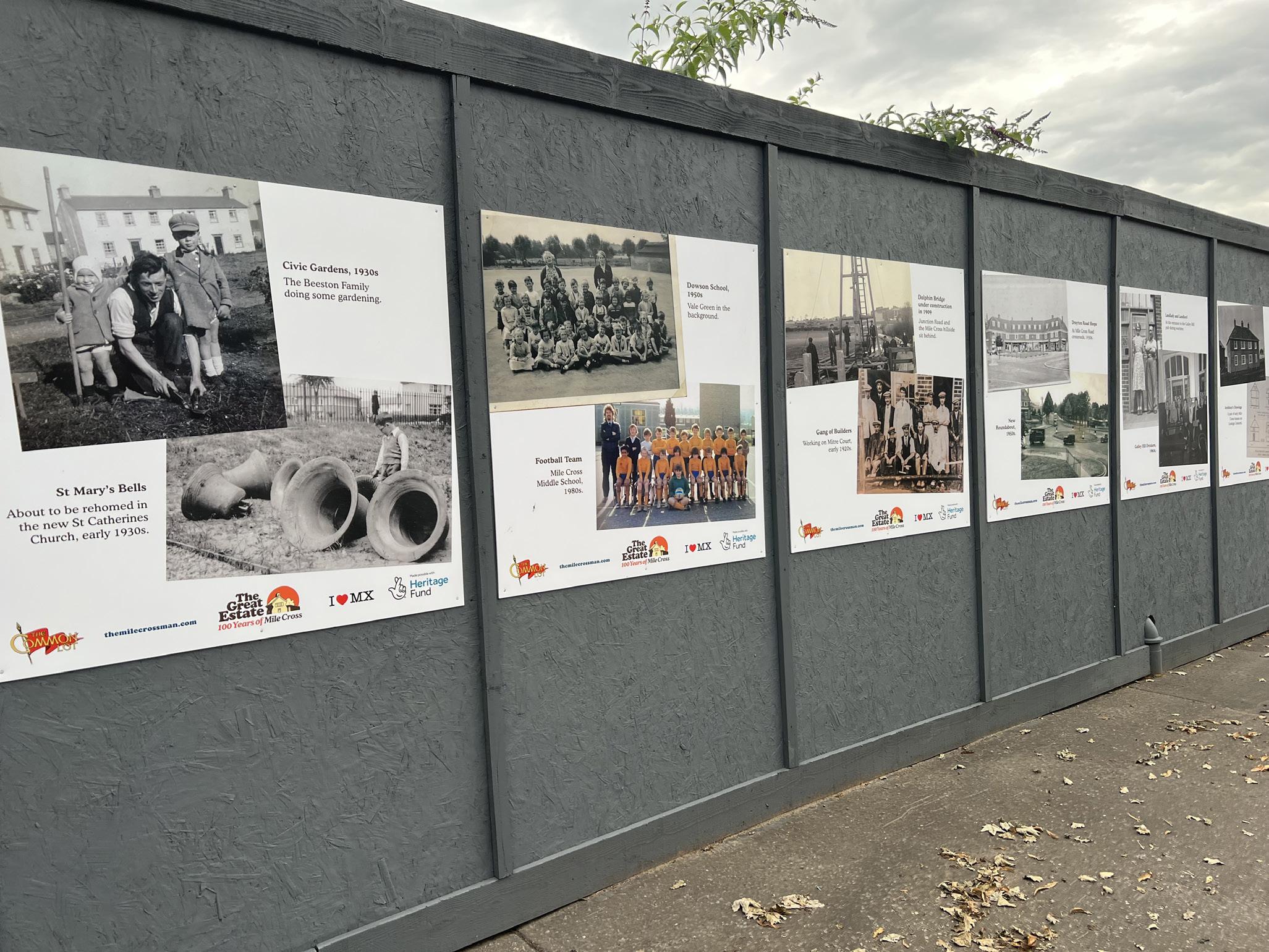
Contractor: Anglian Earthworks and Remediation
Client: Lion Homes – the house building division of Norwich City Council and Norwich Regeneration Ltd


Start date: January 2023
Future use: Affordable housing

DemolitionHUB Magazine | 77 DemolitionHub.com
case study
Anglian undertakes major groundworks and remediation project to rejuvenate one of Norwich’s oldest estates
Anglian Waste Group Ltd is currently carrying out earthworks and remediation works for a major new housing project set to be built by Lion Homes, the housebuilding division of Norwich City Council, to rejuvenate one of Norwich’s oldest estates, Mile Cross in the northern suburbs of the city.
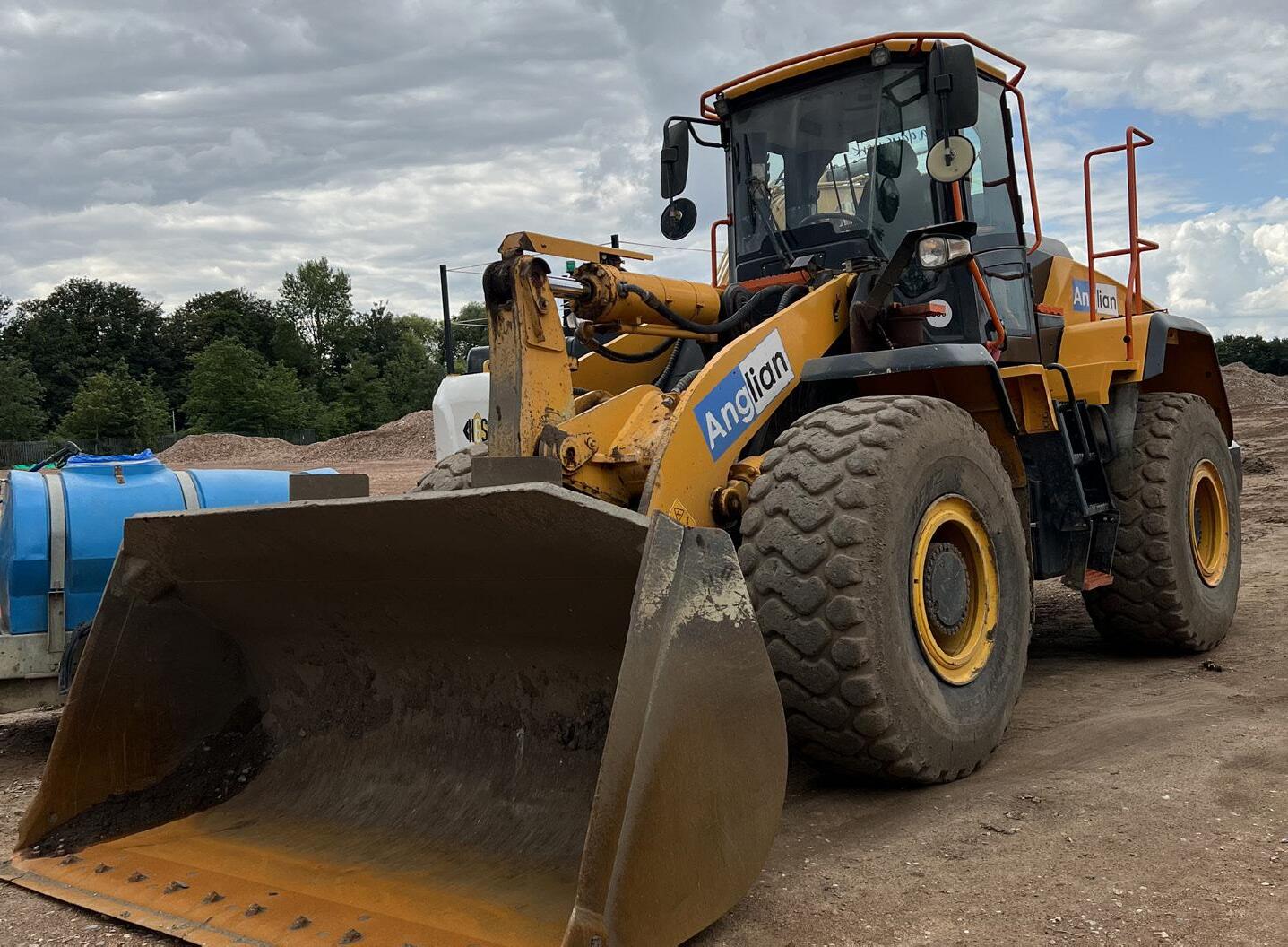
This project is set to create more than 200 new homes, to be available for social rent through Norwich Home Options. The site was previously used as a council depot and was home to the Mile Cross Business Centre, which closed in 2017. The business centre buildings were demolished in 2019 and the site largely remained untouched until last year when Anglian was tasked with digging trial pits, to determine the scale and type of contamination in the ground ahead of the project starting this year.
Anglian is responsible for preparing the site for the structural building works to take place, initially clearing the site of any contaminants and potential obstructions ready for the piling and foundations to be laid.
Transformation underway
The former commercial depot and large brownfield site on Mile Cross Road is set to be transformed by hundreds of new homes.
John Bergin, Trainee Project Manager for Anglian explained: “Our current scope is to dig down to natural undisturbed ground, looking for any contamination such as asbestos or general waste material. We’ll then pass this material through a mechanical screening process removing any visible ACMs and waste product, finally creating a 40 mm down structural fill material and

general hardcore of varying types.
“The 40 mm down material will be engineered back into the ground and the rubble – usually concrete, bricks and tiles – will get crushed to 75 mm down, which will provide a 200 mm capping, creating an ongoing working platform for use in the development of the site.
“The site is set to be developed and become affordable housing for Norwich City Council. The works commenced late January 2023. We are looking forward to seeing this once-derelict part of Norwich become a thriving community once more.”
Protecting the environment with site remediation
Soil contamination occurs as a result of historical industrial processes and waste disposal practices, which can include asbestos and chemically

78 | DemolitionHUB Magazine DemolitionHub.com
impacted soils. Contaminated site remediation involves restoring the soil to its natural state – removing the toxic and hazardous elements including asbestos.

This is important for both the human health risk and the protection of the environment. Anglian is licensed to handle and treat hazardous waste under its EA SR 2008 no.27 permit, all toxic and hazardous materials are disposed of safely and responsibly.
Treasures discovered
One of the most interesting items that has been found is what is believed to be a helmet, possibly dating back to World War Two. This is not completely unexpected as the site was the location of large amounts of rubble after buildings in the city were bombed during the Baedeker Raids in spring 1942. Many houses in the area were damaged over two nights between 27 and 30 April. The area was known to have been full of civil defence workers including firewatchers, ARP Wardens, police and Home Guard.
Investigations are continuing to find out more information about the provenance and history of the helmet. This includes speaking with a local heritage project that has been underway for the last 18 months. The initiative has displayed an overview of the history of the local area on hoardings at the edge of the site, allowing local residents and visitors an opportunity to connect with the history of the area before it is transformed into something new.
Anglian is proud to be involved with such a prestigious project and is always looking for future jobs including more multi-division projects, using the skills and experience it has.
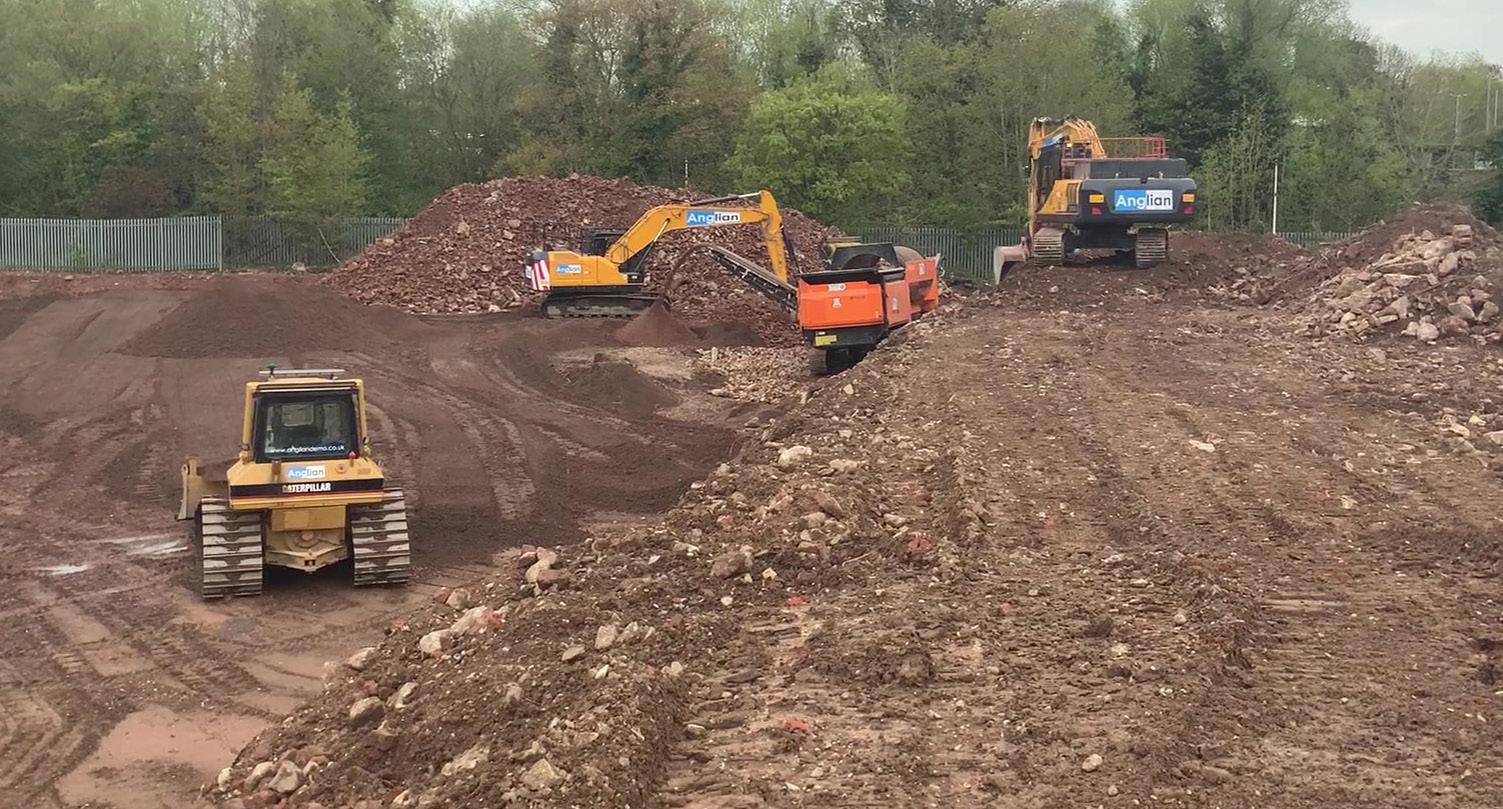

Gary Yabsley, Director of Contracts at Anglian said: “It’s fantastic for Anglian to work with Lion
Homes, Norwich City Council and Norwich Regeneration Ltd. (NRL) on this project in Mile Cross. Historically the area had a negative reputation within the local community, so to be able to assist in turning it into much needed social housing and improve the area aesthetically has been a privilege and we hope to work on more jobs like this in the future.”
If you have a case study you would like to submit for publication in Demolition Hub, please email: toby@chambers.media.
case study
DemolitionHUB Magazine | 79 DemolitionHub.com
Total Metal Recycling
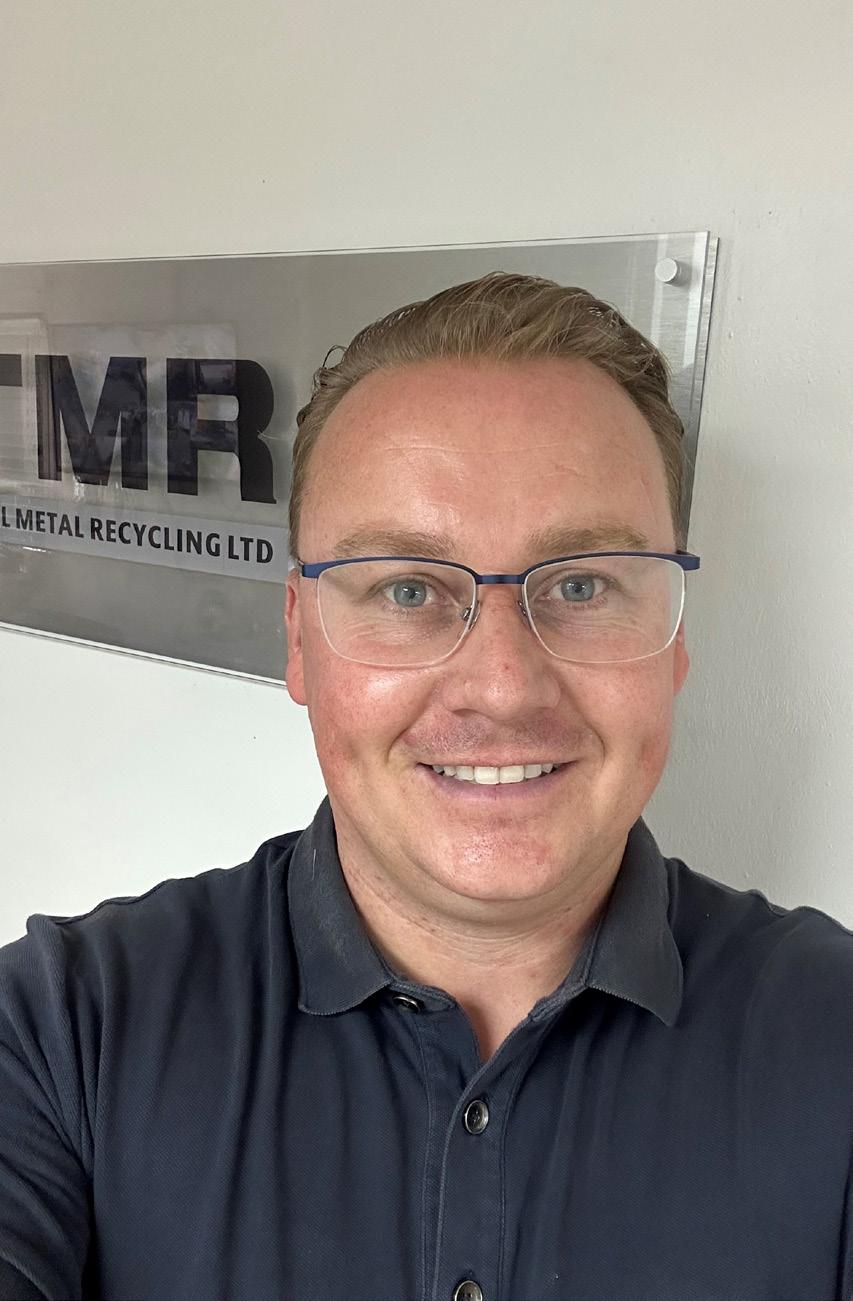
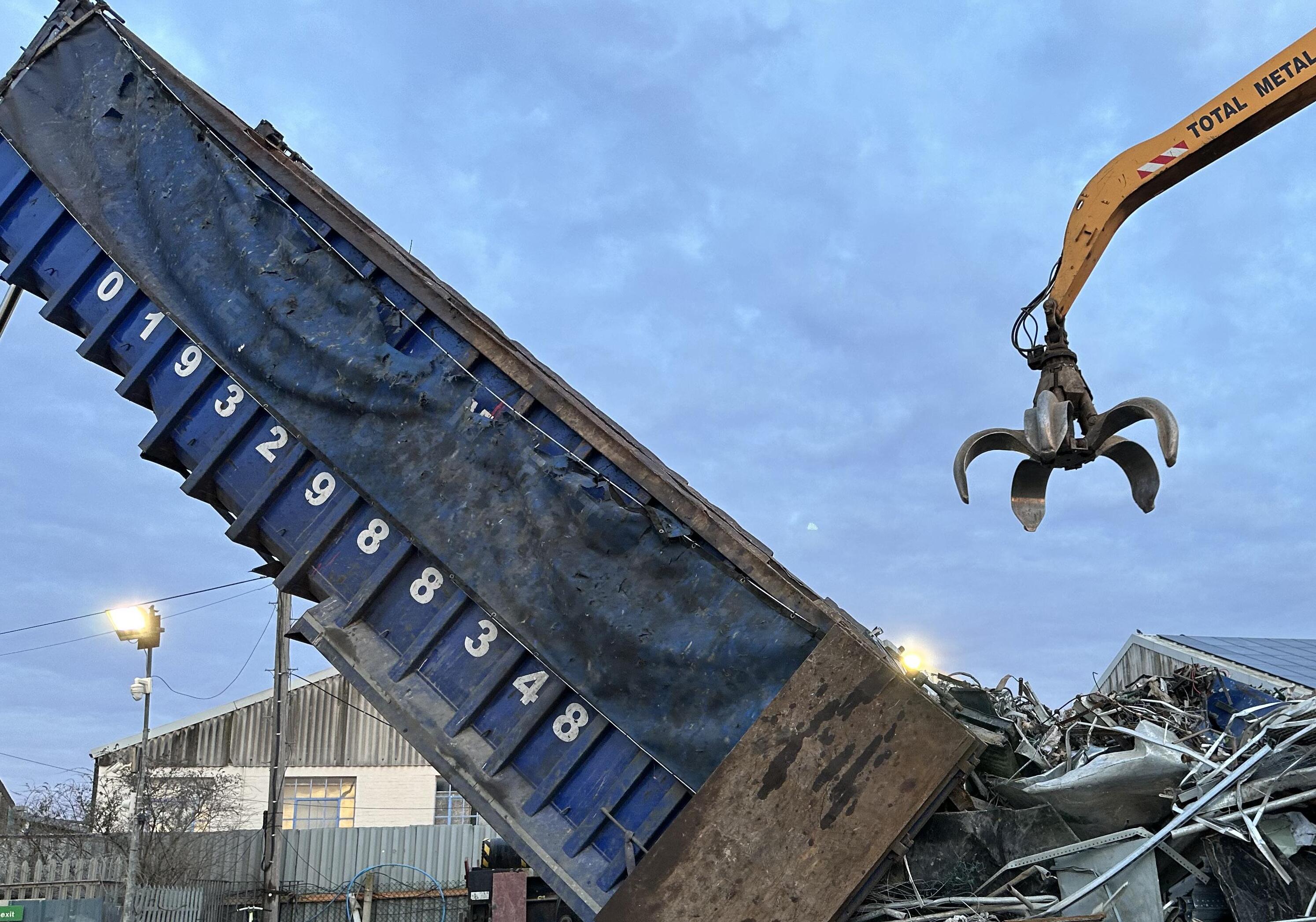
QTell me how TMR started
As a young lad, I was brought up in and around yards and scrapyards. My dad and my grandad were involved in demolition, aggregates and were suppliers of turf, topsoils and crushed concrete. The aggregates and concrete would go back to their depot at the Waltonon-Thames site and farms across the south of the UK, which was mainly to do with growing and cutting turf.
At weekends or if I had a day off from school, I’d be straight down the yard to help my dad and grandad. I always had a passion in recycling of some sort, but didn’t realise I’d fall into the scrap metal industry as much as I did until I got to the age of being able to pass my driving test. My dad gave me a Transit tipper and told me that it was my job to tidy up the yard and any bits of scrap metal that I found would be weekend spending money.
When I was 18, I passed my
seven-and-a-half-tonne HGV Licence, then passed the class 1 and 2 test at 21. I started driving and buying bigger trucks so more scrap could be loaded and transported. I would travel to local scrapyards to sell the metals. I then thought, we have the yards, we have the space, I want to know how to start a scrapyard, I had a passion for it. I wanted to know how the process works, how it ends up in shipping containers, vessels, where it goes, where it gets melted down, how I trade on the London Metal Exchange, and the metallurgy process of producing steel and new aluminium. I began exploring different parts of the world, meeting various companies that where interested in importing metals from the UK.
QSo where does all your metal end up?
All over the world. Unfortunately, most of our metal doesn’t stay in the UK. England used to make the
DemolitionHub.com 80 | DemolitionHUB Magazine interview
Ben Chambers speaks to Nathan Pidgley of Total Metal Recycling Ltd
best quality steel, Sheffield steel for example. It got to the stage where Sheffield steel was producing new steel for an example of £100 per tonne, and manufacturers could buy it in India or China much cheaper. This is such a shame because we’d love to keep as much metal as we can in our country to increase economy growth, create more jobs and manufacturing, but unfortunately it’s just not the case anymore.
We follow international markets, global economies to decide what destinations the metals may head and how are we going to process it ready to be remelted. We use large metal shredders for lighter ferrous and non ferrous metals, large shears to cut up RSJs into two or three-foot lengths and load it into shipping containers and vessels. Our in-house trading and logistics team organises the sales, transportation and export documentation of the processed scrap to destinations around the globe.

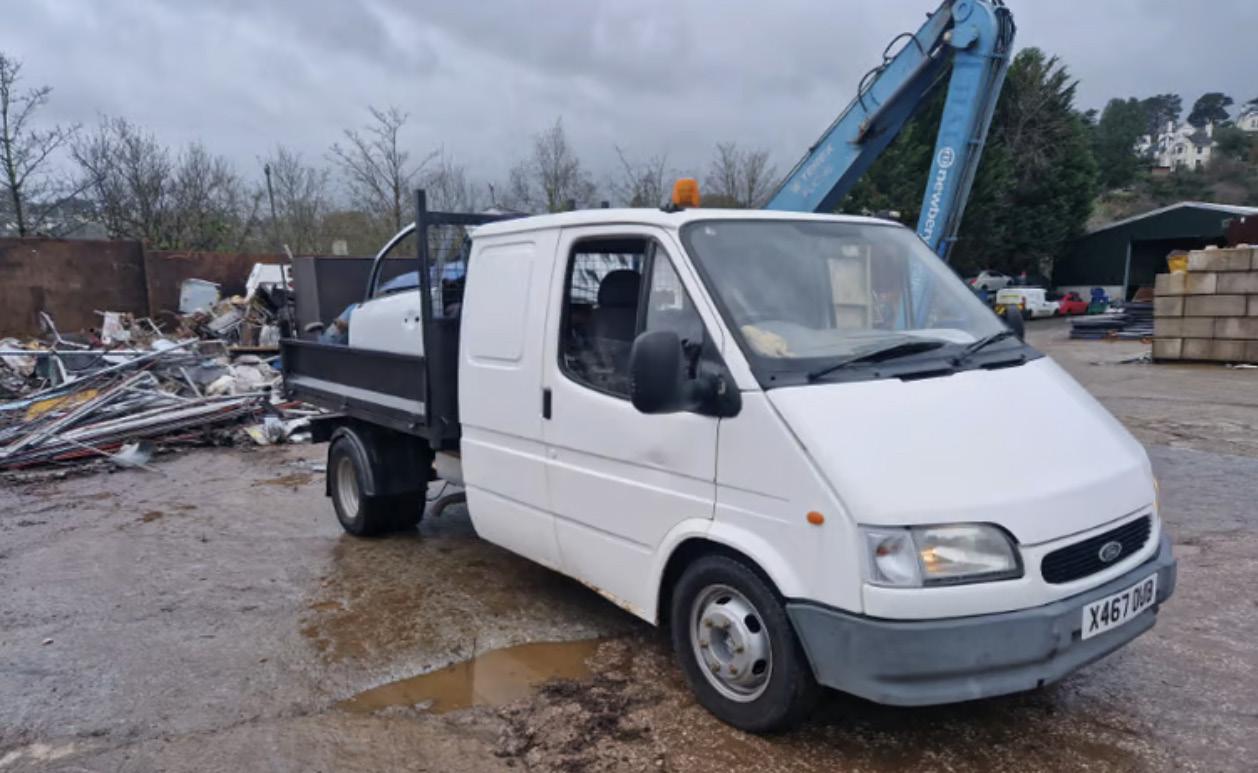

interview DemolitionHub.com DemolitionHUB Magazine | 81
QWho deals with the negotiations and contracts?
I’m very hands on with that, I have a lot of contacts throughout the world that we deal with, mostly with steelworks, mills or foundries. What we find within the metal industry, they always like to deal with the boss. TMR employs a large team of metal buyers and traders and on most occasions the buyers ask “Can we speak to Nathan?” I am a dealer, I always deal fairly with everyone, I make sure the customer and clients always goes away happy. You’re not leaving this yard until everyone is happy. I use the old school morals and values, with a modern twist, I get it from my dad and grandad. It’s all down to a handshake, I’m a man of my word. A deal is a deal.
That is probably the biggest aspect within our industry, is keeping our word, making sure you stick to the deal you agreed and pay up on time.
QDo you think it’s the personal touch, they’d rather deal with you than more faceless corporations?
Yes, and with demolition contractors you often see the older generation floating around somewhere either on the sites or offices, they may have started their company 50 years ago. My grandad passed away two years ago at the age of 93, he was regularly seen out in the yards, still trying to have a deal with someone. He’d retired 25 years ago but demolition contractors still contacted him to discuss the new job they have just won. We find in our company they like to go to the boss. It’s hands on and we make it as easy and stress free as possible, just get the job done and make sure they’re getting paid the competitive market prices.
TMR offers that personal touch as we are a smaller, family run, modern company. Using the latest technology, new fleet of trucks, compliant plant and machinery, and old school values. We specialise with making prompt decisions, finding instant solutions, and running a tight ship.

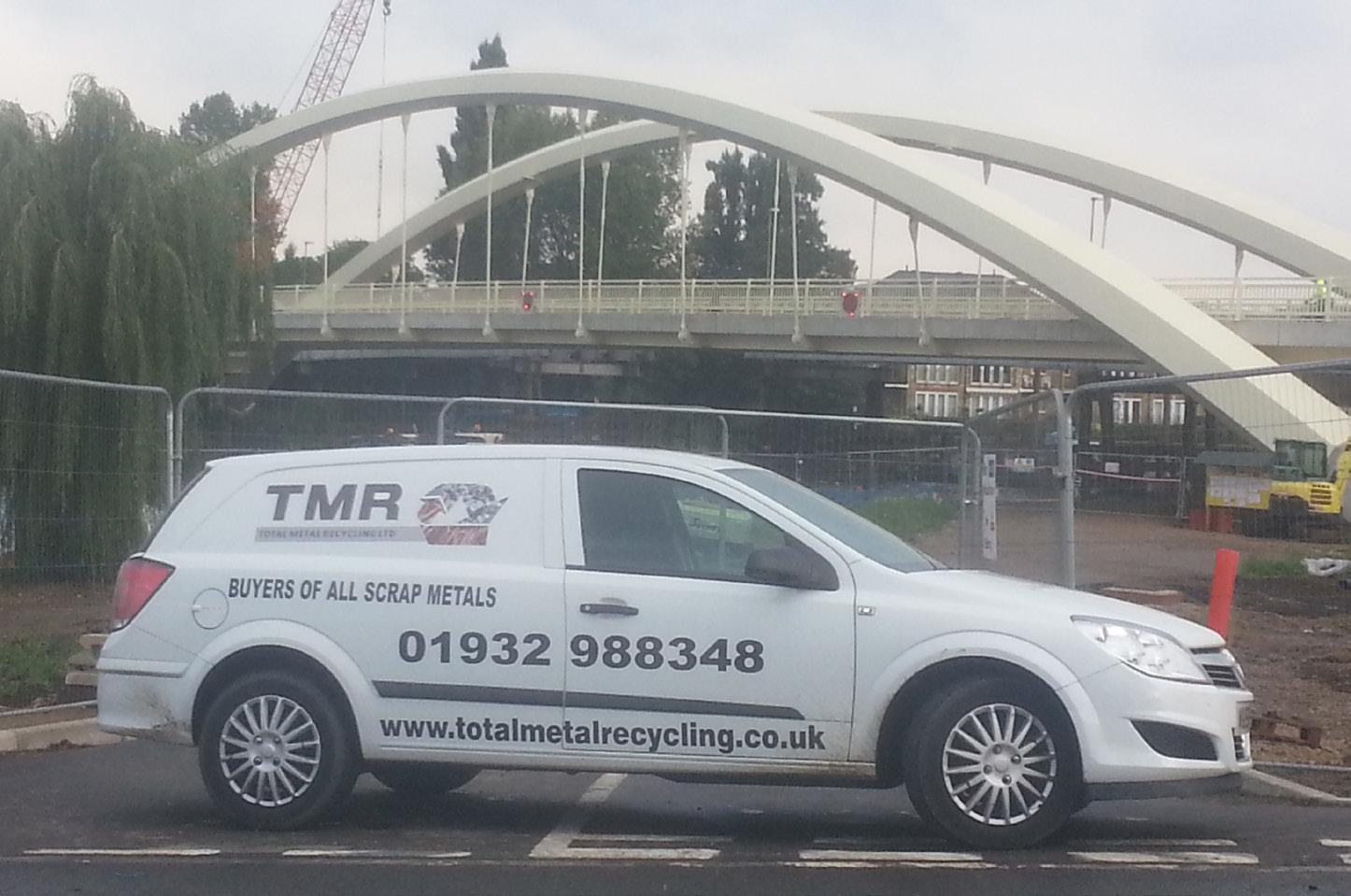
QSo that’s your USP?
Yes; and no disrespect to the large multinational companies, the owners and higher management struggle to go out and meet, negotiate or offer the personal touch. It’s a different level that have lots of pros and cons. Unfortunately, the cons of going to their level is that they lose that personal touch. That’s where smaller companies like TMR gain.
QDemolition clients make up a large proportion of what you do and they are as you alluded, generational. Family businesses like Colemans, they are on third or fourth generation. Who do you work with?
We have dealt with many demolition companies, local and national over the past 11 years of trading. One of our first projects when we was just six months old was the demolition of Walton Bridge. The demolition contractors Armac Group removed the two old bridges crossing the Thames, selling TMR around 2,000 tonnes of premium steel. Providing bulkers, skips and roll on off bins, the scrap was quickly removed from site followed by prompt payments. TMR are proud to have supplied and honoured our services to most NFDC members.
QYou are well placed here. You have Hampshire, London…
Yes, this depot [Guildford] deals with southern regions and Walton-onThames is 12 miles from the City so that’s our feed out of London. Our trucks go up to the Midlands and cover that area, but we are not quite national yet. We do have firms that we work closely with, say someone is doing a job in Newcastle and asks us to recommend a decent scrap yard, I’ll get them in touch with someone or they will collect the scrap on my behalf. It works and there’s enough metal and demolition projects out there for everyone. I’m on the membership and communications board of The British Metals Recycling Association, so I know most metal recycling yards across the country.
DemolitionHub.com 82 | DemolitionHUB Magazine interview
In a league of your own
There’s nothing like watching a master at work — through years of dedication your tools become an extension of your hands. With bold vision and the right equipment, you turn every job into a masterpiece.

NOTICE: ALWAYS FOLLOW WARNINGS AND INSTRUCTIONS PROVIDED BY THE MANUFACTURER. FOR MORE DETAILS VISIT WWW.BOBCAT.COM
QYou are probably one of the few people that posts more than I do on LinkedIn. What is your marketing strategy?
As an established but young, modern company, we love social media. It’s a great way for demolition contractors, waste management and metal producing companies to see what great services TMR has to offer. We deal with most local companies in the southern region, but there are a lot of firms that are not in this region but work within London and surrounding counties. We may never have heard of them or us, they are travelling down south to work on a project, and it’s those contractors that we want to recognise TMR as a reputable, local metal recycling company and that we offer great recommended facilities.
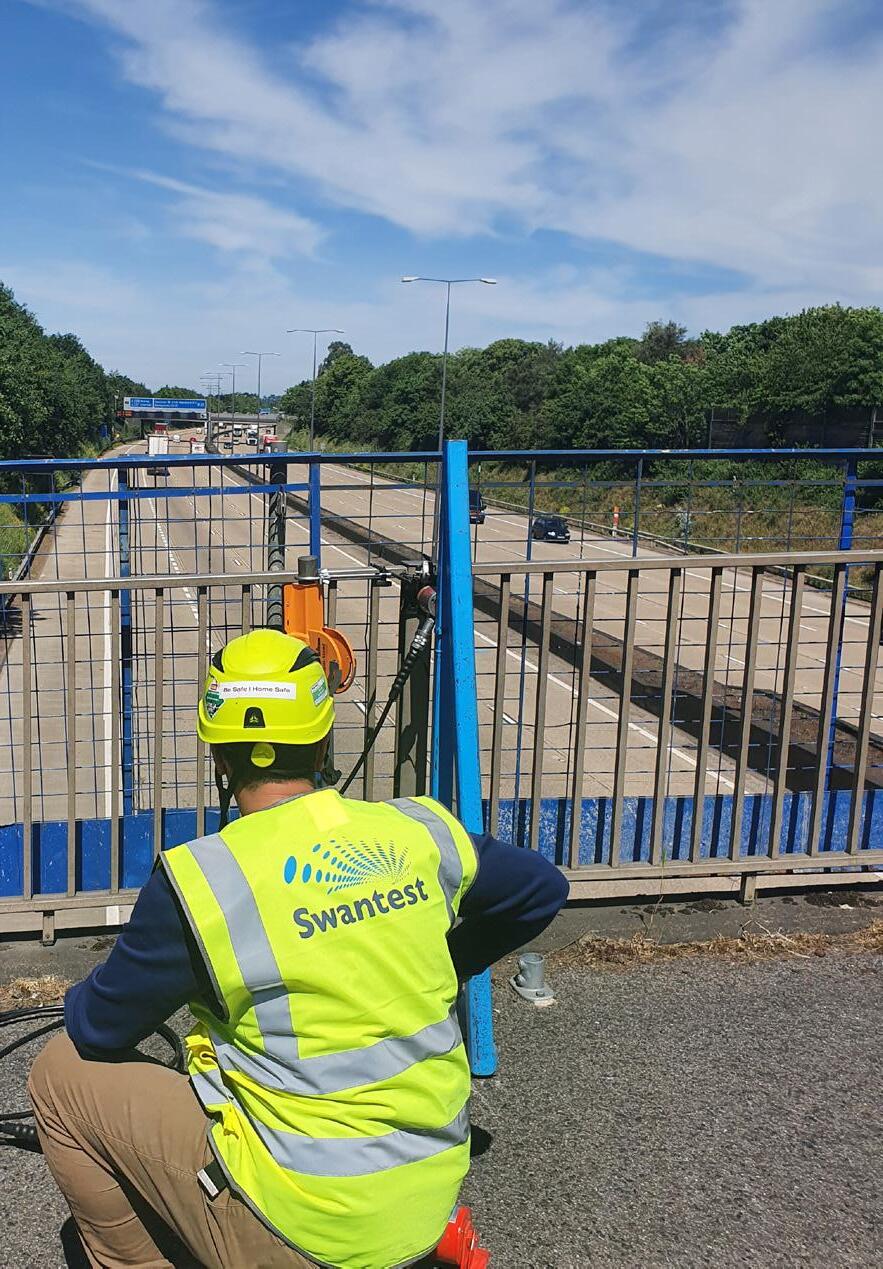

QYou are a very personable guy. How do you approach a new contractor for the first time?

I always make time to meet everyone. Even if business is not generated after that meeting at least you can put a face to a name and I have shown I am interested and respectful. I’ve a lot of respect
for people that just turn up and go out of their way to visit me even when on that occasion, no business may have been accomplished. Something may come up in the future so I’ll phone that person first and give them an opportunity.
I believe going to visit someone, putting a face to a name, having a cup of tea, talking about old stories and my passion with old lorries, then completing with a handshake is the best start. It’s the old-fashioned way and the best way.
QSo not the biggest yard in the world but very impressive. How are you poised for further growth?
Yes, we are constantly expanding. At our Walton-on-Thames depot we have a lot more processing and storage areas, places to stockpile and as we move forward, we are always looking for more depots to open up other facilities. We have access to our dockside facility where will be able to load up to five or six thousand tonnes of scrap on to vessels for global markets. Expanding this quay to accommodate larger vessels for further destinations is our current project.
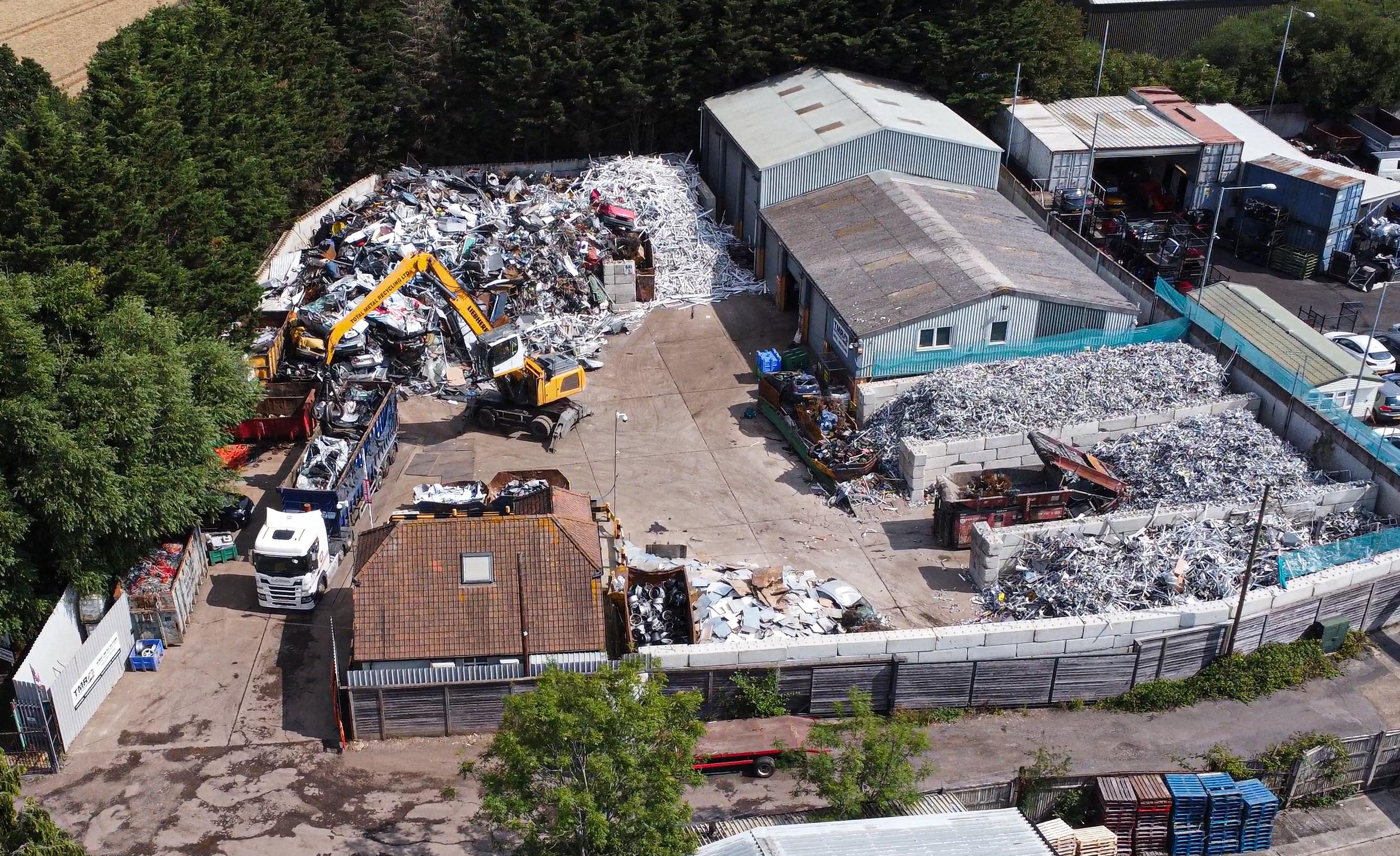
DemolitionHub.com 84 | DemolitionHUB Magazine interview
Structural Testing
Swantest can provide a wide range of test solutions for all aspects of a project. This can include structural tests on the superstructure, substructure and geotechnical tests on the substrate of any project. Our range of structural tests include:







Load Capacity Tests: Used for determining the load capacity of various structures, fixings and materials. We can load test structural slabs, marine structures, lift beams, pile foundations and more.
Anchor Tests: We can carry out pull tests and shear tests on all types of bolts, fixings and fasteners. From small fixings supporting a few kilograms up to large diameter bolts supporting significant loads.
Geotechnical Tests: In-situ site tests for verifying pile mats, formation layers, subgrades and other materials. These include; Plate bearing tests, CBR tests, shear vane tests, dynamic cone penetrometer test and light drop weight tests.
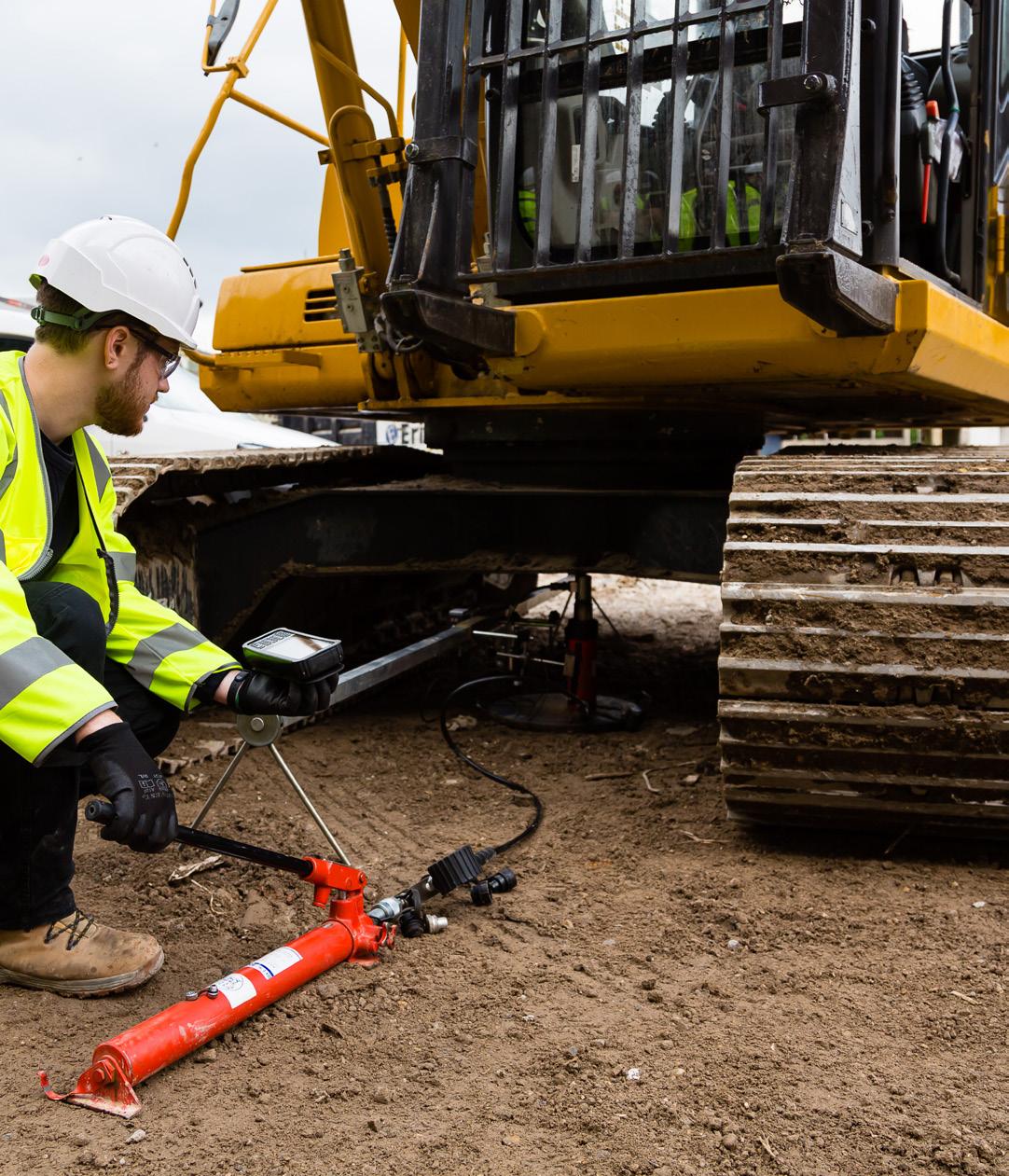


Balcony and Barrier Tests: Various types of horizontal load tests to check and verify the safe use of; Balcony handrails, balustrades, insert panels, sports ground barriers, bridge parapets, edge protection systems and more.


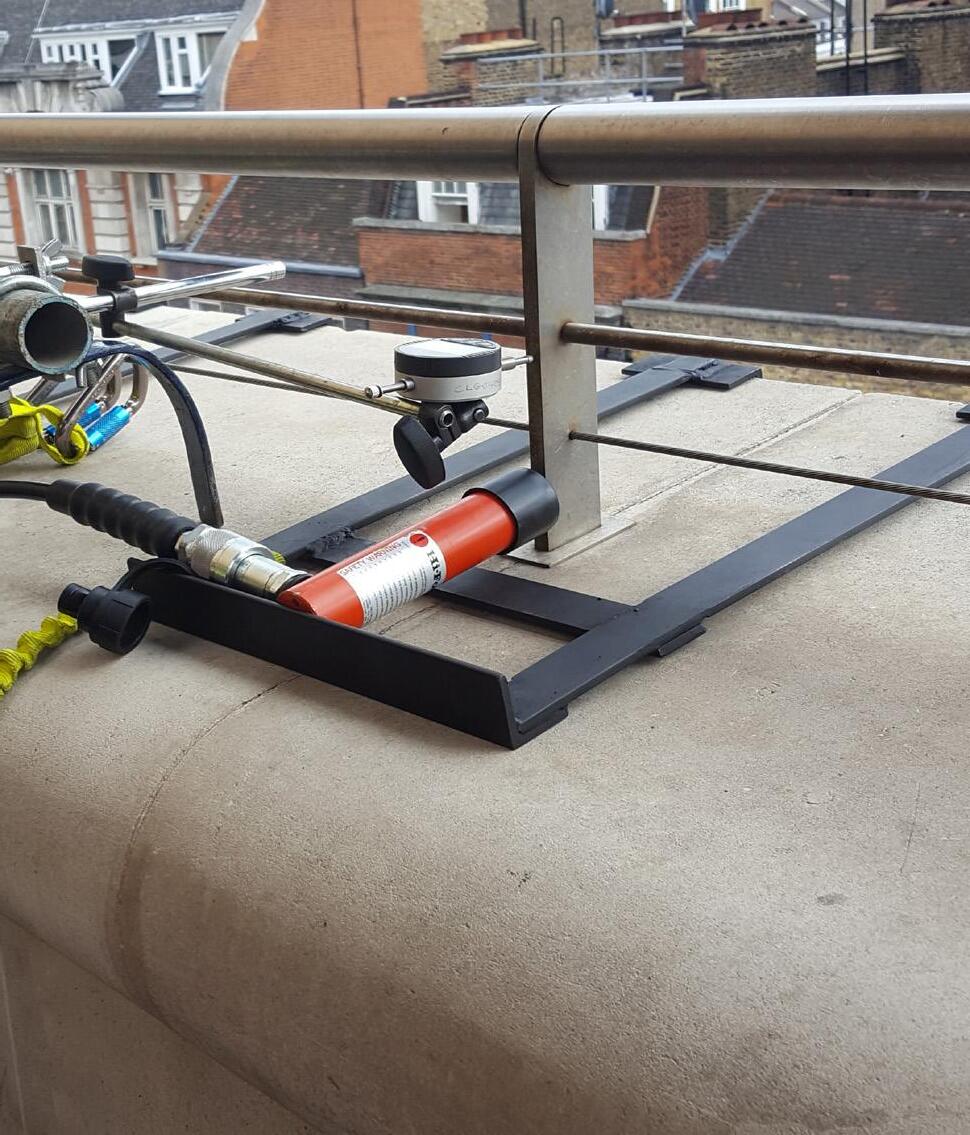
For more information call us on 0370 950 7707 Website: www.swantest.co.uk Email: info@swantest.co.uk 52-54 St. John Street, Farringdon, London, EC1M 4HF


QTell us about your equipment. What do you have and how old is it?
Our multi-million-pound investment programme is currently in the process of upgrading all our scrap handlers. The first two are being delivered this week to our Walton-on-Thames yard. We are trying Fuchs 350 material handlers supplied by Blue Group. We usually use Liebherr, but their lead times are still long. Fuchs and Liebherr are both great machines and offer brilliant after care services. Earlier this year we bought another new Trax Lefort Baler Shear, which has 900-tonne shear force, processing around 250 tonnes per day. Our shredder is next to be replaced and upgraded to a larger hammer mill shredder for larger volumes of scrap. Keep your eyes posted on our social media at the end of the year when this gets delivered.


TMR operates a large fleet of Scania trucks, we upgrade all our trucks when they reach three years of age. TMR thrives on image, reliability and meeting the latest emission standards for all of our assets.
The environment we work in is harsh, it’s not like handling paper or light rubbish, it’s metal on metal so it takes its toll on the machines, but we have very good maintenance and services contracts, for instance, every 500 hours the machines are inspected and serviced. When something is not working or not running correctly, the warranties and maintenance contracts repair or replace components quickly, keeping our sites running as smoothly as possible.
Most processed metals are loaded into shipping containers and vessels. This machine is an inverter – it comes on a container truck and tips it 90 degrees vertically. The material here is short and dense, the steel gets compacted and we cut it in a short shear, then loaded into shipping containers.
For non ferrous metals testing we use Niton analyser guns.
interview DemolitionHub.com 86 | DemolitionHUB Magazine
This tells us exactly what grade it is, percentages and impurities so we know exactly what we are purchasing.
QYou are a proud ISP member of the NFDC, you use its logo everywhere. What does the NFDC bring to you and are you involved in their events?
Yes. We attend all NFDC events and look forward to networking and meeting new and existing suppliers. We find being an ISP member of this great association, customers know we all go through strict due diligence, provide a sustainable honest and trustworthy service, while working closely with other members of the association. We all work as one big team.
QIt holds a lot of weight, doesn’t it?
Yes, it’s the same with the BMRA. We get involved a lot, we meet regularly for industry discussions and attend AGMs and various events. The associations respect you for your input and involvement, to create a better future for our industries.
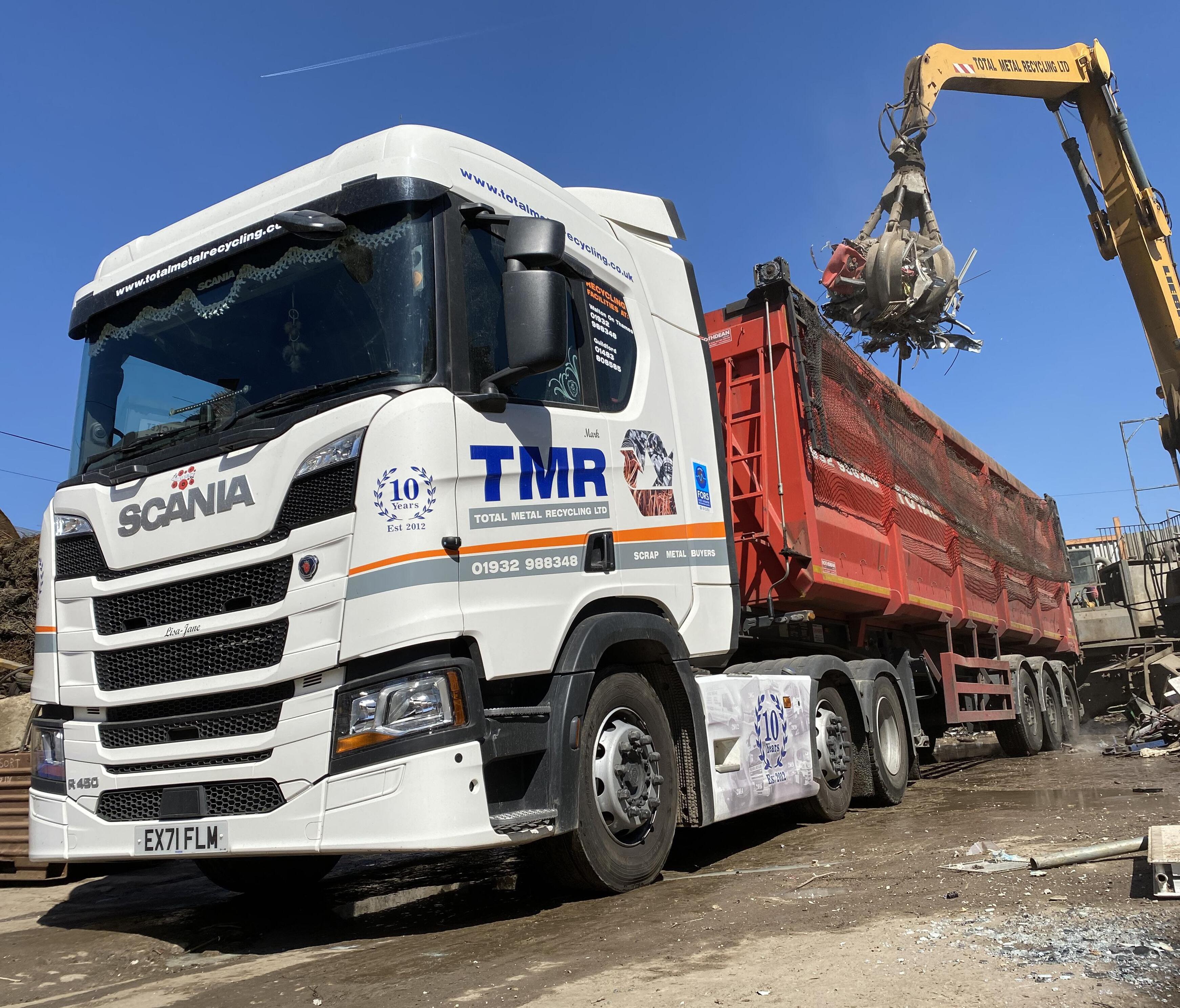
We are also members of the BIR, The Bureau of International Recycling. The conference was held in Amsterdam this year. There were about 1,700 attendees in Amsterdam having a great time networking and socialising. Good for creating new business, buying, selling and trading material between companies around the globe.
TMR are honoured to be part of these incredible associations, as
some companies will not be take you seriously unless you belong to them. We build very strong relationships in business and also lifelong friendships.
QTell us about how the family functions in business
My life involves around scrap metal, my wife and five children. As a family we are all fascinated by the scrap metal and demolition industries. We drive each other to success, support and appreciate our achievements and goals. My dad and sister are very close to me, we are from a hard working background that continues to progress, adapt and maintain sustainable development for our industries.
interview DemolitionHUB Magazine | 87


Case study
Title: X Tampa

Structure: School and church
Contractor: Milburn Demolition


Client: Kast Construction
Location: Tampa, Florida
Start date: 23/02/2022
Completion date: 02/06/2023
Techniques: Urban demolition and renovation with stabilisation, shoring, bracing, saw cutting, vibration monitoring and planning
Future use: Large apartment building and parking garage. The church and belltower will become an event centre
Magazine | 89
case study
Preserving history
All too often, new development in historic urban centres comes with the loss of another part of history. Going against that grain, The X Company and KAST Construction laid out a significant challenge with the vision of bringing some of that history back to life. It fell to Milburn Demolition to make that vision a reality.
The vision was a structurally and architecturally restored 101-year-old Spanish revival church, brought back to life, and ready to be incorporated into a large high-rise mixed-use development in the heart of the central business district in Tampa, Florida. The reality at the outset


of this ambitious project was far different. There stood a derelict block full of dilapidated buildings and stagnant overgrowth. At the heart of the block was the church – tired, sometimes a home to vagrants, but still standing.
Constructed of unreinforced terracotta brick, heavy timber, and concrete, the church had seen a great deal in its years. Over its lifetime, it saw the addition of an MP Möller pipe organ, made by the same prolific organ builder responsible for the famous Mighty Mo of the Fox Theater in Atlanta, Georgia and critically the addition of a three-storey cast in place addition
in 1954, which housed a Sunday school. Over the years, neglect and disrepair had taken their toll and by the time our work started, the building was literally crumbling.
Work began swiftly. Milburn assembled a team made up of its selective demolition experts, the best designers and specialists in historic preservation, and a sophisticated system of sensors that constantly monitored movement as minute as thermal expansion due to sunlight throughout the work.

The team shored and braced the full 29-m structure, braced other sensitive components and the surgery began. Prior to separating the Sunday school addition while preserving the original church, the belltower had to be structurally restored and enhanced. The tower was a project of its own. The ornate decorative balustrade had all but vanished, with only some select components still intact. The heavy timber decks had rotted and failed and the remaining wood had become home for termites. The concrete at the top of the tower where the bells were first hung had blown out and failed.
The rotten wood was replaced with steel sprayed matt black to emulate anticorrosion coatings of the period and the decorative crown of the tower was fully restored by taking select samples of remaining components to the ground and using the best of each component as a template to recreate these features as they were first made, all by hand. Finally, a new copper clad dome was constructed and placed, based on the original ink-drawn
90 | DemolitionHUB Magazine DemolitionHub.com
plans, which were discovered during pre-demolition investigations.
The Sunday school addition was structurally tied to the original church structure in as many as 10 different conditions. A full bay separation was provided using a mixture of remote-controlled saws and recovery equipment working over catch-deck shoring that would capture the slabs as they were cut away from the original structure of the church, preventing them from rotating and causing upheaval within the delicate terracotta structure.
Finally, the facade was stabilised and other structural repairs were made, and there stood the separated and restored church, the result of more than a year of effort in planning, design, permitting, construction and demolition. All of this took place on a site that by the end of the process had some of the largest drilling rigs in the country installing foundations 18 storeys deep mere feet away as KAST began work on the high rise soon to become the church’s new neighbour.
Passers by would comment to the team that their grandparents
had been married in that church, their parents put to rest, and how happy and relieved they were that the church wasn’t levelled for new construction.
Far from the biggest or most expensive part of the development project, bringing back a part of the heart and soul of Tampa and making it ready to stand for another century was the most satisfying.
Client statement:
Historic preservation, selective demolition and work involving archaic structures is more prone to unforeseen challenges, hazards and complication than nearly any other type of construction. KAST was pleased to have selected Milburn Demolition for this task. The X Tampa project is one of the most ambitious undertakings underway in the Tampa Bay area, with its first step being a highly technical selective demolition and restoration project. Throughout the course of our work, we found that even when we encountered significant challenges and points of uncertainty, Milburn Demolition remained


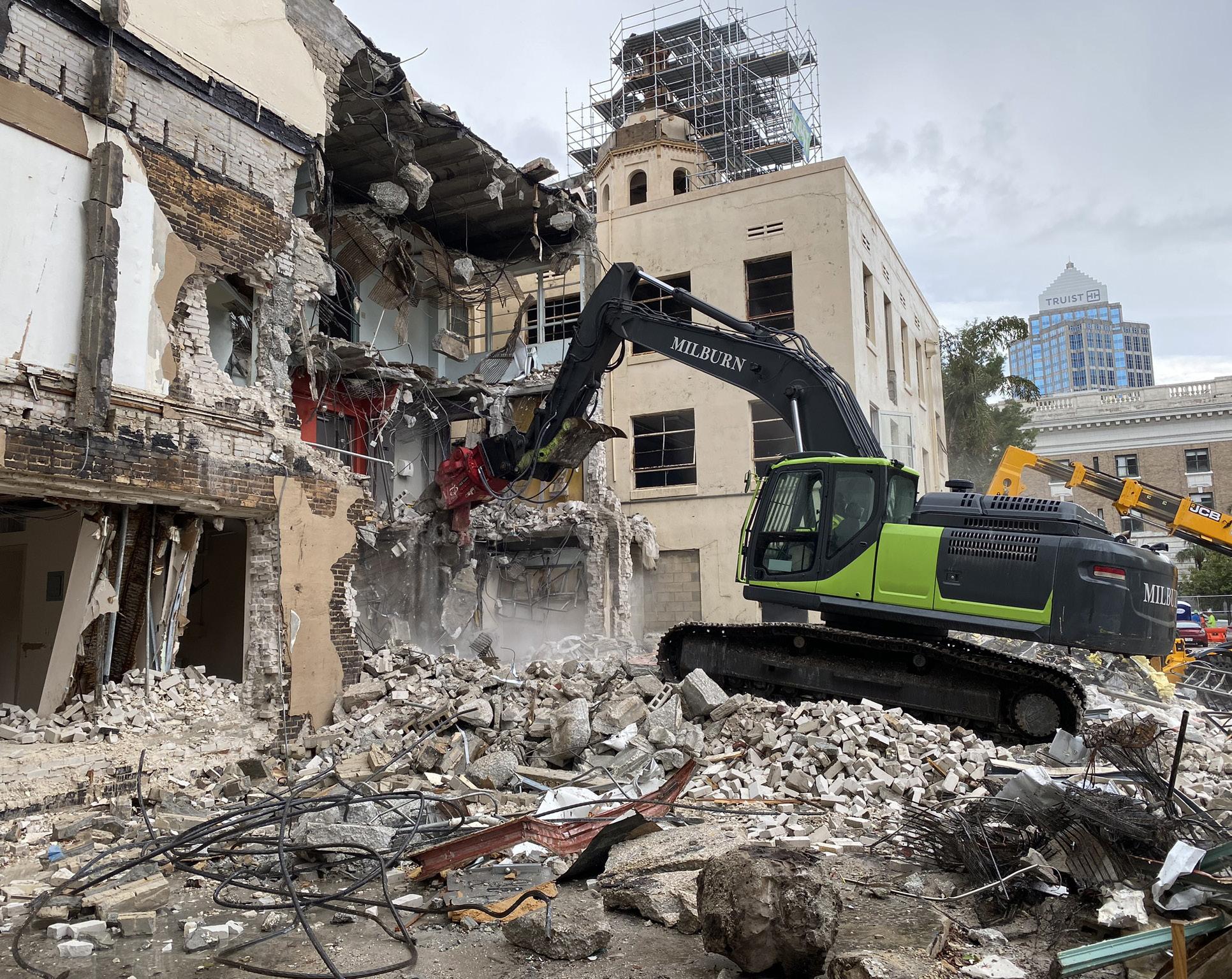
solutions-oriented, took ownership of the issues and demonstrated a passion for what they do.
KAST’s motto is Your Vision, Our Mission. Milburn Demolition was instrumental in ensuring that our client’s vision was brought to life.
If you have a case study you would like to submit for publication in Demolition Hub, please email toby@chambers.media.

case study
DemolitionHUB Magazine | 91 DemolitionHub.com
EXCAVATORS FEATURE DEVELON
DEVELON is now offering a range of three different demolition excavators from 31 to 61 t. All three models have a high visibility, tiltable cab, particularly suited to high reach demolition applications and providing a 30° tilting angle.
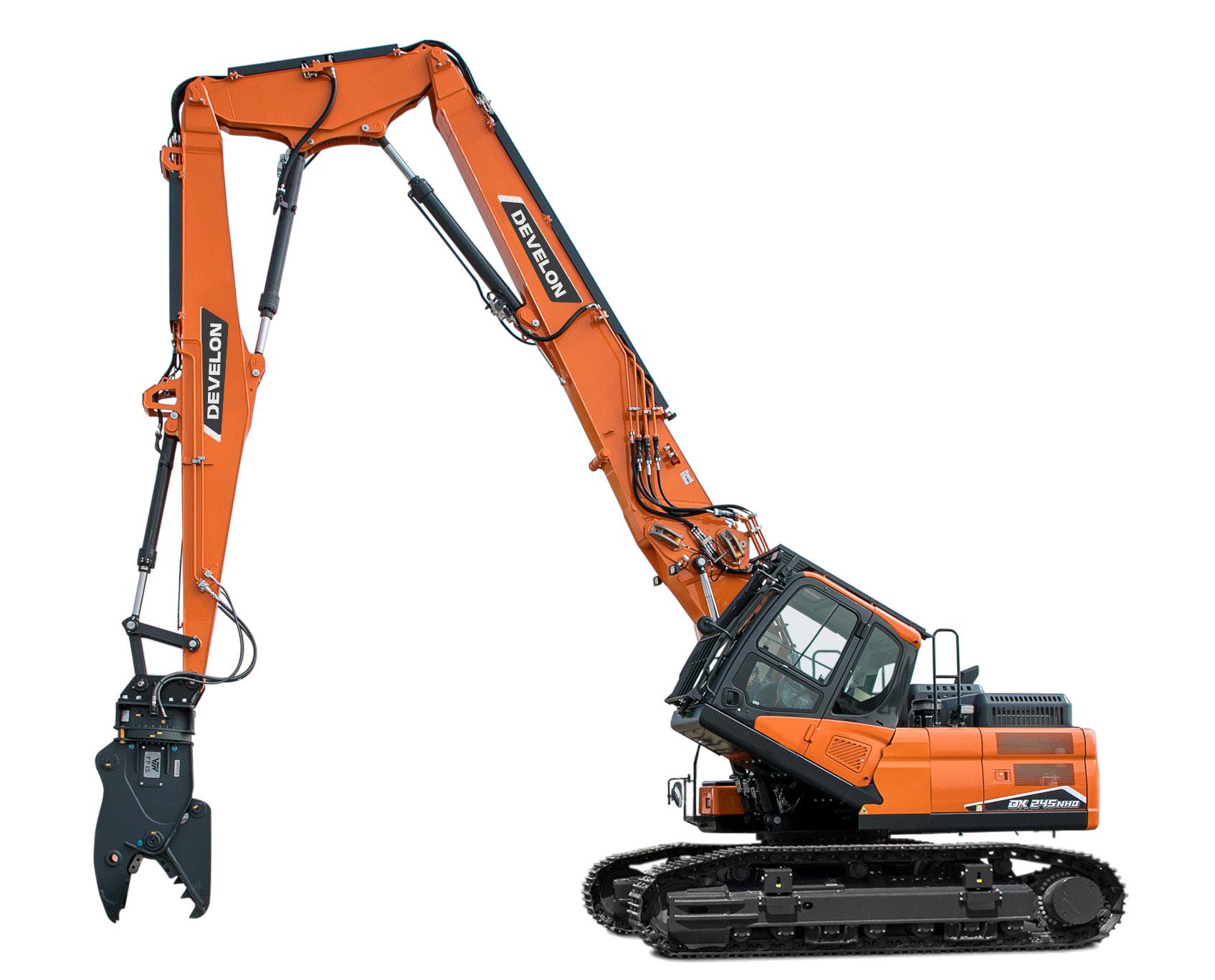
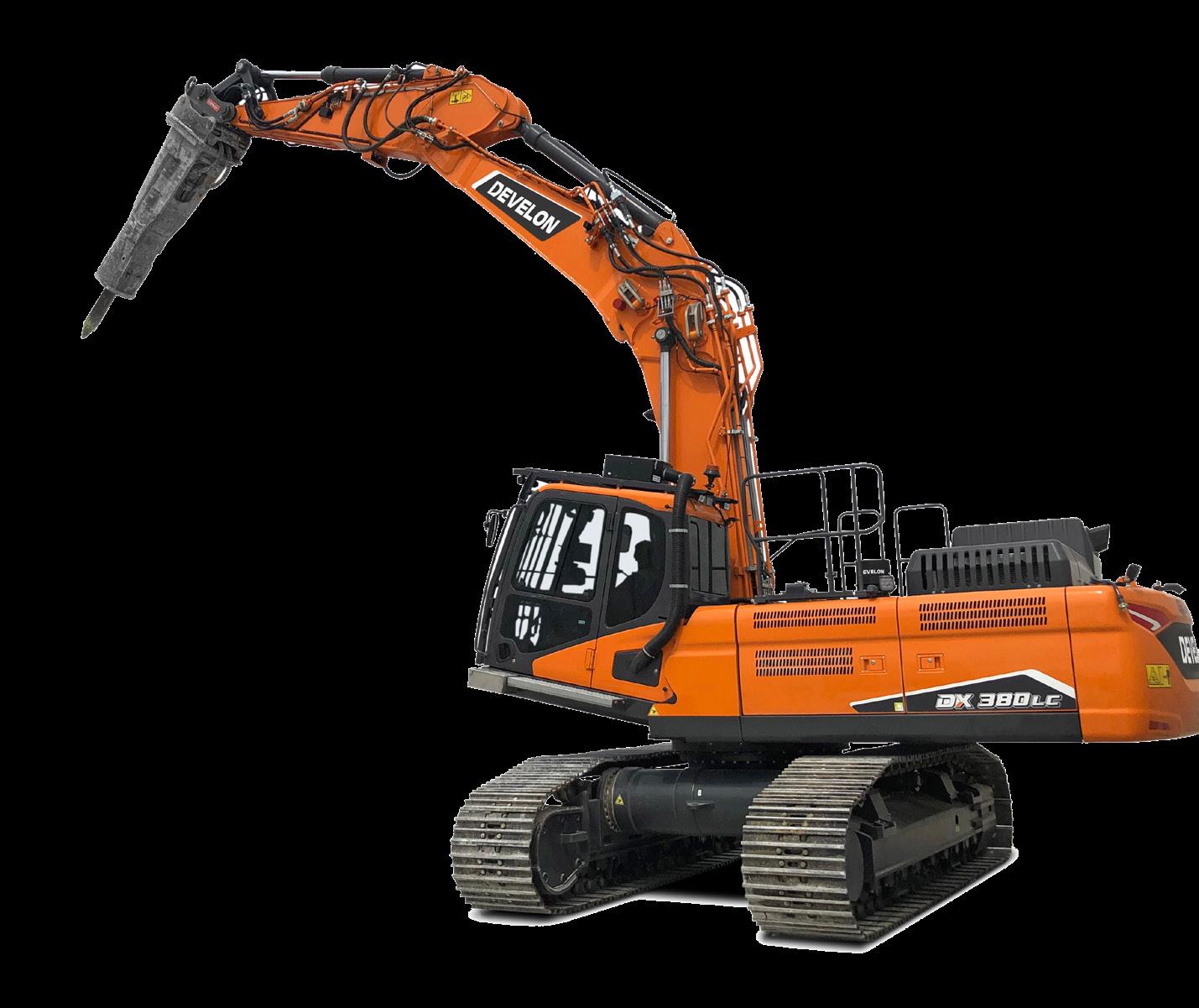

The latest in the range is the new DX245DM-7 31-t High Reach Demolition Excavator, replacing the previous DX235DM-5 model. Powered by the Doosan DL06P Stage V diesel engine providing 129 kW at 1,800 RPM, the DX245DM-7 is now available alongside the heavier 47-t DX380DM-7 and 61-t DX530DM-7 models.
Another key feature common to all the models in the range is a modular boom design and hydraulic lock mechanism on the machine. This provides the customer with a complete, flexible
excavator for other applications on site as well as demolition.
The innovative design ensures it is a simple process to change between a demolition boom and an earthmoving boom to accomplish different types of work on the same project. A special stand is provided to facilitate the boom changing operation, which is based on quickchange hydraulic and mechanical coupler connections. A cylinderbased system is used to push the locking pins into place to help complete the procedure.
Multi-boom design increases
The multi-boom design also allows the earthmoving boom to be mounted in two different ways, which with the demolition boom, provides further flexibility with a total of three different configurations for the same base
As an example, DEVELON’s DX245DM-7 volume model is equipped with the 18-m-long demolition boom, the impressive working range allows the machine to work with a demolition attachment to
a maximum height of 16 m. The recommended maximum combined weight for the attachment and quick coupler in this mode is 2.5 t.
When equipped with the digging boom in the straight configuration, the DX245DM-7 can work to a maximum height of over 9.8 m. In this format, the recommended maximum weight for the attachment and quick coupler is 3.3 t.
Using the digging boom in the alternative bent configuration, the DX245DM-7 can work with an attachment to a maximum height of eight metres. In this mode, the recommended maximum weight for the attachment and quick coupler is 3.3 t.
Hydraulically adjustable undercarriages
One particular advantage of DEVELON’s demolition models and
EXCAVATOR FEATURE 92 | DemolitionHUB Magazine DemolitionHub.com
their features are the adjustable undercarriages built with enhanced durability. The adjustable undercarriages can meet each country’s transportation regulations easily or simply minimise transportation costs, and at the same time, it is possible when on site to expand the undercarriage width to ensure high stability. The undercarriages also have special seals and do not require maintenance throughout their lifetimes. Other advantages include hydraulic pins, couplers that can easily replace the boom/arm for each different type between demolition and digging fronts, and anti-tipping indication and limitation systems configured for customer safety.
It is also important to ensure that various options are provided to meet customer requests, as these are often included in machines sold to demolition companies. DEVELON offers various options such as even customising the colour to match each company’s identity, which increases customer satisfaction. Other options offered by DEVELON include a water spraying system, air compressors, cylinder guards, auto greasing, bulletproof glass, camera kits, reversible fans, track scraper, additional counterweights and so on.
On the DX245DM-7, the hydraulically adjustable
undercarriage extends to a maximum width of 3.74 m to provide optimum stability when working on demolition sites. The width of the undercarriage can be retracted hydraulically to 2.54 m in the narrow width position, which is ideal for transporting the machine. The mechanism is based on a permanently lubricated, internal cylinder design which minimises resistance during the movement and helps to prevent damage to the components.
Impressive demolition specifications
Operating from the high visibility, tiltable cab, the operator has an excellent environment particularly suited to high reach demolition applications, with a 30° tilting angle.
Like all DEVELON demolition excavators, standard safety features include a FOGS cab guard, safety valves for the boom, intermediate boom and arm cylinders and a stability warning system.
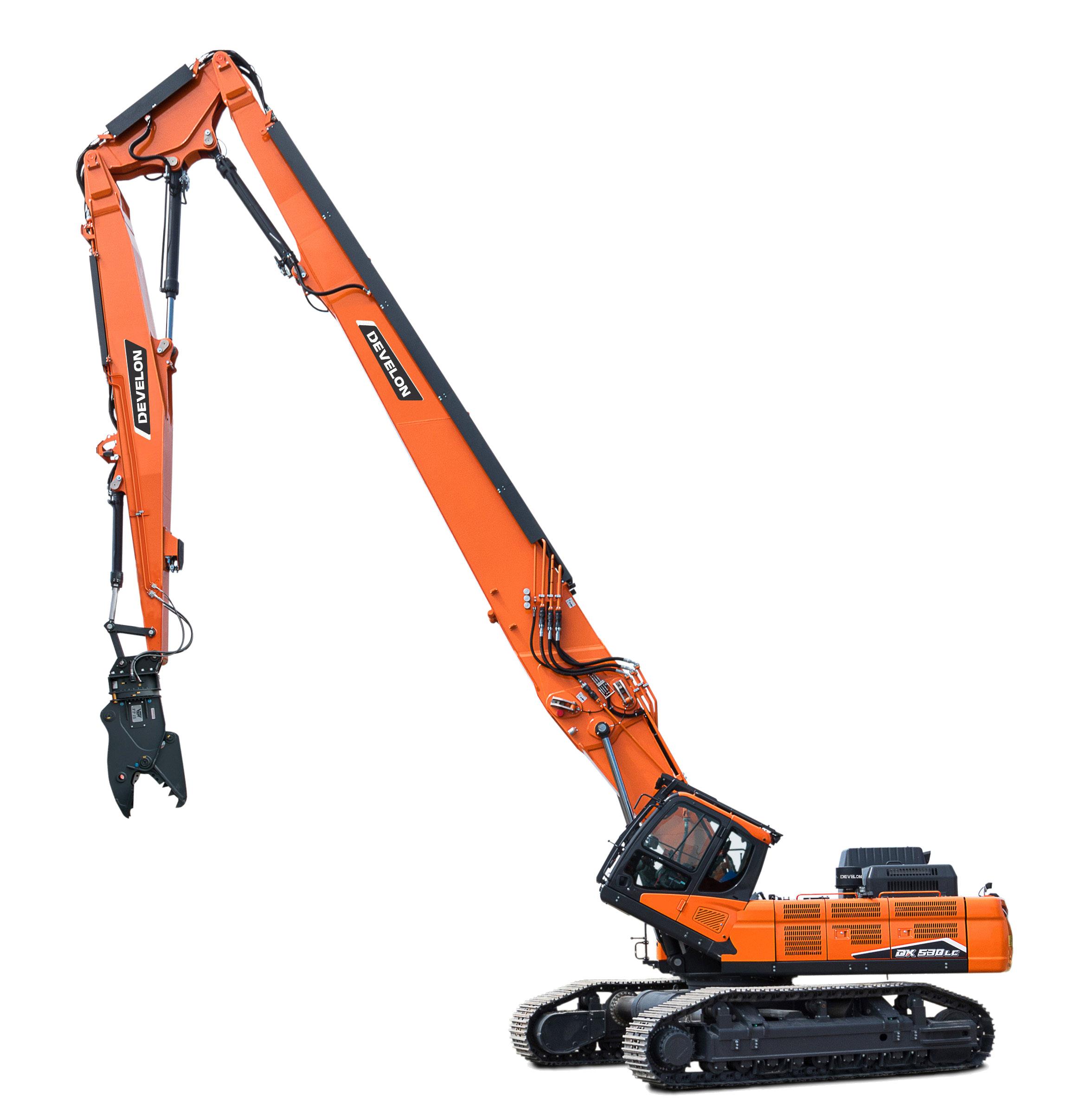
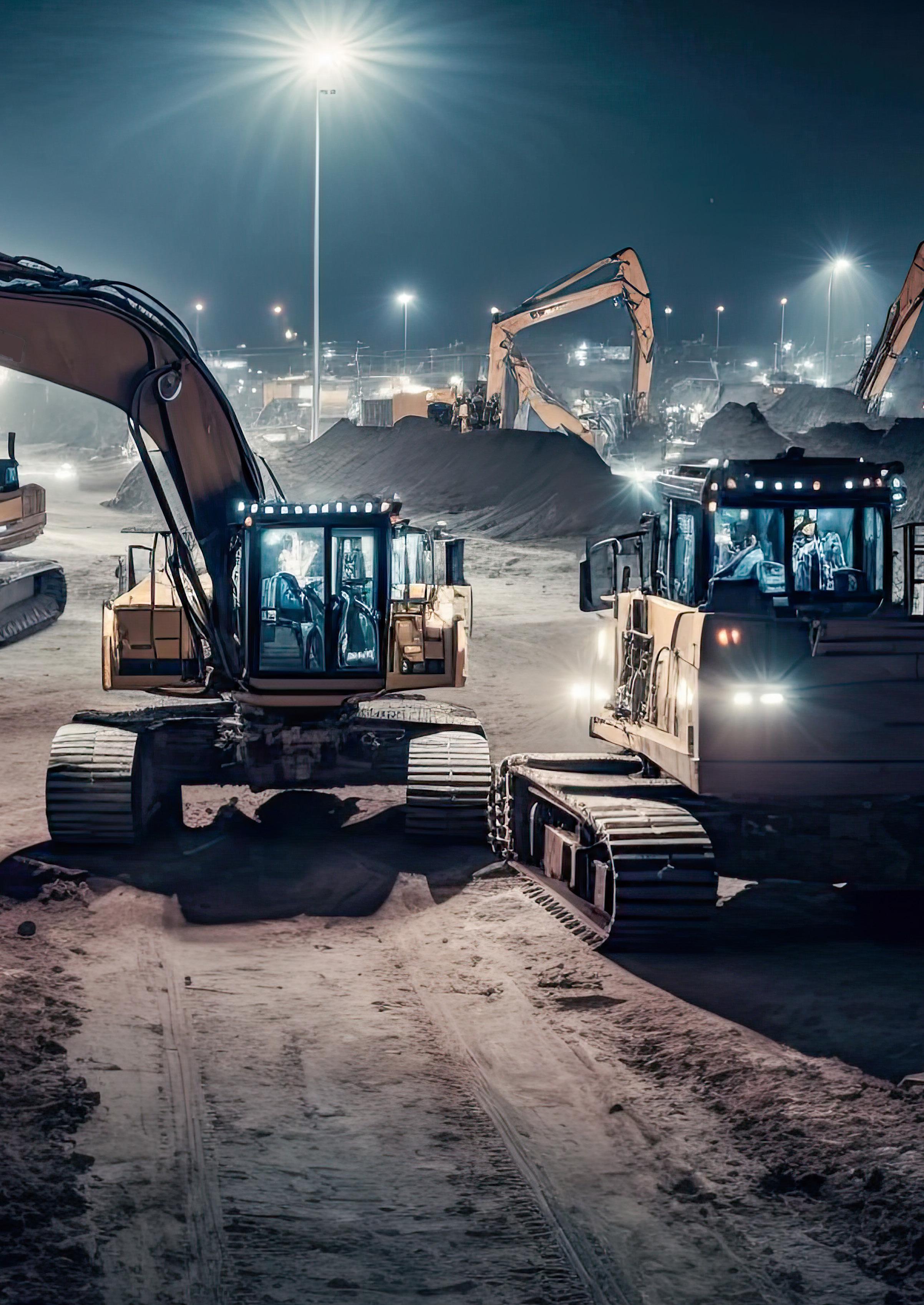
For the future
In the case of demolition machines, a lot of larger sized equipment is used, but DEVELON is also paying attention to responding with more compact machines as well considering the work done in city centres, and a representative model that fits this is the volume model, the DX245DM-7.
In addition, for further work in lower buildings or downtown areas, DEVELON has developed a 14-t demolition machine and is preparing to introduce it to the market soon.
EXCAVATOR
DemolitionHUB Magazine | 93 DemolitionHub.com
FEATURE
DX245DM-7 DX380DM-7 DX530DM-7 Maximum power 129 kW 244 kW 294 kW Operating weight 30.7 t 47.5 t 60.5/70.5 t Max. tool weight 1.8 – 2.0 t 3.0 t 2.6 – 3.0 t Max. height at pin 18 m 23 m 27.5 /31 m Variable undercarriage width 2,540~3,740 mm 2,970~4,370 mm
EXCAVATOR FEATURE
SANY
SANY UK has recently launched two new demolition-spec crawler excavators. The SY215C-XD (24-t) and the SY390H-XD (40-t) tracked excavators are available to order with factory fitted demolition guarding specifically for demolition, waste or other arduous applications.
Designed to meet the demands of the most challenging demolition projects, the machines are equipped with advanced hydraulic systems, reinforced structures and heavy-duty attachments, making them capable of handling even the toughest demolition jobs.

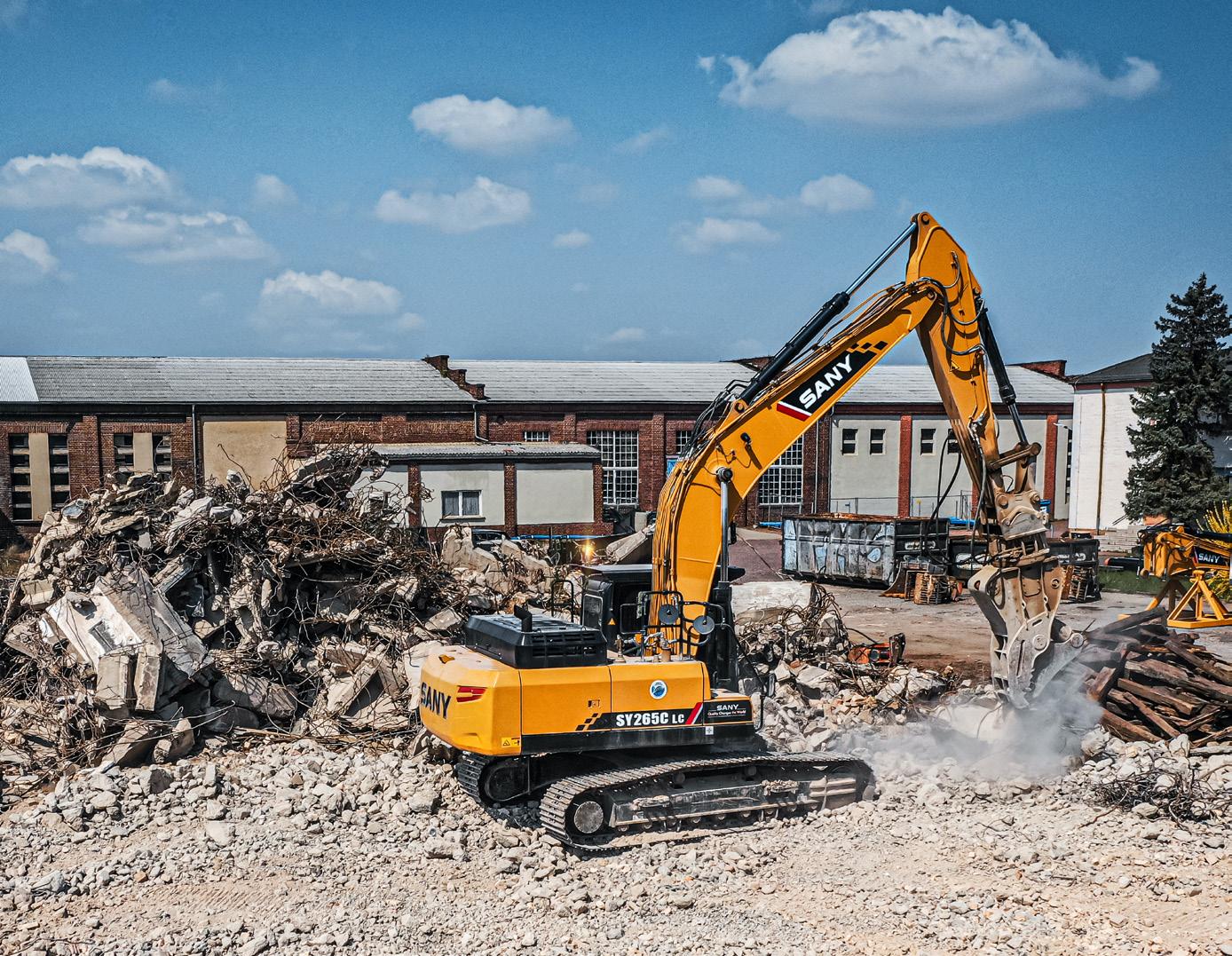

They are equipped with reinforced structures including heavy-duty belly plates, ram guards and side impaction protection to withstand the demands of the demolition industry. They also feature hammer shear and rotate lines and advanced hydraulic systems that enable easy changeover of attachments in line with whatever the application requires.
Joining the SY215C-XD and SY390H-XD in SANY’s range of demolition excavators is the 64-tonne SY500HRD. With its powerful Stage V Cummins engine, wide telescopic chassis and superior reach of 28 m, it’s a versatile demolition machine capable of outstanding stability on the toughest of job sites.
SANY’s range of demolition machines is now available for purchase though SANY’s authorised dealer network and come with an industry leading five-year / 5,000hour warranty for complete piece of mind as well as a comprehensive range of service and support packages.
Demolition modifications to other existing SANY tracked excavators, the SY265C, SY305C and SY500H will follow later this year.
94 | DemolitionHUB Magazine DemolitionHub.com


rcollard.com | info@rcollard.com | 01252 844688 @collardgroupltd
unique capability to repurpose virtually all construction and demolition waste from site helps our public sector, local authority, commercial and residential clients achieve zero-to-landfill targets. Expert solutions for complex projects, nationwide Demolition Land remediation Enabling works Consultancy services Asbestos removal Soft strip
Zero-to-landfill Our
SENNEBOGEN 870 E DEMOLITION
This powerful demolition excavator with three-part long-front equipment is suitable for demanding demolition work at high altitudes and for handling large loads.

Depending on floor height, the SENNEBOGEN 870 demolition machine can safely tear down buildings of between 9 and 10 storeys. Densely built-up areas are where the machine shows off its advantages most, using its demolition shears or grab to grasp building structures with pinpoint accuracy and bringing the pieces safely to the ground.
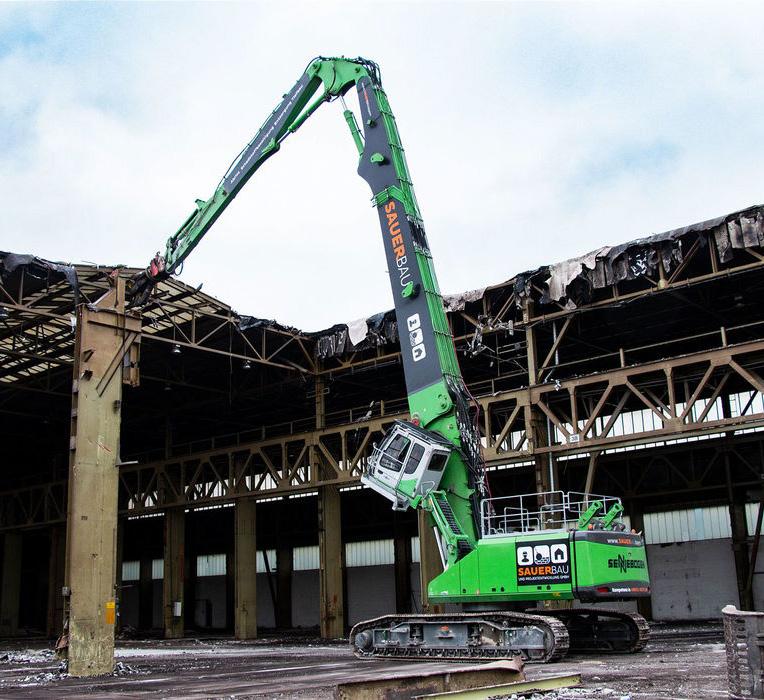



The elevating and tilting cab provides an excellent view over the demolition object and the surrounding area.
Key features:
• Operating weight of 114 to 117 t
• Maximum reach of 33 / 36 m
• 261 kW diesel engine
• Optimised engine, drive and exhaust systems
• Powerful hydraulics including third hydraulic cylinder for attachments of up to 4 t
• Quick-changer available
• Ideal accessibility to the high-quality components enables easy maintenance
• Telescoping crawler undercarriage for low transport width yet high stability in operation
• Solid construction and decades of SENNEBOGEN experience for excellent value retention
• Easy transport in three units: Base machine, demolition equipment and counterweight
• Ballast storage system for low transport weight of base machine
EXCAVATOR FEATURE
96 | DemolitionHUB Magazine DemolitionHub.com
Specialist diamond drilling and sawing
Diamond Drilling
We diamond core drill from 6mm – 1500mm diameter through any depth of floor or wall using electric or hydraulics.
Diamond Cutting
We have a wide range of sawing equipment including Floor, Wire, and Track sawing also including Steel Cutting.
Hand Sawing
Rapid diamond hand sawing cutting up to 700mm deep using hand held water cooled diamond saw blades ensuring a straight and accurate cut every time.

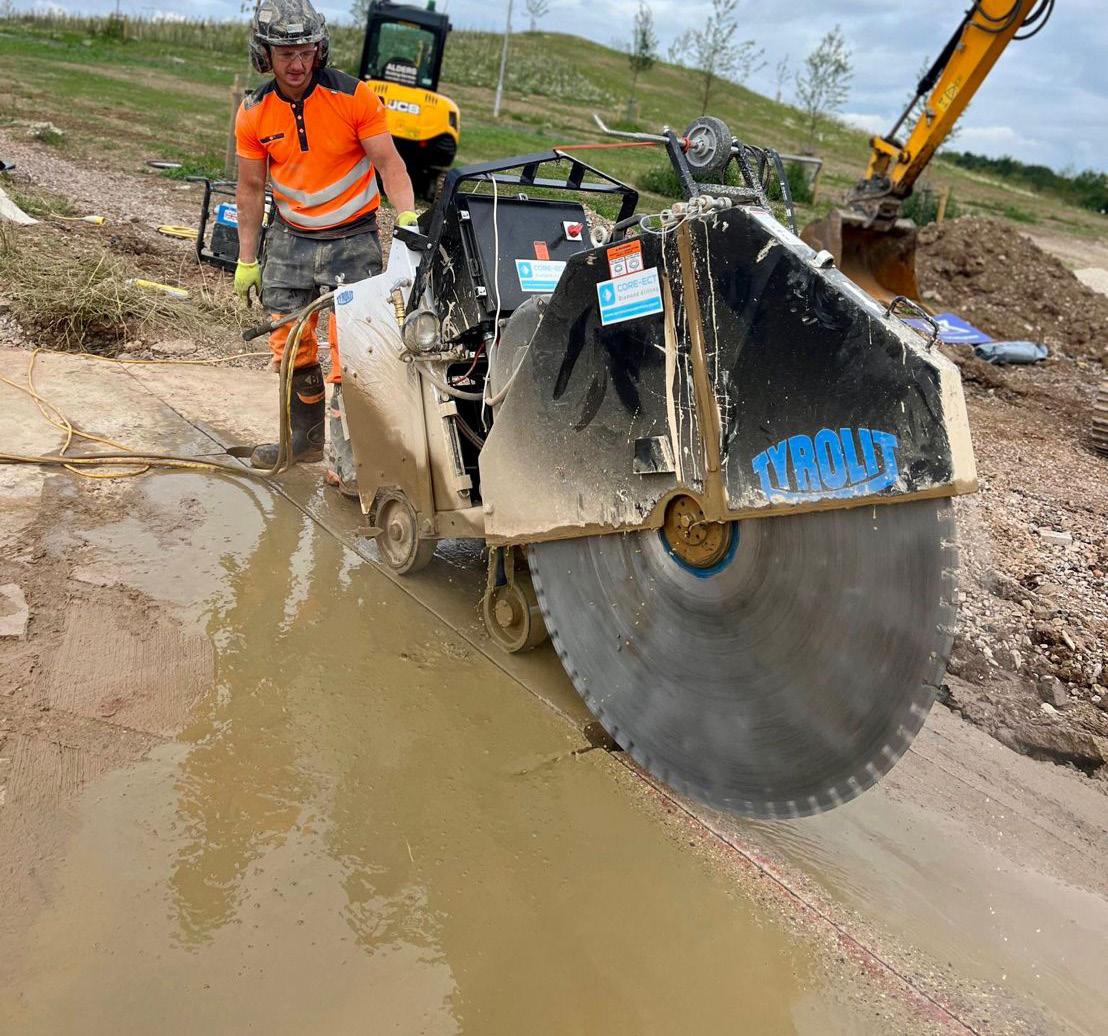
Controlled Demolition
Specialist track mounted Brokk machines can crunch, break & dig in areas where operator driven machines cannot fit. Brokk machines can also fit through standard personnel doors, and climb stairs reaching restricted access areas and confined spaces.
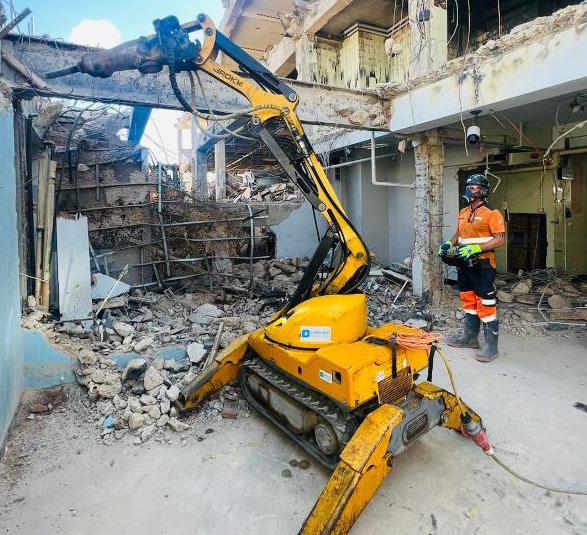
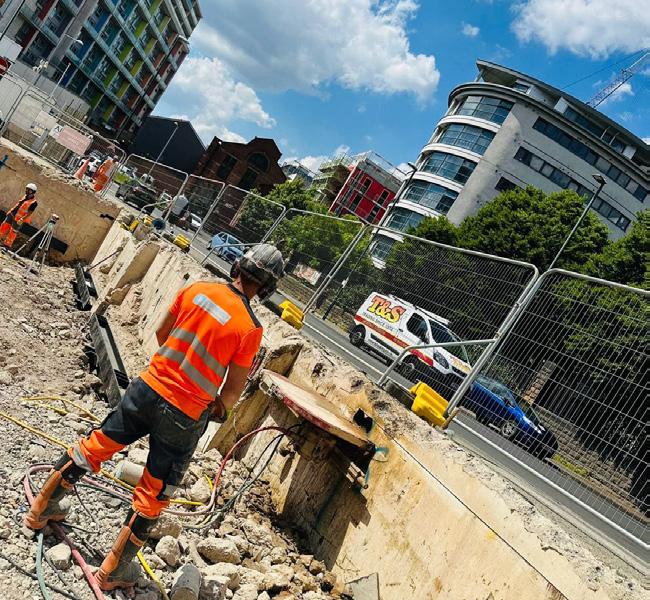
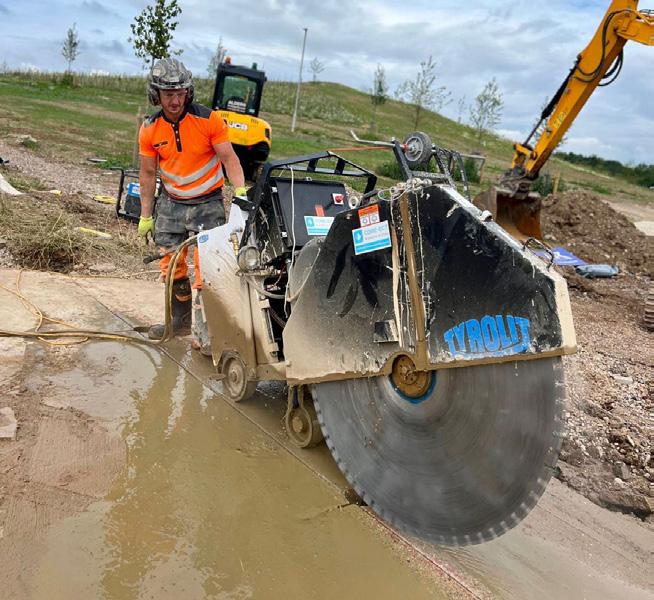
Address 10 Rockley Close, Clipstone Mansfield NG21 9AD Call For GLENN - 07794 473 314 For KURT - 07976 811 172 Email info@core-ect.co.uk core-ectdiamonddrilling.co.uk
NATIONWIDE SERVICE 24/7 25 YEARS OF EXPERIENCE
EXCAVATOR FEATURE
HYUNDAI
With a range of 14 A-Series crawler excavators, offering operating weights of 13-52 tonnes, HD Hyundai Construction Equipment Europe has a machine to suit every sector within the construction business. From quarrying to demolition, Hyundai’s A-Series machines deliver a productive solution, with unparalleled operator comfort and visibility.
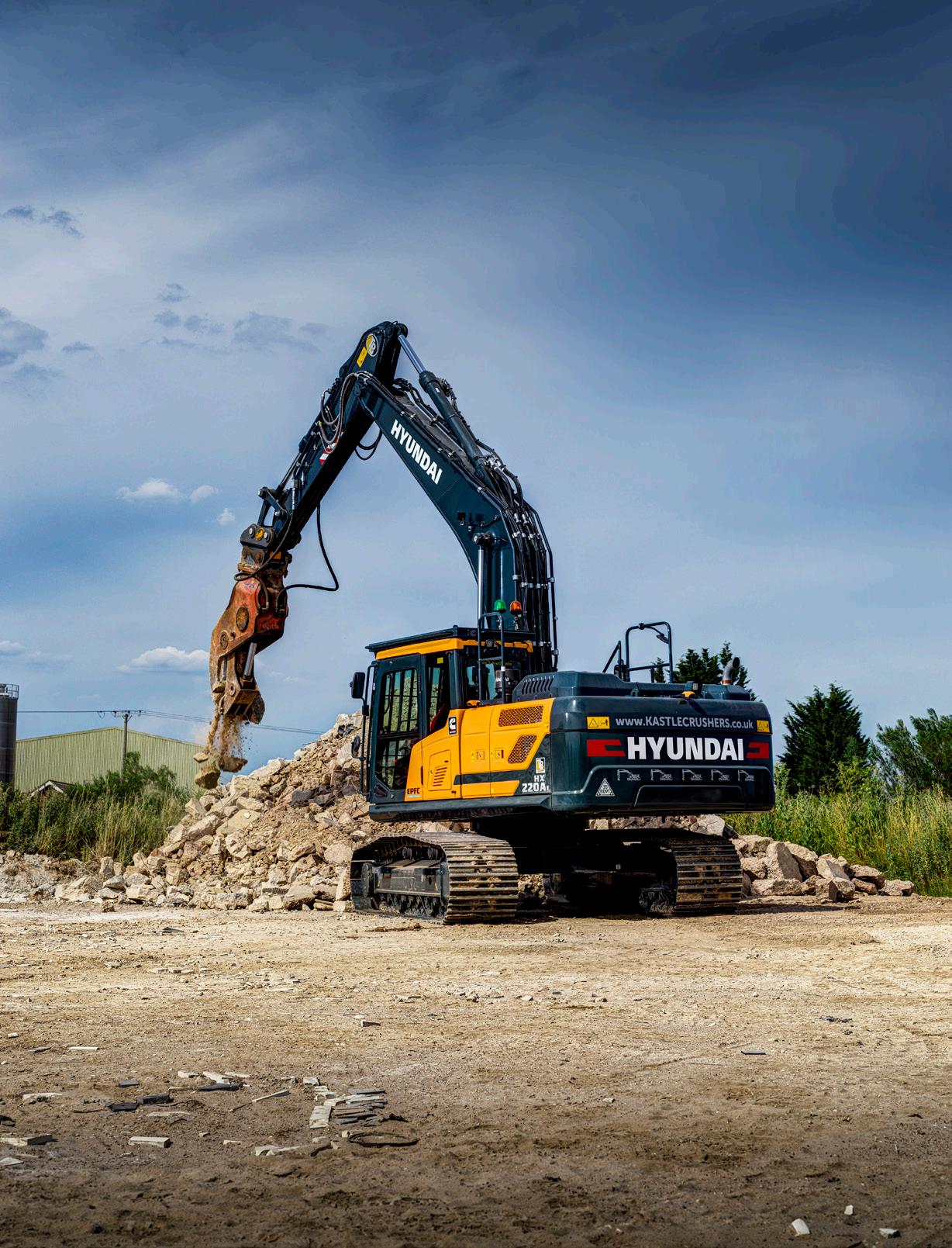
Operator visibility is a critical element of the A-Series operator experience, with the option of Hyundai’s state-of-the-art Advanced Around View Monitoring (AAVM) camera connectivity providing a 360° bird’s eye view around the machine. The excavators also feature a ROPS cab that benefits from 13% greater internal space than previous models, ensuring all-day comfort in the most arduous operating conditions.
European models are supplied through a recently upgraded import centre in Antwerp, where excavators can be customised with a range of booms and dipper arms, cab guards, tiltrotators and other equipment to suit individual customer demand. Hyundai can also supply excavators to third-party conversion specialists, such as Kocurek, for dedicated industry-specific builds.


Larger models are available with a range of options, including track guards, oil-bath and pre-cleaner air filtration, extended catwalks, upperstructure protection and a lower rotating turret cover. Hydraulicallydriven cooling fans, on machines such as the HX480AL and HX520AL, offer manual and automatic fan reverse rotation, to blow dirt and debris from the cooling cores in dustier site conditions. Fan reverse cycles can be pre-set by the operator from the main monitor in the cab.
All of the company’s excavators are powered by EU Stage V compliant Cummins diesel engines, with Engine Connected Diagnostic capabilities available through Hyundai’s HiMATE fleet management and telematic system. Through the use of Electronic Pump Independent Control (EPIC) hydraulic systems on heavier models, Hyundai’s excavators offer highly productive performance, with low fuel consumption and emissions.
98 | DemolitionHUB Magazine DemolitionHub.com
EXCAVATOR FEATURE
JCB
JCB’s X Series models are available in JCB’s dedicated XD demolition specification.

An operator protection cage shields operators from falling material. Certified to FOPS Level 2, it is designed to provide maximum protection with limited impact on visibility due to the design of the angled bars. The cage is platform mounted so can be easily replaced and does not immobilise the machine if damaged. Furthermore the complete front piece of the cage can open like a door allowing easy cleaning of the front glass.
Visibility and on-site safety can be further improved by standard rear view, and optional side view cameras, which provide uninterrupted rearward and sideward views large landscape 7” colour display.
All JCB XD demolition excavators feature a Side Impact Protection System (SIPS) designed to protect the fuel and hydraulic tanks, cooling pack and the hydraulic pump bags.

SIPS is fitted down both sides of the machine’s upper structure and are bolted on in two sections on each side for easy repair or replacement. Improved underbelly protection has also been added with an increase of 400% in thickness from 2mm to 10mm to guard vital machine components on the upper and lower structure. JCB also now have an external steel plate covering the tanks, which are set inboard for additional protection.
JCB XD models benefit from heavy duty dippers, with wear strips added to the underside of the dipper and a bolt of ram guard for the bucket ram with wear pads on the slide mechanism for extensive life and durability.
Twin track guides are fitted as standard on JCB XD models to protect the track chain of the machine when tracking in arduous conditions. Optional full-length track guides can be specified with the machine for even greater durability.
JCB also now fits a wide core radiator as standard and has options for a reversing fan and flyscreen that is pleated in design with no detriment to the 55ᵒC ambient cooling performance.
The bold new counterweight on the X Series is shaped to protect the asset too with dedicated strike points on the corners with the logo recessed behind to protect company branding. The counterweight also comes as red and white chevrons as standard on the XD model.
For ultimate attachment handling, JCB offers the option of Advanced Tool Select. On the display 10 attachments can be setup with desired flow and relief pressure, with customisable control curves for the proportional sliders allowing operators to fine tune the response. ATS monitors pressure changes and makes alterations to the system to maintain a constant and consistent flow to the attachment.
DemolitionHUB Magazine | 99 DemolitionHub.com
EXCAVATOR FEATURE
KOMATSU
Komatsu is a global manufacturer of construction, mining, utility, forestry, and industrial machinery. One of the 85 manufacturing plants worldwide, the Komatsu UK factory supplies hydraulic excavators from 17 to 70 t to the European market as well as Africa.

Demolition excavators and high reach demolition machines are an important part of the range offered by the UK factory. They have been available without interruption for the UK and European markets for more than 25 years. “Over the years, the machines have evolved almost beyond recognition,” said Simon Saunders, Product Marketing Manager at Komatsu.
The demolition excavators are available with a variety of front equipment including straight boom and two piece (hydraulically variable) boom as well as the conventional monoboom, all manufactured in the UK factory from the ground up.
All of Komatsu’s demolition machines comply with EN474 Annex G. This means they include
important features such as EN356 class P5A high impact safety glass in the roof and front screens. Looking around the machine, we can also see that the standard specification includes Falling Object Protection System (FOPS) rated to ISO10262, with an integral roof window wash/ wipe system. The underside of the demolition excavators is fully enclosed by heavy duty belly plates with wraparound type side guards and all of the working lamps (LED as standard) are protected by guards. The business end of the machine is similarly enhanced, with a guard for the attachment cylinder and reinforced linkage to minimise risk of damage when cutting into the fabric of a structure.
The demolition machines are also fitted with additional hydraulic circuits as standard, with pressure and flow regulated by an integral attachment control system. The machines even have an additional attachment drain line featuring steel tubing to provide a direct route to tank for any leakage from attachment rotation motors. The
machines carry a “Demolition” identifier on the door of the operator cab to confirm the regulation compliance.
Simon Saunders said: “We include a high specification as factory standard to minimise the need for modification after delivery. In this way, the customer can be sure the whole machine has been built by the skilled factory team to the same quality throughout.”
Saunders also pointed out that the demolition machines benefit from the same safety systems which are fitted to Komatsu’s standard hydraulic excavators, such as the Neutral Detection system as well as the birds eye view KomVision system, both also standard installation.
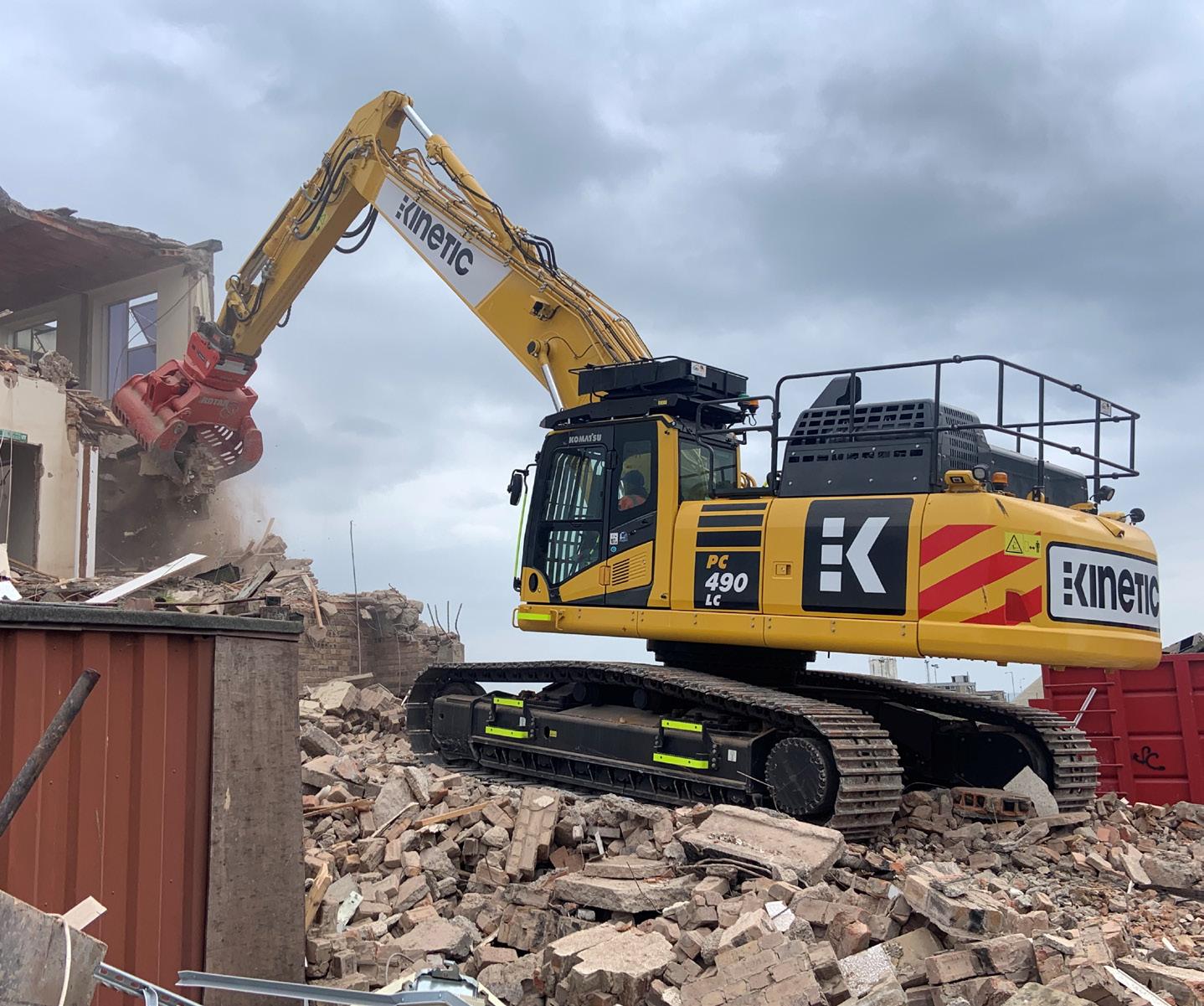
Saunders explained: “The Neutral Detection system enhances site safety by recognising if the hydraulic lock lever is activated with a control lever in an operational position. In this condition, the Neutral Detection system steps in to prevent machine movement.”
Behind the scenes is the dedicated team of development engineers who have full authority to create the machines demanded by the European customers. The machines are fully tested in the on-site facilities before being released to the market and there is a network of distributors across the world who are able to provide after sales support. Factory-backed warranty programs complete the picture.
And what of the future? Komatsu places a high priority on sustainable growth, including minimising the environmental impact of their activities in production and machine operations. The demolition excavator range remains an important part of the overall strategy, by facilitating the recycling and re-use of structures, materials and sites.
100 | DemolitionHUB Magazine DemolitionHub.com
CRUSH YOUR INTEREST RATES
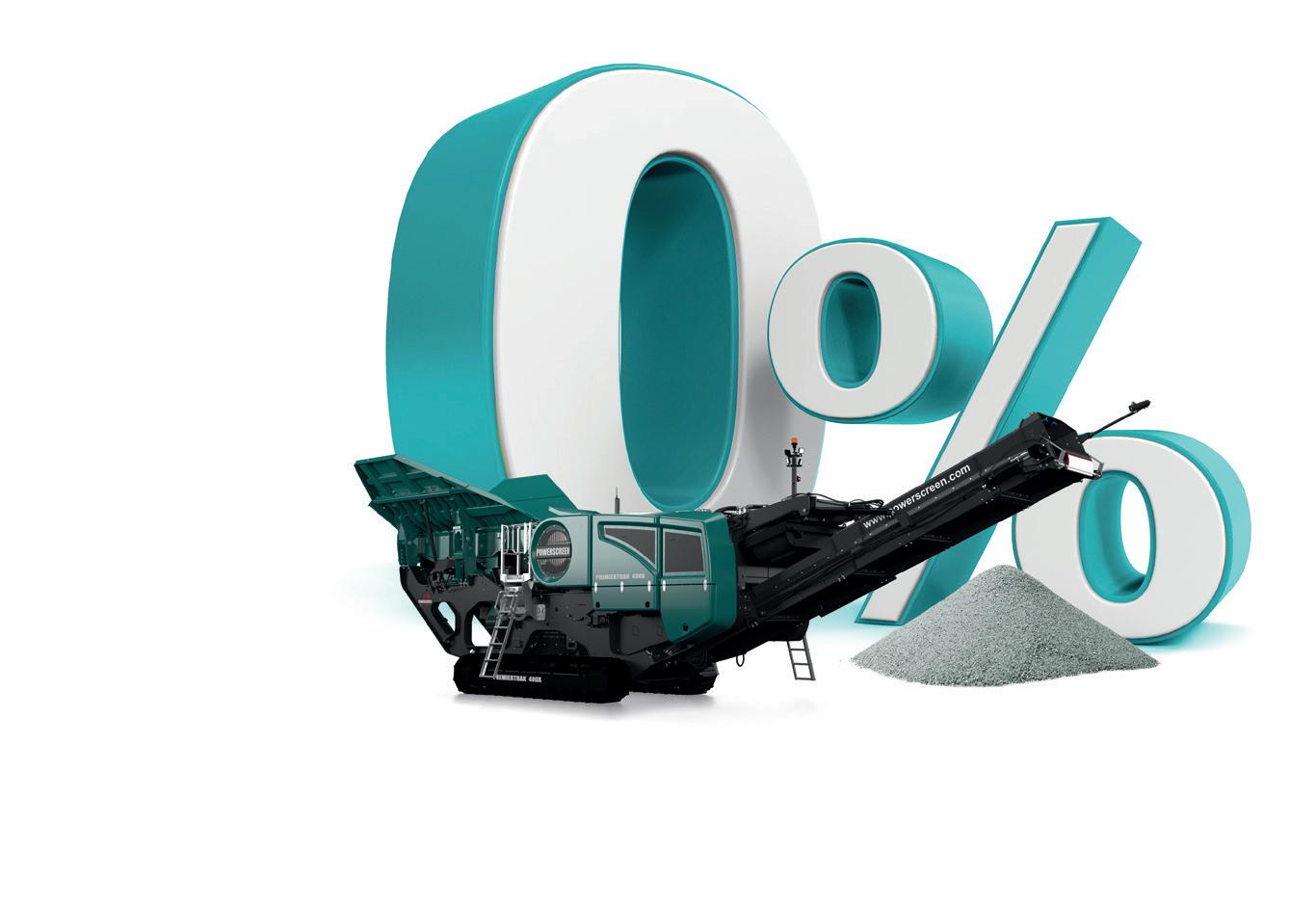
Finance for business purposes only. Subject to acceptance and affordability checks. Applicant must be 18 or over. Promotion valid from 17th July 2023 to 30th September 2023 on selected new machines. Minimum finance term of 12 months. The finance product available under this promotion is Hire Purchase. Full VAT, deposit, and a document fee of £195 are all due on signing. An option-to-purchase fee of £150 (plus VAT) will be collected with the final payment. The customer will own the machine when all payments have been made. Alternative finance options are available, terms and conditions apply. UK Customers only. Images are for illustrative purposes only. Finance provided by BNP Paribas Leasing Solutions Limited, Northern Cross, Basingstoke, RG21 4HL. Registered in England N° 9012255.
For more information contact us today:

© 2023 Terex Corporation. All rights reserved. Terex, the Terex Crown logo, Powerscreen and Terex Financial Services are trademarks of Terex Corporation or its subsidiaries.
as
as
Phone: 0345 1300 669 Email: sales@bluegroup.co.uk
*Subsidised rates from
low


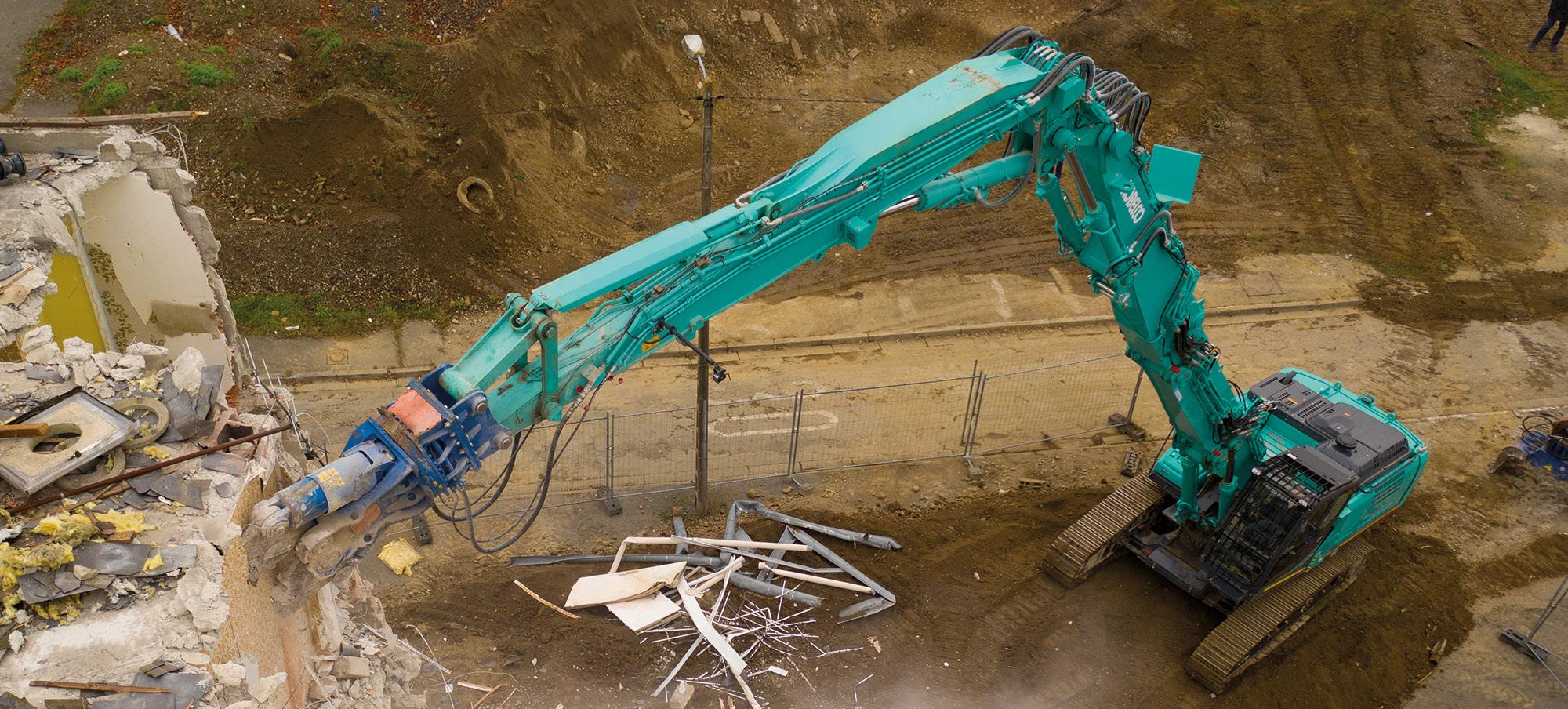
102 | DemolitionHUB Magazine DemolitionHub.com
EXCAVATOR FEATURE KOBELCO
Kobelco is a market leader for demolition equipment in Japan and chose the bauma exhibition in 2016 to first showcase its NEXT Series SK400DLC to the European market. Feedback from dealers, customers and operators during the next 18 months combined with an increasing demand for demolition and heavy machinery, led to the further improvement and development of the machine before the official launch of the SK400DLC-10 in January 2018. Four years later, the next generation SK400DLC-11 and SK350LC-11 were released in 2022.
Kobelco’s versatile demolition models feature the proven NEXT


EXCAVATOR FEATURE
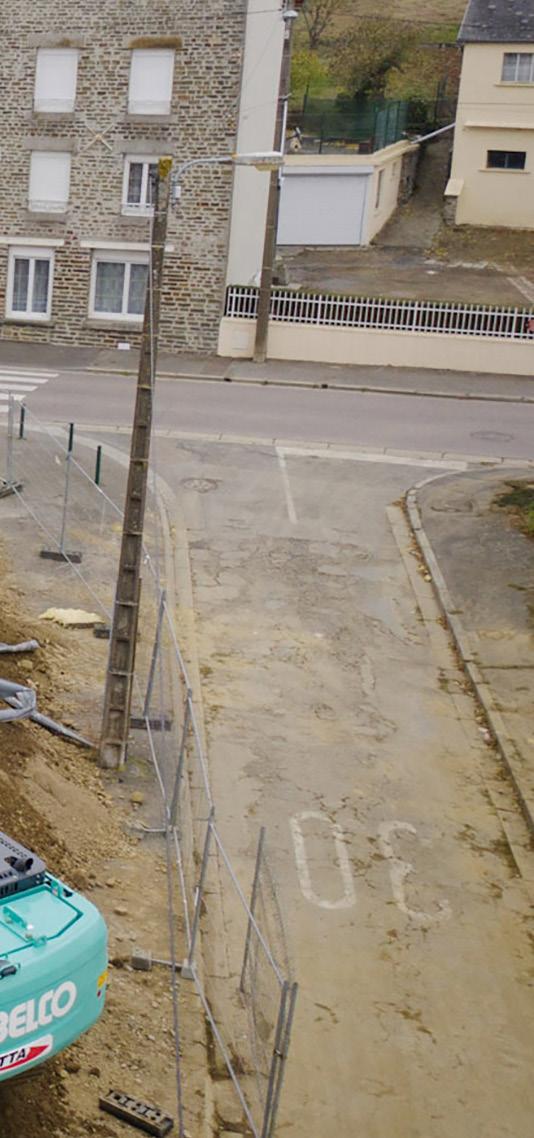
DemolitionHUB Magazine | 103 DemolitionHub.com
Demolition Hub on site




104 | DemolitionHUB Magazine DemolitionHub.com
Job name: The Vicarage


Location: Worthing, West Sussex
Expected duration: Two weeks

Equipment used: 360 Doosan grab and buckets supplied by BPH Attachments
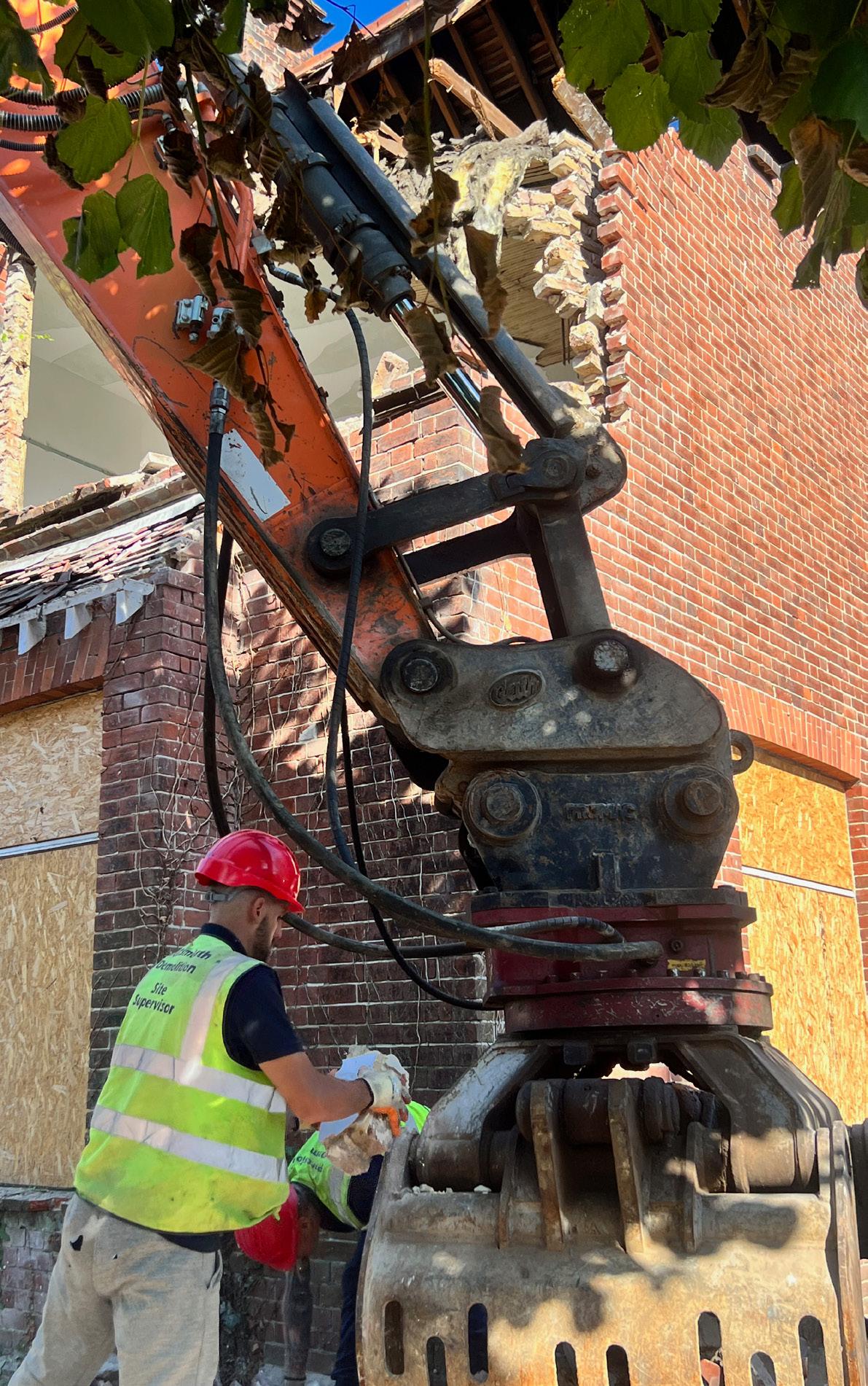
Client: Hampshire Homes

DemolitionHUB Magazine | 105 DemolitionHub.com
OUT and ABOUT


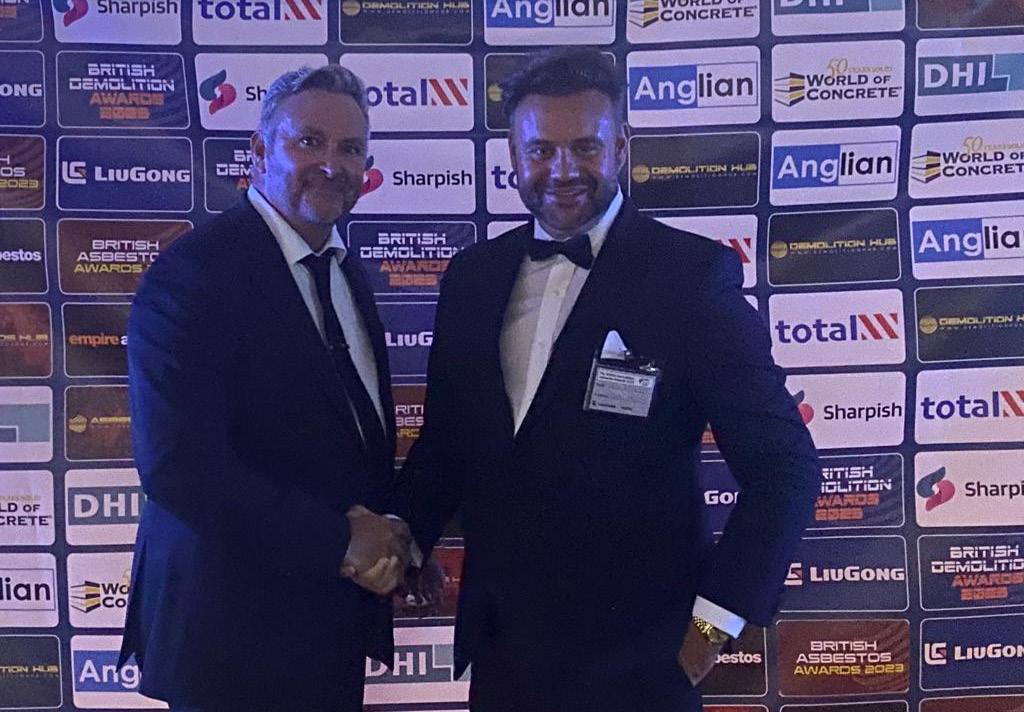
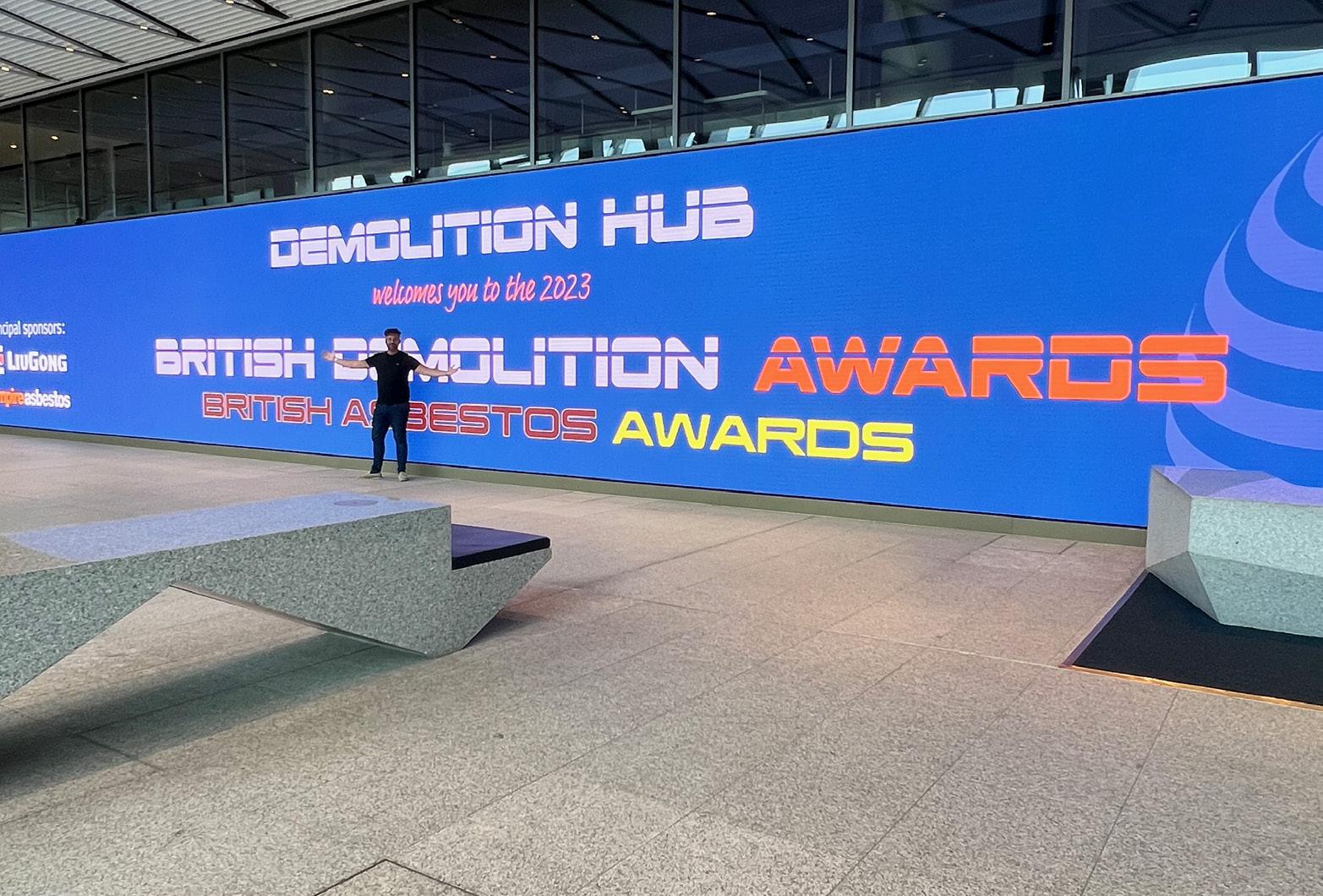





Snapshots of Ben and the Demolition Hub team’s activities between issues 106 | DemolitionHUB Magazine DemolitionHub.com






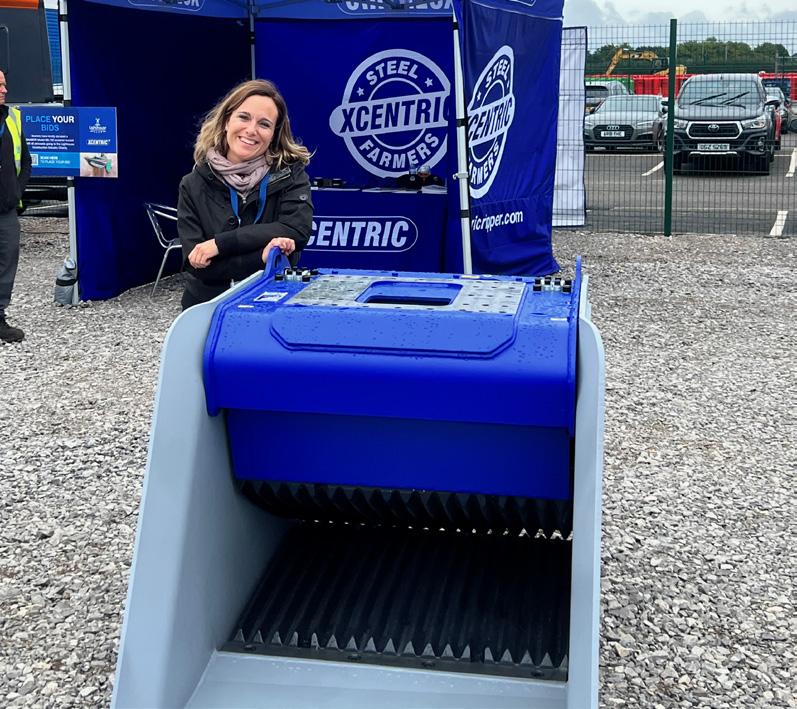
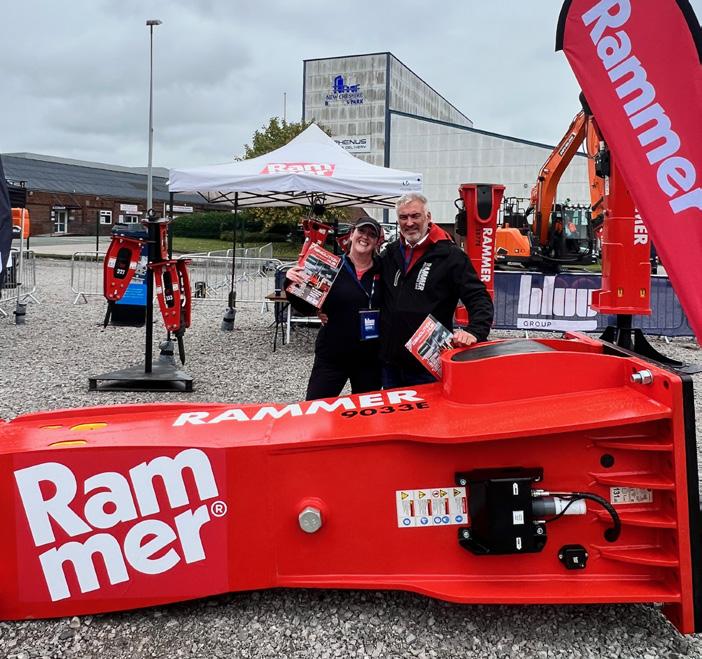


DemolitionHUB Magazine | 107 DemolitionHub.com
OUT and ABOUT




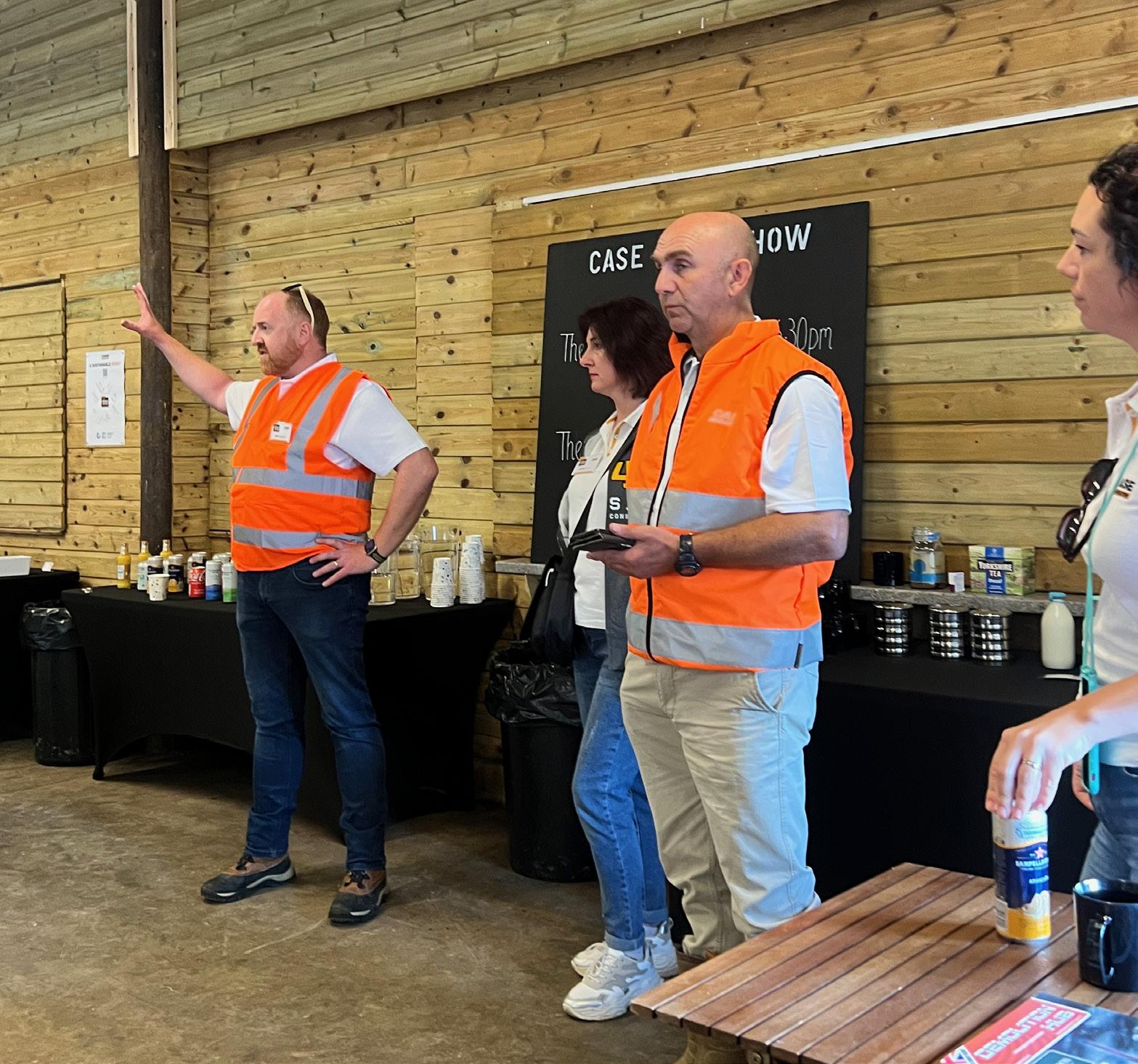




108 | DemolitionHUB Magazine DemolitionHub.com

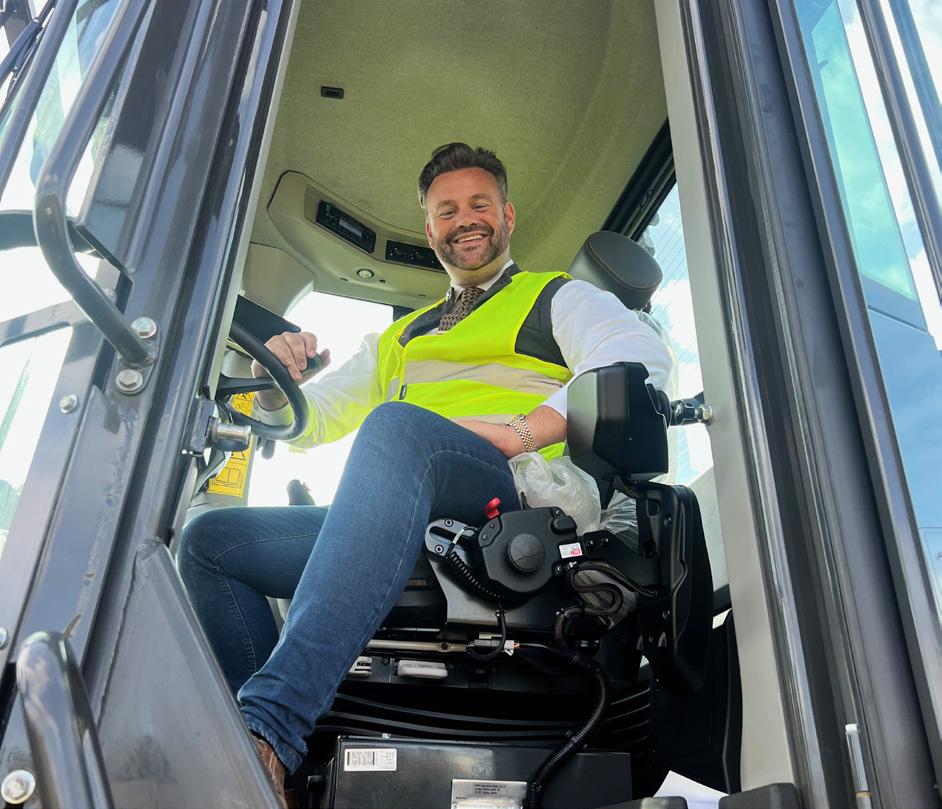
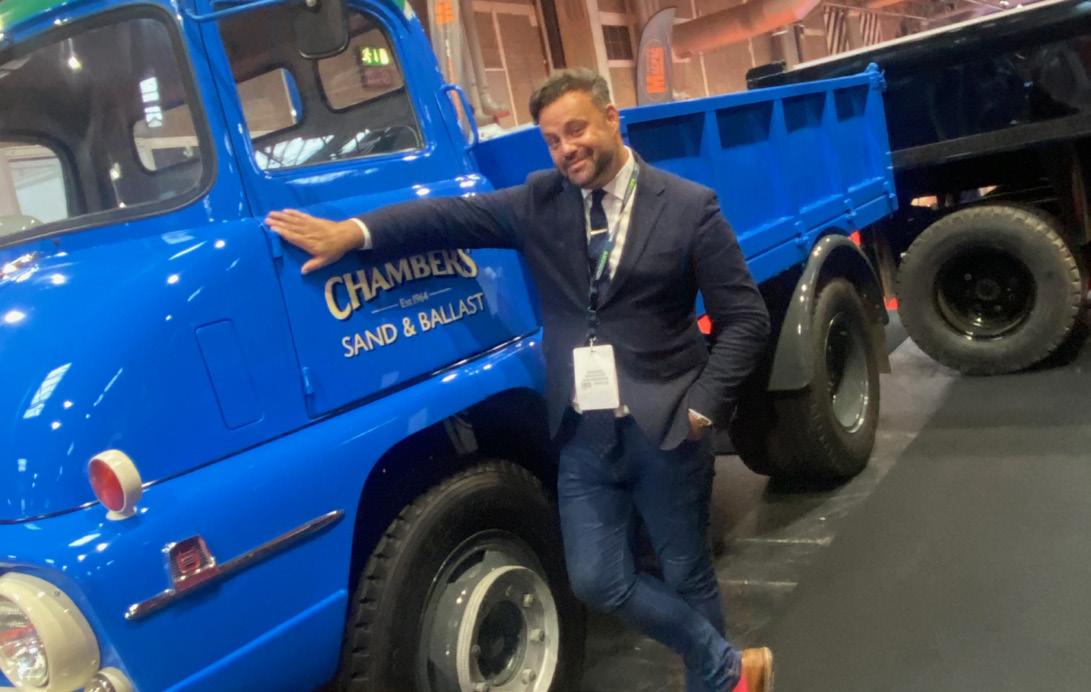
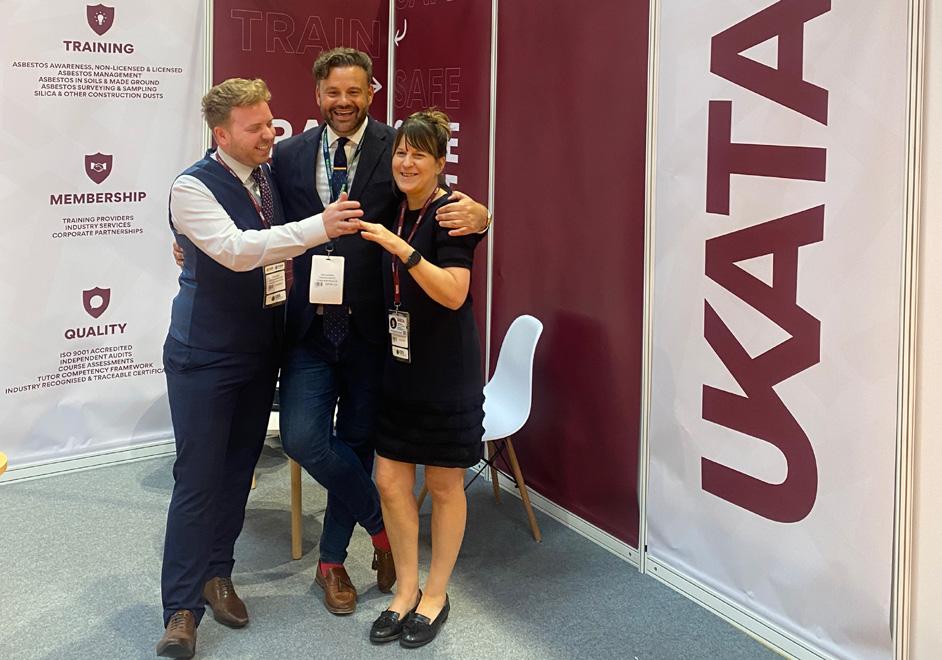
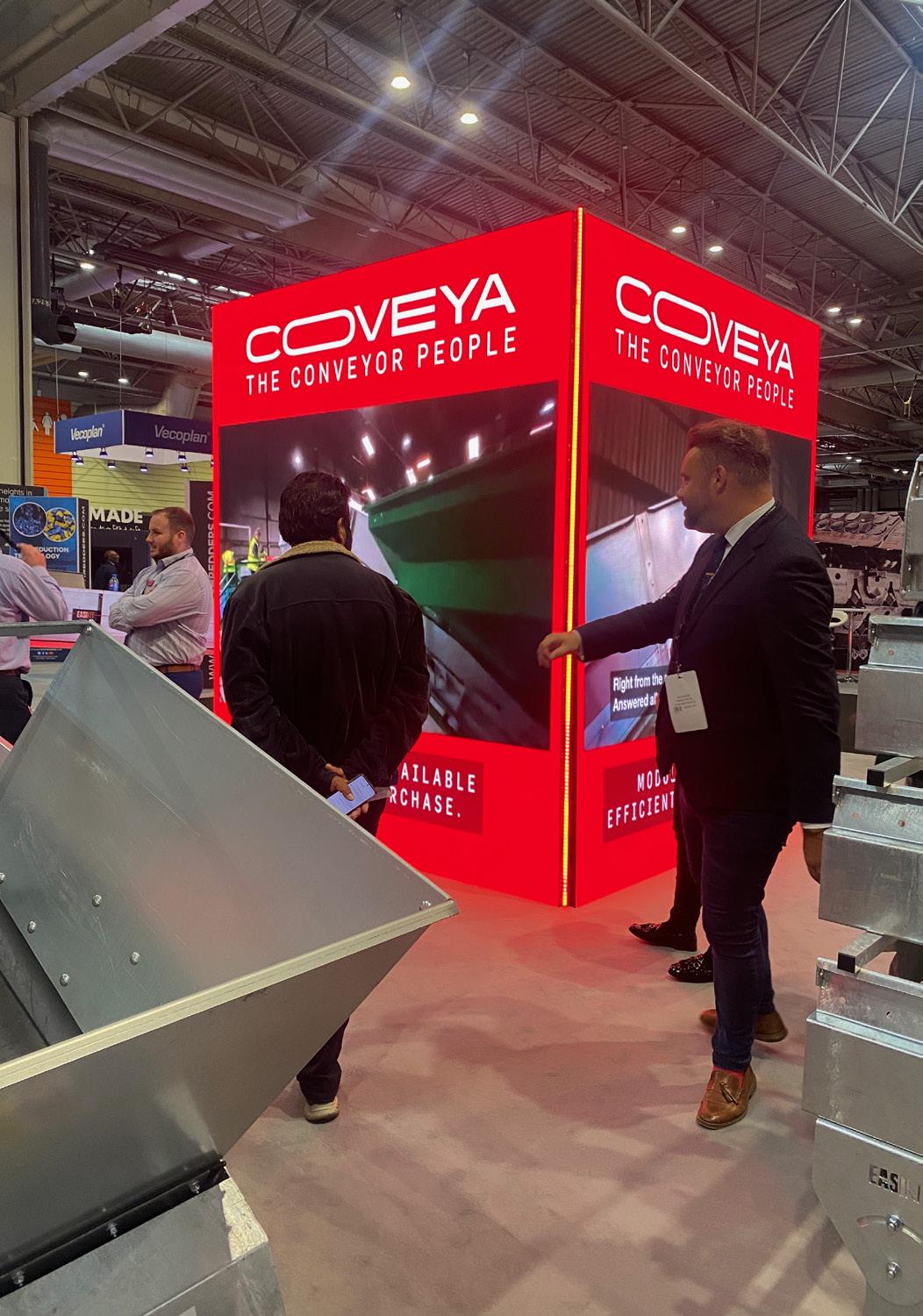

DemolitionHUB Magazine | 109 DemolitionHub.com
OUT and ABOUT
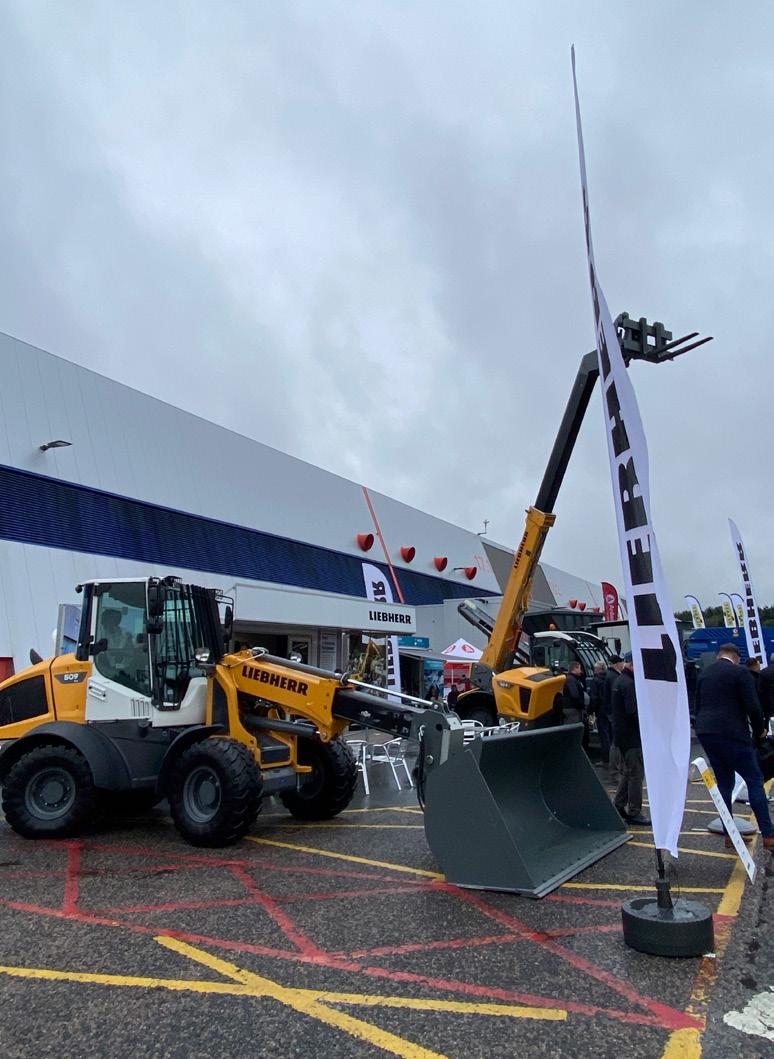



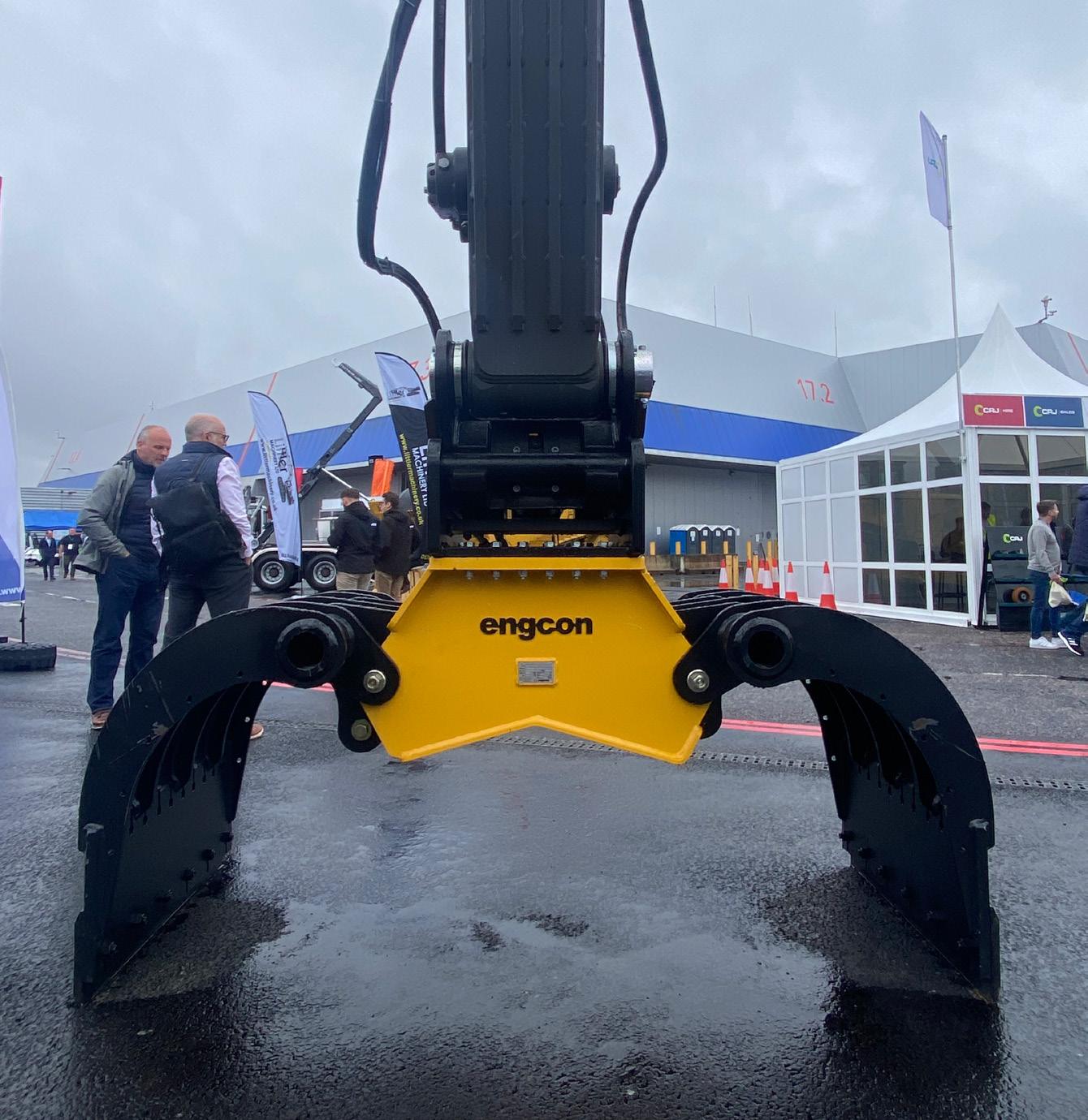
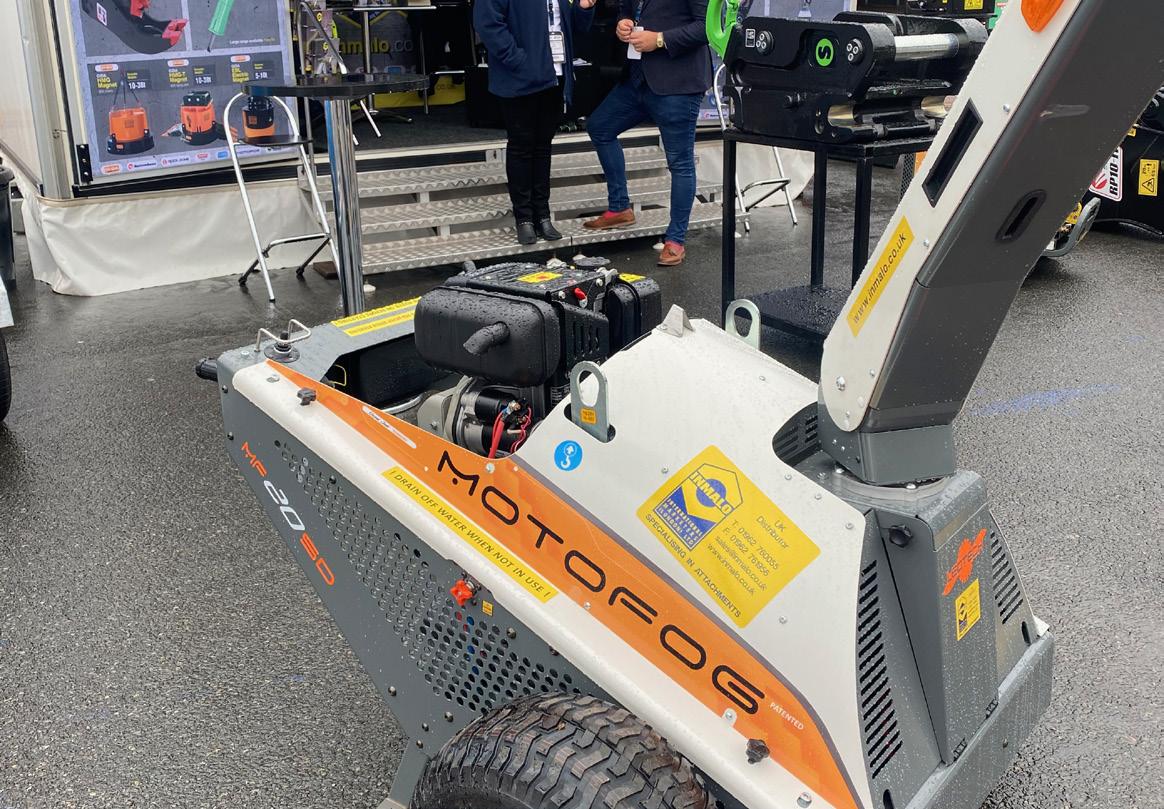



110 | DemolitionHUB Magazine DemolitionHub.com
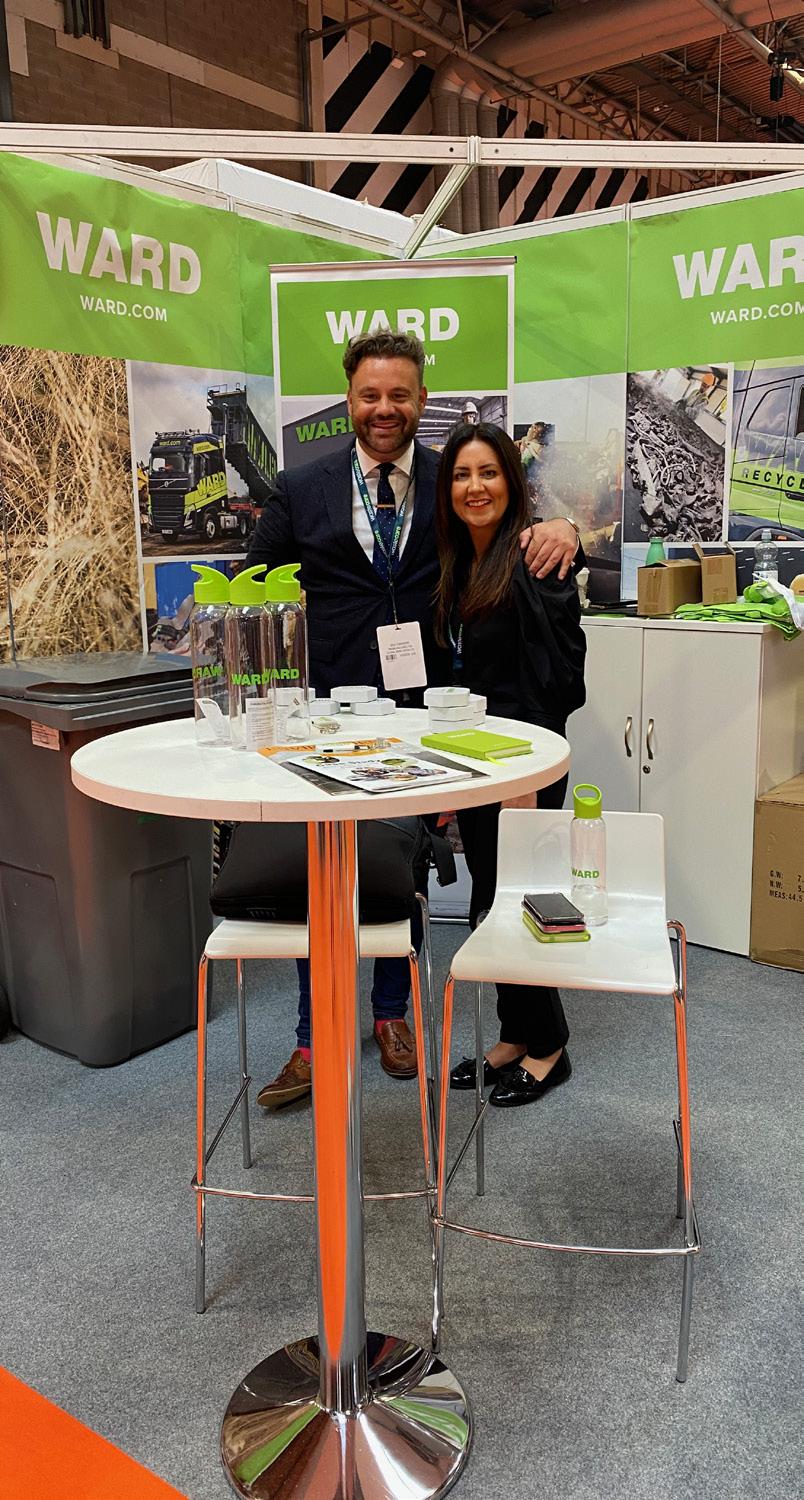
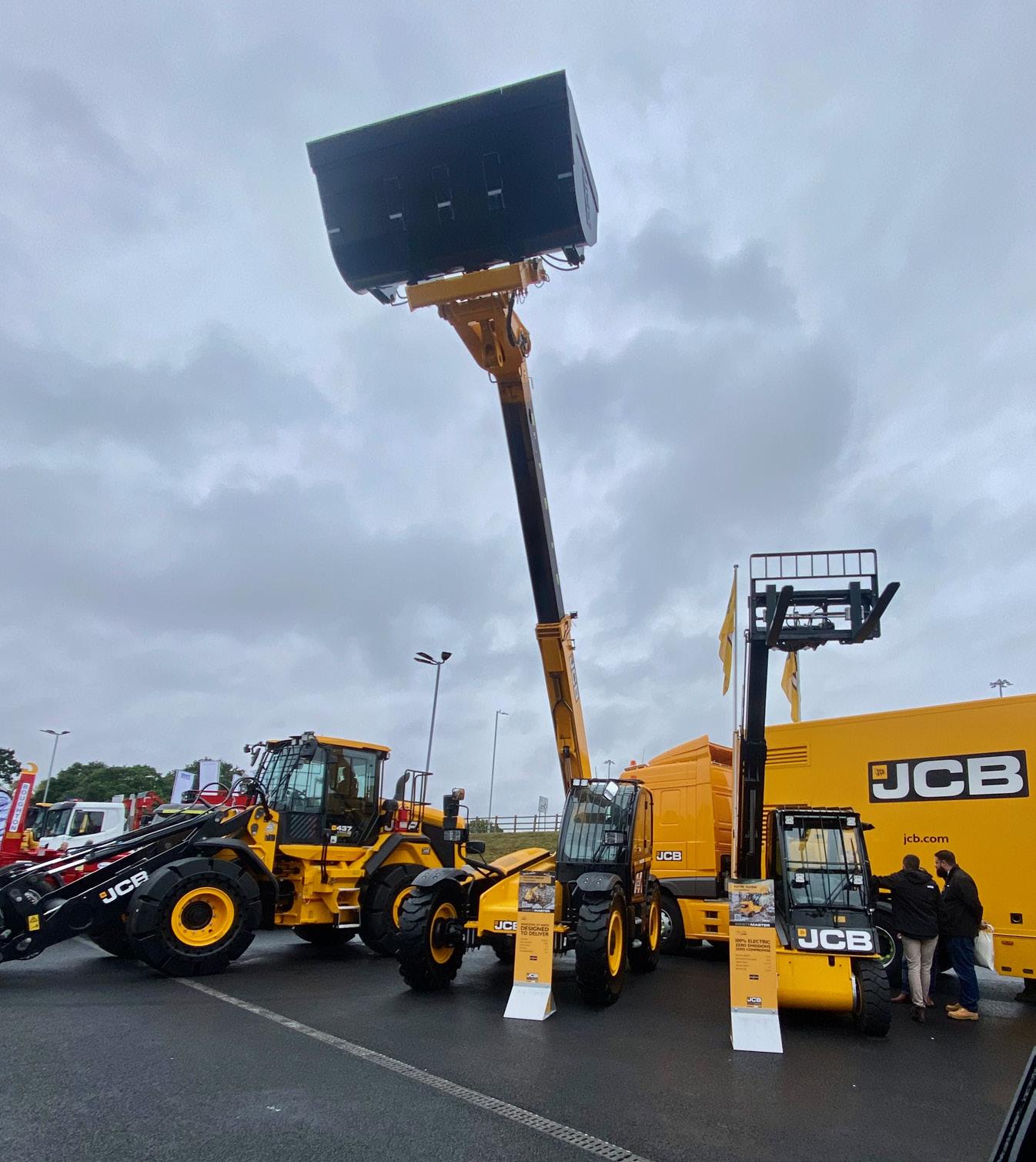
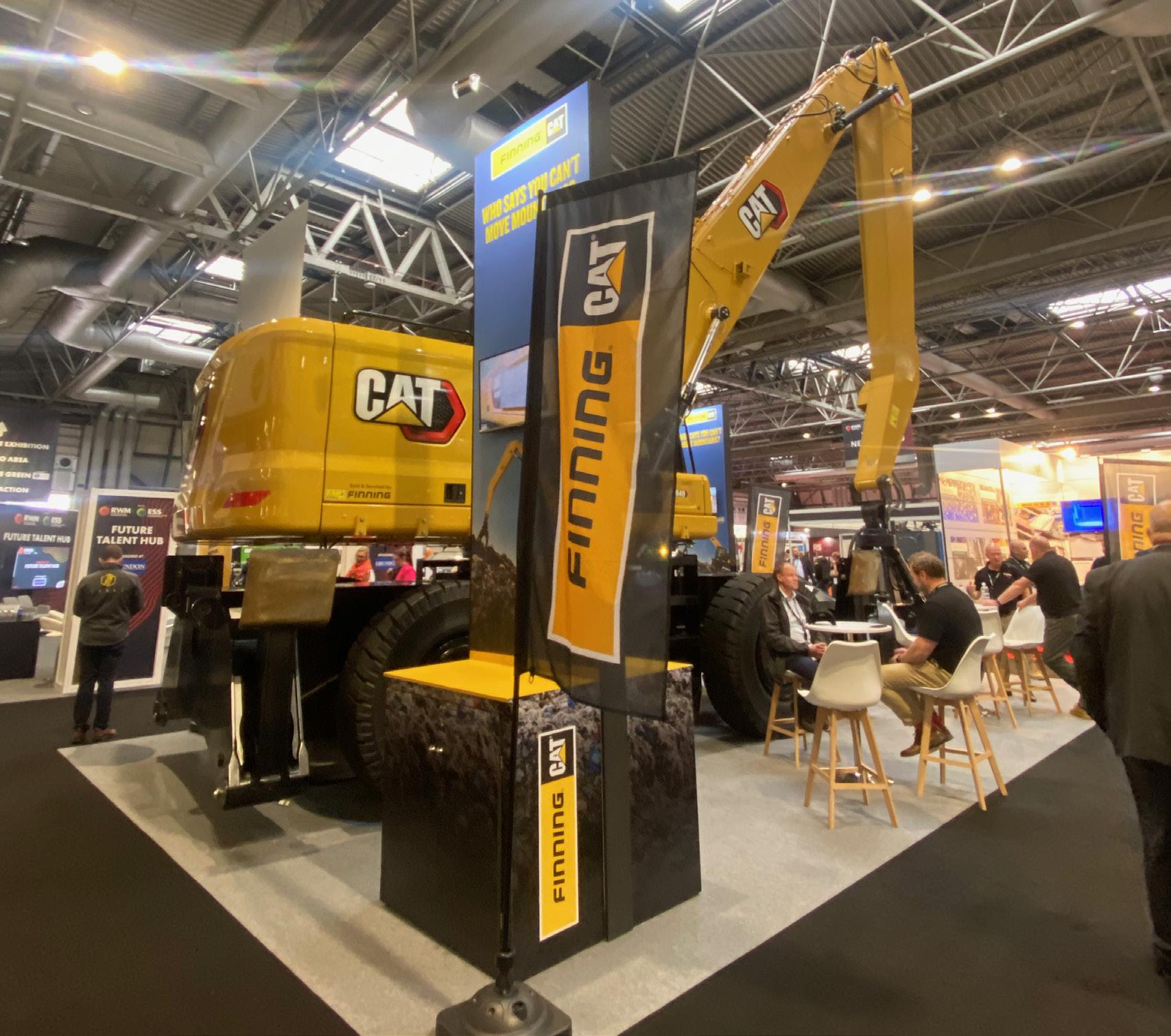
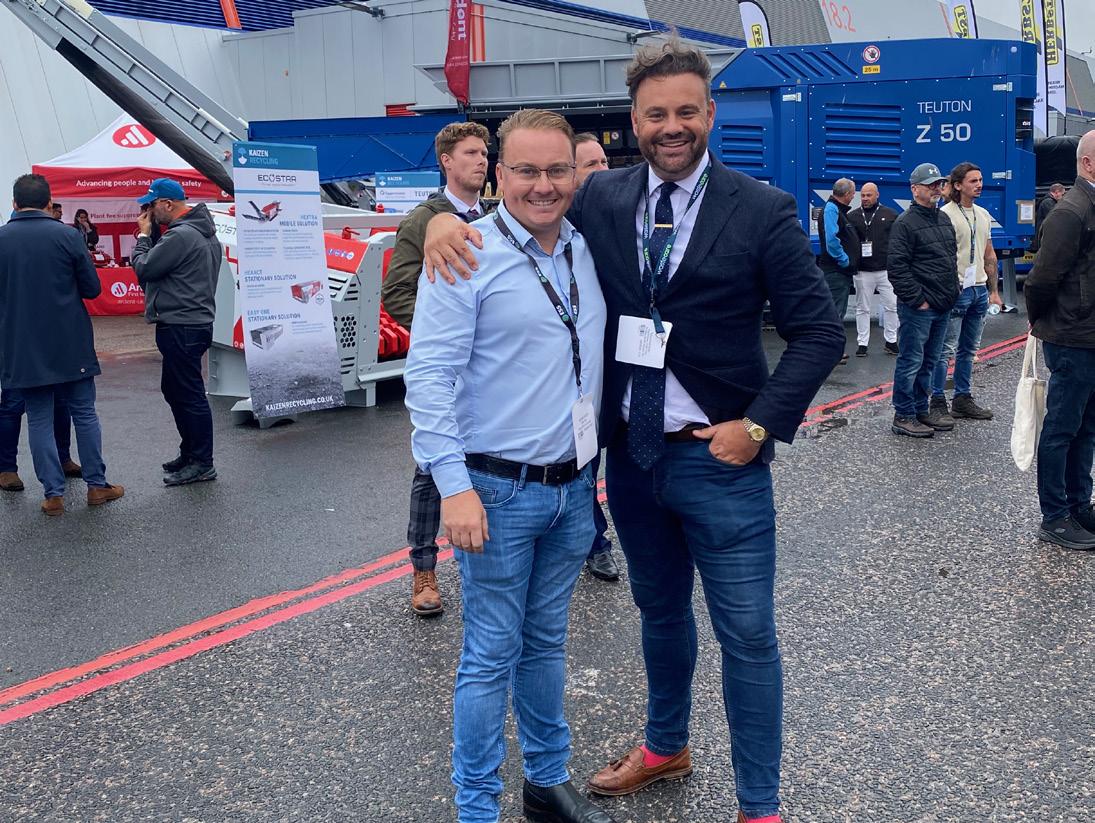

DemolitionHUB Magazine | 111 DemolitionHub.com
Revolutionising labour supply: The Labour Desk’s game-changing operating system
In an unprecedented collaboration, The Labour Desk, a prominent labour supplier in the UK, has joined forces with a cutting-edge technology company to introduce an innovative operating system set to reshape the landscape of labour supply. Aptly dubbed “the UBER for labour supply”, this ground-breaking platform is poised to revolutionise how the industry operates, streamlining processes and enhancing efficiency like never before.
With a focus on both convenience and compliance, this collaborative effort has yielded a host of transformative features that promise to redefine the way labour is managed and deployed across sites. Here’s a glimpse into the revolutionary highlights of this gamechanging operating system.
Efficient pre-induction questionnaires
The system empowers employers to send pre-induction questionnaires to prospective operatives, ensuring seamless onboarding. The ability to monitor the completion status of these questionnaires prior to a site visit guarantees a more streamlined and prepared workforce.
Comprehensive accreditation management
The platform’s portal is designed to meticulously store and manage all necessary accreditations including CCDO cards and Asbestos Awareness certificates and their expiry dates for each operative. This innovative approach not only ensures heightened compliance but also minimises the risk of unauthorised workers on site.
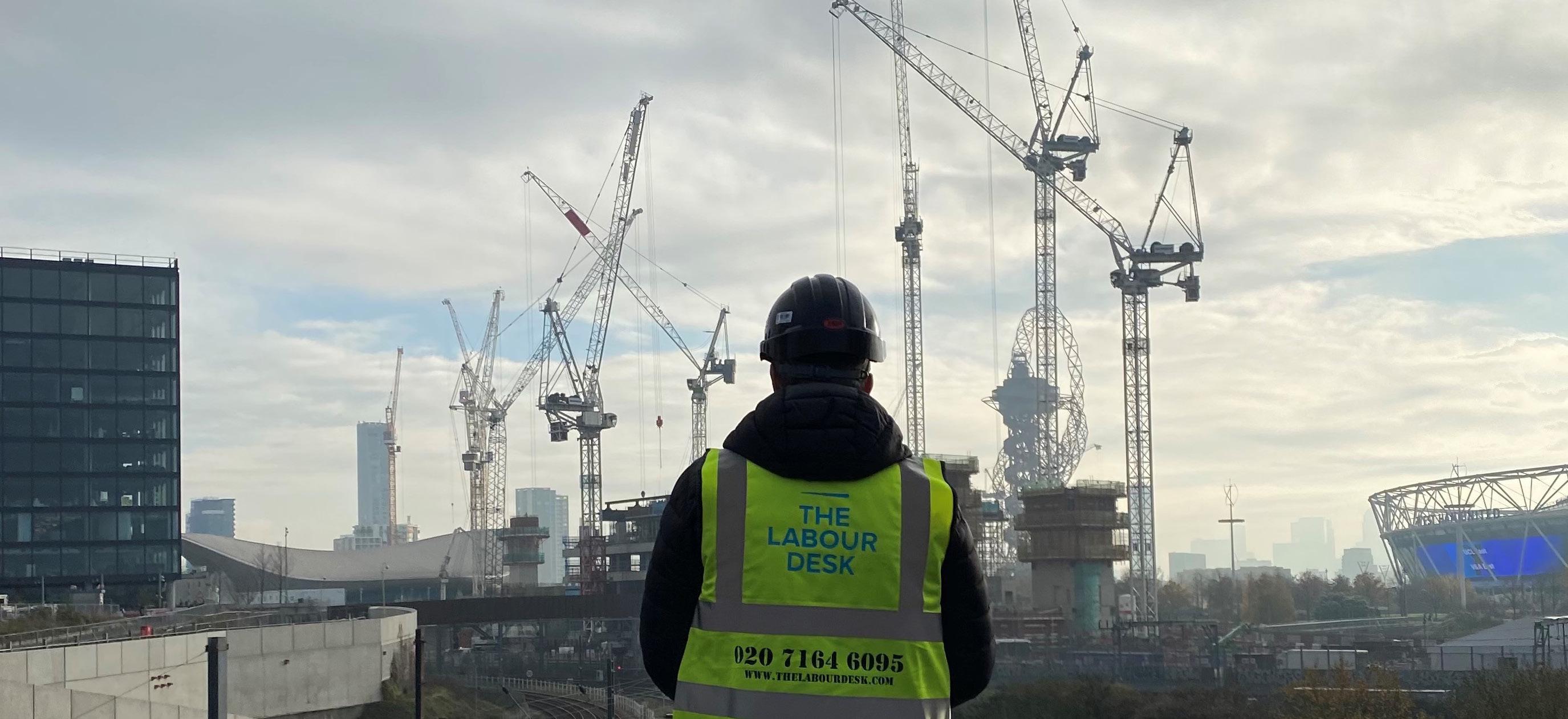
Precise location tracking
Upon arrival operatives are required to clock in and out via the dedicated worker app. This feature records the precise location of the clock-in, providing employers with the means to verify an operative’s presence on site. This safeguards against any fraudulent claims of attendance.
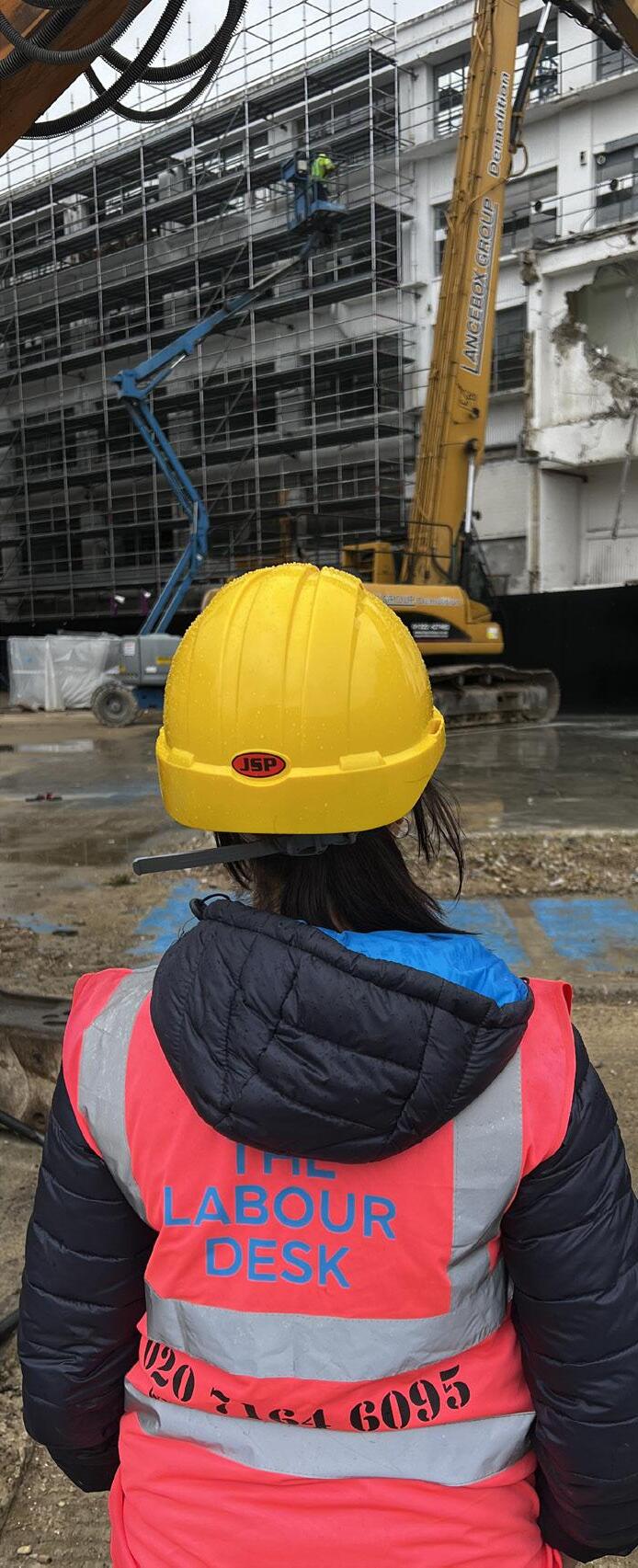
Automated timesheet management
Bid farewell to tedious manual timesheet processing. The system automates timesheet generation and submission, enabling quick and hassle-free approval with just a single click.
Seamless client portal
The client portal interface empowers
hr 112 | DemolitionHUB Magazine DemolitionHub.com
clients to effortlessly add new job assignments, facilitating accurate labour planning that aligns with project timelines. This strategic functionality allows for labour allocation that seamlessly fits into a comprehensive programme of works.
Real-time commercial insights
Within the client portal, clients gain unprecedented visibility into expenditure on a per-site or per-worker basis. This invaluable feature provides a powerful tool for commercial planning and informed decision-making.
Empowering client control
Clients are equipped with the capability to rate, block, or automatically book preferred operatives for their projects. This level of control not only enhances the quality of the workforce but also ensures that the right personnel are consistently deployed.

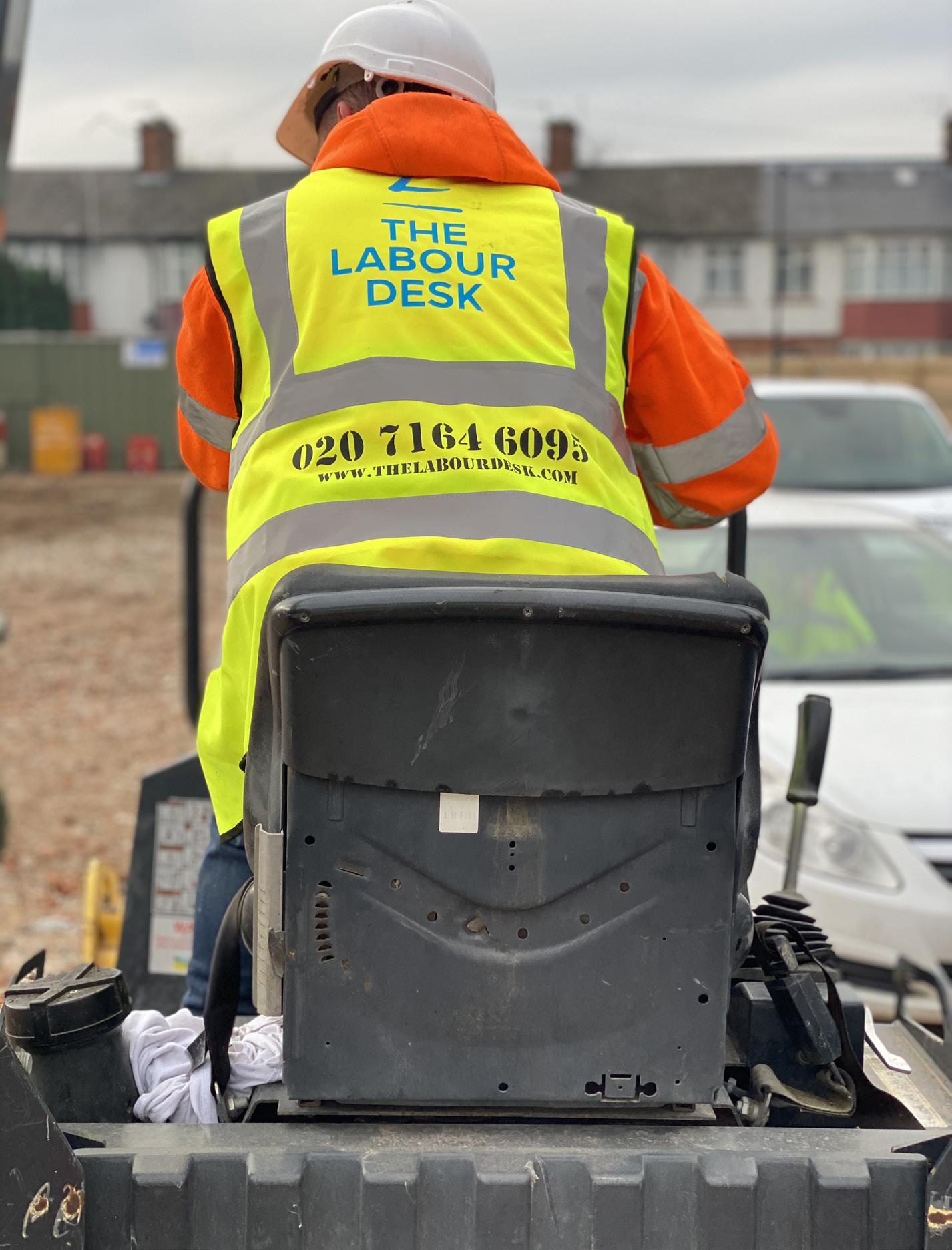
Tackling timesheet fraud
The system addresses a longstanding challenge by eliminating the potential for revenue loss due to timesheet fraud. The comprehensive clock-in and clockout process, combined with accurate location data, adds an additional layer of security against any falsification attempts.
The Labour Desk’s groundbreaking operating system marks a pivotal moment in the labour supply industry. By seamlessly integrating technology with the core processes of labour management, this collaboration has unlocked a new era of efficiency, compliance, and client empowerment. As the industry witnesses this transformation, it’s clear that the future of labour supply has arrived, and it’s powered by innovation.
hr DemolitionHUB Magazine | 113 DemolitionHub.com
This collaborative effort has yielded a host of transformative features that promise to redefine the way labour is managed and deployed across sites
QTell us about your experience within the built environment sector throughout your HR career

I’ve had the pleasure of working in senior HR positions for the past 36 years, many of which have been spent supporting unionised and non-unionised businesses within the built environment sector, especially within the spheres of distribution and manufacturing. I have been involved in everything from creating management structures and training programmes, to generating initiatives that increase diversity in the workplace. Mainly though, my work has revolved around recruitment and retention of skilled workers.
QWhy is staff retention a growing concern in the demolition industry?

Let’s face it, demolition is not a particularly sexy industry and it’s not attracting people to it like it did
before. It’s tough, demanding, highly skilled and pressurised. Therefore many people would rather take an easier option. Millennials especially are more likely to leave a job if they’re not happy with it, rather than stick it out for the money. Work life balance is therefore a priority for them and if they feel their needs and concerns are not being met, they will be on their way.
High turnover is always costly in terms of time and investment spent on skills, training and onboarding, but for SMEs especially, it can be crippling, if not deadly. The result is they may choose not to develop the talent they have. Because employees don’t feel valued or engaged, they are more likely to leave, which creates a destructive, self-perpetuating cycle that only damages the demolition industry further.
It’s sad to think that the built environment is the foundation of the UK economy and essential for
its growth, yet the whole sector is struggling to hire and retain skilled workers. It’s well known that around 225,000 construction workers may be needed by 2027 according to the Construction Skills Network, but little is being done outside of the sector itself to help meet this target. The government for instance is far too focused on turning the UK into the next Silicon Valley, rather than creating the talent pool that is needed to meet its own national housing target of building 300,000 net new homes per year by the
Michael Doolin, founder and Group Managing Director of Clover HR, gives his thoughts on the importance of employee engagement to tackle the skills crisis in the demolition industry
DemolitionHub.com 114 | DemolitionHUB Magazine hr
HR best practice will be key to hiring and retaining the next generation of demolitionists
mid-2020s. Hopefully this will change in light of the Raac (reinforced autoclaved aerated concrete) crisis, which needs skilled operatives to solve and kickstart the rebuilding process.
QYou’re a huge proponent of the power of employment engagement. Has the demolition industry embraced this concept and if not, why should it?
Employee engagement is all about improving your employees’ connection to their work and your company. Unfortunately, it’s been treated as an afterthought for far too long, but I do believe this attitude is changing, albeit extremely slowly. In my experience and opinion, far more needs to be done to embrace it, because making even minor implementations will lead to more motivated and devoted staff. I’ve seen it a number of times, when failing companies are completely turned around in terms of performance as a result of their teams becoming highly engaged with their work, because senior management has taken HR practice seriously rather than pay lip service to it.
If a demolition company wants to reap the benefits of employee engagement, a good starting point is to coach and encourage your managers to have constant conversations with staff about their work, how they feel about it,
the ways that it can be improved and how it fits into the success of the business. Done right, this should make them feel valued, but unfortunately, most managers don’t know how to make such conversations meaningful, so their actions are more likely to be interpreted as micromanaging, unless they are provide with the right advice and guidance. This can be achieved by developing robust HR management programmes, which ensure the importance of the workforce is recognised.
QHow do we attract more people to the industry, especially school leavers and graduates?
The first step is for the industry to take decisive steps to showcase the strategic importance of what the industry does. It is far too often taken for granted. The reality is, that demolition is the key to the regeneration of the UK’s infrastructure and therefore its economy, business and local communities. That means that demolition companies and member organisations need to actively engage with schools, universities, the media and even the government to fly the flag for demolition.
Anyone thinking about a career in demolition needs to be made aware of the opportunities for advancement and shown what they need to do to take the next

steps on the ladder, especially if they are women or from a minority background. That means working closely with careers advisors, who too often don’t have a clue as to what the job entails and need to be educated and advised.
Finally I think the demolition industry has an image problem and this needs to be rectified quickly. When people think about demolition, they imagine wrecking balls and polluting clouds of dust. This is reinforced by the media, which is only too eager to underpin this image with negative opinion pieces, rather than highlighting how the industry has worked hard to green itself and actually profits from recycling.
QDo you think there are other talent pools that the industry has overlooked that might be a suitable source of employees?
As I mentioned earlier, the industry needs to counter its underrepresentation of women and ethic minorities, but I also believe more can be done to attract older workers looking to change career, ex-armed forces personnel, ex-offenders, and those in the retail industry, which is currently seeing massive layoffs. Other industries have failed to engage with these people, so there is a perfect opportunity for the demolition industry to steal a march on them.
DemolitionHub.com DemolitionHUB Magazine | 115 hr
you clever little thing !



LEARN
MORE
Case study
Title: Forward Innovation Centers East and West redevelopment
Location: Cleveland, Ohio
Structure: Forward Innovation Center East – a former auto manufacturing stamping plant

Forward Innovation Center West – a former auto motor manufacturing plant
Contractor: Independence Demolition

Client: Scannell Properties, Weston, DiGeronimo Development

Start date: August 2021
Completion: March 2023
Techniques: Abatement, conventional demolition using hydraulic excavators, shears and grapples and concrete breakers
Future use: Modern, energy-efficient distribution and manufacturing
Independence clears the way for innovation
This project was a collaborative effort on a design-build project on an aggressive schedule. Demolition included abatement, conventional demolition using hydraulic excavators, shears and grapples and concrete breakers. Beyond asbestos, the removals included all of the residual oils and management of impacted soils. All of the
manufacturing units were demolished, processed and recycled including all metal products as well as concrete pits and machining structures. The project included a significant crushing component to reuse crushed concrete as structural fill and base material for the commercial redevelopment of the site.
redevelopment was to renew these brownfields and create new, vital, industrial land, effectively revitalising these sprawling sections of the urban Cleveland landscape. These new “hubs of industry” are now, officially known as Forward Innovation Center – East and West.
The properties were owned by a single automotive manufacturer and operations included a motor manufacturing plant as well as a stamping plant. The motor manufacturing plant was built in the 1950s and historically consisted of everything needed in the process to produce a motor starting with foundry and boiler facilities and going through to the manufacturing, assembly and final roll out of finished engines. The stamping plant was also constructed in the 1950s and supported the final assembly plant by taking raw steel rolls and forming the integral body and frame parts for a wide variety of automobile models. At one point, the total employment of both plants was reported to be nearly 20,000 people combined. Unfortunately, the facilities began to be shut down around 2010 in a consolidation and downturn strategy that began with the steel casting plant in 2010 and ended with the shuttering of the engine plant around 2018.
Independence Demolition, Inc. of Cleveland, Ohio, worked alongside Independence Excavating, Independence Construction, DiGeronimo Development, Weston, Inc., and Scannell Properties on the redevelopment of the Forward Innovation Centers in urban
Cleveland, Ohio. The collaboration began with the acquisition of two properties of former automotive manufacturing facilities totalling over 320 acres (130 ha) of land and having over 3.8m square feet (353,000 m2) under roof. The objective of this mega-scale
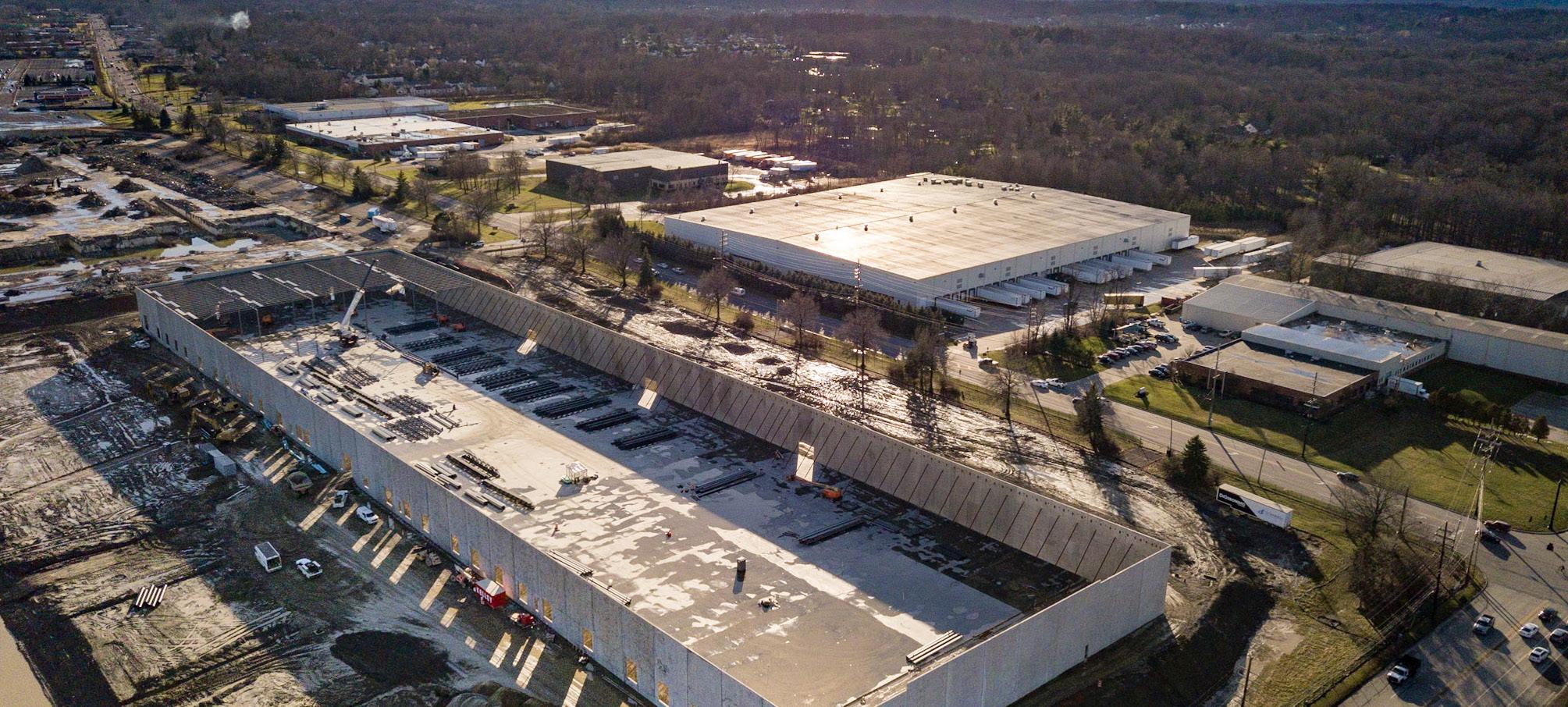
The project owners, DiGeronimo Development, Weston, Inc., and Scannell Properties employed their “Forward Innovation” to envision a redevelopment opportunity intended to rejuvenate industry on these brownfield properties. Their new development plans required significant environmental

118 | DemolitionHUB Magazine DemolitionHub.com
case study
remediation of a wide variety of carcinogenic compounds including polychlorinated biphenyls (PCBs) as well as on-site consolidation and control of wastes like spent foundry sand. In all, the team’s vision was to establish new industrial facilities that would accommodate over 5.5m square feet (511,000 m2) of industrial, clear-span, and flex spaces for tenants. These improvements are projected to add 5,000 jobs back into the Cleveland area economy and the team needed to come out of the ground with their first two buildings very quickly to realise those benefits.


A project with this ambitious a timeline requires a level of collaboration that is usually reserved for a single entity. Independence Demolition Project Executive, Doug Thomas said: “All the entities came together which made our field crew safer, more efficient and effective leading to a successful project.”
The full scope of the development would require decommissioning, demolition, environmental cleanup, material recycling, heavy civil
construction, utility construction, building construction and fit-out, and commissioning all on overlapping and integrated schedules. The assembled team of DiGeronimo Companies, Scannell Properties, Weston, Independence Demolition, Independence Excavating, Independence Construction and over a dozen other smaller subcontractors was necessary to bring all the necessary expertise to bear on the project. As a member on the redevelopment team, Independence Demolition was charged with delivering the “Clean Slate” for the next phase of redevelopment. Independence Demolition needed to complete decommissioning, hazardous materials removal and abatement, structure demolition and remediation activities prior so that the civil construction stage could begin, and they only had a six-month head start.
Jacob Holdeman, Scannell Properties Project Executive, said: “The turn-key nature of Independence Demolition’s
approach made it easy for Scannell Properties to maintain focus on the property and infrastructure design and development. Weekly project updates drove the needed collaboration to carefully select the right part of the property for the first building and coordinate its design and construction. Furthermore, their efficiency was key to driving a higher return on the demolition and allowed us to begin construction of that first building sooner than expected.”
The tenets of the collaborative effort that ensued were transparency, communication, visibility and expert execution. The teams had worked together before, so trust was high across the group, but a cost-plus delivery model provided a high level of transparency across all the entities involved. Communication was driven from both directions. Top-down communication came from the owners so that expectations were clear and bottom-up communication drove continuous reporting on performance and schedule that
DemolitionHUB Magazine | 119 DemolitionHub.com
case study
case study

All of this work was done in close coordination with the Ohio Environmental Protection Agency (EPA) and the owner’s environmental consultants to ensure that environmental regulations were followed and that remediation work was completed so the site was clean for its intended future use as an industrial park.

allowed for key decision making in real time. The wide communication loop also created visibility across the teams as managers reported through their teams on a regular basis. Finally, Independence Demolition brought an entire staff of experts including structural engineers, environmental scientists and construction professionals to the table on behalf of team. Additionally, a full time on-site safety representative with regular support from the entire safety department, was key in a successful project, in addition to the daily planning meetings and extensive job hazard analyses with the crews.
With this foundation of teamwork in place, Independence Demolition started the decommissioning process. Building residual removal, hazardous material collection and disposal and asbestos abatement made up the first stage of demolition. Meanwhile, rigorous structural evaluations of the massive buildings were conducted. The results of these analyses allowed structure demolition to commence
in some specific areas, while the first stage of decommissioning was still ongoing elsewhere. Consistent with automotive manufacturing, the buildings consisted of various pits, high bays, basements, presses, large foundations, not to mention a variety of environmental challenges.
The effort included the removal of several million dollars of asbestos containing material, countless bulbs, ballasts, batteries and thousands of gallons of residual oils. At least 12 electrical substations were decommissioned and their associated PCB-containing transformers, fixtures and concrete were appropriately remediated. The primary environmental contaminants across the facilities were identified as PCBs and other carcinogenic and non-carcinogenic oil constituents and metals that occurred in a variety of areas across the historic manufacturing plants. However, an estimated 750,000 cubic yards (573,000 m3) of foundry sand was also stored at one of the sites, which is regulated as an exempt solid waste in Ohio.
Several challenges were presented to the Independence Demolition team that were overcome because of their expertise and their collaboration with other team members. For example, a large portion of the spent foundry sand needed to be relocated on the site to provide the proper grades for a future building. Independence Demolition provides a significant number of resources on the environmental management side of this work that allowed Independence Excavating to utilise their heavy civil capabilities to move over 375,000 cubic yards (286,700 m3) of spent foundry sand in a little over four months. Another challenge was the closure of the substations. Many of the substations required regulatory closure, and Independence Demolition provided both the manpower to decommission and properly dismantle the substations, but they also used their internal environmental expertise to complete the required US EPA closures for each of the substations impacted by high levels of PCBs.
Independence Demolition was also tasked with removing concrete and preparing the development sites for their future buildings and utilities. The entire mass of concrete generated at the site was crushed, tested to confirm it met the environmental standards for reuse at the site and will be reused during the construction phase of the project. While this seems like an ordinary part of the demolition process, the team was challenged
120 | DemolitionHUB Magazine DemolitionHub.com
when the owner needed to begin civil construction at one of the sites before structure demolition was complete – in other words, long before the concrete removal would normally have been done. This required extremely careful planning and a high level of on-site coordination and communication to provide a clean and clear work zone that was safe enough for the rest of the team to occupy long-term.
During this phase of the project, the team implemented bi-weekly meetings across all the active teams on the site to make sure superintendents and project managers were all abreast of the work being performed. Independence Demolition team members also attended the weekly job meetings for the other entities on the site that included both civil and vertical construction trades. This allowed for increased visibility of the demolition across the team, but it also gave other team members a regular opportunity to ask questions and vet ideas for upcoming work and its coordination.
Project Executive Tracy Green of Weston said: “Independence Demolition’s commitment to safety was beyond impressive. They meticulously evaluated every building section prior to work and they made certain that everyone at the property was coordinating access and work so that the safest site was maintained. The sheer magnitude of the buildings demolished and their process was impressive to witness.”
Overall, the team views the state of the project a huge success. First, and most importantly, the entire project was performed with no lost time injuries. This is an amazing feat considering that the project encompassed 170,000 worker-hours. Several other, significant milestones were reach by the team. The project accounted
for a significant mobilisation of demolition equipment with 25 pieces of equipment ranging from skid loaders to 200,000-lb (90-t) hydraulic excavators, shears, and 261,000-lb (118-t) mining trucks.

Independence Demolition mobilised as many as 80 demolition professionals at peak operation. Almost as exciting as the equipment and workforce achievements, are some of the other project stats. Independence Demolition processed and shipped over 65,000 tonnes of scrap to recycling facilities as a result of this demolition, and over 90,000 tonnes of concrete has been processed, with all that concrete to be reused on the project as building and utility aggregate.
All of this was accomplished, again, with no lost time injuries. It was only possible due to the collaboration, cooperation and trust throughout the team, and Independence Demolition is proud to represent that team.

Learn more about Forward Innovation Center: https:// forwardinnovationcenter.com.
If you have a case study you would like to submit for publication in Demolition Hub, please email: toby@chambers.media.

DemolitionHUB Magazine | 121 DemolitionHub.com case study
GBM welcomes first female board member
the board on financial performance, strategic opportunities, risks and compliance.
Having started her career in practice, Leanne joined a fastgrowing technology business as an assistant accountant, quickly becoming a key member of the team. After several years as Team Leader, Leanne was promoted to Financial Controller. This saw her leading a large team, overseeing all financial reporting and being instrumental in financial systems and staff integration of around a dozen acquisitions right through to an eventual private equity sale of a £100m business.
internal finance function and control environment in achieving this. Leanne’s previous experience in a growing business, strong commercial acumen and systems awareness will help us to achieve our goals.
Leanne Fairburn:
Grantham Industries Ltd, a well-established and respected business spanning several divisions specialising in demolition, waste management and quarrying recently welcomed its first female board member. Leanne Fairburn (FCCA) has more than 15 years’ experience in finance with a particular focus and interest in high growth ownermanaged businesses.
As well as being responsible for the complete day-to-day financial operations and systems of the business at GBM across all divisions, Leanne provides insight to


It was at this point that Leanne was introduced to the Managing Director of GBM, Simon Grantham, through a mutual business contact. At the time, after a period of organic growth, the directors were looking to recruit an experienced accountant to streamline their financial operations and improve the quality of the management reporting available to them. Initially joining as Financial Controller, it quickly became clear that Leanne’s role was developing into a more strategic role stretching far beyond the finance department and covering HR, compliance and operations.
The business has an ambitious plan for growth and a commitment to continuous improvements across its operations and the directors acknowledge the need for a strong
“Joining a business in this sector was a bit of a step into the unknown. I was confident in my abilities and what I could bring to the team, however as much as I wish it wasn’t the case, as a woman you do have the question in the back of your mind around how much your input would be valued and how you might fare in a predominately male industry.
“I had been lucky enough to have the full support of the senior team in my previous role and I was determined not to land a ‘back office’ accounting role that I have seen other very talented women confined to. I am an advocate of financial business partnering and believe that accountants should be visible across the business, and I wanted to be sure the directors saw the value in this.
“After several meetings with Simon and Adrian Corrigan, Divisional Director of GBM Demolition, and listening to them talk about their vision for the business, I was confident that the role would be a good fit.
“Upon joining it quickly became clear that they and the rest of the
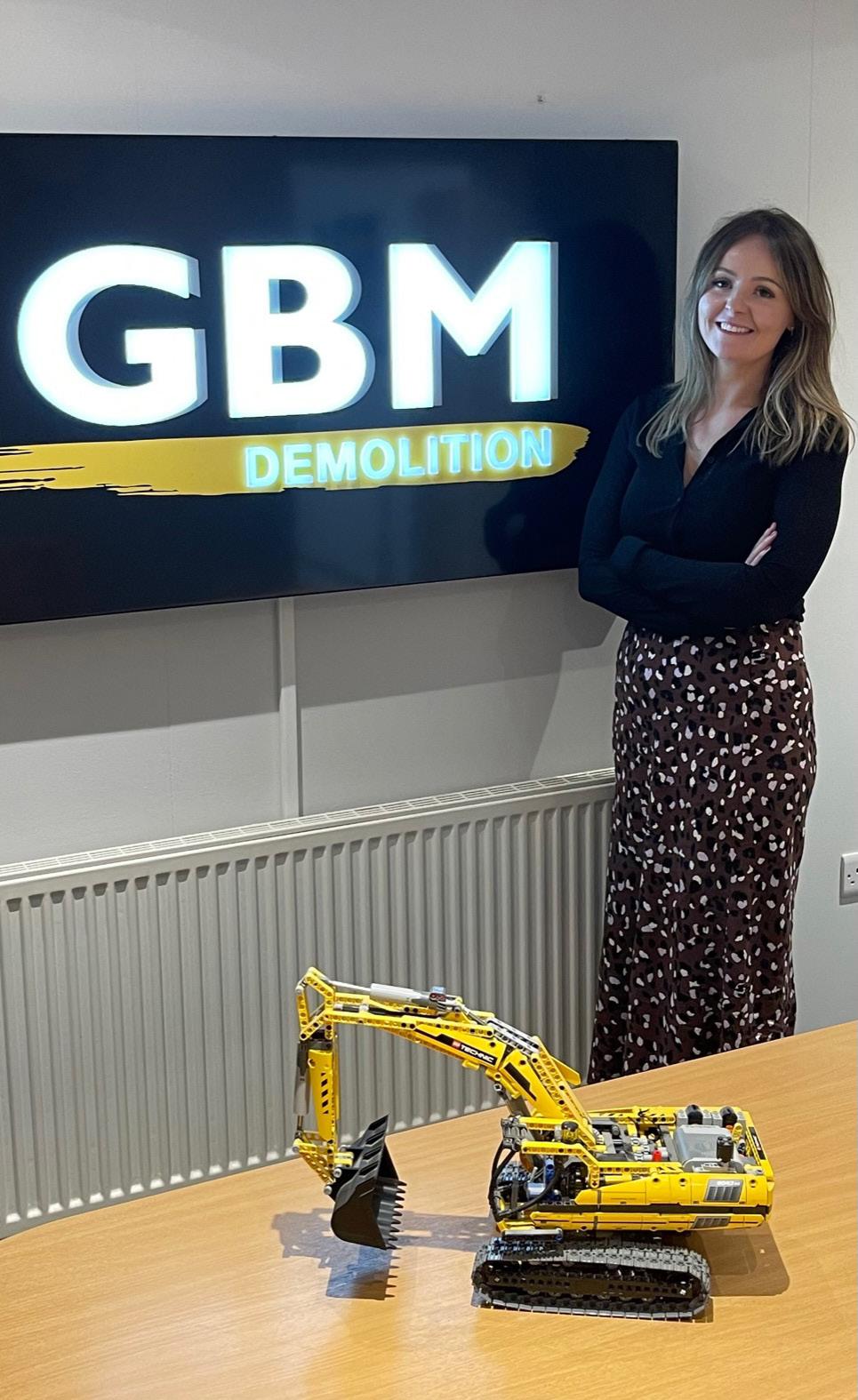
DemolitionHub.com 122 | DemolitionHUB Magazine profile
board valued and trusted my input and I have been able to develop not just the financial control of the business, but also provide significant input into staff wellbeing and development, operational systems and strategic decisions. I was delighted when this was further acknowledged with my recent promotion.
“The most encouraging part for me has been that this shows that they are not just paying lip service to wanting to develop an inclusive and forward-thinking team.
“It is clear that the business can and does welcome women across all levels of the business for which they are qualified and is committed to being a part of the change needed by normalising the position of women in the construction industry by providing a safe space for female team members – they will be listened to, respected and fully supported in their roles, on and off site.”
Adrian Corrigan – Divisional Director
“GBM has for many years been a strong competitor in its chosen markets with all the right equipment, contacts, operational staff and reputation to succeed.

“However, in striving for continual improvement in all key departments and with solid sustainable growth over a number of years it was acknowledged some time ago that the financial reporting, strategic planning and commercial risk management of the business needed strengthening.
“We met with numerous
candidates and it was clear from the outset that Leanne was the person with the best experience, qualifications, business acumen and drive to take on what we knew would be a very demanding role.
“As a company we are very keen to be inclusive and very much encourage the development of women’s roles in the construction and demolition industry. However, it must be stressed that Leanne was appointed to her role and then promoted to Director purely on her professional abilities and general drive to succeed.
Numerous modern new ways of working have been implemented under her leadership and the business is seeing betterment in efficiencies across all divisions.
“I know I can speak for my fellow directors and say how delighted we are and how lucky we feel to have Leanne onboard.”
Simone Scaman – Business Development Manager
“Having worked for GBM for several years, I have been part of the everchanging world of the construction industry and witnessed first hand the challenges being a woman can present.
“When Leanne joined the team in 2019, it was apparent that her ambitious vision for the business was very clear. Swiftly implementing improved and integrated systems across all divisions has been key to the business growth and performance, utilising staff more effectively and identifying strategic opportunities, all of which have made a major impact very quickly.
“Working closely with Leanne has been an absolute pleasure and the office is a brighter, more positive environment with her there. Leanne cares a great deal about all staff members working for her and more widely the guys on site.
“Financial reporting is now accurate, on time and the board is very confident in making important decisions with Leanne’s input.
“Leanne actively promotes the individual development of employees and encourages an efficient team ethos. Her management skills have been welcomed by all as a positive step forward and I believe the improved confidence she builds has increased productivity.
“It was with great delight to see such efforts acknowledged by senior management, recognising the impact Leanne’s role has had on the business as a whole and is exactly what the construction industry needs to see.”
DemolitionHub.com DemolitionHUB Magazine | 123 profile
“Female team members will be listened to, respected and fully supported in their roles, on and off site”
Effective dust control at Normans AB with HPW-DUST
As urban landscapes continually evolve, demolition activities are a common sight in cities worldwide. Yet, the environmental and health impacts associated with these operations requires a need for effective dust control. This was the case for Normans AB with a huge demolition project in Uppsala, where they used Dynaset’s HPW-DUST High Pressure Dust Suppression System provided by Dynaset’s dealer AMAS Svenska AB. This project showcases the vital role of technologically advanced solutions in maintaining an environmentally friendly and safe demolition environment for the workers and the nearby residents alike.
The challenge: Dust control in demolition

Normans AB, a prominent Swedish demolition company, undertook a significant demolition project in the historical city of Uppsala. The project posed unique challenges due to Uppsala’s dense population, rich history and close proximity to sensitive ecological zones. These conditions required exceptional dust control measures to protect
residents, local fauna, and historical sites from the harmful effects of airborne particles.
In demolition operations, dust control is a complex issue. Without effective mitigation, dust can pose serious health risks to workers and nearby residents, affect local ecosystems, and damage adjacent properties or historical artefacts. Therefore, effective dust control is not just an environmental or health issue, but also a question of social responsibility and regulatory compliance.
The solution: Dynaset’s dust suppression system
In response to these challenges, Normans AB selected DYNASET HPW-DUST High Pressure Dust Suppression System from the Dynaset dealer AMAS Svenska AB in Sweden, a high-pressure water system renowned for its efficacy in dust suppression. The system creates a fine mist that effectively binds and settles airborne dust particles, drastically reducing the amount of dust that escapes into the environment. The HPW-DUST system operates by converting the hydraulic
power of a machine into highpressure water for dust suppression. Its design allows for easy integration with various machinery, which made it an attractive choice for Normans.
The choice of Dynaset’s HPWDUST system was influenced by several key factors, among which include efficiency, cost-effectiveness, versatility and environmental impact. On the efficiency front, HPW-DUST’s high-pressure water mist has proven superior in capturing fine dust particles compared to traditional methods like sprinkler systems. As
DemolitionHub.com 124 | DemolitionHUB Magazine industry
“It’s not just about demolishing structures, but about shaping our urban landscapes in a manner that respects the health and wellbeing of our communities and the environment”
for cost-effectiveness, while the initial investment in the HPW-DUST system can be substantial, the long-term savings associated with reduced health risks, environmental fines and equipment maintenance costs can offset these initial expenditures.
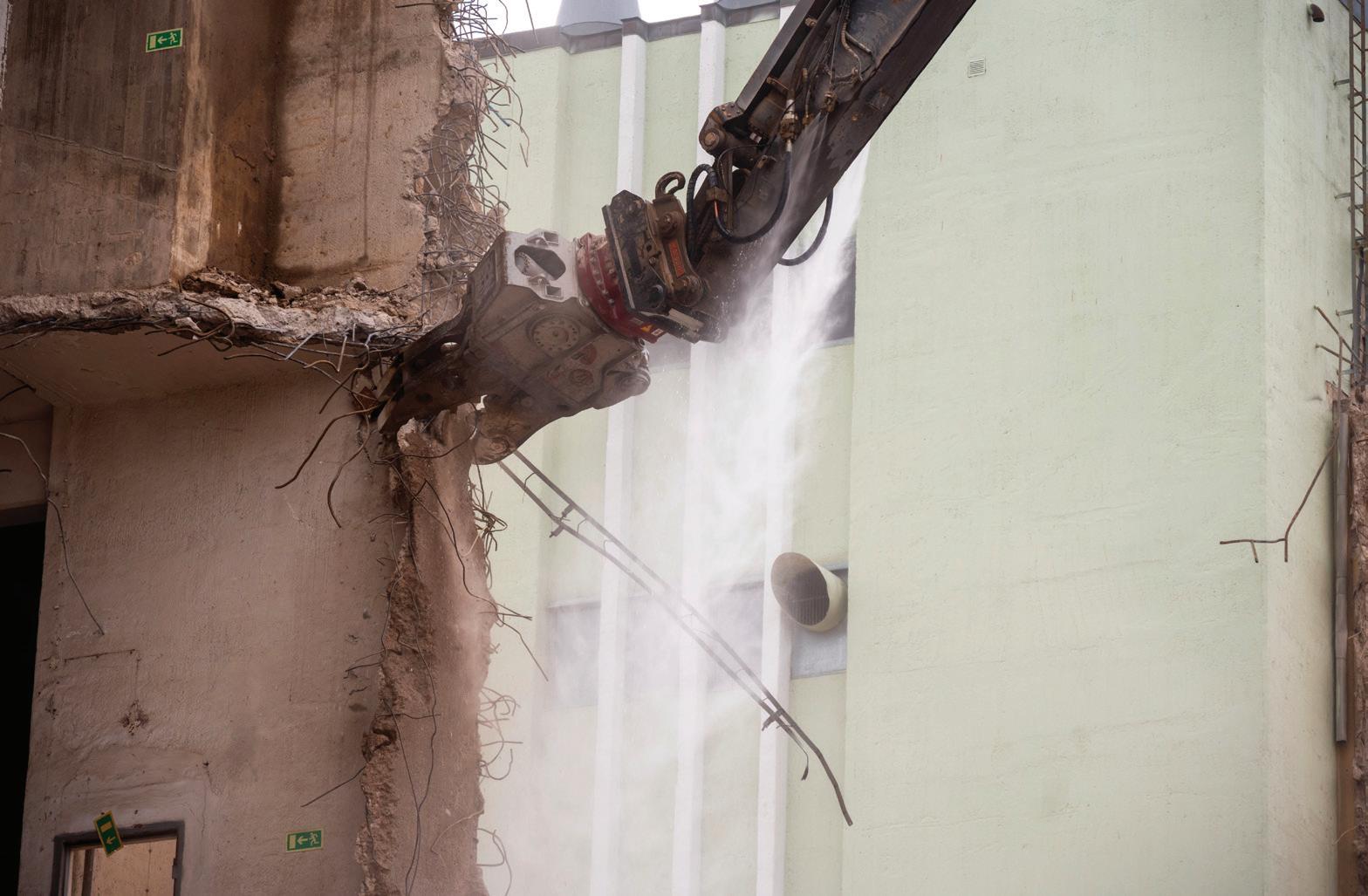
The system’s ability to integrate with a wide range of machines was a significant advantage for Normans AB, providing flexibility in their operations. The environmental impact was another crucial consideration. As the water consumption of the HPW-DUST is low, the overall environmental footprint of the HPW-DUST is also generally lower than alternative methods. Its ability to significantly reduce airborne dust contributes to cleaner air and minimises harm to surroundings.
When working with major demolition operations, the importance of effective dust control is vital. The selection of a dust suppression system demonstrates the need to balance various factors such as efficiency, cost, versatility and environmental impact when considering different options. In the grand scheme of things, it’s not just about demolishing structures, but about shaping our urban landscapes in a manner that respects the health and wellbeing of our communities and the environment.
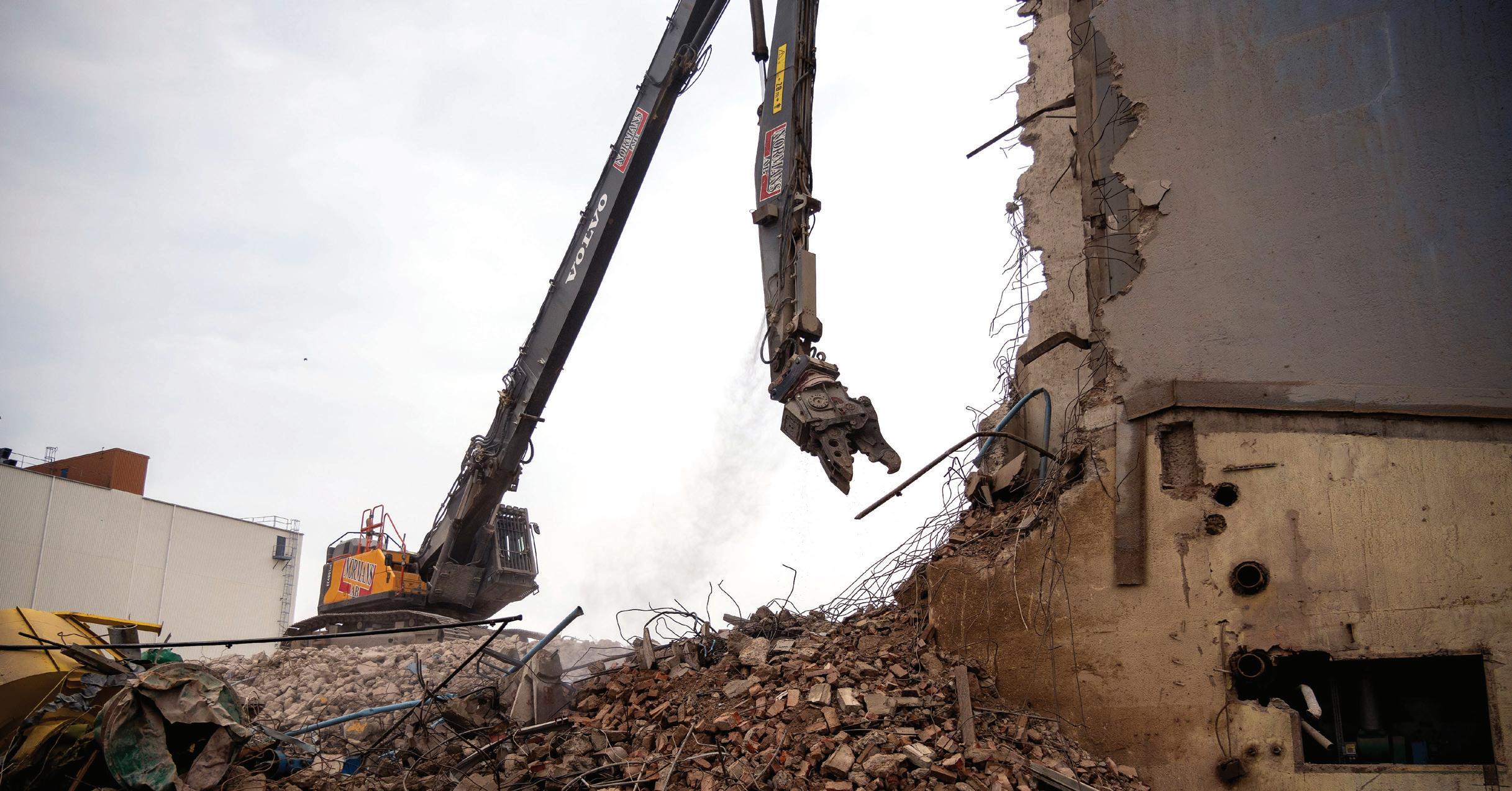

DemolitionHub.com DemolitionHUB Magazine | 125 industry
Building lifespan by Richard Dolman
Increasingly there is controversy around demolition of older buildings as carbon consumption is sited as a very valid reason to reuse rather than rebuild. But are we looking at the full picture?

We would all agree to repurposing existing buildings as one solution as we consider demolition and construction as having high carbon usage, but is this always the most sustainable option? Sometimes buildings have exceeded their original lifespan, their design is no longer fit for modern purposes and bringing these buildings in line with contemporary thermal ratings is costly and will produce carbon in
itself.
An example of how this often difficult decision is being debated, is Marks & Spencer’s flagship Oxford Street store in London. Planning permission for the demolition of the existing building and construction of a replacement had been granted by the local authority (Westminster City Council) in November 2021 before the decision was called in by the Secretary of State for Levelling Up, Housing and Communities, Michael Gove, and permission overturned in July 2023.
Older buildings are often built with materials that can be fully recycled and reused, unlike some modern building materials. Leading demolition contractors boast recycling statistics over 98%.
Turning old buildings into primary grade aggregates, upcycling and the reuse of materials in construction is incredibly positive and is taking place every day – this is sustainability. We should be promoting this positive message.

The difficulties are becoming more apparent as we see the
be helping the wider industry, providing insight into the options for materials at the end of their life so these considerations can be fully made while the structure is being designed.

We have an important role to play in the longevity and sustainability of our buildings. Let’s act now.
If you have something to say and would like to submit a column for publication in Demolition Hub, please email toby@chambers.media
opinion DemolitionHub.com 126 | DemolitionHUB Magazine
We, as an industry, should be helping the wider industry, providing insight into the options for materials at the end of their life




Mental health support for the demolition industry brought to you by: To find out more visit www.demolisten.co.uk
by Richard Clement, Deputy General Manager of Smart Construction UK

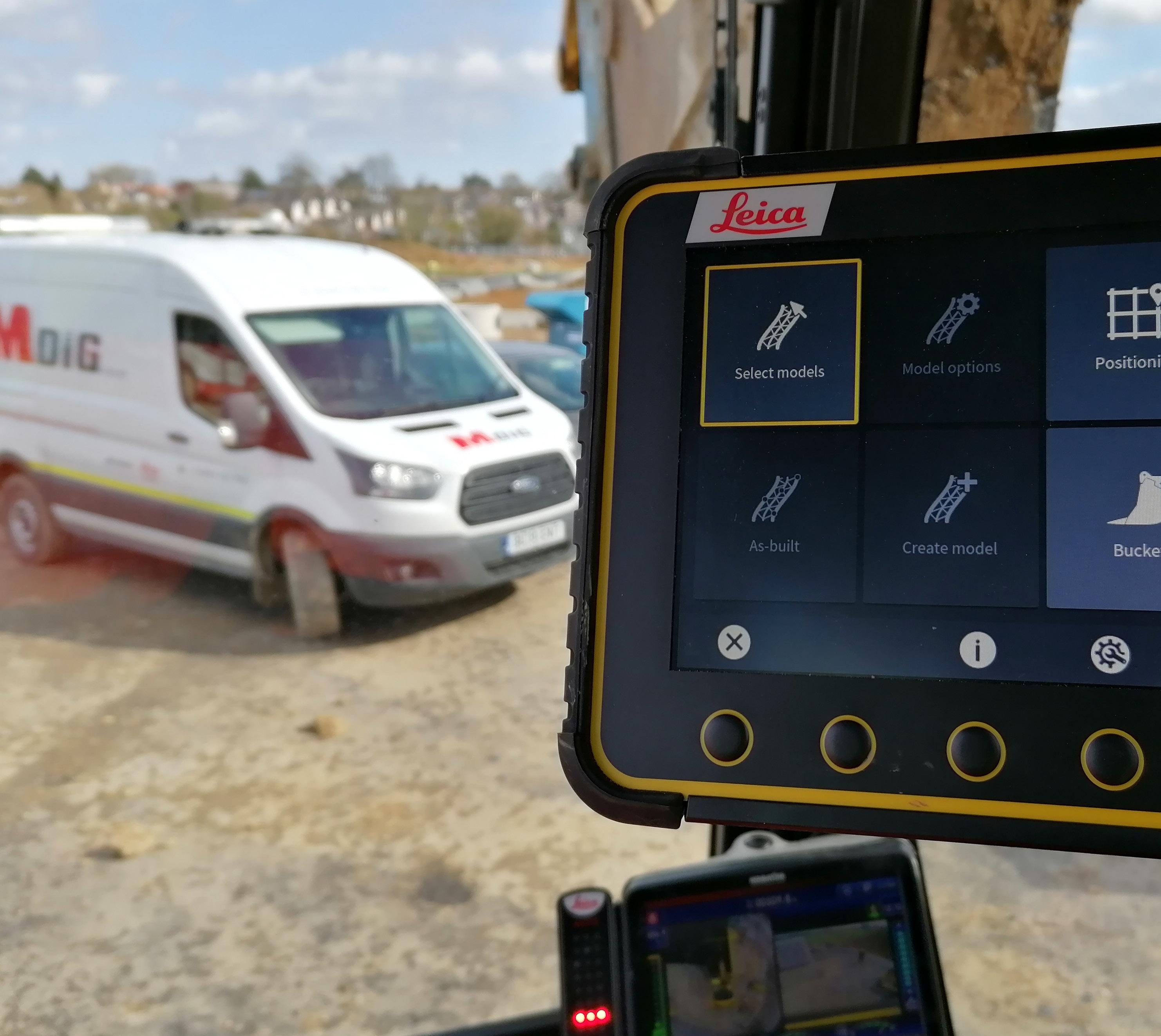
The challenge with rebated fuels
In 2022 diesel and gas oil inventories had fallen to 1.57m tonnes by the end of February, down from 2.23m at the same period the year before. Not only that, but April 2022 saw the ban on red diesel for construction sites, which means a multitude of complications for demolition industries across the UK.
While the fuel shortage has a knock-on effect for all road vehicles, the impacts on construction and demolition projects is much wider and fuel costs have become frozen in sharp relief thanks to recent changes. Heavy plant machinery is now fully at the mercy of market prices for fuel, which can lead to huge expenses for site teams and
DemolitionHub.com 128 | DemolitionHUB Magazine opinion
The red diesel ban in the demolition industry – putting new processes in place to conserve fuel
contractors when approaching a demolition contract.
Ensuring that fleet and plant machinery is operating at its most efficient level has never been more important, and thanks to research and innovation we’re now at a place where decision makers, leaders and managers can make effective decisions about the tech that is rolled out at site which will have a direct impact on fuel economy.
What is the opportunity for fuel economy?
There are options available for managers and decision makers who want to ensure their fuel use is tracked and isn’t becoming an unnecessary expense. Digital
solutions that allow machines to be tracked at the site can pinpoint idle times or excessive waiting periods, identifying where bottlenecks are in the process.
By building and implementing a digital twin of the job site, data can be provided in almost real time, allowing managers, engineers and contractors to implement changes for the demolition team based on the insight they’ve gleaned during the project.
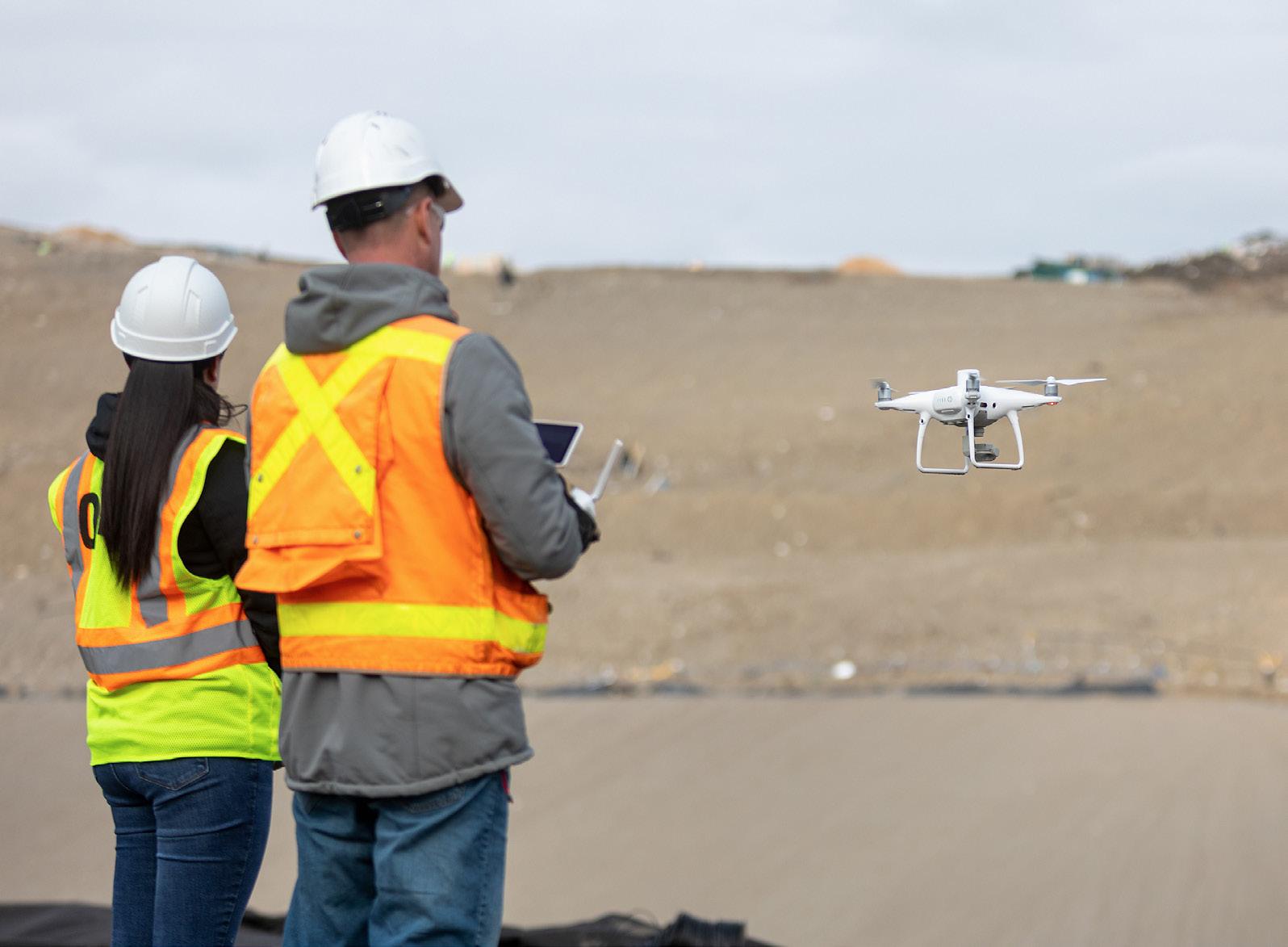
These digital twins, when used effectively, provide an overview of all fleet movement and any challenges that the machinery operators face. This could include the provision of smaller or more compact machines, or widening access to allow more than one machine to pass through a bottleneck, for example. Reducing idle times will create substantial fuel savings and increased productivity.
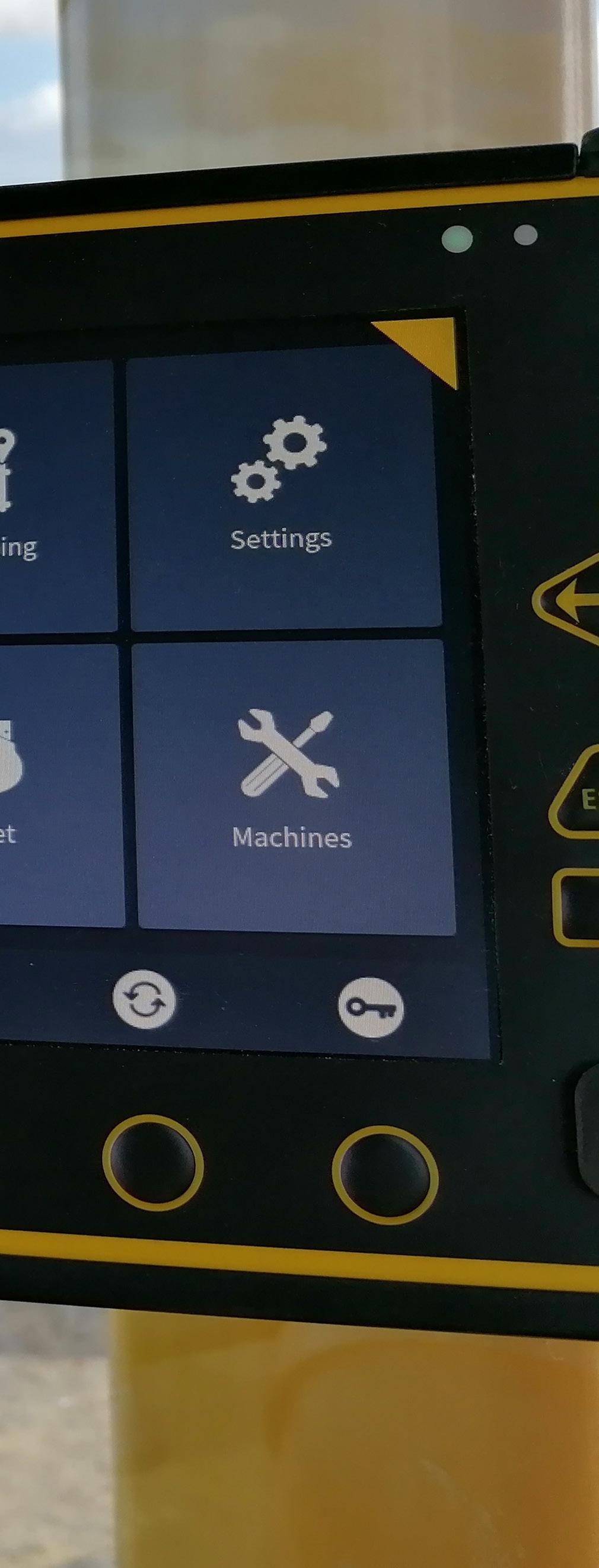
To make overall change to the fuel consumption in construction, and especially in the demolition industry, we need to focus on making digital solutions viable for all.
Digital twins can’t be considered a completely new solution, but being able to implement these on smaller scale projects is key to making savings where they’re needed most. It is these contracts that are the ones with smaller cost margins, and ultimately where tracking outgoings is of utmost importance. At Smart Construction, we have the technology to support clients in building digital twins, and we make
sure our solutions are affordable for customers working on smaller projects as well as those on a larger scale.
Richard Clement has over thirty years’ experience in the construction industry and is now spearheading the rollout of a portfolio of digital solutions to the sector.
Smart Construction is a digital transformation strategy created by Komatsu together with Sony Semiconductors, NTT Communication and Nomura Research Institute under the entity EARTHBRAIN Limited.
Smart Construction experts use digital tools to assist clients in the earthmoving and quarry industries by finding the optimum way of using resources like machine, material and people for enhanced productivity, quicker project completion, cost savings, improved safety, and reduced CO2 emissions.
Smart Construction’s comprehensive range of solutions and services are fully accessible in the UK, Germany, France, Denmark, the Czech Republic, Austria and Slovakia.
If you have something to say and would like to submit a column for publication in Demolition Hub, please email toby@chambers. media
DemolitionHub.com DemolitionHUB Magazine | 129 opinion
Protecting employees from silica dust exposure
Respirable Crystalline Silica
The Health and Safety Executive (HSE) refers to Respirable Crystalline Silica (RCS) or silica dust as “the biggest risk to construction workers after asbestos” with an estimated 600,000 workers exposed to silica in the UK each year. For the demolition sector, RCS is of particular risk as it is found in many commonly used construction materials including sand, gravel, clay, stones, concrete, bricks and quartz.

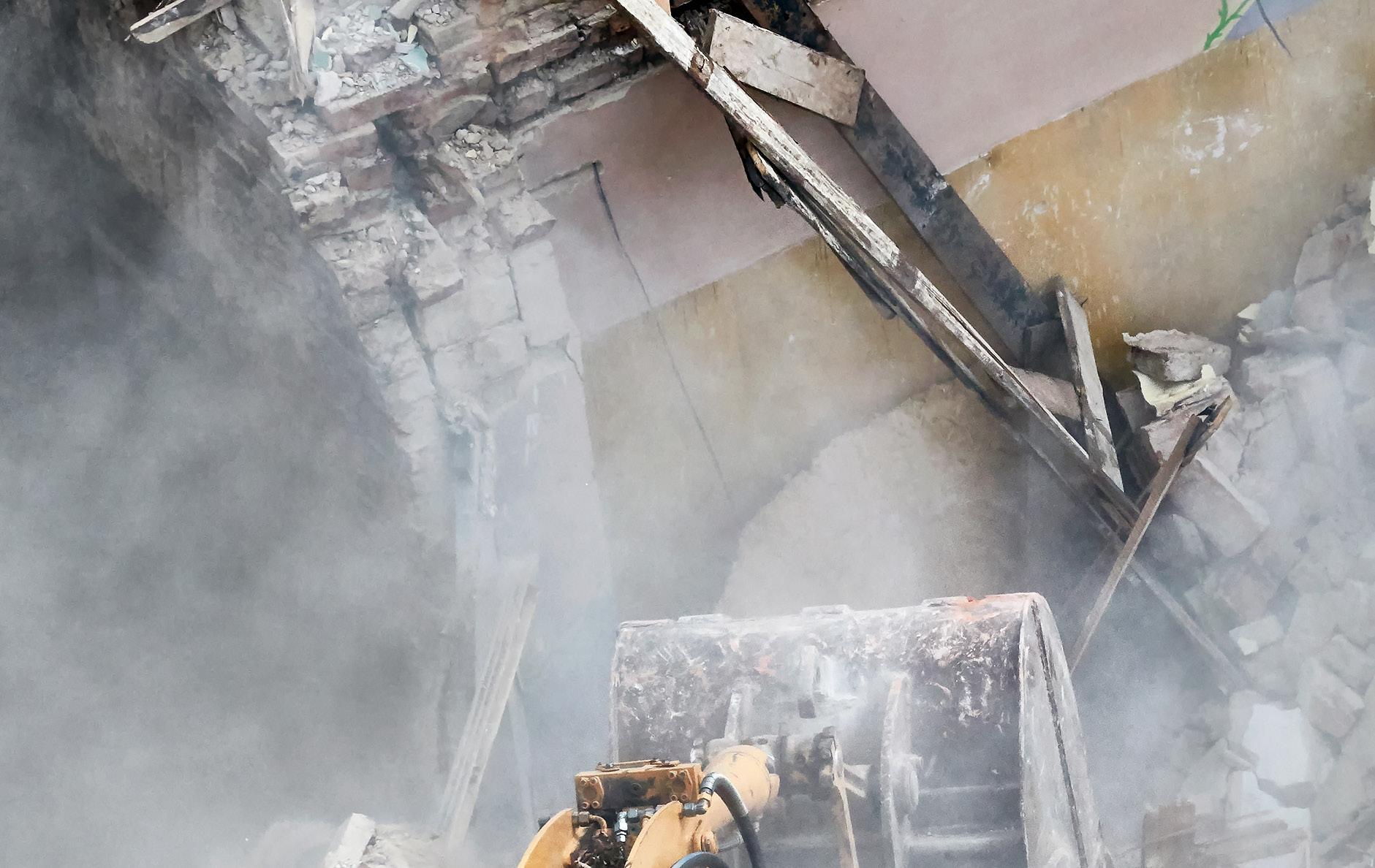
When materials are disturbed, broken or otherwise through cutting, drilling, grinding or crushing, minuscule dust particles are created. When inhaled, these particles travel deep into the lungs and can cause incurable and sometimes deadly respiratory diseases such as silicosis, chronic obstructive pulmonary disease and kidney disease. As a result, the UK Workplace Exposure Limit (WEL) for RCS is 0.1mg/m3 over a period of eight hours.
Control measures
In controlling dust, the usual risk control hierarchy applies. Where the risk cannot be eliminated entirely, a safer form of the product should
be used. If this is not feasible, the process should be changed to emit less dust or enclose the process so that the dust does not escape or by extracting the dust near the source using local exhaust ventilation (LEV). Employers should make the process efficient enough to have as few workers in harm’s way as possible. In the hierarchy of control, the last thing you apply is respiratory protection equipment (RPE), and often, because of a lack of understanding of toxicity and dust concentration, the wrong respiratory protection is used.
To better understand employee exposure, a correctly executed programme of air monitoring of individual employees using personal sampling pumps can be important. Air monitoring can quantify exposure levels and ensure workers are not significantly exposed. When control measures are in place monitoring can ensure they are working, and if RPE is used it can check the correct type and measure residual risk. These pumps are essential in places where there is a significant risk of highly concentrated hazardous pollutants in the surrounding air, for
example during demolitions.
To obtain an accurate picture, it is important that the pumps are used with the correct sampling head, and in the case of RCS, a cyclone and filter which collects the particulate should be used. Once the sample is analysed by a laboratory, the level of exposure can be calculated. If the result of this assessment shows significant exposure risk, then action should be taken immediately to improve control measures and ensure exposure is reduced. Note that it’s not good enough to just keep exposure to at or just below the exposure limit of 0.1mg/m3, exposure should be reduced to as low as is reasonably practicable.
Many improvements have been made to personal sampling pumps over time. Battery technology, back pressure capability, accurate flow control, minimised pulsation, data download and the ability to be intrinsically safe have all been improved, ensuring measurement
DemolitionHub.com 130 | DemolitionHUB Magazine opinion
Tim Turney, Global Marketing Manager at Casella, a global leader in the manufacture and supply of air monitoring equipment, shares his expert insights on protecting employees from silica dust exposure on sites
of an individual’s exposure to harmful substances is as accurate as possible. Understanding these factors in which the personal sampling pump needs to operate effectively will allow employers to choose the most effective device suited to their working environment.


Correct implementation of personal sampling relies on a thorough understanding of practice, procedure, how sampling pumps function and use of the correct sampling head and filters.
Correct equipment, calibrated properly
Personal sampling pumps must adhere to the standard ISO 13137:2022. The standard sets limits for required flow stability and maximum permissible pulsation levels, enabling users of personal air sampling pumps to adopt a consistent approach for flow rate assessment.
This standard provides a comprehensive framework that specifies test methods to determine the performance of air sampling pumps and ensures that environmental influences such as air pressure and temperature have a minimal impact on the accuracy of
the sampled air for accurate results. Correct equipment – calibrated properly, and an awareness of the limitations and impact on data collection that the equipment itself can have, should be at the forefront of correct air monitoring procedures as well. Pumps, including the Apex2, that operate with a pulsation value of less than 11% and conform to all relevant ISO standards give occupational hygienists and site managers the peace of mind that data captured is reliable and unaffected by pump pulsation. Low pulsation is particularly important when sampling for RCS as the sampling head is a cyclone, and only at low pulsation levels will it get the correct “respirable” sample.
Employee awareness
Employee health must remain a priority and a core component of any workplace health and safety management system. Likewise, monitoring must continue to evolve in accordance with changing production methods and the industry is already moving in a positive direction.
In addition, education and training that raises workers’ awareness of the risks of dust
exposure is integral in ensuring that they understand how to prioritise and protect their health.
References:
www.casellasolutions.com/uk/en/ Knowledge-Bank/KB-Dust/DustWorkplace.html
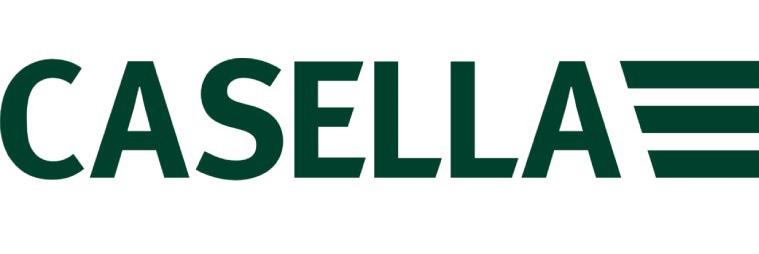
www.hse.gov.uk/pubns/indg463.pdf
If you have something to say and would like to submit a column for publication in Demolition Hub, please email toby@chambers.media
DemolitionHub.com DemolitionHUB Magazine | 131 opinion
Our towns and cities face an ongoing transformation – 7.9 billion people worldwide need housing. Epiroc’s efficient solutions for demolishing old buildings, and our equipment for foundation work and demolition waste recycling are enabling and accelerating the transformation.


Epiroc UK & Ireland Ltd Email : hat.uk@epiroc.com Tel : 0800 5872554 epiroc.com See how we accelerate the transformation The
enabler
goal The



















































































































































































































































 Dismantling the mural, The Art of Recycling, for reuse elsewhere
The Art of Recycling mural installed on the library in 2003 by street artists Mark Wydler, Karen Wydler and Carrie Reichardt
Dismantling the mural, The Art of Recycling, for reuse elsewhere
The Art of Recycling mural installed on the library in 2003 by street artists Mark Wydler, Karen Wydler and Carrie Reichardt






















































 Supplier of the Year: LiuGong
Supplier of the Year: LiuGong



































































































































































